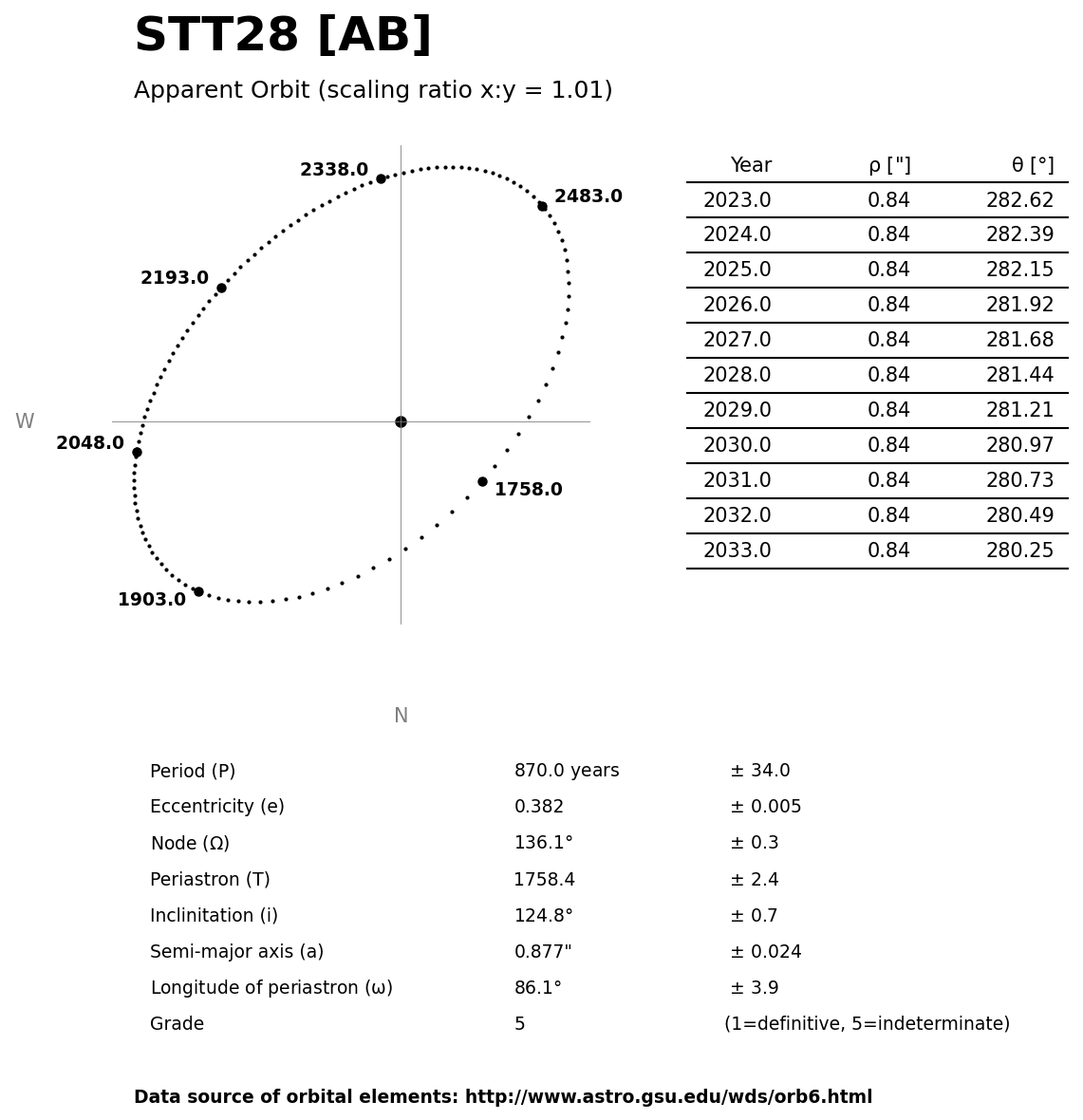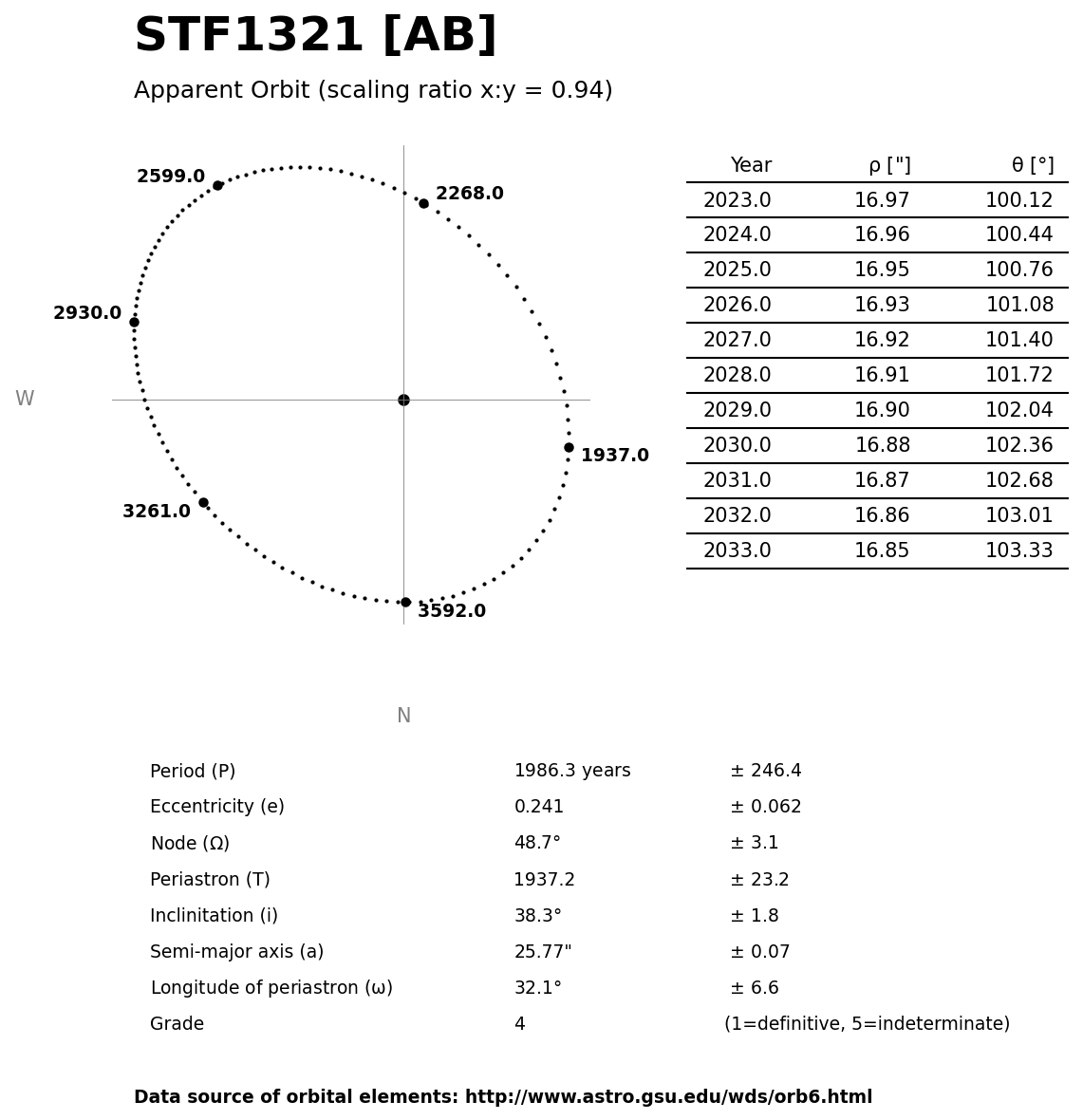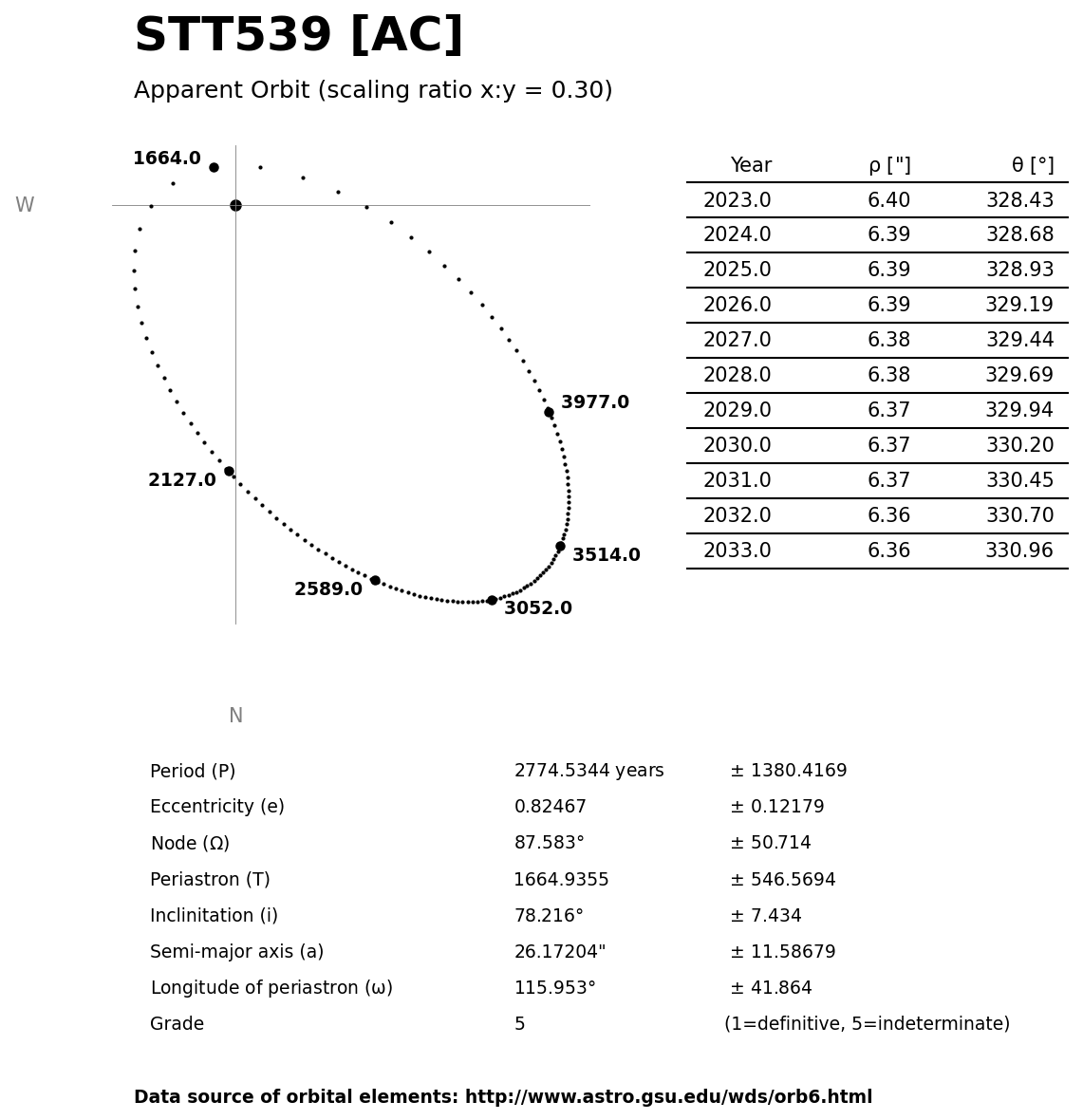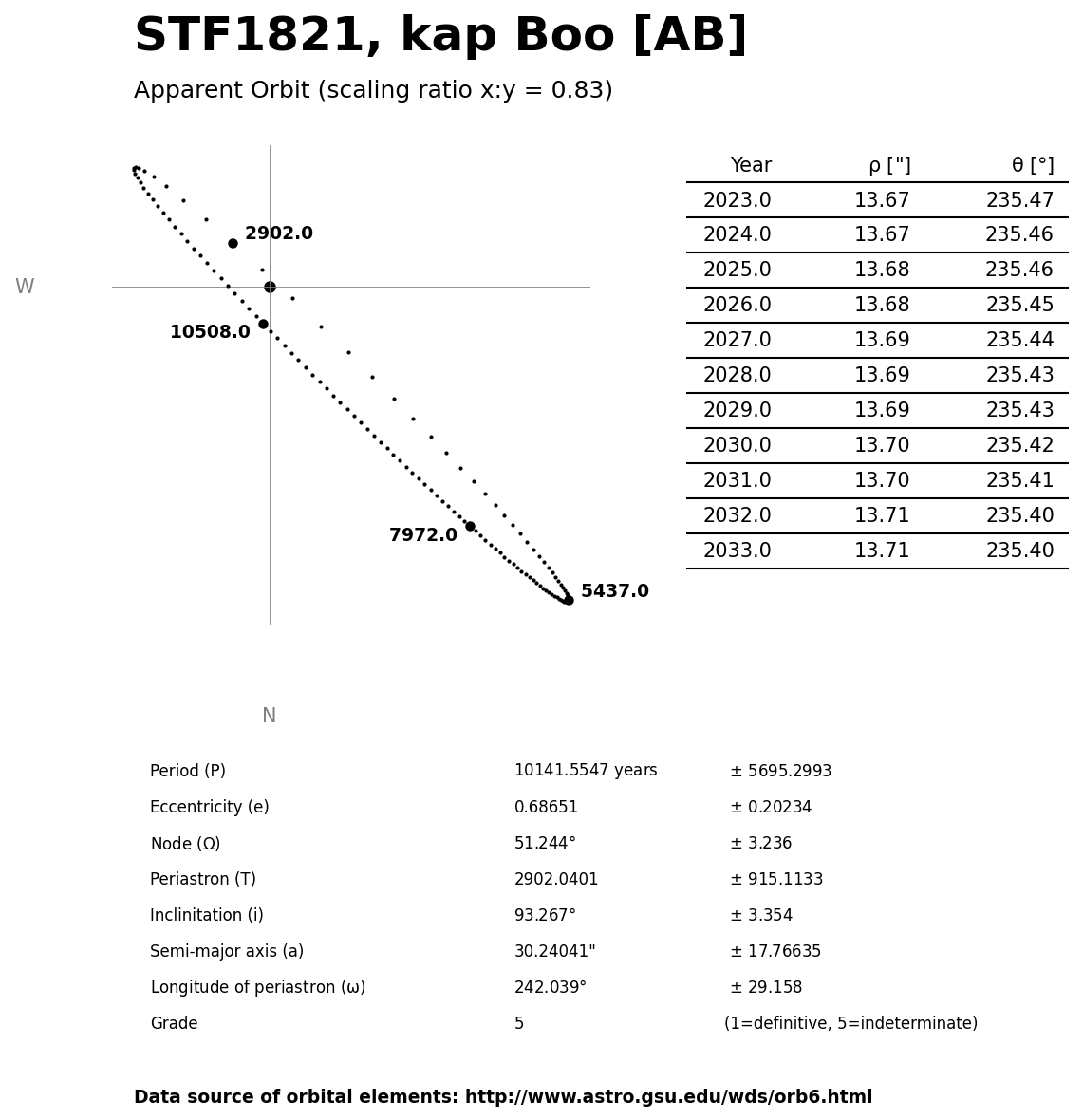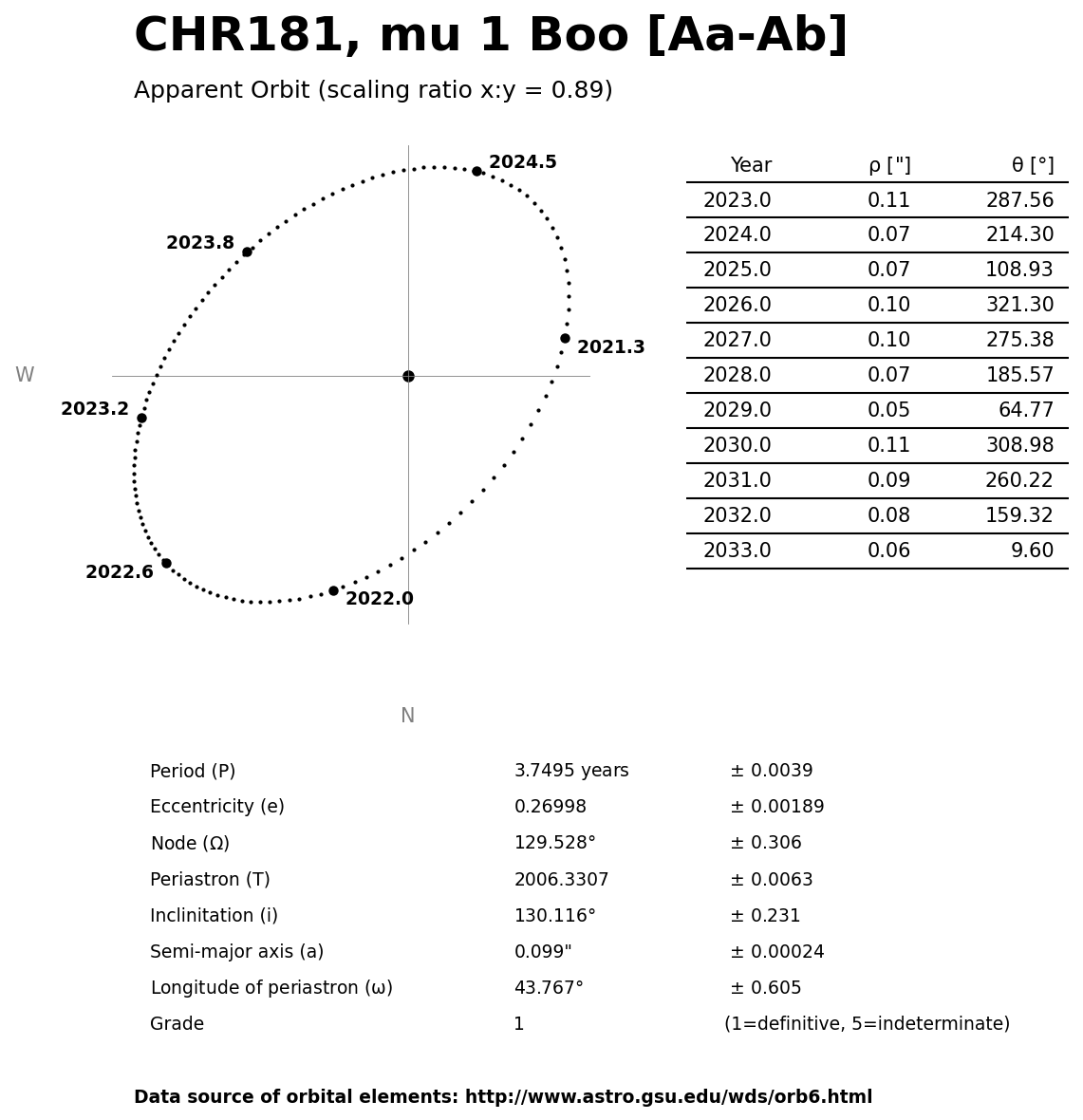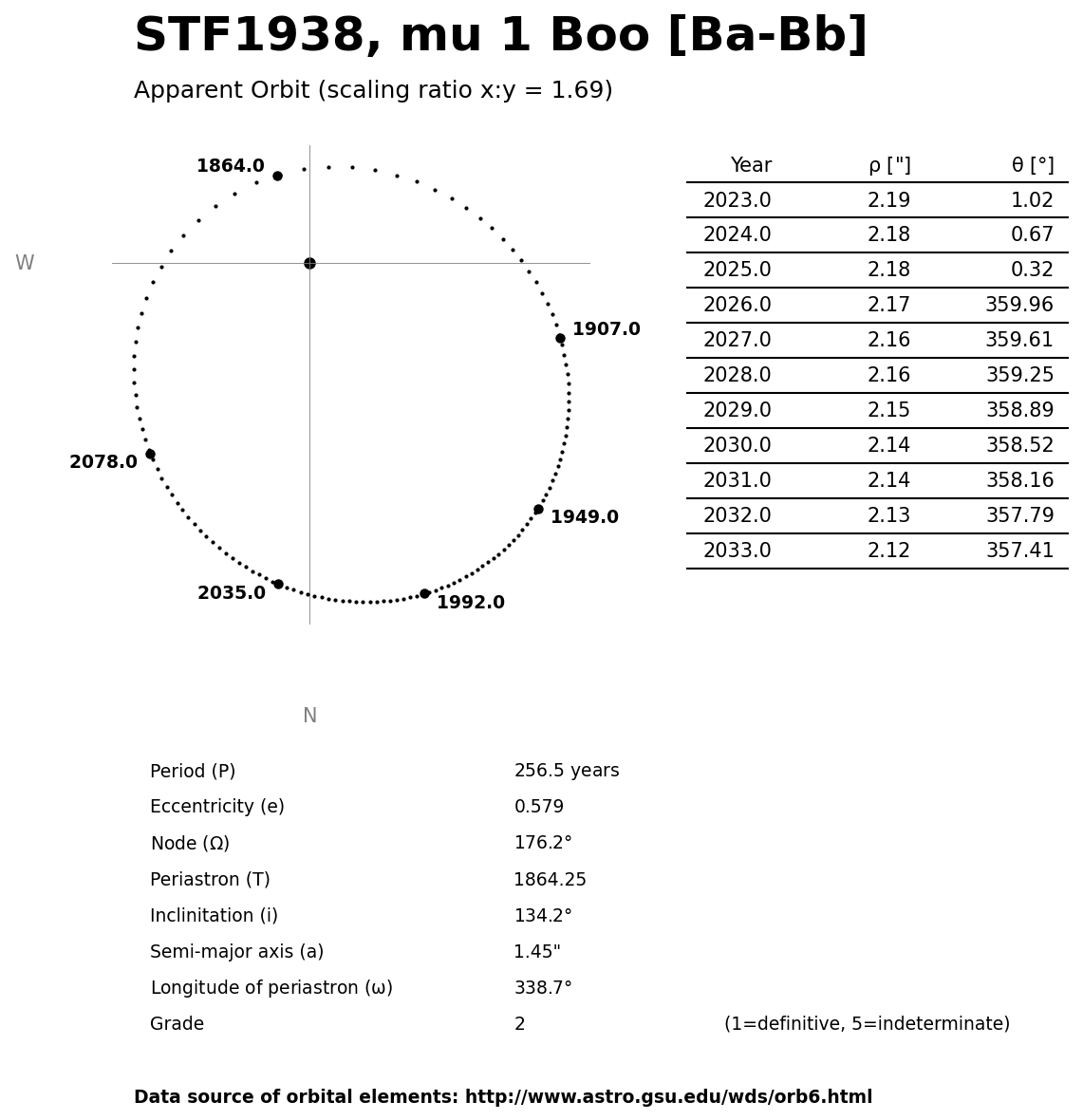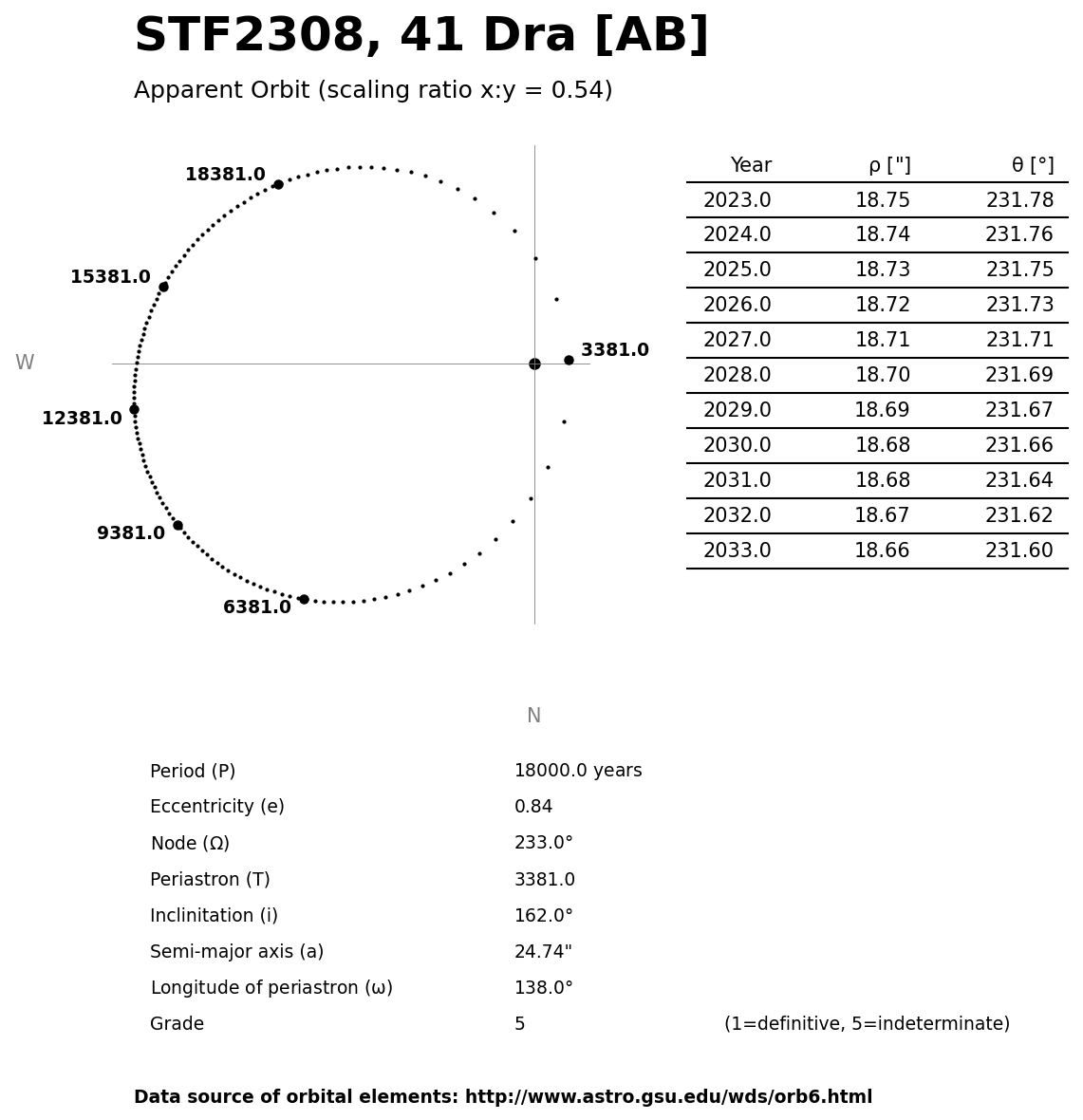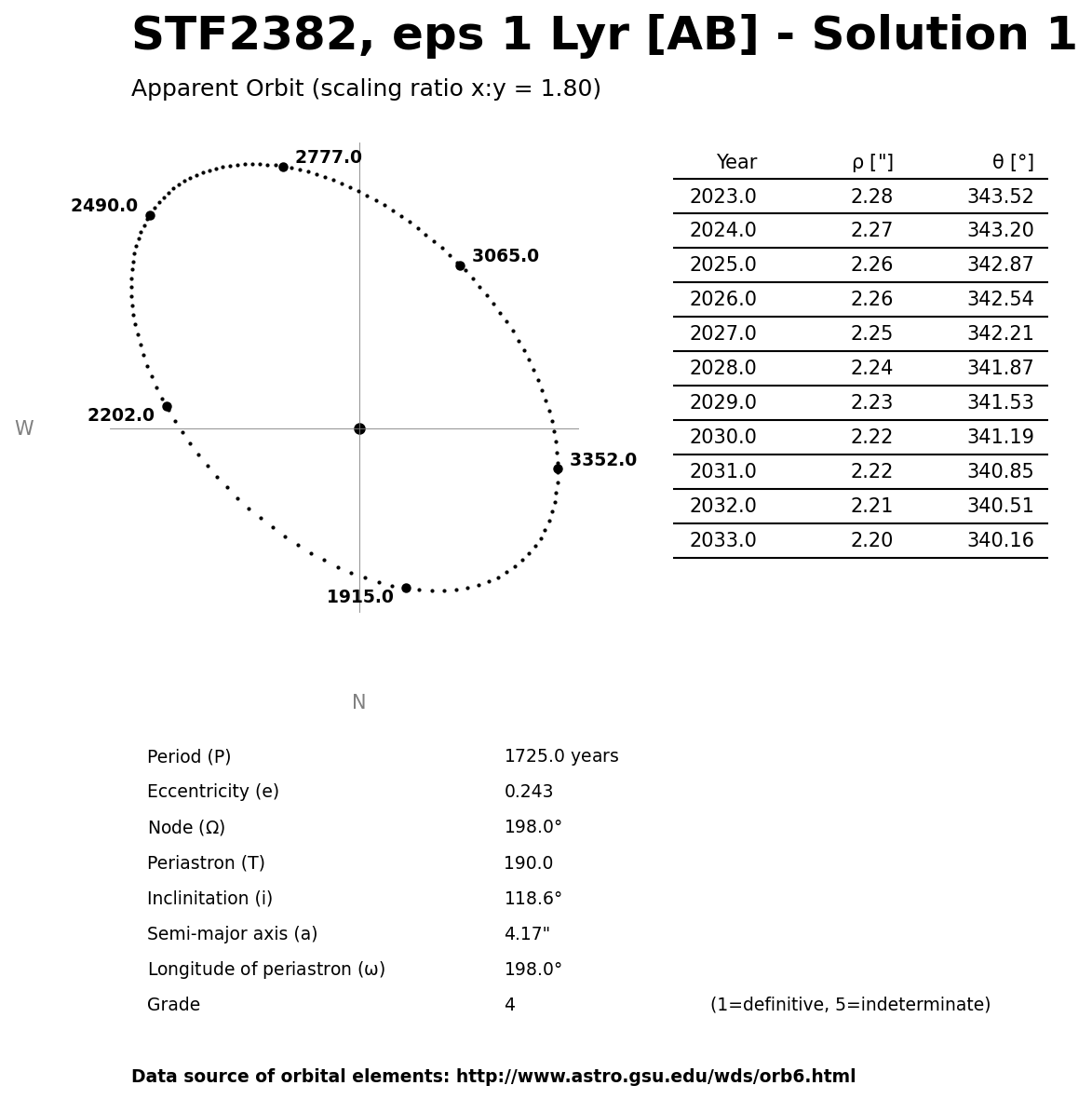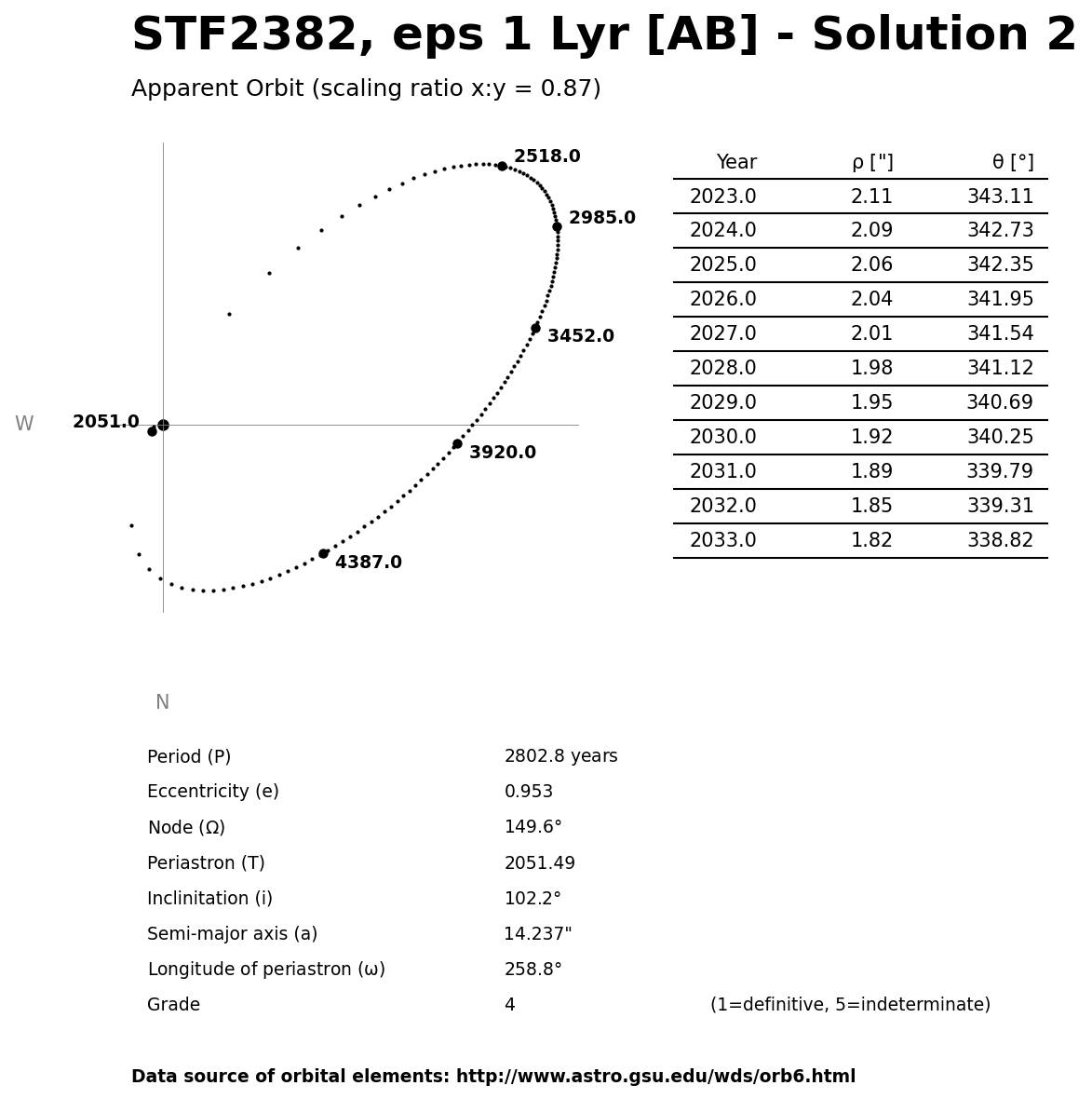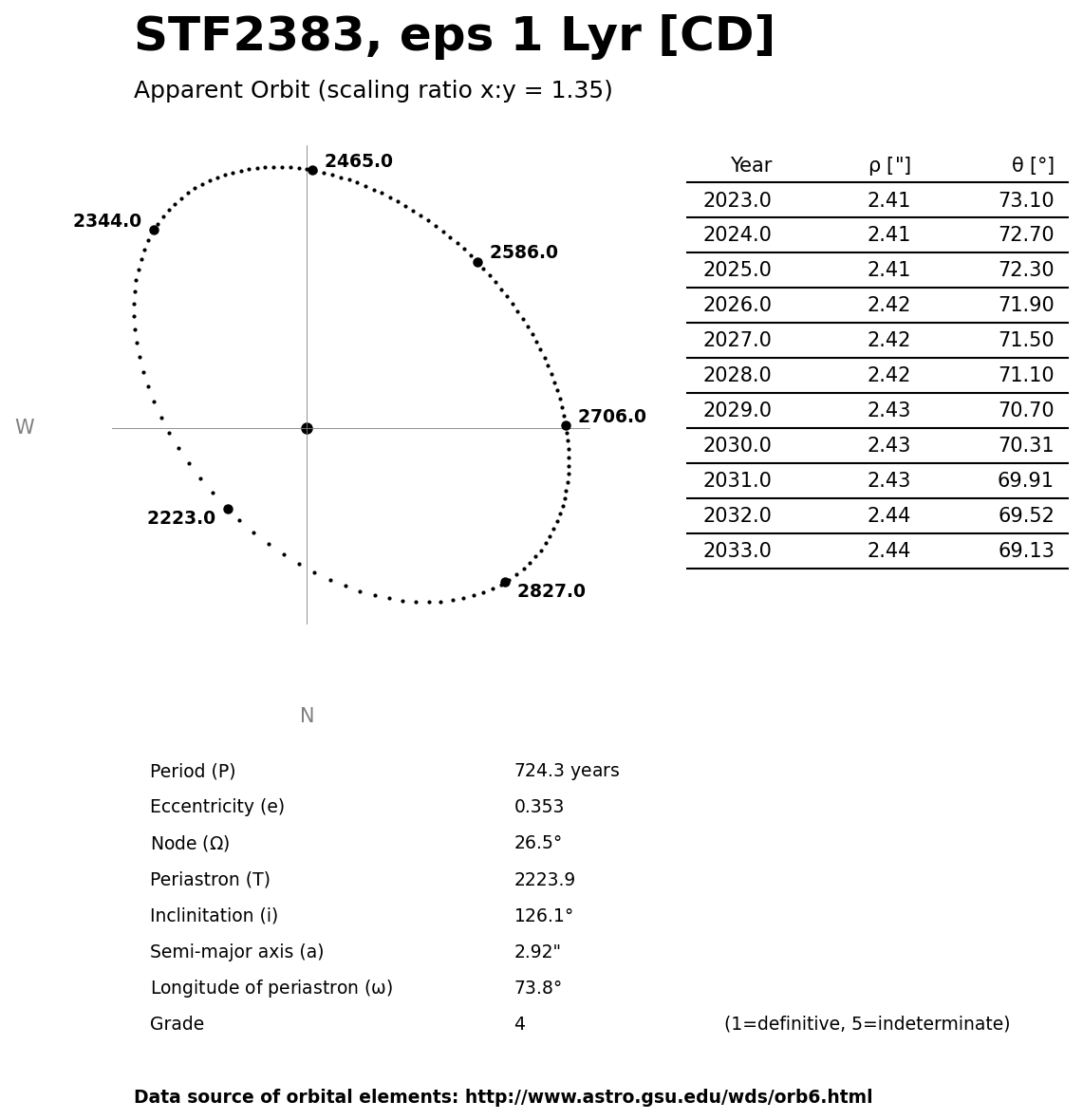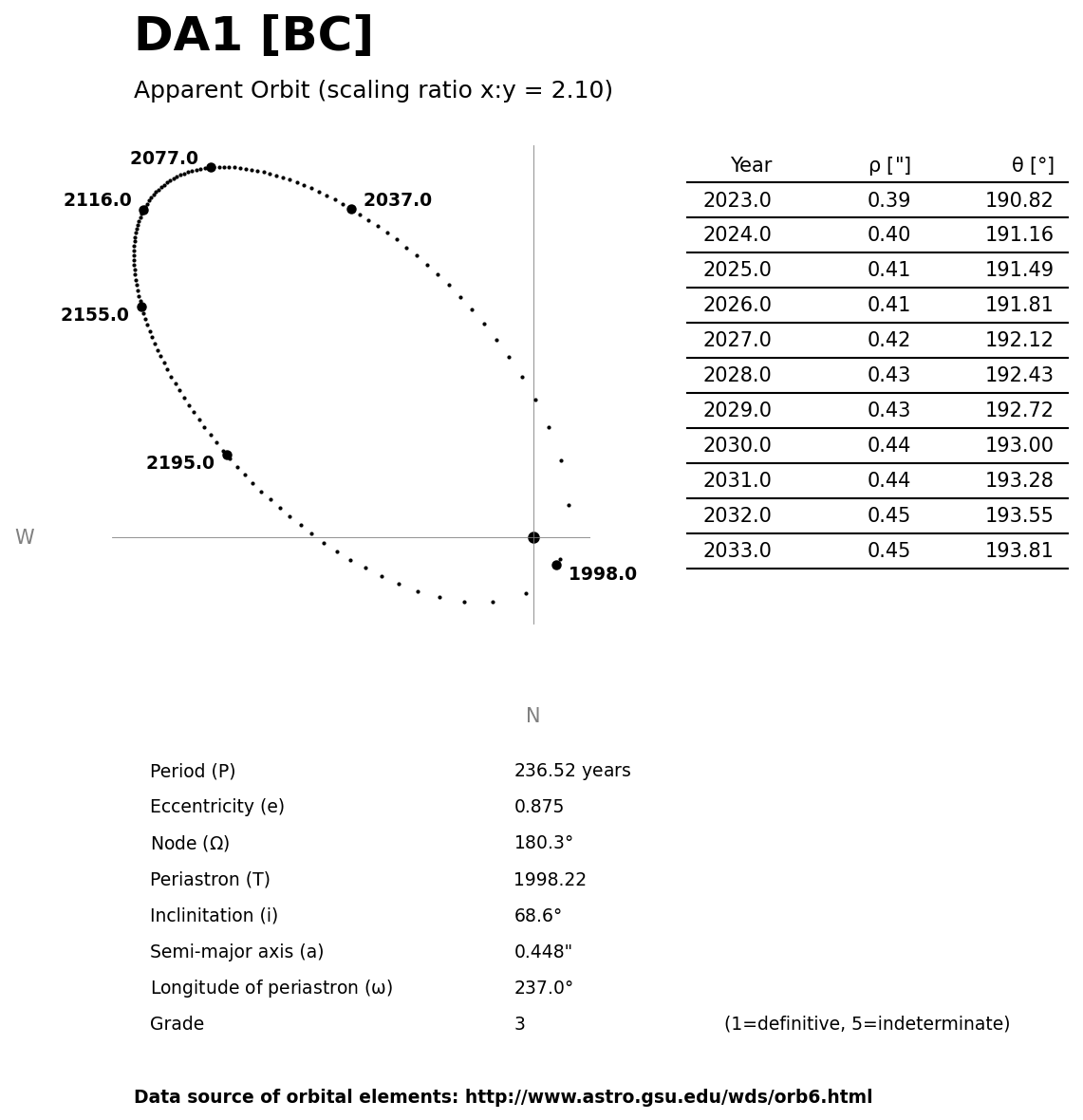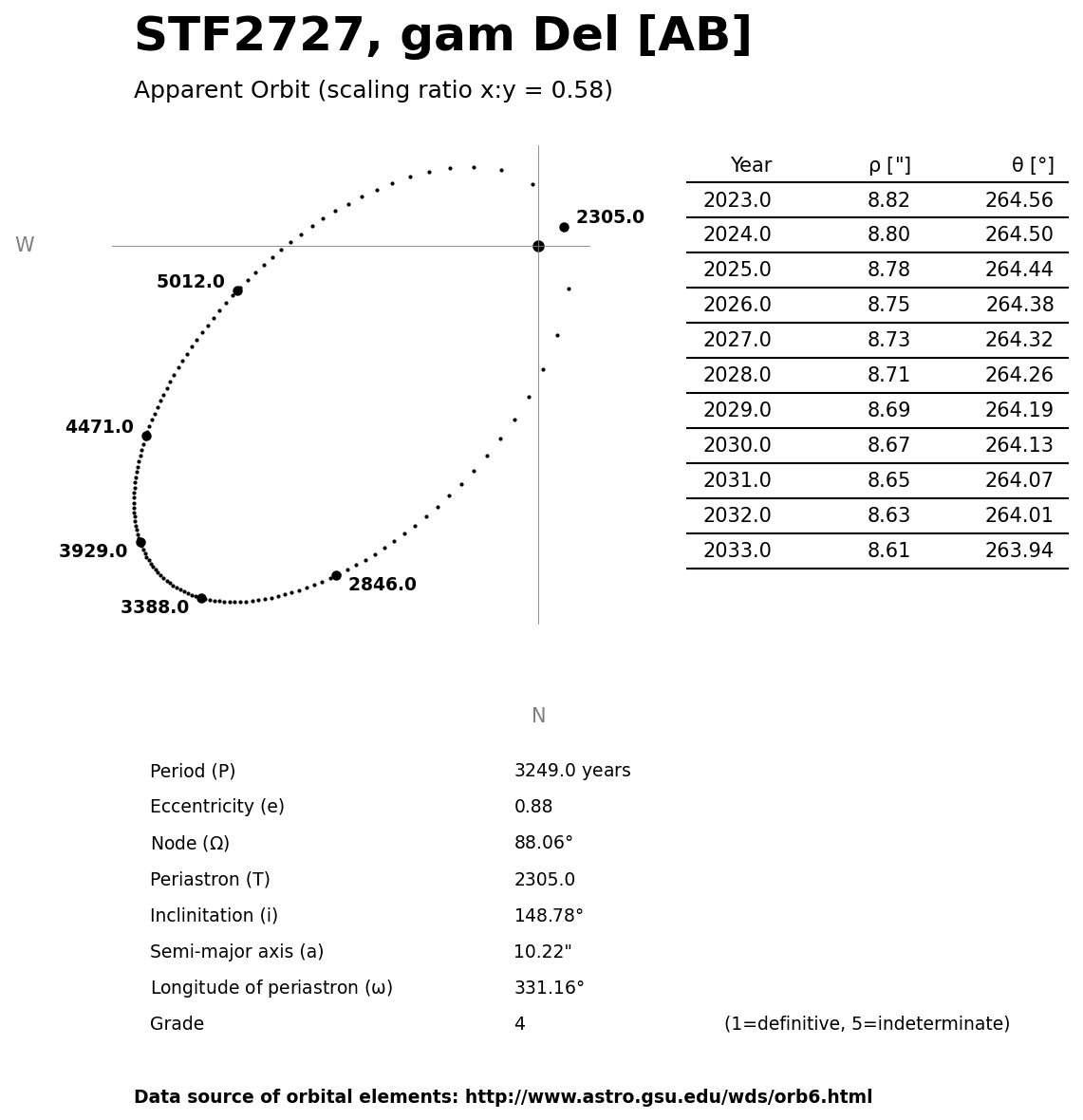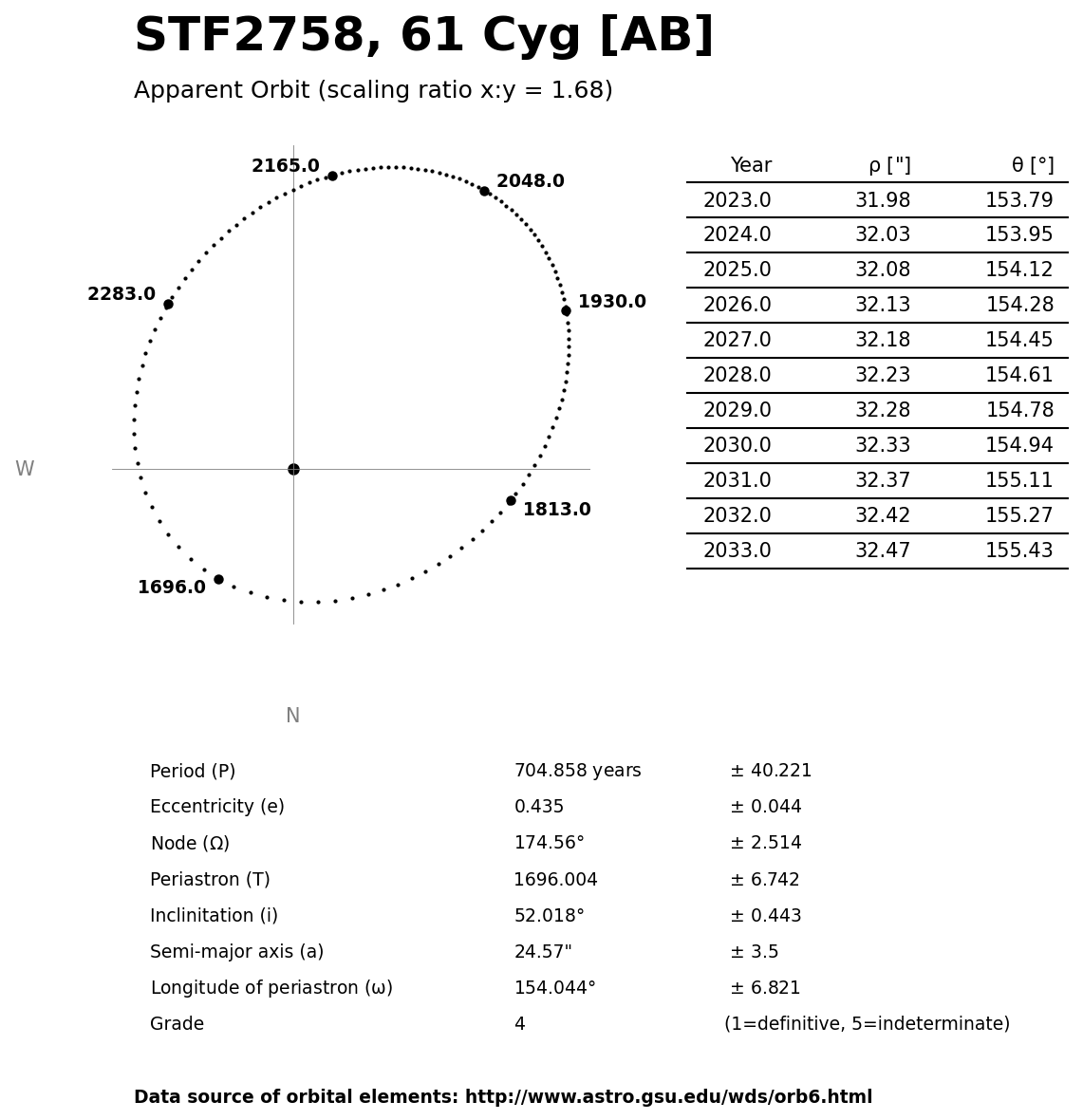|
m1 |
m2 |
ρ |
θ |
Year |
|
Coordinates (J2000.0) |
|
★★★
|
STTA254, WZ Cas |
|
AB |
7m.4 |
8m.3 |
57.8" |
89° |
2019 |
Cas |
00h01m15.85s / +60°21'19.00" |
|
|
|
|
AC |
7m.4 |
9m.6 |
155.4" |
324° |
2015 |
|
|
|
|
|
|
AD |
7m.4 |
10m.3 |
181.4" |
118° |
2016 |
|
|
Christopher Hay
Seeheim (Germany) |
6x24 |
AB: Clearly split. A definitely brighter than B. Under a NELM 5m5 sky both components appear weak in these mini-binoculars and no colour impression arises.;
WZ Cas is the variable designation of component A of STTA254. This semiregular carbon star has a mean brightness range of 6m8 to 7m7, and can reach extreme values of 6m3 at one end and 8m8 at the other. Perhaps it was too deep in a minimum at the time of observation to show colour with 1 inch of aperture? 15x45 binoculars revealed colour in this night, see observation below. |
|
Christopher Hay
Seeheim (Germany) |
15x45 |
AB: Wide split. A orange-red, B no particular colour. NELM 5m5, same night as 6x24 observation above. |
|
René Merting
Drachhausen (Germany) |
15x56 |
AB: einfach - beide Sterne zeigen sich komfortabel getrennt - Komponente A strahlt gelblich - Komponente B südöstlich wirkt dagegen grau und ist 1.5 bis 2 Größenklassen schwächer |
|
Robert Zebahl
Leipzig (Germany) |
16x70 |
AB: 2020-08-19: Intense orange & bluish. Very striking. |
|
René Merting
Drachhausen (Germany) |
16x70 |
AB: ein schöner Fernglas-Doppelstern - Komponente A im Westen präsentiert sich dunkelgelb (noch nicht orange), B im Osten ist eher weißlich |
|
René Merting
Drachhausen (Germany) |
18x70 |
AB: ein sehr auffälliger Doppelstern mit einem schönen Farbkontrast - A strahlt gelb, das kurz davor steht, ins Orange über zu gleiten - B wirkt im Kontrast aquamarin, so dezent wie eine typische PN-Farbe |
|
René Merting
Drachhausen (Germany) |
76mm (29x) |
AB: bei 29x ein wunderschönes Sternpaar mit einem auffälligen Farbkontrast, weit getrennt - Komponente B wirkt weißgrau bis weißblau gegen die gelborange strahlende A-Komponente - Helligkeitsunterschied eine Größenklasse |
|
René Merting
Drachhausen (Germany) |
76mm (29x) |
AB: Mondscheinbeobachtung - bei 29x ein weit getrenntes Pärchen, bei dem die A-Komponente nicht durch Strahlkraft, sondern durch seine auffallende Farbe besticht, ein sehr kräftiges Kupferorange - es gibt hellere Sterne im Umfeld, aber diese Komponente fällt besonders auf - die B-Komponente ist gut 1.5 mag schwächer und wirkt grau bis graublau |
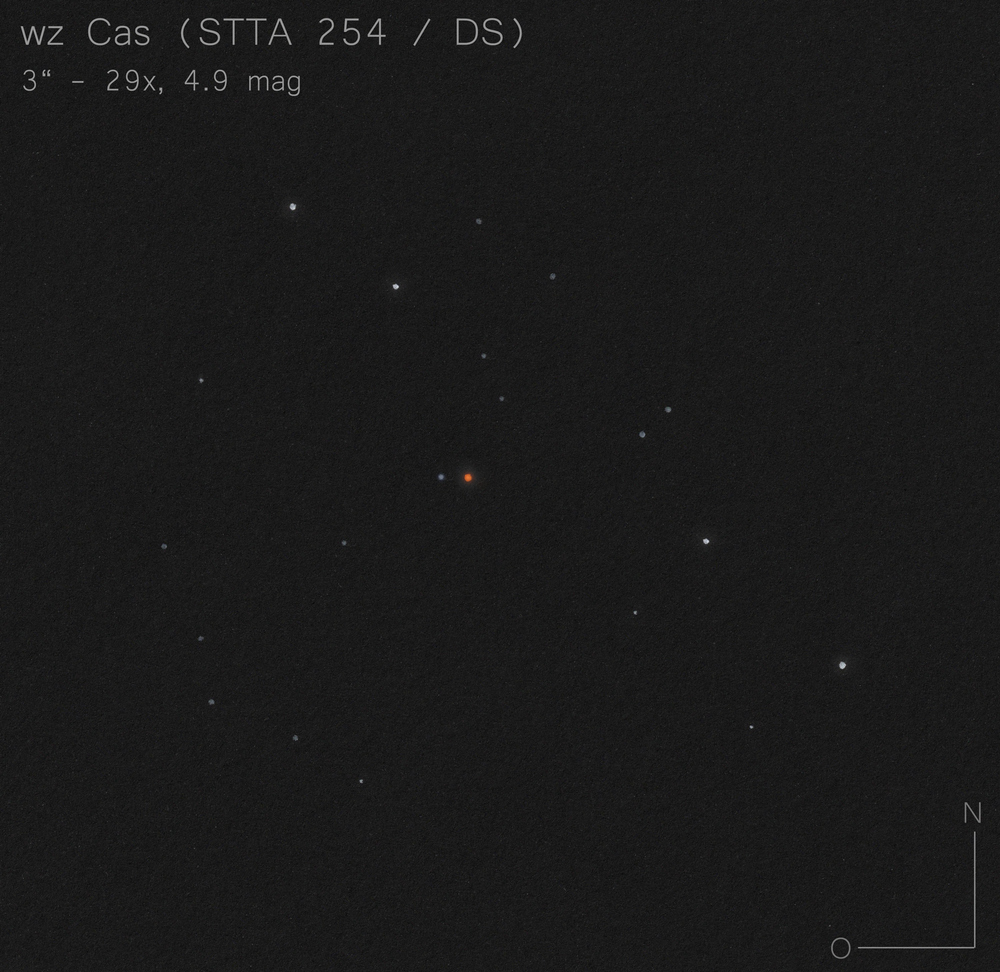
|
Robert Zebahl
Leipzig (Germany) |
80mm (33x) |
AB: Nice double star. Brighter component appeared orange, the fainter more bluish. |
|
René Merting
Drachhausen (Germany) |
100mm (20x) |
AB: 20x reicht zwar schon für eine klare Trennung, aber Komponente B im Osten ist nur dumpf grau-blau und noch zu schwach für den schönen Farbkontrast, der sich bei 32x offenbart - Komponente A strahlt dann in einem satten Bernsteingelb, B im Osten gibt sich unterkühlt bläulich - Helligkeitsunterschied 1 bis 1.5 Größenklassen, schwierig abschätzbar wegen der Farben |
|
Sarah Gebauer
Germany |
100mm (49x) |
AB: sticht sofort ins Auge aufgrund des stärksten kupferroten Farbtons, den ich seit langem gesehen habe - der Begleiter strahlt bei 49-fach schon weit abgesetzt in einem graublauen, ganz kühlen Farbton |

|
Robert Zebahl
Leipzig (Germany) |
102mm (28x) |
AB: 2019-08-22: Splendid view. Primary component clearly orange, secondary blue. |
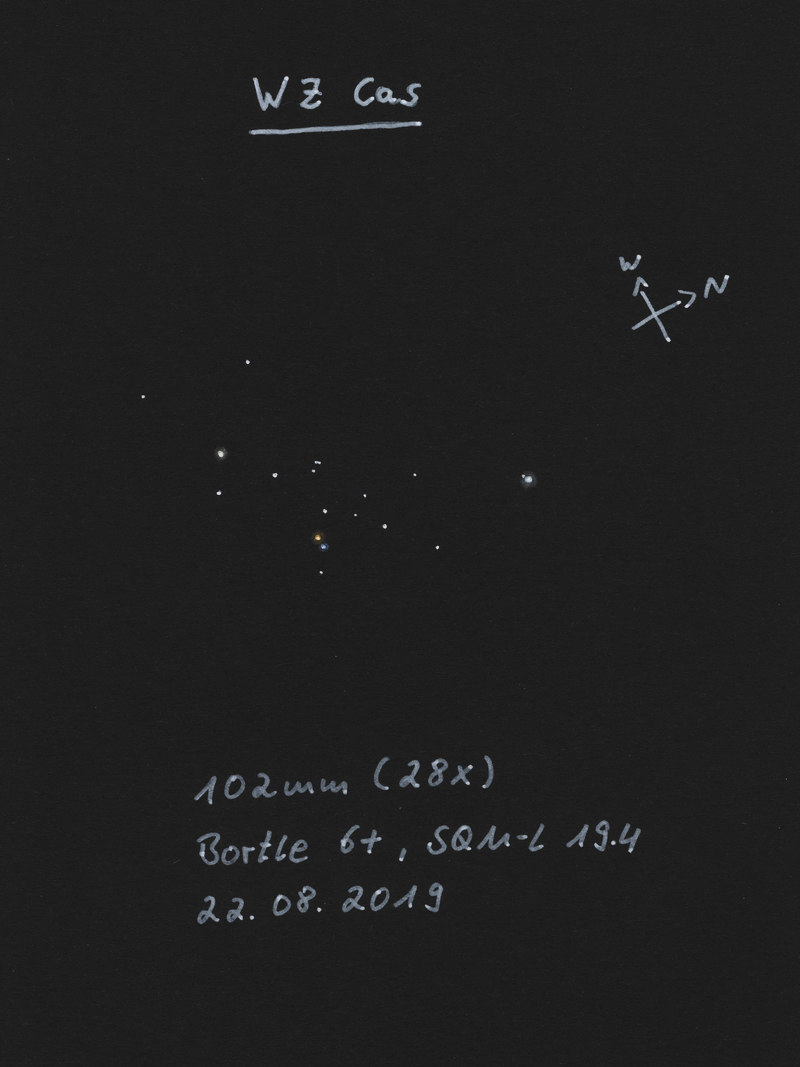
|
Jörg S. Schlimmer
Germany |
127mm (136x) |
Sehr schöner Farbkontrast |
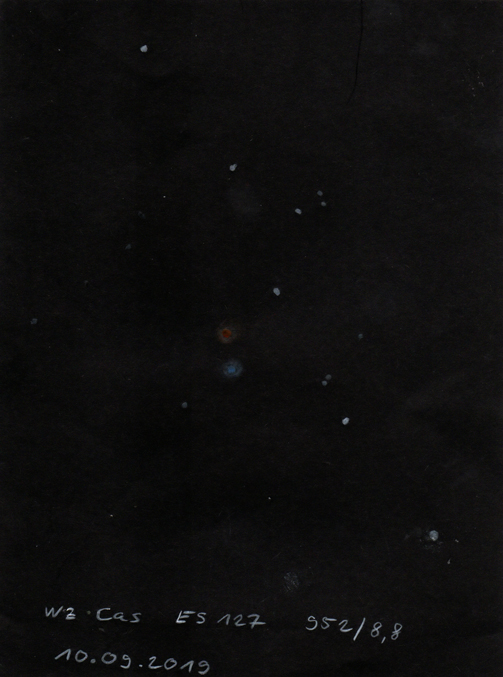
|
Mark McCarthy
Fremont (California/USA) |
317mm (553x) |
AB: WZ Cas: Pretty, deep orange A and very wide half delta mag B, white. |
|
René Merting
Drachhausen (Germany) |
320mm (45x) |
AB: bei 45x ein weit getrenntes Pärchen mit wunderschönen Farbkontrast, Komponente A im Westen ist grell-orange und die gut 1.5 Magnituden schwächere Komponente B ist aquamarin-grau |
|
|
Robert Zebahl
Leipzig (Germany) |
102mm |
|
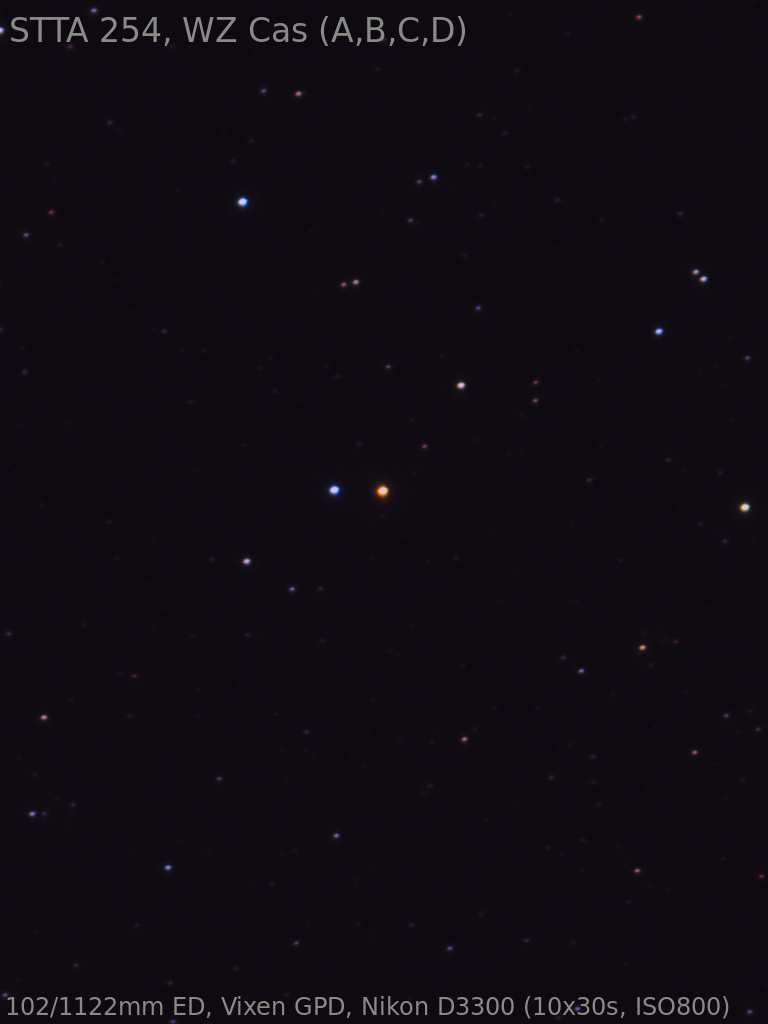
|
|
|
|
STFA1 |
|
AB |
7m.2 |
7m.4 |
47.8" |
47° |
2018 |
And |
00h46m24.34s / +30°56'33.50" |
Robert Zebahl
Leipzig (Germany) |
8x40 |
2018-10-09: Large distance with visible difference in brightness. I used a tripod. |
|
Robert Zebahl
Leipzig (Germany) |
12x42 |
2022-10-19: Medium bright, nicely separated and well recognizable as a double star in the field. The components appear similarly bright. Light orange & slightly bluish. |
|
Sarah Gebauer
Germany |
100mm (21x) |
25.09.23: mit 21-fach schon getrennt zu sehen, zwei warmweiße Glanzpünktchen - bei 49-fach wirken die beiden weit getrennten, nahezu farblosen Glanzpünktchen im sehr leeren Sternumfeld wie zwei Äuglein, die nordöstliche Komponente zeigt einen Hauch einer orangegelben Farbe, während die südwestliche sehr subtil strohgelb wirkt |
|
Uwe Pilz
Leipzig (Germany) |
105mm (26x) |
zweiter Doppelstern im Bild (ohne Bezeichnung). Gelb und orange. |
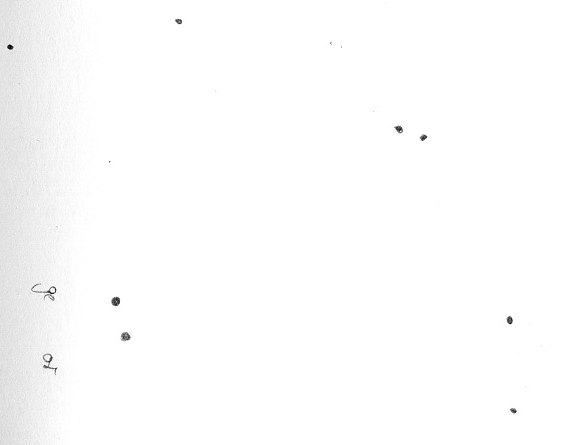
|
Mark McCarthy
Fremont (California/USA) |
317mm (277x) |
equal magnitude orange pair, wide. |
|
|
|
|
H5 82 |
|
AB |
8m.0 |
8m.3 |
56.8" |
75° |
2018 |
Cas |
00h47m24.62s / +51°05'45.90" |
René Merting
Drachhausen (Germany) |
12x42 |
ein sehr interessantes Paar, das isoliert zwischen einigen helleren Sternen steht - die Trennung der beiden etwa gleich hellen Komponenten ist ordentlich - zwischen beiden Sternen findet ein ganz eigenartiges Farbspiel statt, die Farben sind nicht wirklich richtig auszumachen, aber es gibt definitiv einen Farbunterschied |
|
René Merting
Drachhausen (Germany) |
12x50 |
ein ansehnliches Sternpaar, in der unmittelbaren Umgebung gibt es keine konkurrierenden Sterne - beide Komponenten stehen dicht zusammen und sind etwa gleich hell |
|
Robert Zebahl
Leipzig (Germany) |
16x70 |
2021-10-07: Widely separated pair with rather small difference in brightness. The primary component appears in a pale orange, the companion remained colorless. Together with STF59 in field of view. |
|
Uwe Pilz
Leipzig (Germany) |
16x70 |
|
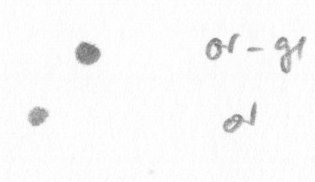
|
René Merting
Drachhausen (Germany) |
18x70 |
zwei annähernd gleich helle Sterne ziemlich weit auseinander stehend - B im Osten ist nur leicht schwächer |
|
Robert Zebahl
Leipzig (Germany) |
70mm (26x) |
Almost equally bright components with large separation. |
|
René Merting
Drachhausen (Germany) |
76mm (29x) |
bei 29x ein einfach zu trennendes Sternpaar - zwei weit getrennte, fast gleich helle Sterne - B im Osten ist eine viertel Magnitude schwächer - beide Sterne sind nicht ganz weiß, B wirkt noch etwas dumpfer |
|
Sarah Gebauer
Germany |
100mm (21x) |
25.09.23: mit 21-fach ein weit getrenntes Paar, das den Kopf eines nach Westen laufendes, gepanzerten Kriechtieres darstellt, die Schwanzsterne sind die beiden nordöstlich stehenden Sterne V526 und HD4881 - die Doppelsterne haben einen gelbbraunen Farbeindruck - mit 49-fach dominiert das Tier im Gesichtsfeld, der Doppelstern verliert leider etwas an Farbe und wirkt nur noch leicht goldfarben |
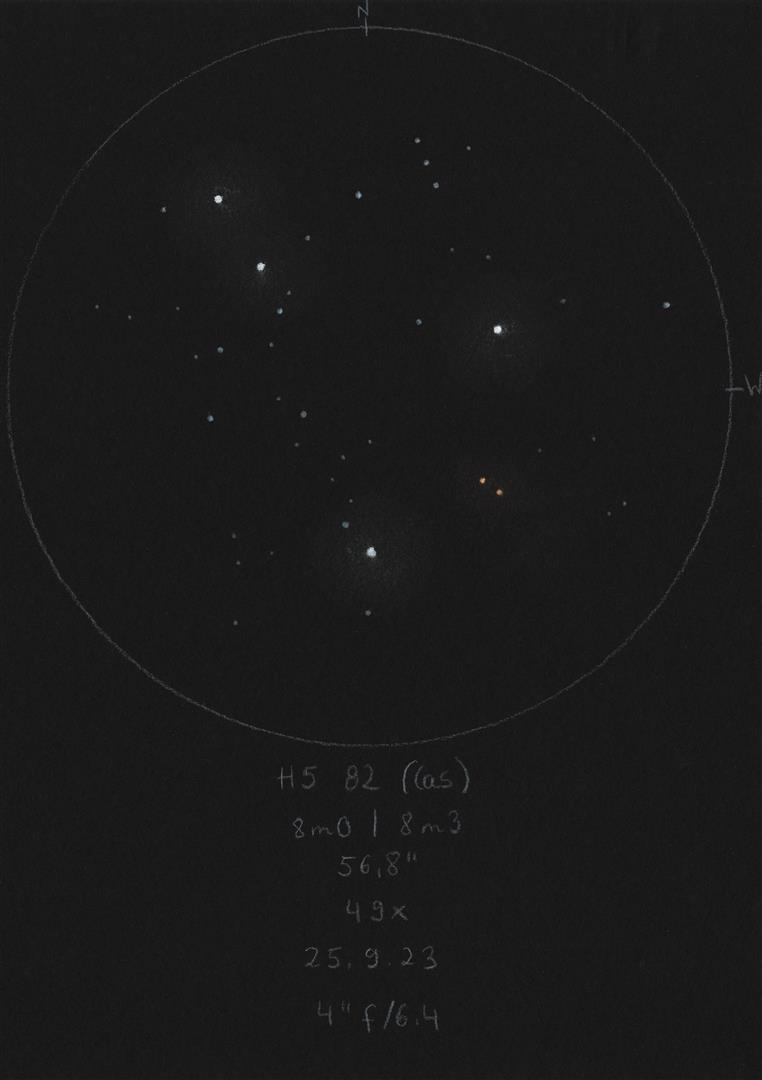
|
|
|
★★
|
STF88, psi 1 Psc, 74 Psc |
|
AB |
5m.3 |
5m.5 |
29.9" |
159° |
2020 |
Psc |
01h05m40.93s / +21°28'23.60" |
|
|
|
|
AC |
5m.3 |
10m.7 |
90.4" |
124° |
2017 |
|
|
|
|
|
|
BC |
5m.5 |
10m.7 |
68.5" |
109° |
2017 |
|
|
Christopher Hay
Seeheim (Germany) |
7x45 |
AB: Very tight but definitely split, binoculars handheld. Component A is very slightly brighter than B. |
|
Robert Zebahl
Leipzig (Germany) |
8x44 |
AB: 2020-11-25: Beautiful! Very nicely separated with little difference in brightness. White-yellowish & white-bluish. Separable even without using a tripod, but difficult. |
|
René Merting
Drachhausen (Germany) |
10x50 |
AB: ein etwas mehr als knapp getrenntes Pärchen zweier gleichheller Sterne |
|
Christopher Hay
Seeheim (Germany) |
15x45 |
AB: Well split, binoculars with internal stabilisation. Component A appears at first to be more orange than component B, but after about ten seconds the orange impression flips to component B, and from there on goes back and forth. Visited Psi1 Psc several times, taking breaks of a few minutes in-between, and each time the same effect occurred, with A initially appearing to be on the orange side. |
|
René Merting
Drachhausen (Germany) |
16x70 |
AB: ein ordentlich getrenntes helles Sternpaar, die südliche B-Komponente wirkt etwas weniger weiß - schöner Anblick |
|
Christopher Hay
Seeheim (Germany) |
18x80 |
AB: Psi1 Psc is well separated. Very strong visual presence in this instrument. Components almost identically bright, colourless. Strongly supplemented to the south in 4° field of view by Psi2, Psi3 and Chi. Field relatively empty to the north, which gives the field further tension. According to Stelledoppie a true physical double 275 light years distant. |
|
Mark McCarthy
Fremont (California/USA) |
152mm (175x) |
AB: Spot-on equal white stars, wide. WDS says physical, and they likely are binary: 29% parallax range overlap, 2,704 AU weighted separation and 2.76/2.52 Msol |
|
|
|
|
STF90, 77 Psc |
|
AB |
6m.4 |
7m.3 |
33.2" |
83° |
2020 |
Psc |
01h05m49.22s / +04°54'31.20" |
|
|
|
|
AC |
6m.4 |
13m.2 |
157.6" |
290° |
2015 |
|
|
|
|
|
|
AD |
6m.4 |
14m.6 |
42.0" |
323° |
2015 |
|
|
|
|
|
|
AE |
6m.4 |
14m.4 |
90.4" |
352° |
2015 |
|
|
Robert Zebahl
Leipzig (Germany) |
8x44 |
AB: 2020-11-25: On this evening nicely visible together with Mars in one field of view. The double star forms a nice triangle with two other stars. It is clearly separable with a fainter companion. A appeared rather cool in color, the companion somewhat warmer. Very nice sight. |
|
Christopher Hay
Seeheim (Germany) |
15x45 |
AB: Widely split. Very reminiscent in PA and delta-Mag of the pair Zeta Psc (STF100) 3° to the north, but is wider, weaker and thus overall more pleasant in this instrument. |
|
Mark McCarthy
Fremont (California/USA) |
317mm (553x) |
AB: Very easy white-yellow pair, ~0.5 delta mag, wide PA to the east. |
|
|
|
★★
|
zeta Psc, 86 Psc, STF100 |
|
AB |
5m.2 |
6m.3 |
23.1" |
64° |
2020 |
Psc |
01h13m43.80s / +07°34'31.80" |
Christopher Hay
Seeheim (Germany) |
7x50 |
On tripod. Fine split with a sliver of black between the components. No particular colour. |
|
Christopher Hay
Seeheim (Germany) |
15x45 |
Cleanly split. Western component distinctly brighter, no colour impression. |
|
Sarah Gebauer
Germany |
100mm (21x) |
24.09.23: mit 21x ein gut getrenntes Murmelpaar, die südwestliche, hellere Komponente strahlt schön warmweiß, die nordöstliche ist eine exakt verkleinerter Sterntupfen mit einem kühleren Farbton - zusammen sind sie ein sehr dominantes und durchdringendes Paar |
|
Christopher Hay
Seeheim (Germany) |
180mm (110x) |
Despite the wide separation the pair holds together visually very strongly, and dominates the FOV. And indeed, Stelledoppie states it is a true physical pair at 174 light years from us. Component A is ice-blue. I probably wouldn't have any strong colour impression coming across component B on its own, but standing next to A it seems a washed-out orange. |
|
Robert Zebahl
Leipzig (Germany) |
200mm (37x) |
Visually evident as double star and easy to find. Well split with slight difference in brightness. |
|
|
|
|
STT28 & STTA14 & BU1359 |
STT28 |
AB |
7m.5 |
8m.8 |
0.9" |
296° |
2006 |
Cep |
01h19m07.19s / +80°51'42.60" |
|
|
|
STTA14 |
AB-C |
7m.6 |
6m.7 |
127.6" |
24° |
2003 |
|
|
|
|
|
BU1359 |
CD |
6m.7 |
11m.6 |
70.2" |
154° |
2015 |
|
|
|
|
Christopher Hay
Seeheim (Germany) |
7x45 |
STTA14 (AB-C): Handheld. AB-C well separated. |
|
Christopher Hay
Seeheim (Germany) |
10x42 |
STTA14 (AB-C): AB-C: Sweeping the field on the lookout for S405, STTA14 ist immediately striking as double, AB wide apart from C. |
|
Christopher Hay
Seeheim (Germany) |
15x60 |
STTA14 (AB-C): AB-C: Wide pair, strong presence in 3.3° FOV. Northern component (C) clearly brighter. Attractive triangle of stars 1.5° to the south. |
|
Christopher Hay
Seeheim (Germany) |
180mm (200x) |
STT28 (AB): AB: Component B flashes out in good moments. PA estimated at 295° without prior knowledge.
A physical double at a distance to us of 510 light years. Observed 1 March 2021, current separation 0.846" according to Stelledoppie. |
|
|
|
|
S397, 35 Cas |
|
AB |
6m.3 |
8m.6 |
57.4" |
341° |
2018 |
Cas |
01h21m05.27s / +64°39'29.30" |
René Merting
Drachhausen (Germany) |
16x70 |
ein weit getrenntes Pärchen mit einem schönen Farbkontrast - Komponente A im Süden wirkt blau-weiß, B ist gut 1.5 Größenklassen schwächer und wirkt gräulich |
|
René Merting
Drachhausen (Germany) |
100mm (20x) |
bei 32x ein schönes helles Sternpaar, weit getrennt - auffälliger Farbkontrast, A ist reinweiß, B eher schmutzig orange-braun - zurück auf 20x ist die Trennung noch immer sehr deutlich |
|
Sarah Gebauer
Germany |
100mm (21x) |
01.10.23: bei 21-fach gut getrennt und bildet ein langes, spitzes Dreieck mit zwei Sternen östlich, von denen einer auch wieder doppelt erscheint - A im Süden strahlt in einem reinen, kühlen Weiß, B wirkt sehr beigebraun |
|
|
|
|
STT30 |
|
AB |
8m.1 |
11m.8 |
4.4" |
245° |
2015 |
Psc |
01h25m34.17s / +31°33'01.90" |
|
|
|
|
AC |
8m.1 |
8m.1 |
56.7" |
106° |
2018 |
|
|
|
|
|
|
AD |
8m.1 |
14m.3 |
21.4" |
204° |
2015 |
|
|
Robert Zebahl
Leipzig (Germany) |
12x42 |
AC: 2022-10-19: Medium bright at moderate separation. Nicely split, similarly bright components. Slightly orange & bluish. |
|
Robert Zebahl
Leipzig (Germany) |
16x70 |
AC: 2020-11-07: Very nicely separated, medium bright, moderate separation, small difference in brightness. Slightly orange & light blue. |
|
René Merting
Drachhausen (Germany) |
320mm (45x) |
AC: bei 45x sind beide Sterne weit getrennt voneinander erkennbar - beide Sterne sind gleich hell, die östliche Komponente strahlt etwas kühlweißer |
|
|
|
★★
|
S398 |
|
AB |
6m.3 |
8m.0 |
68.9" |
100° |
2018 |
Psc |
01h28m22.92s / +07°57'40.90" |
Christopher Hay
Seeheim (Germany) |
7x50 |
On tripod. Wide split. A orange-red, B a tiny pinprick of light. Attractive sight in 7.3° field of view, with Zeta Psc neatly on western edge of FOV.
Physical double according to Stelledoppie.
Three-star rating awarded because this is a physical double that can be resolved at 7x, while dominating the field of view with more power and presenting a strong colour contrast with more aperture (see 20x80 observation below). As an added bonus, S398 is just half a degree south of the ecliptic and is thus visited regularly by planets and the moon. |
|
Christopher Hay
Seeheim (Germany) |
20x80 |
Wide split. A reddish-white, B blue-white. Very strong visual presence with no competition in 2.5° field of view, accentuated nicely by 6-mag 96 Psc about 2/3° to the south. |
|
Sarah Gebauer
Germany |
100mm (49x) |
24.09.23: bei 49x ein sehr weit getrenntes Paar in einem beinahe gänzlich leeren Gesichtsfeld, auf den ersten Blick nur ein inneres Fragezeichen, wo die Farbe ist - auf den zweiten Blick strahlt A auf einmal in einem dunklen Buttergelb mit einem Hauch Orange, B im Südosten manchmal grau und manchmal schwach, aber hell und metallisch azurbläulich - mit ausreichend Geduld zeigt sich ein zurückhaltendes, schönes Perlchen! |
|
Mark McCarthy
Fremont (California/USA) |
317mm (553x) |
orange with 1 delta mag white to east. |
|
|
|
★
|
STT33 & DOB2 |
STT33 |
AB |
7m.3 |
9m.0 |
26.9" |
77° |
2015 |
Cas |
01h37m22.87s / +58°38'14.70" |
|
|
|
DOB2 |
AC |
7m.3 |
10m.3 |
107.0" |
109° |
2015 |
|
|
René Merting
Drachhausen (Germany) |
12x42 |
STT33 (AB): B ist relativ schwach östlich von A erkennbar, getrennt und relativ dicht stehend - Helligkeitsunterschied zwei Größenklassen |
|
René Merting
Drachhausen (Germany) |
16x70 |
STT33 (AB): ein isoliert stehendes gut getrenntes Pärchen mit schönem Farbkontrast - Komponente B im Osten wirkt rot-braun, weil die weiße Komponente A gut 1.5 Größenklassen heller ist |
|
René Merting
Drachhausen (Germany) |
100mm (20x) |
STT33 (AB): bei 32x stehen beide Komponenten weit auseinander - Komponente B im Osten ist gut 1.5 Größenklassen schwächer als A - Farbkontrast rein weiß (A) vs. orange-braun (B) - südöstlich von A in 4-facher Entfernung AB steht ein weiterer schwacher Stern (Komponente C mit 10.29 mag/ AC mit eigener Bezeichnung: DOB 2) - zurück auf 20x bilden A und B ein schönes enges Paar, Komponente C ist auch noch knapp erkennbar |
|
René Merting
Drachhausen (Germany) |
100mm (32x) |
DOB2 (AC): Komponente C als Anhängsel von STT33 - Komponente C ist bei 32x sehr weit südöstlich von A erkennbar, vierfacher Abstand AB (STT33) - zurück auf 20x sind alle drei Komponenten ebenfalls noch zu erkennen |
|
Mark McCarthy
Fremont (California/USA) |
317mm (340x) |
STT33 (AB): Pretty yellow-white and red-orange pair, wide, 1.5-2 delta mag. Nearby X Cas a very pretty red. |
|
René Merting
Drachhausen (Germany) |
320mm (45x) |
STT33 (AB): ein schönes Farbkontrastpaar - Komponente A strahlt weißgelblich, B dagegen braun-orange - ordentlicher Abstand zwischen beiden |
|
|
|
|
STF162 |
|
AB |
6m.5 |
7m.2 |
2.0" |
199° |
2020 |
Per |
01h49m15.47s / +47°53'47.10" |
|
|
|
|
AC |
6m.5 |
9m.2 |
20.7" |
178° |
2020 |
|
|
|
|
|
|
AD |
6m.5 |
10m.0 |
138.7" |
96° |
2007 |
|
|
|
|
|
|
BC |
7m.2 |
9m.2 |
19.2" |
177° |
2018 |
|
|
René Merting
Drachhausen (Germany) |
16x70 |
AC: ein schwieriges Paar aufgrund des Helligkeitsunterschiedes - mit etwas Geduld offenbart sich Komponente C knapp südlich von A sehr dicht an dessen hellem Glanz - die Trennung ist nur in ruhigen Momenten kurzzeitig sichtbar |
|
Robert Zebahl
Leipzig (Germany) |
70mm (100x) |
AB: At 100x partly split, otherwise '8'-shaped. At 128x clearly split. Difference in brightness noticeable. |
|
René Merting
Drachhausen (Germany) |
76mm (29x) |
AC: bei 29x ist C im Süden gut abgesetzt von A erkennbar - C wirkt aufgrund seiner Schwäche wie ein Schatten von A |
|
Uwe Pilz
Leipzig (Germany) |
105mm (144x) |
|
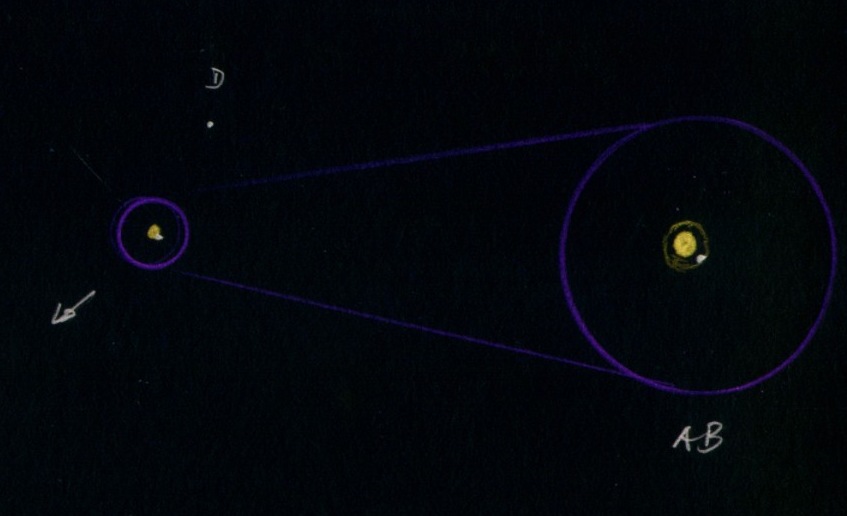
|
|
|
|
STF163 |
|
AB |
6m.8 |
9m.1 |
34.5" |
37° |
2018 |
Cas |
01h51m16.93s / +64°51'17.90" |
René Merting
Drachhausen (Germany) |
16x70 |
ein ordentlich getrenntes Pärchen - Komponente A im SW strahlt gelblich, B im NO ist schwach erkennbar, aber nicht schwer |
|
Robert Zebahl
Leipzig (Germany) |
70mm (20x) |
Easily split at 20x. From 44x the brighter component was orange colored, the fainter one tends to be more bluish. |
|
René Merting
Drachhausen (Germany) |
76mm (29x) |
bei 29x einfach und eindrucksvoll - A strahlt im ersten Moment kupferorange, je länger ich drauf schaue, desto mehr wird er heller, gelblicher - Komponente B im Nordosten ist ein kleiner, grauer Kleks - Helligkeitsunterschied zwei Größenklassen |
|
Mark McCarthy
Fremont (California/USA) |
317mm (553x) |
Pretty orange star in the 80mm finder. Wide separated blue B, 2 delta mag. |
|
|
|
|
H6 69, 14 Ari |
|
AB |
5m.0 |
8m.0 |
93.1" |
35° |
2014 |
Ari |
02h09m25.29s / +25°56'23.90" |
|
|
|
|
AC |
5m.0 |
8m.0 |
106.0" |
279° |
2014 |
|
|
Christopher Hay
Seeheim (Germany) |
7x50 |
On tripod. C presents as a micro-fine point of light, set off well from A. No trace of B, see on this my observation in the same night with 180mm aperture. |
|
Christopher Hay
Seeheim (Germany) |
15x45 |
Binoculars with internal stabilisation, handheld. C far distant from A. Due to this distance and the major delta-mag the two stars do not present the appearance of a double, C looks rather like a field star.
Yet in fact the two are a true physical double at a distance to us of 289 light years. |
|
Christopher Hay
Seeheim (Germany) |
71mm (13x) |
A-C wide split, C a fine little point of light.
Visually un-exciting as such, the attraction of this pair resides partly in contemplating that it is a true physical double. Furthermore, in this small refractor 14 Arietis AC can be observed together with another physical double in the 5.5° FOV, namely Lambda Arietis (listed here as H5 12). |
|
Christopher Hay
Seeheim (Germany) |
180mm (113x) |
Components A, B and C from a wide grouping. B is very faint, somewhere around 11m to 12m, in contrast to the 8m0 stated by Stelledoppie. Observed on 12 February 2021. Is B variable? DSS sky survey shows the same delta-mags that I saw, so it rather appears that Stelledoppie has a mistake in its database.
A is creamy white, C grey, B too faint for any definite colour impression.
According to Stelledoppie a physical triple system at a distance to us of 289 light years. |
|
|
|
★★
|
59 And, STF222 |
|
|
6m.0 |
6m.7 |
16.6" |
36° |
2019 |
And |
02h10m52.83s / +39°02'22.40" |
Robert Zebahl
Leipzig (Germany) |
8x44 |
2020-11-25: Just separated with visible difference in brightness. |
|
René Merting
Drachhausen (Germany) |
16x70 |
ein sehr dichtes Sternpaar, ganz knapp getrennt sichtbar - Komponente B im NO ist eine halbe Größenklasse schwächer - leichter Farbunterschied und das Phänomen, dass der Farbkontrast zwischen beiden Sternen immer hin und her springt - ich kann nicht genau sagen, welcher Stern das kühlere oder wärmere Weiß hat |
|
Christopher Hay
Seeheim (Germany) |
71mm (32x) |
Widely separated. Primary slightly orange, secondary blueish. Very attractive and without visual competition in 2.5° FOV.
A physical double at a distance to us of 456 light years. |
|
René Merting
Drachhausen (Germany) |
100mm (32x) |
bei 32x ein auffälliges Sternpaar - gut getrennt mit leichtem Farbkontrast, Komponente A im SW ist weiß, die Komponente B zwar auch, aber mit einem Stich ins orange, eigenartig - Helligkeitsunterschied eine halbe Magnitude |
|
Robert Zebahl
Leipzig (Germany) |
120mm (18x) |
Well split with noticeable difference in brightness. |
|
Robert Zebahl
Leipzig (Germany) |
200mm (100x) |
Conditions in the target region: SQM-L 20.4
Nice and evident double star, easy to split. About 12 arcminutes NE there is NGC828 (v12.3m), |
|
René Merting
Drachhausen (Germany) |
320mm (45x) |
bei 45x ein schönes, helles Sternpaar, sehr auffällig im Umfeld, ordentlich getrennt - Helligkeitsunterschied eine viertel bis eine halbe Größenklasse - leichter, aber schwer greifbarer Farbkontrast |
|
|
|
★
|
S405 |
|
AB |
6m.5 |
7m.2 |
55.7" |
277° |
2019 |
Cep |
02h12m49.98s / +79°41'29.30" |
|
|
|
|
BC |
7m.2 |
13m.9 |
51.2" |
224° |
2015 |
|
|
Christopher Hay
Seeheim (Germany) |
10x42 |
AB: B well set off from A.
South 405 (aka STTA 22 and H5 84) is a physical double at a distance to us of 121 light years. |
|
Christopher Hay
Seeheim (Germany) |
15x60 |
AB: Wide pair. A seems a little yellowish. |
|
Christopher Hay
Seeheim (Germany) |
71mm (32x) |
AB: Wide apart. A distinctly brighter and distinctly more yellowish than B. |
|
René Merting
Drachhausen (Germany) |
100mm (20x) |
AB: bei 20x weit auseinander stehendes helles Pärchen - beide Sterne sind etwa gleich hell (laut Stelle Doppie 0.68 mag Helligkeitsunterschied) |
|
|
|
|
STF230 |
|
|
7m.9 |
9m.4 |
23.8" |
259° |
2015 |
Per |
02h14m57.07s / +58°29'26.00" |
Robert Zebahl
Leipzig (Germany) |
16x70 |
2021-10-07: Located right next to the cluster Stock 2. Medium bright, well split at moderate separation and clear difference in brightness. |
|
René Merting
Drachhausen (Germany) |
16x70 |
ein knapp getrenntes Pärchen - Komponente B westlich von A wirkt wie ein schwacher Schimmer - kaum ein Farbunterschied, obwohl B gut 1.5 Größenklassen schwächer ist - bei diesem Helligkeitsunterschied wirkt die schwächere Komponente meist dumpf grau-braun, hier ist das nicht der Fall |
|
René Merting
Drachhausen (Germany) |
100mm (20x) |
bei 32x einfach getrennt - Komponente B im Westen ist gut 1.5 Größenklassen schwächer und grau, A ist auch nicht wirklich strahlend weiß - zurück auf 20x noch immer ein gut getrenntes Pärchen |
|
|
|
|
STF239 |
|
EC |
7m.1 |
7m.8 |
14.0" |
212° |
2019 |
Tri |
02h17m25.29s / +28°44'42.10" |
Robert Zebahl
Leipzig (Germany) |
12x42 |
2022-10-19: Seperated, but pretty tight components with a moderate difference in brightness. |
|
Robert Zebahl
Leipzig (Germany) |
16x70 |
2020-11-07: Very nicely embedded in group of brighter and medium bright stars. Components relatively tight with little difference in brightness. Colorwise inconspicuous. Forms a trapezoid with three other stars in the north. |
|
Robert Zebahl
Leipzig (Germany) |
55mm (25x) |
Easy to split, large distance, noticeable difference in brightness. |
|
Mark McCarthy
Fremont (California/USA) |
203mm (205x) |
Wide, white, one delta mag |
|
René Merting
Drachhausen (Germany) |
320mm (45x) |
bei 45x klar getrennt, ein relativ helles Sternpaar in einem Umfeld mit noch helleren Sternen - A wirkt warmweiß, B dagegen hat einen Hauch blau im weiß - Helligkeitsunterschied eine halbe Größenklasse - bei 144x verstärkt sich dieser dezente Farbkontrast |
|
Karsten Kopp
Köln (Germany) |
600mm (180x) |
Sehr leicht zu trennender Doppelstern, mit einem gut erkennbaren Helligkeitsunterschied. Die Sterne leuchten gelblich-weiß bzw. weißlich. |
|
|
|
|
STF270 |
|
AB |
7m.0 |
9m.7 |
21.3" |
305° |
2016 |
Per |
02h30m50.65s / +55°32'54.20" |
|
|
|
|
AC |
7m.0 |
11m.4 |
48.0" |
333° |
2015 |
|
|
|
|
|
|
AD |
7m.0 |
14m.2 |
51.1" |
281° |
2015 |
|
|
|
|
|
|
BD |
9m.7 |
14m.2 |
32.8" |
265° |
2015 |
|
|
René Merting
Drachhausen (Germany) |
16x70 |
AB: der Doppelstern steht innerhalb einer sehenswerten Formation aus 6 Sternen, die ein gleichseitiges Dreieck bilden - die hellsten drei Sterne bilde eine Seite im Norden, zur Spitze nach Süden werden die Sterne immer schwächer - STF270 steht mitten in der Nordseite - Komponente B ist wie ein kleiner zarter Hauch nordwestlich von A erkennbar, Helligkeitsunterschied mehr als 2.5 Größenklassen - kein reizvoller Fernglas-Doppelstern, aber die Umgebung ist interessant |
|
René Merting
Drachhausen (Germany) |
100mm (32x) |
AB: bei 32x ein leichter Fang, ein gut getrenntes Pärchen - Komponente B im NW ist zwar sehr schwach, aber direkt immer noch gut erkennbar - Helligkeitsunterschied 3 Größenklassen - Komponente A strahlend weiß, B eher grau, wenn überhaupt als Farbe erkennbar |
|
Uwe Pilz
Leipzig (Germany) |
105mm (184x) |
AB: STF270 und STF 268 sind auf einen Blick sichtbar: Beide getrennt |

|
Mark McCarthy
Fremont (California/USA) |
317mm (553x) |
AB: Nice orange star with wide B |
|
|
|
★★★
|
AG304, 15 Tri |
|
|
5m.6 |
6m.8 |
142.4" |
16° |
2013 |
Tri |
02h35m46.82s / +34°41'15.20" |
Christopher Hay
Seeheim (Germany) |
7x50 |
Well split. Main star yellow-orange, secondary an ice-blue pinprick. With overall brightness of 5m1 just visible to naked eye under my suburban sky. Interesting star field with a line of 5 stars pointing S-SW away from 15 Tri and a further striking star chain to the west. Placing Gamma-Delta-7 Tri within 7.5° FOV makes a very attractive overall field. Mira variable R Tri just ½ degree to the S-SE was around maximum at time of observation and presented a much paler orange than 15 Tri A. Charming colour contrast ensemble with the two components of the double plus the variable. |
|
René Merting
Drachhausen (Germany) |
18x70 |
ein extrem komfortabel getrenntes Sternpaar - Komponente A im Süden strahlt weißgelb, B ist 1.5 Größenklassen schwächer und wirkt kupfergrau - interessant: parallel zu den beiden Sternen stehen westlich zwei deutlich schwächere Sterne in gleichem Abstand und Positionswinkel wie die Komponenten von 15 Tri - alle 4 Sterne bilden ein Parallelogramm |
|
Christopher Hay
Seeheim (Germany) |
80mm (30x) |
A beautiful, wide pair. Main star orangish yellow, secondary ice-blue. Attractive star field in 2.7° FOV: several similarly-separated pairs to the north and east, and two striking star chains to the south and west. |
|
Sarah Gebauer
Germany |
100mm (21x) |
ein wirklich schönes, farbiges Pärchen, das schon bei geringster Vergrößerung deutlich getrennt und in einem Eisblau und leichtem Orange strahlt, zudem bildet es mit der markanten Sternkette östlich davon, die im Refraktor mit Amiciprisma ein auf dem Kopf stehendes T bildet, ein tolles Gesamtbild |
|
Sarah Gebauer
Germany |
100mm (21x) |
25.09.23: mit 21-fach erinnert dieser Doppelstern fast an das Farbkontrastdoppel Delta Cephei, er ist weit getrennt und zeigt eine ganz klassisch warm gelbgoldene A-Komponente und in sehr weitem Abstand eine metallisch azurblau leuchtende B-Komponente |
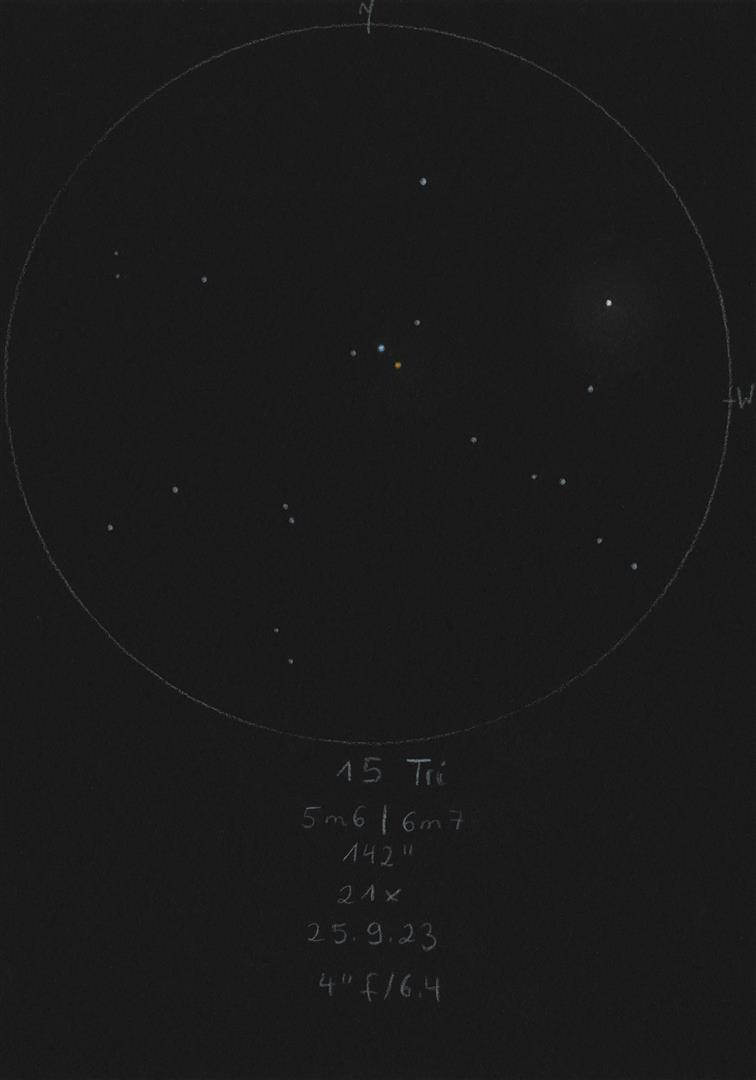
|
René Merting
Drachhausen (Germany) |
320mm (45x) |
bei 45x weit auseinanderstehend, aber dennoch schön anzusehen - A ist rapsgelb, B im Norden wirkt unterkühlt weiß bis graublau |
|
|
|
★
|
eta Per, 15 Per, Miram |
STF307 |
AB |
3m.8 |
8m.5 |
28.7" |
301° |
2018 |
Per |
02h50m41.81s / +55°53'43.80" |
|
|
|
STF307 |
AC |
3m.8 |
11m.6 |
64.0" |
269° |
2014 |
|
|
|
|
|
SHJ34 |
AE |
3m.8 |
9m.2 |
242.9" |
297° |
2012 |
|
|
|
|
|
WAL19 |
AF |
3m.8 |
11m.4 |
57.7" |
25° |
2013 |
|
|
|
|
|
WRD1 |
CD |
11m.6 |
12m.7 |
5.2" |
116° |
2015 |
|
|
|
|
|
FYM161 |
CG |
11m.6 |
14m.0 |
15.8" |
229° |
2015 |
|
|
René Merting
Drachhausen (Germany) |
16x70 |
STF307 (AB): Miram, die Komponente A ist satt gelb und bildet ein flaches Dreieck mit zwei Sternen westlich und nordwestlich, die 1,8' und 3,9' entfernt stehen - dazwischen wird alles vom Glanz von Miram überstrahlt - im Fernglas hat B mit den eigentlich ordentlichen Daten wie Abstand 30,4" und Helligkeit 8.5 mag (andere Quellen sagen 10.7 mag) trotzdem keine Chance auf Erleuchtung |
|
René Merting
Drachhausen (Germany) |
76mm (29x) |
STF307 (AB): bei 29x zeigt Miram sich in einem wunderschönen Bernsteingelb - die B-Komponente steht leicht abgesetzt westlich von A und ist deutlich schwächer, wie ein zartes Anhängsel |
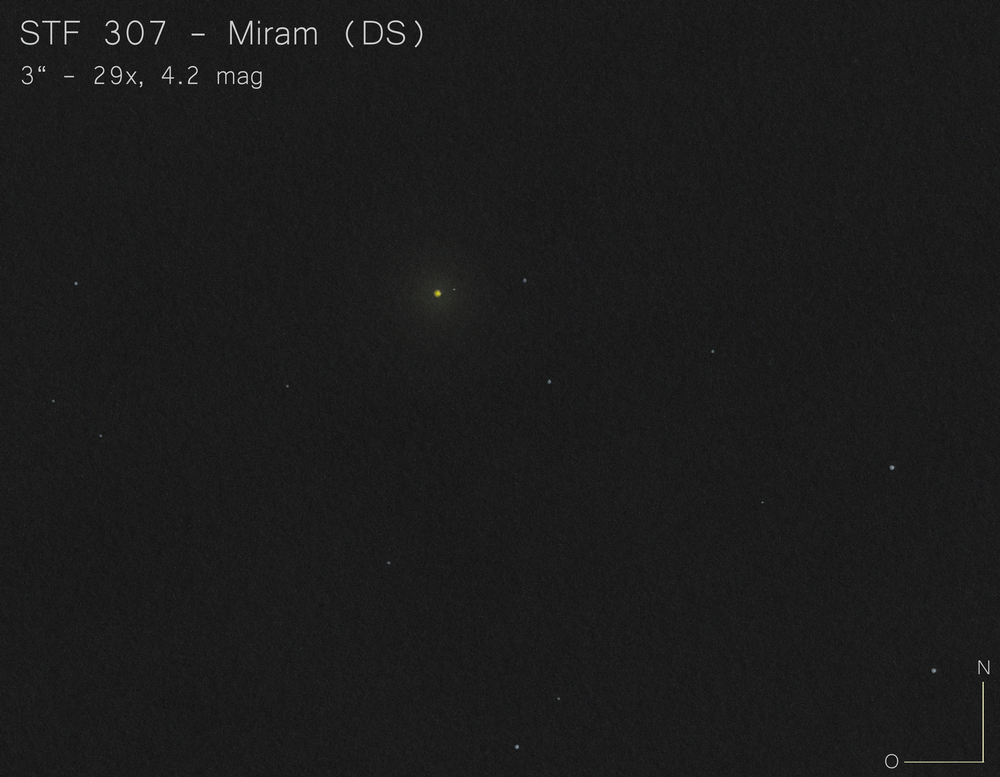
|
René Merting
Drachhausen (Germany) |
100mm (32x) |
STF307 (AB): bei 32x sehr ansehnlich - Komponente B steht gut getrennt nordwestlich vom signal-gelben Eta Persei - Helligkeitsunterschied sehr groß, nicht abschätzbar |
|
Uwe Pilz
Leipzig (Germany) |
105mm (88x) |
Dreifachsystem, nahe Komponente: PW und Abstand stimmt, is aber viel zu dunkel (10m statt 8m5). Ein Mysterium |
|
Sarah Gebauer
Germany |
254mm (96x) |
STF307 (AB): eine große, goldgelbe Komponente und nordwestlich davon ein kleiner, sehr blauer Begleiter |
|
Mark McCarthy
Fremont (California/USA) |
317mm (553x) |
STF307 (AB): Orange with faint, bluish, widely separated B. |
|
|
|
|
STF396 |
|
AB |
6m.4 |
7m.7 |
20.5" |
245° |
2019 |
Cam |
03h33m32.19s / +58°45'55.30" |
René Merting
Drachhausen (Germany) |
18x70 |
in diesem FG ein schönes enges (knapp getrenntes) Paar - B steht südwestlich - weil beide Sterne so eng stehen, ist der Helligkeitsunterschied schwer abschätzbar, ich denke 1 bis 1.5 Größenklassen |
|
René Merting
Drachhausen (Germany) |
76mm (29x) |
ein schönes Sternpaar für 29x - beide Komponenten zeigen sich klar getrennt - Helligkeitsunterschied mehr als eine Größenklasse - leichter Farbkontrast, A ist klarweiß, B im Westen wirkt grau mit einem Stich ins bräunliche |
|
|
|
★★
|
S430 |
|
AB |
7m.2 |
7m.5 |
41.0" |
96° |
2017 |
Per |
03h38m18.83s / +44°48'06.50" |
Christopher Hay
Seeheim (Germany) |
7x50 |
On tripod. Well separated. A evidently brighter than B. A appears to tend towards orange, B rather towards blue.
Most of the Alpha-Persei cluster can be viewed together with S430 in 7.2° FOV. Seen thus, S430 feels likes a distant little echo of the powerfully orange-blue pair Sigma Per in the cluster.
South 430 is a physical double at a distance to us of 498 light years. |
|
Christopher Hay
Seeheim (Germany) |
15x45 |
Binoculars with internal stabilisation, handheld. AB widely separated, greater brightness of A is distinct. The colour hues that were uncertain in 7x50 are now clearer. Colours confirmed in 15x60 on tripod. |
|
Robert Zebahl
Leipzig (Germany) |
16x70 |
2020-11-07: Easily separated at moderate separation, nearly equal in brightness. White-yellowish & white-bluish. |
|
René Merting
Drachhausen (Germany) |
16x70 |
ein schöner Fernglas-Stern - beide Komponenten sind hell genug und stehen weit genug auseinander - sie sind mehr als ordentlich getrennt - die B-Komponente im Osten wirkt ein bisschen wärmer im Farbton |
|
Sarah Gebauer
Germany |
100mm (21x) |
01.10.23: bei 21-fach gut getrennt, zwei nadelfeine Pünktchen, die einen absolut minimalen Farbkontrast zeigen, der fast nicht erkennbar ist - bei 49-fach verschwindet dieser zarte Farbeffekt leider, A und B werden zu zwei warmweißen Pünktchen, |
|
René Merting
Drachhausen (Germany) |
107mm (30x) |
bei 30x ein auffälliges, ordentlich getrenntes Sternpaar, B im Osten strahlt etwa eine viertel Größenklassen schwächer, beide Sterne strahlen weiß, B minimal dunkler |
|
|
|
|
STTA36 |
|
A-BC |
6m.9 |
8m.3 |
45.9" |
71° |
2019 |
Cam |
03h39m58.81s / +63°52'13.40" |
René Merting
Drachhausen (Germany) |
18x70 |
ein mehr als gut getrenntes Pärchen mit einem leichten Farbkontrast - Komponente B im Westen ist gut eine Größenklasse schwächer und wirkt graublau - A hat sich wie meist gut die Zähne geputzt, strahlend weiß - übrigens auch ein schöner Kontrast mit dem ebenfalls im Gesichtsfeld stehenden etwas mehr als 1° südlich befindlichen Stern U Cam, der knallig orange strahlt |
|
René Merting
Drachhausen (Germany) |
76mm (29x) |
bei 29x ein schönes Kontrastpärchen - Komponente BC weit getrennt im Osten wirkt nur halb so hell wie A - Farbeindruck bei B mitunter leicht kupfergrau |
|
|
|
★
|
WEB2 |
|
AB |
5m.7 |
13m.8 |
23.4" |
98° |
2011 |
Cam |
03h42m42.73s / +59°58'09.80" |
|
|
|
|
AC |
5m.7 |
13m.0 |
34.5" |
303° |
2011 |
|
|
|
|
|
|
AD |
5m.7 |
8m.4 |
54.8" |
36° |
2019 |
|
|
|
|
|
|
AE |
5m.9 |
11m.8 |
168.4" |
162° |
2003 |
|
|
René Merting
Drachhausen (Germany) |
18x70 |
AD: ein komfortabel getrenntes sehr ungleiches Paar - Komponente A im Südwesten ist hell und cremegelb - Komponente D muss mindestens 3 Größenklassen schwächer sein und wirkt dadurch wie eine graue Maus |
|
René Merting
Drachhausen (Germany) |
76mm (29x) |
AD: bei 29x ein komfortabel getrenntes Paar - Bim Nordosten ist mindestens 2 Größenklassen schwächer und wirkt mausgrau gegen die hell strahlende weißgelbliche A-Komponente |
|
Sarah Gebauer
Germany |
100mm (49x) |
AD: 26.09.23: bei 49-fach ein weit getrenntes Farbkontrastpaar - die südliche Komponente strahlt orange, die nördliche grau bis eisblau |
|
|
|
★★
|
STF434 |
|
AB |
7m.8 |
8m.3 |
33.7" |
83° |
2019 |
Per |
03h43m58.92s / +38°22'25.60" |
|
|
|
|
AC |
7m.8 |
13m.6 |
91.9" |
350° |
2015 |
|
|
Robert Zebahl
Leipzig (Germany) |
16x70 |
AB: 2020-11-07: Beautiful sight! Nice separation and color contrast: vivid orange & subtle blue. |
|
Sarah Gebauer
Germany |
100mm (21x) |
AB: schon in Aufsuchvergrößerung sofort farbig zu erkennen - die westliche Komponente ist etwas farbintensiver, ein richtiges Roségold mit einem warmen Rotstich - die zweite Komponente hat eine ähnliche Farbe, wenn auch blasser, kleiner und matter - bei 49-fach ist durch die weitere Trennung die Farbwahrnehmung deutlich einfacher: der westliche Stern bleibt schön Roségold mit Rotstich, der östliche wirkt nun kühl-bläulich, aber nicht durchgehend |
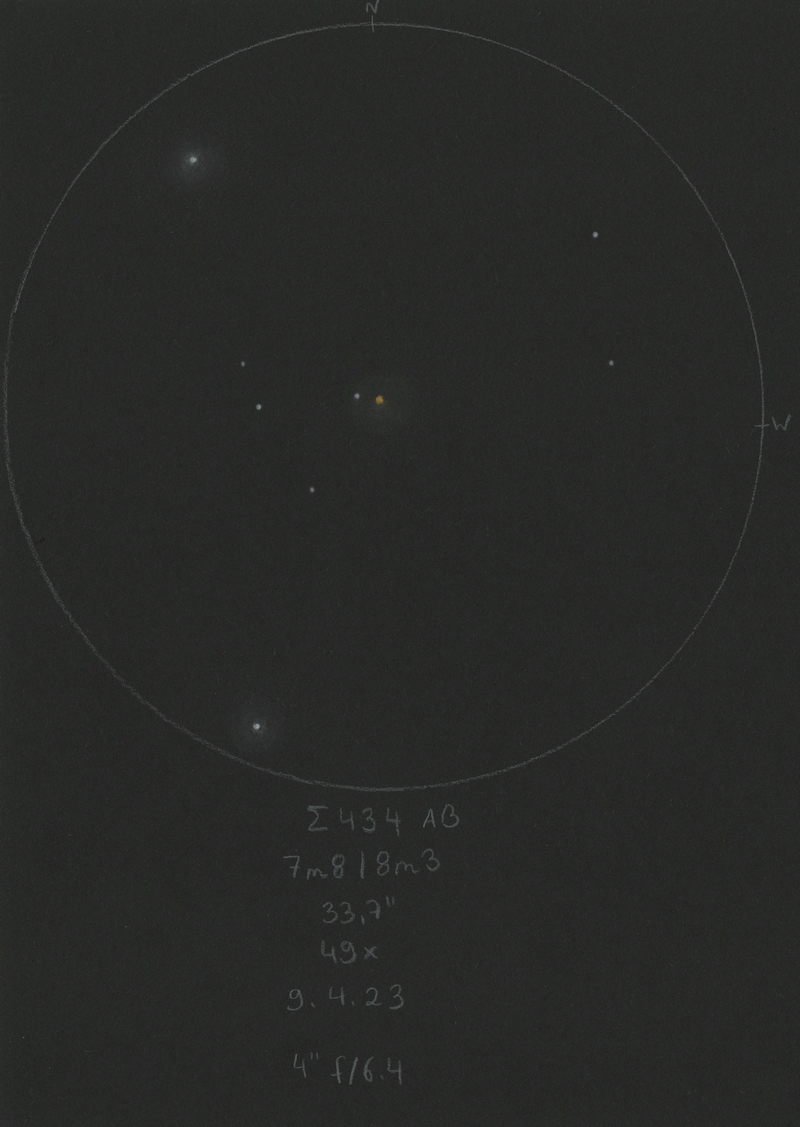
|
Robert Zebahl
Leipzig (Germany) |
102mm (28x) |
AB: 2020-11-08: Easy to separate, beautiful sight! Light orange & light blue. |
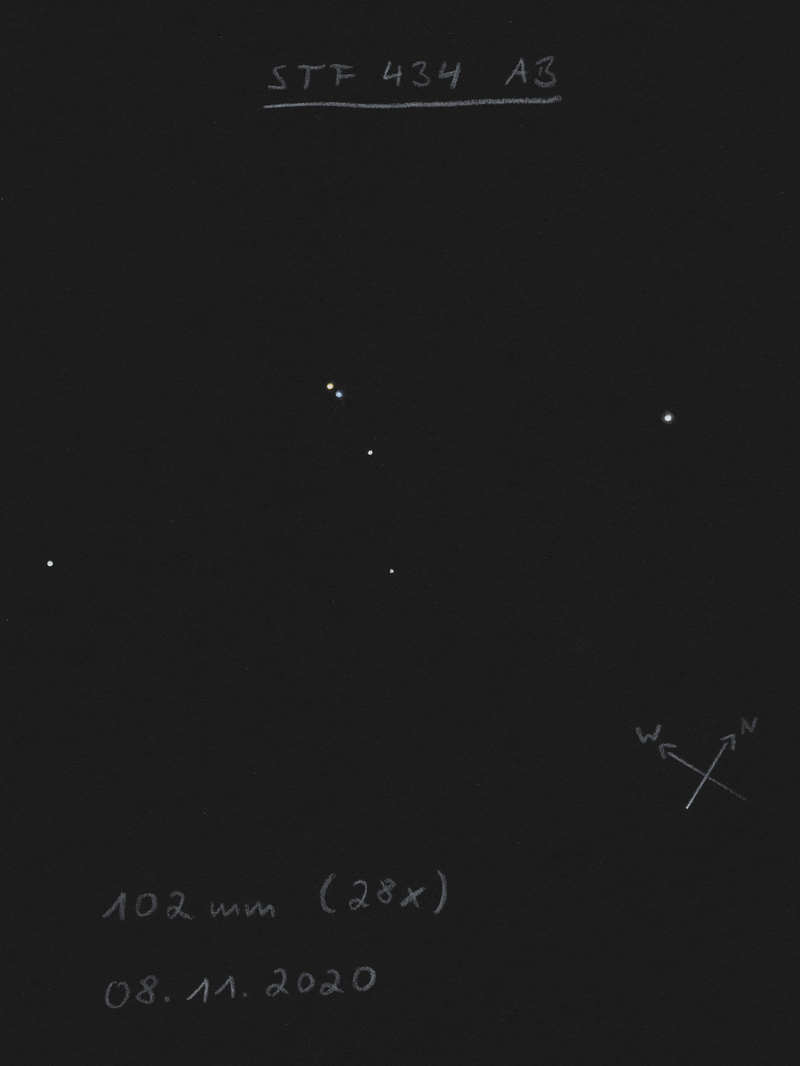
|
René Merting
Drachhausen (Germany) |
107mm (30x) |
AB: bei 30x fällt die A-Komponente westlich gleich als mattgelber Stern mit einem orange Tupf auf, B im Osten ist etwa eine halbe Größenklasse schwächer und wirkt ganz zart blaugrün - bei 60x ist A richtig schön dunkelgelb, fast ins Orange gehende, B wirkt immer wieder grüngrau |
|
|
|
|
HJ3253 |
|
|
8m.1 |
9m.7 |
31.9" |
73° |
2015 |
Tau |
03h52m10.39s / +26°13'53.00" |
René Merting
Drachhausen (Germany) |
18x70 |
Komponente B zeigt sich schwach aber gut getrennt östlich von A - mindestens 1.5 Größenklassen Helligkeitsunterschied |
|
Karsten Kopp
Köln (Germany) |
600mm (180x) |
Sehr einfach zu trennender Doppelstern mit einem leichten Helligkeitsunterschied von etwas mehr als 1,5 mag. |
|
|
|
|
STF476 |
|
AB |
8m.0 |
9m.2 |
25.9" |
289° |
2015 |
Per |
04h01m34.83s / +38°39'55.80" |
|
|
|
|
BC |
9m.2 |
13m.1 |
69.7" |
210° |
2015 |
|
|
Robert Zebahl
Leipzig (Germany) |
16x70 |
AB: 2020-11-07: Easy to split at moderate distance and clear difference in brightness. Companion well visible as a tiny star. Primary component appears slightly orange. |
|
René Merting
Drachhausen (Germany) |
107mm (30x) |
AB: bei 30x schon ordentlich getrennt, ein feines, kleines Sternpaar mit einer warmweißen bis gelblichen A-Komponente und einer grauweißen B-Komponente - bei 60x zeigt sich A flüchtig betrachtet recht intensiv gelb, beim direkten Anblick verblasst die Farbe etwas, B bleibt mausgraublau |
|
|
|
|
SZ Cam |
ES2603 |
AB |
6m.9 |
12m.9 |
6.7" |
256° |
2018 |
Cam |
04h07m51.38s / +62°19'48.40" |
|
|
|
STF485 |
AC |
6m.9 |
13m.5 |
11.2" |
0° |
2018 |
|
|
|
|
|
STF485 |
AD |
6m.9 |
14m.1 |
14.4" |
131° |
2018 |
|
|
|
|
|
STF485 |
AE |
6m.9 |
6m.9 |
18.0" |
305° |
2018 |
|
|
|
|
|
STF485 |
AF |
6m.9 |
11m.7 |
36.1" |
320° |
2017 |
|
|
|
|
|
STF484 |
AG |
6m.9 |
9m.6 |
59.9" |
260° |
2017 |
|
|
|
|
|
STF484 |
AH |
6m.9 |
10m.5 |
56.6" |
256° |
2017 |
|
|
|
|
|
STF484 |
AI |
6m.9 |
9m.8 |
69.4" |
279° |
2017 |
|
|
|
|
|
STF484 |
AL |
6m.9 |
9m.8 |
98.1" |
71° |
2017 |
|
|
|
|
|
HZG2 |
AN |
6m.9 |
9m.6 |
115.9" |
206° |
2017 |
|
|
|
|
|
STF485 |
AO |
6m.9 |
9m.4 |
138.4" |
78° |
2017 |
|
|
|
|
Robert Zebahl
Leipzig (Germany) |
8x40 |
AE: Split, but very tight with equally bright components. I used a tripod. |
|
René Merting
Drachhausen (Germany) |
15x56 |
AE: der Doppelstern ist knapp getrennt erkennbar - beide Komponenten sind gleich hell |
|
René Merting
Drachhausen (Germany) |
18x70 |
AE: die beiden hellen Sterne im OS 1502 - knapp getrennt, gleich hell - es würde noch genau solch ein heller Stern zwischen die beiden passen |
|
Robert Zebahl
Leipzig (Germany) |
70mm (15x) |
AE: Easily split with nearly equally bright components. Located in the center of the open cluster NGC1502. Very nice view. |
|
René Merting
Drachhausen (Germany) |
76mm (29x) |
AE: bei 29x zwei gleich helle Sterne, gut getrennt und umgeben von vielen sehr viel schwächeren Sternen - ganz leichter Farbkontrast, der westliche Stern wirkt ein klein wenig warmweißer |
|
Sarah Gebauer
Germany |
100mm (80x) |
26.09.23: bei 80-fach sind zahlreiche Komponenten des recht mittig im Golden Harp Cluster NGC 1502 stehenden Mehrfachsystem gut getrennt zu sehen
STF 484: die helle Komponente A strahlt warmweiß bis leicht gelb, weiter im Westen sind GH und I als ähnlich weit getrenntes Doppel zu sehen, weiter südlich schimmert R mit deutlichem Helligkeitsunterschied und noch etwas südlich ist die leicht hellere Komponente N zu sehen
STF 485: die hellste Komponente A mit einem warmweiß bis leicht gelben Eindruck wird im Nordwesten von der gleich hellen und gleichfarbigen Komponente E begleitet, weiter im Osten bilden L und O ein etwas weiter getrenntes und schwächeres Doppel |
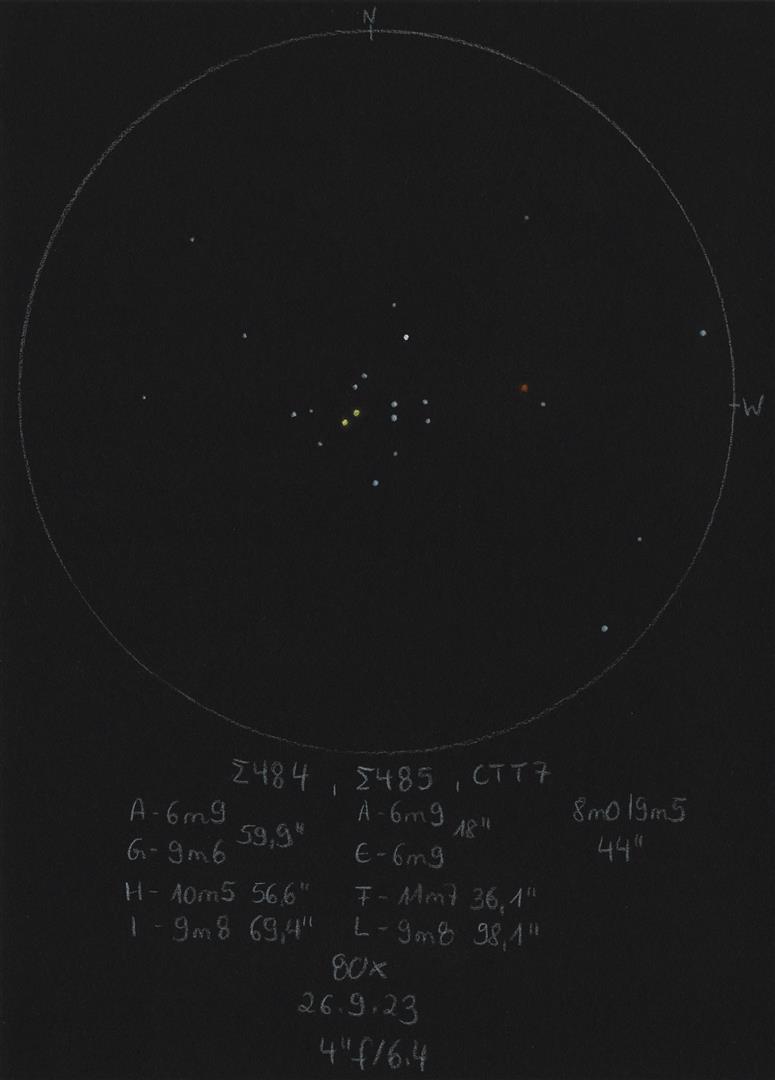
|
|
|
★
|
STTA44 |
|
|
7m.1 |
8m.0 |
58.6" |
321° |
2017 |
Per |
04h17m19.77s / +46°13'03.60" |
Robert Zebahl
Leipzig (Germany) |
16x70 |
2020-11-07: Very nice sight, moderate separation & difference in brightness. Slightly yellow-orange & subtle bluish. |
|
René Merting
Drachhausen (Germany) |
107mm (30x) |
bei 30x ein komfortabel getrenntes Paar, B im Nordwesten ist etwa eine halbe Größenklasse schwächer und dennoch schon richtiggehend schmutzig graubraun gegen die weiß strahlende A-Komponente |
|
|
|
★
|
STF519 & GUI5 |
STF519 |
AB |
7m.8 |
9m.4 |
17.9" |
348° |
2015 |
Per |
04h20m53.71s / +50°22'39.00" |
|
|
|
GUI5 |
AC |
7m.8 |
10m.8 |
108.8" |
193° |
2015 |
|
|
Robert Zebahl
Leipzig (Germany) |
16x70 |
STF519 (AB): 2020-11-07: Beautifully framed by brighter stars! Primary component A appears slightly orange with a much fainter, very close companion. To the south is S445, which forms a prominent triangle of stars of different brightness. The brightest of these three stars also appears orange. |
|
Robert Zebahl
Leipzig (Germany) |
102mm (28x) |
STF519 (AB): 2020-11-08: Well separated with large difference in brightness. Primary component appeared white-yellowish. South very outstanding is the double star S445. Worthwhile due to the beautiful surroundings. |
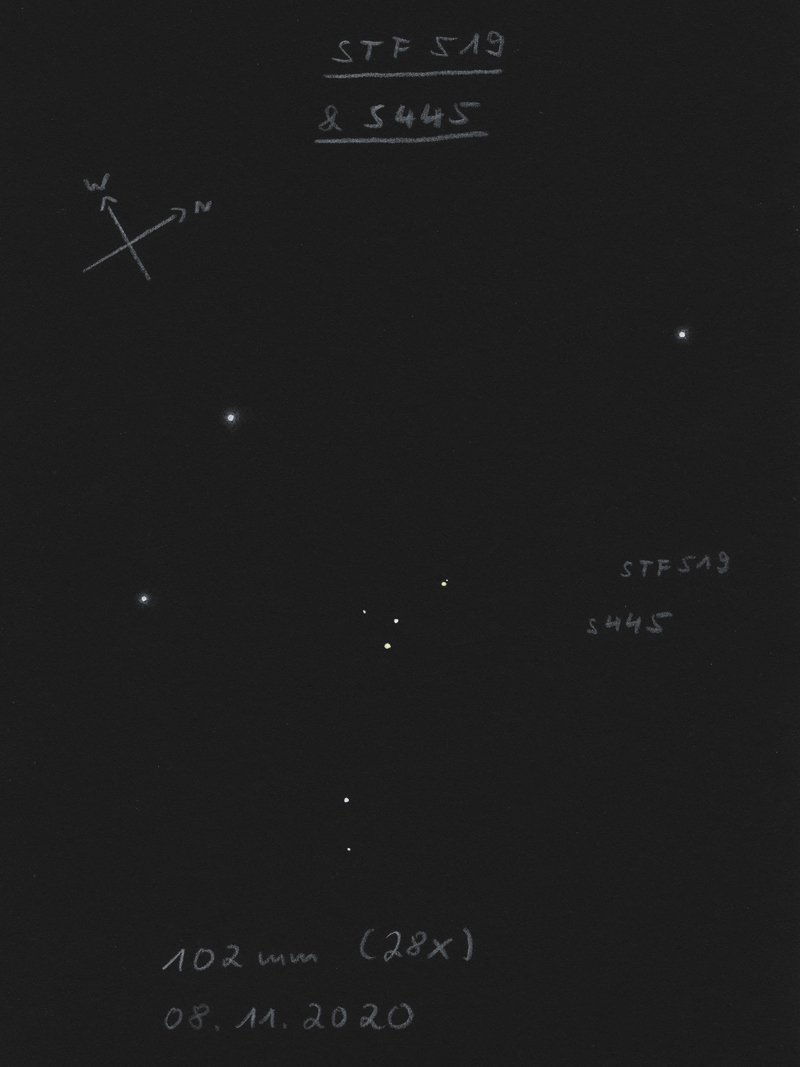
|
|
|
|
S445 & ES2604 |
S445 |
AB |
7m.3 |
8m.2 |
71.0" |
328° |
2017 |
Per |
04h20m57.50s / +50°15'17.40" |
|
|
|
S445 |
AC |
7m.3 |
9m.3 |
150.3" |
263° |
2016 |
|
|
|
|
|
ES2604 |
AD |
7m.3 |
14m.8 |
24.8" |
321° |
2015 |
|
|
|
|
|
ES2604 |
BE |
8m.2 |
11m.2 |
23.3" |
263° |
2015 |
|
|
Sarah Gebauer
Germany |
12x42 |
S445 (AB): auf den ersten Blick: kein Stern - auf den zweiten Blick: ein Stern - auf den dritten Blick: ein gut getrennter Doppelstern mit leichtem Helligkeitsunterschied - die südöstliche, hellere Komponente wirkt dunkelorange, der schwächere Begleiter grau - ein sehr zurückhaltendes Pärchen, das den umliegenden, deutlich helleren Sternen, die Show nicht stehlen möchte, es aber durch seine feine und farbige Erscheinung dennoch vermag |
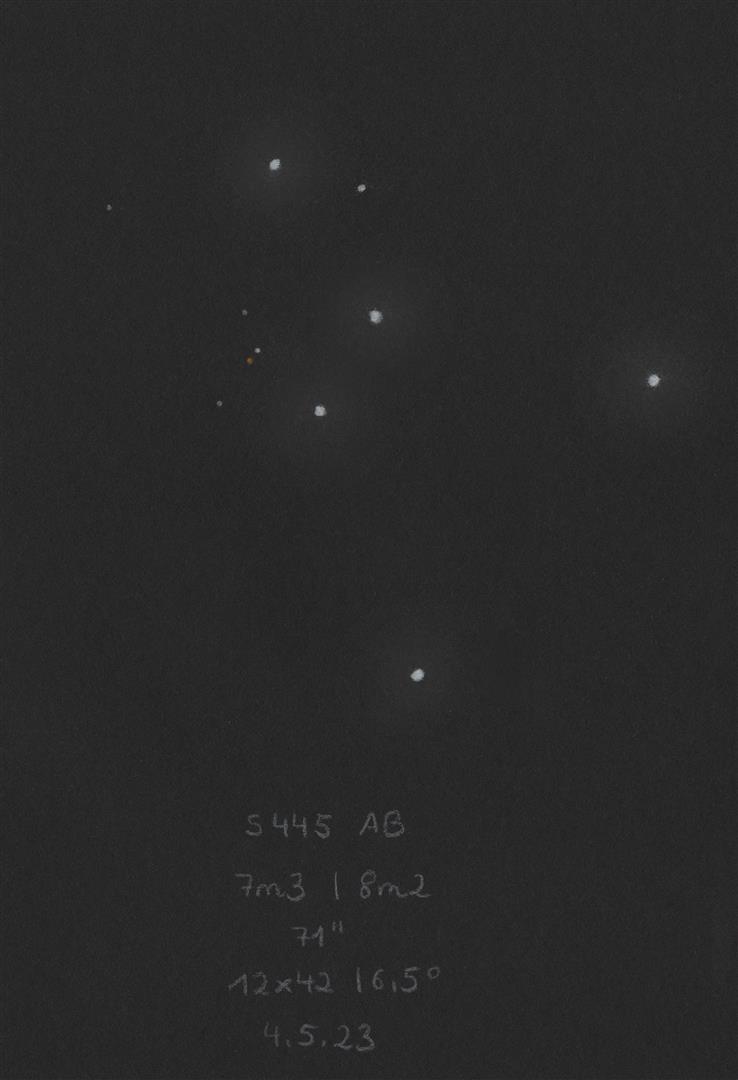
|
Robert Zebahl
Leipzig (Germany) |
16x70 |
2020-11-07: Together with the uneven double star STF519 in one field of view. The three widely separated, differently bright components A, B and C form a prominent triangle, with A appearing orange. Very beautiful! |
|
Robert Zebahl
Leipzig (Germany) |
102mm (28x) |
2020-11-08: Components A, B & C visible as a prominent triangle of different brightness. Component A appears slightly yellowish. Together with the northern located double star STF519 in one field of view. Very nice! |

|
René Merting
Drachhausen (Germany) |
107mm (30x) |
S445 (AB): bei 30x ein weit auseinander stehendes Sternpaar, A im Südosten ist reinweiß, B strahlt braungrau und eine halbe bis eine Größenklasse schwächer |
|
|
|
|
STF541, kappa Tau, kappa 1/2 Tau, 65/67 Tau |
|
A-CD |
4m.2 |
10m.6 |
177.6" |
176° |
2013 |
Tau |
04h25m22.16s / +22°17'37.90" |
|
|
|
|
AB |
4m.2 |
5m.3 |
339.4" |
174° |
2016 |
|
|
|
|
|
|
AE |
4m.2 |
13m.1 |
146.5" |
269° |
2014 |
|
|
|
|
|
|
B-CD |
5m.3 |
9m.5 |
163.3" |
350° |
2014 |
|
|
|
|
|
|
BF |
5m.3 |
13m.7 |
108.3" |
216° |
2014 |
|
|
|
|
|
|
CD |
10m.6 |
10m.0 |
5.5" |
329° |
2020 |
|
|
René Merting
Drachhausen (Germany) |
2x54 |
AB: das Sternpaar ist einfach zu erkennen, ordentlich getrennt - die Sterne sind zwei der helleren in den Wilden 13 |
|
Robert Zebahl
Leipzig (Germany) |
16x70 |
AB: 2023-02-15: Clear difference in brightness at wide separation. A: whitish, B: white-yellowish. |
|
René Merting
Drachhausen (Germany) |
76mm (29x) |
AB: bei 29x ein weit auseinander stehendes relativ helles Pärchen - Komponente B im Süden wirkt eine dreiviertel Größenklasse schwächer - ganz zarter Farbkontrast, weil B warmweißer, fast gelblich strahlt |
|
Mark McCarthy
Fremont (California/USA) |
178mm (203x) |
AB: AB is a bright white pair, super wide, approximately 1 delta mag. Nearly in between is a near equal faint pair of 10th magnitude stars, approximately 6" separated, with a PA slightly off-kilter to the AB pair. The A star is an Aa-Ab pair, OCC 327, equal magnitudes but no separation given, from the Occulting Doubles Catalog -- I wonder if it would show out of round visually with aperture & high magnification |
|
|
|
★★★
|
STFA10, theta Tau, theta 1/2 Tau, 77/78 Tau |
|
AB |
3m.4 |
3m.9 |
336.9" |
347° |
2019 |
Tau |
04h28m39.74s / +15°52'15.20" |
Robert Zebahl
Leipzig (Germany) |
naked eye |
2023-02-15: Easy to separate with similar bright components, although colorless. |
|
René Merting
Drachhausen (Germany) |
naked eye |
wunderbar, der Doppelstern kann ich mit bloßem Auge relativ problemlos getrennt erkennen - Nord-Süd-Ausrichtung |
|
Christopher Hay
Seeheim (Germany) |
naked eye |
5 Nov. 2022. In good transparency I notice while casually looking naked-eye at the Hyades that Theta1/2 Tau seem elongated. Looking now with direct concentration, the pair moves clearly apart. Theta2 is visibly slightly brighter than Theta1, PA estimated at 350°.
Following this up directly by looking at Mizar/Alcor in Uma, that pair, which I can always split naked-eye reasonably well if transparency allows, now seems super-wide compared to Theta1/2 Tau. I estimate the separation of Mizar/Alcor as being two-and-a-half times that of Theta1/2 Tau. |
|
René Merting
Drachhausen (Germany) |
2x54 |
einfache, ordentliche Trennung der beiden Sterne, sie sind heller und stehen enger als das Sternpaar Arn 36 (80/81 Tau) im Süden |
|
Christopher Hay
Seeheim (Germany) |
2x54 |
Well separated, luminous orange and ice blue. Gorgeous with entire Hyades and Pleiades in 25° field of view.
Theta Tau is a physical double at a distance to us of 150 light years. |
|
Christopher Hay
Seeheim (Germany) |
7x45 |
Theta Tauri. Luminous orange and blue. Wide apart but very much feeling to belong together, despite the many stars of the Hyades all around.
A physical pair. The data suggest separation with naked eye is possible, something to try in good health under a steady sky. At all events with naked eye Theta Tauri is at the centre of the southern stroke of the Hyades' distinctive "V" shape. In the binoculars, by ignoring Aldebaran, which is not a cluster member but a foreground star, it suddenly becomes apparent that Theta Tauri is in fact at the centre of the Hyades in our sky and is its lucida. This impression is supported very nicely by 7x and 8.6° FOV. Definitely one of the finest doubles for this class of binocular. |
|
Robert Zebahl
Leipzig (Germany) |
16x70 |
2023-02-15: Bright, widely separated. The slightly fainter, northern component B is strikingly bright orange, while A appears rather white. Very beautiful view. |
|
René Merting
Drachhausen (Germany) |
76mm (29x) |
bei 29x ein wunderschönes Sternpaar, natürlich weit auseinander stehend, aber die nördliche Komponente strahlt in einem schönen Ährengelb, B ist weiß, dadurch ein schöner Farbkontrast |
|
Sarah Gebauer
Germany |
100mm (21x) |
schon oft besucht und bestaunt, doch erst jetzt bewusst als farbigen Doppelstern beobachtet - Theta 1 und 2 strahlen in der Stierspitze schön warmgelb, sind sehr weit getrennt und rahmen die Sternformation an der Westseite sehr schön ein |
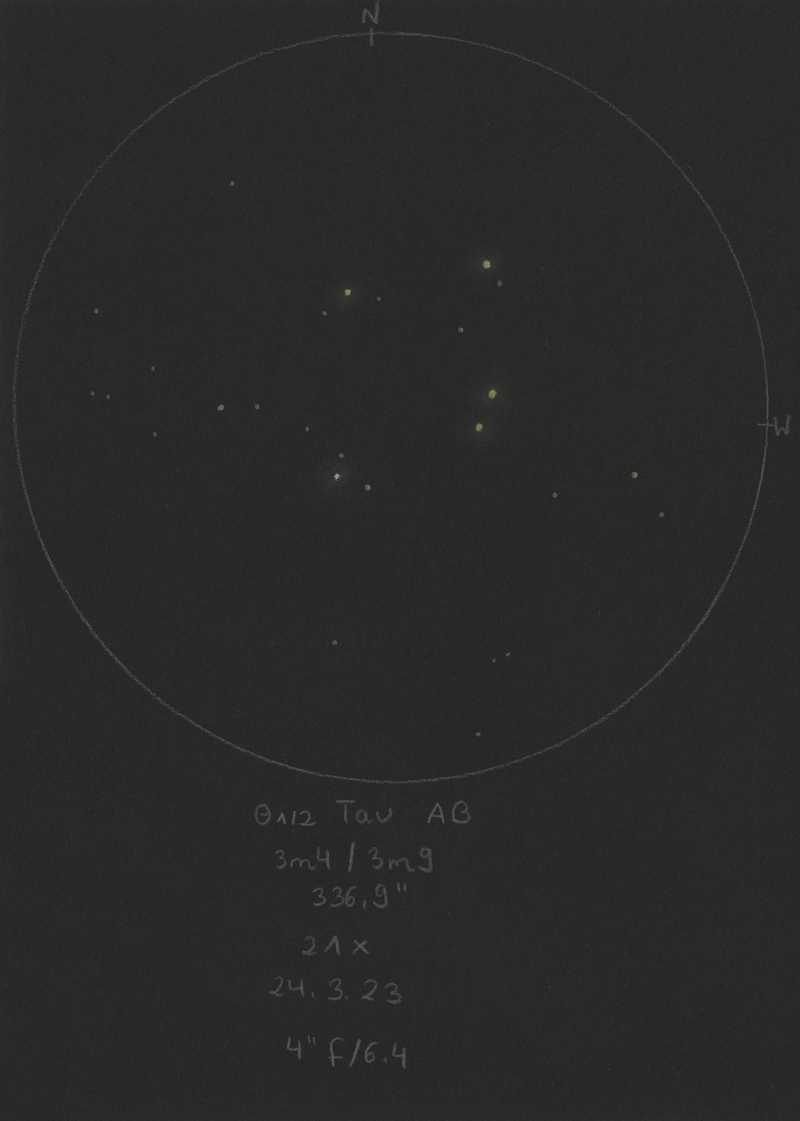
|
|
|
★
|
STT84 |
|
|
7m.2 |
8m.1 |
9.5" |
255° |
2016 |
Tau |
04h31m04.08s / +06°47'28.70" |
Robert Zebahl
Leipzig (Germany) |
16x70 |
2023-02-15: Beautiful pair, separated but very tight with well visible difference in brightness. I had to look closely for the separation. The components look slightly orange together. |
|
René Merting
Drachhausen (Germany) |
76mm (29x) |
bei 29x ein wunderschön, eng stehendes Sternpaar - Komponente B im Südwesten ist eine dreiviertel Größenklasse schwächer |
|
Sarah Gebauer
Germany |
100mm (49x) |
bei 49-fach knapp, aber deutlich getrennt, der erste Farbeindruck ist bei der helleren Komponente gelblich, die schwächere zeigt auch einen warmgelben Farbton - bei 80-fach bestätigt sich der Farbeindruck, die hellere Komponente zeigt ein sehr warmes, dunkles Gelb, der Begleiter wirkt im Grunde ganz ähnlich, nur dumpfer |
|
|
|
|
STFA11, sigma Tau, sigma 1/2 Tau, 91/92 Tau |
|
|
4m.7 |
5m.1 |
444.0" |
194° |
2014 |
Tau |
04h39m16.50s / +15°55'04.70" |
René Merting
Drachhausen (Germany) |
naked eye |
die Sterne erkenne ich, allerdings lediglich als länglicher kreidiger Strich - indirekt leicht besser erkennbar, aber eine Trennung ist mir nicht möglich |
|
René Merting
Drachhausen (Germany) |
2x54 |
Trennung sehr groß, größer als bei dem 2° westlich stehenden ähnlichem Sternpaar STFA10 |
|
Christopher Hay
Seeheim (Germany) |
7x45 |
Very wide and attractive with whole of Hyades in 7.2° field of view, which notably includes the similarly wide Theta Tau (STFA10). Both components blue-white.
Sigma Tau is a physical double at a distance to us of 156 light years. |
|
Robert Zebahl
Leipzig (Germany) |
16x70 |
2023-02-15: Bright and widely separated. The northern component A is slightly brighter and appears white-yellowish, the southern component B appears white. |
|
René Merting
Drachhausen (Germany) |
76mm (29x) |
bei 29x ein extrem weit getrenntes Paar zweier klarer, heller Sterne - die südliche Komponente ist eine halbe Magnitude schwächer |
|
|
|
|
STF612 |
|
AB |
8m.3 |
8m.4 |
16.0" |
200° |
2020 |
Ori |
04h54m16.64s / +07°22'22.90" |
René Merting
Drachhausen (Germany) |
12x42 |
ein sehr schwaches Sternpaar, beide Komponenten kleben noch aneinander, können nicht getrennt gesehen werden |
|
René Merting
Drachhausen (Germany) |
15x56 |
ein ganz enges Sternpaar - relativ schwach und extrem knapp getrennt |
|
Robert Zebahl
Leipzig (Germany) |
16x70 |
2023-02-15: Moderately bright, easy to separate with components still relatively close together and almost equally bright. |
|
René Merting
Drachhausen (Germany) |
18x70 |
ein sehenswerter Fernglas-Doppelstern, zumindest bei 18-facher Vergrößerung - ein schön eng stehendes, knapp getrenntes Pärchen zweier gleich heller Sterne |
|
René Merting
Drachhausen (Germany) |
76mm (29x) |
bei 29x zeigt sich ein schöner Doppelstern zweier gleich heller Sterne - beide sind ordentlich getrennt und stehen doch schön eng - B ist eine halbe Größenklasse schwächer |
|
René Merting
Drachhausen (Germany) |
100mm (20x) |
bei 32x ein schickes Paar gut getrennter eng stehender Sterne - Komponente B im Süden wirkt etwas dunkler/dumpfer - das Sternpaar wirkt wie allein gelassen im Umfeld - zurück auf 20x ist die Trennung zwischen beiden Sternen ganz knapp zu erkennen |
|
|
|
|
STF627 |
|
AB |
6m.6 |
7m.0 |
21.2" |
260° |
2020 |
Ori |
05h00m33.93s / +03°36'56.80" |
René Merting
Drachhausen (Germany) |
12x42 |
ein Doppelstern wie gemacht für 12-fache Vergrößerung - ein fast gleichhelles Sternpaar, Komponente B im Westen ist maximal eine Viertel Größenklasse schwächer - ordentliche Trennung |
|
René Merting
Drachhausen (Germany) |
18x70 |
zwei klar sichtbare bequem getrennte Sterne - Komponente B im SW wirkt leicht gelblicher als A - maximal 1/4 Größenklasse Helligkeitsunterschied - ein schöner nicht zu eng und nicht zu weit getrennter Fernglas-Doppelstern |
|
René Merting
Drachhausen (Germany) |
76mm (29x) |
bei 29x ein schönes, einfaches Paar, ein bisschen mehr als ordentlich getrennt - Komponente B im Westen ist nur knapp schwächer und strahlt ein wenig kaltweißer |
|
René Merting
Drachhausen (Germany) |
100mm (20x) |
bei 32x ein bequem getrenntes Pärchen zweier annähernd gleich heller Sterne - Komponente B im Westen ist vielleicht eine viertel Magnitude schwächer - das Sternpaar fällt auf in der Umgebung, weil es kaum hellere Sterne im Umfeld gibt - zurück auf 20x ist es ein schickes eng stehendes Paar, aber nicht zu eng |
|
Uwe Pilz
Leipzig (Germany) |
105mm (16x) |
erkennbar schon bei Fernglasvergrößerung |
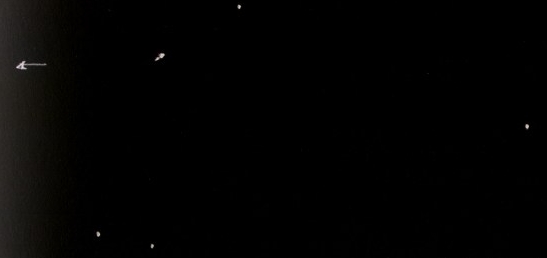
|
Sarah Gebauer
Germany |
254mm (96x) |
ein typisches Augenpaar, nahezu gleich helle Komponenten und steht in einem Dreieck mit zwei schwächeren Sternen |
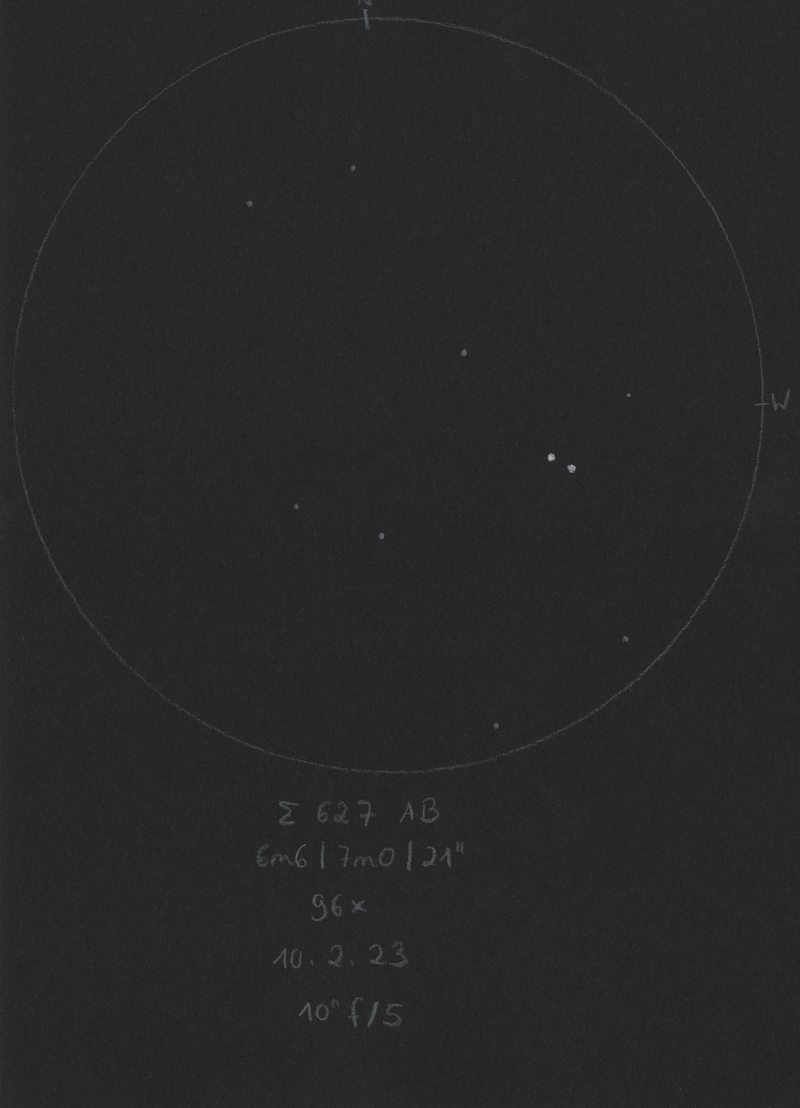
|
|
|
|
STF630 |
|
A-BC |
6m.5 |
7m.7 |
14.4" |
49° |
2020 |
Ori |
05h02m00.03s / +01°36'31.90" |
René Merting
Drachhausen (Germany) |
12x42 |
ich kann BC erkennen, komme bei dem Paar aber über eine 8 nicht hinaus - BC zeigt sich nordöstlich von A |
|
René Merting
Drachhausen (Germany) |
18x70 |
schick, ein auffälliges knapp getrenntes Pärchen - Komponente BC im NO ist keine ganze Größenklasse schwächer (lt. Stelle Doppie aber doch 1.21 mag) |
|
René Merting
Drachhausen (Germany) |
76mm (29x) |
bei 29x offenbart sich eine schön anzusehende Ameise - BC steht im Nordosten von A ein bisschen mehr als knapp getrennt und ist eine halbe Größenklasse schwächer (wiederholt verschätzt bei diesem DS, es sind 1.21 mag lt. Stelle Doppie) |
|
René Merting
Drachhausen (Germany) |
100mm (20x) |
bei 32x ein knapp getrenntes Pärchen - Komponente BC im NO scheint eine knappe Größenklasse schwächer, er wirkt ein wenig bunter, matter - zurück auf 20x wirkt das Pärchen schicker, weil die beiden Komponenten dann noch enger stehen - der Helligkeitsunterschied ist nicht mehr ganz so ausgeprägt |
|
Uwe Pilz
Leipzig (Germany) |
105mm (88x) |
gelb-orange und fahlviolett |
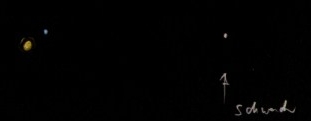
|
Sarah Gebauer
Germany |
254mm (96x) |
ein eher schmales Paar, aber sauber getrennt; steht beinahe wie einem verzerrten Herkules-Trapez |
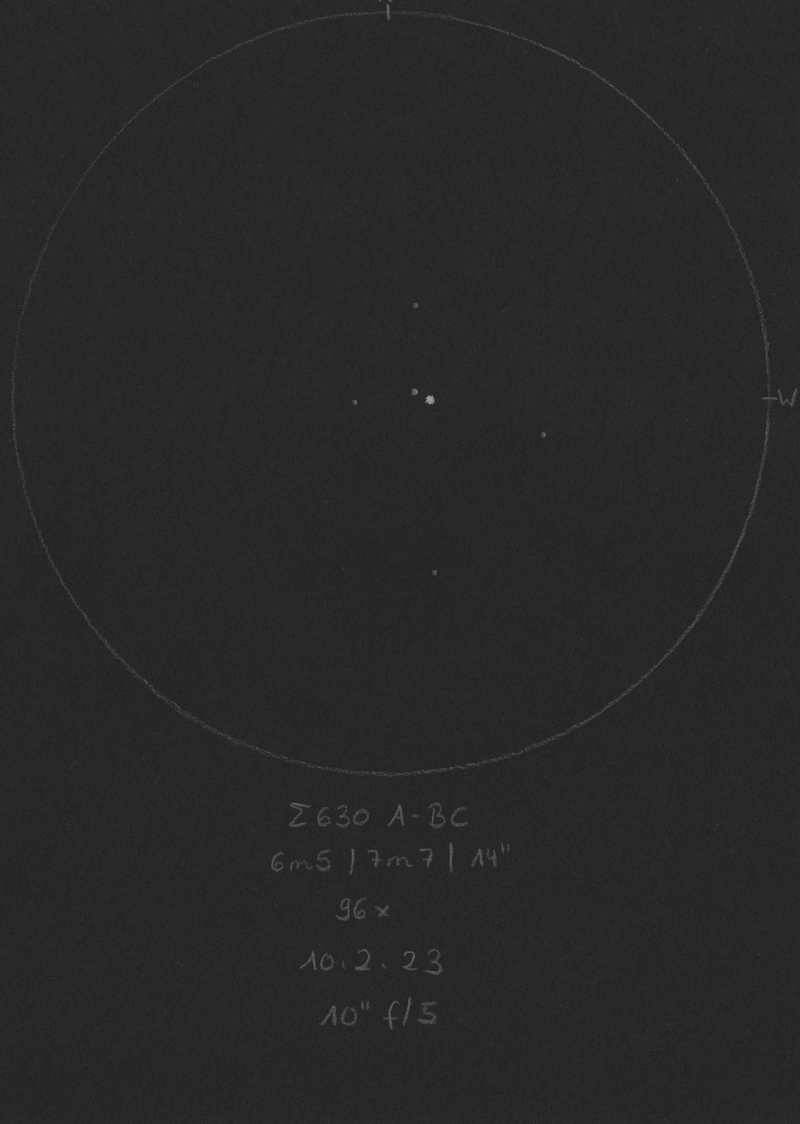
|
|
|
★★
|
STF696, 23 Ori |
|
|
5m.0 |
6m.8 |
32.0" |
29° |
2019 |
Ori |
05h22m50.00s / +03°32'40.00" |
René Merting
Drachhausen (Germany) |
12x42 |
ein schönes Paar - Komponente A strahlt weißblau, Komponente B nördlich ist gut 1.5 Größenklassen schwächer und wirkt grauweiß |
|
Sarah Gebauer
Germany |
12x42 |
ein DS zum Zwei-Mal-Hinschauen! Die B-Komponente ist nordöstlich und sehr viel kleiner und schwächer zu sehen, sehr niedlich! Noch dazu bekommt man ein paar schöne Dreier-Sternbögen mit ins Bild, z.B. mit 21 Ori und dem westlichen Rand von ASCC21 |
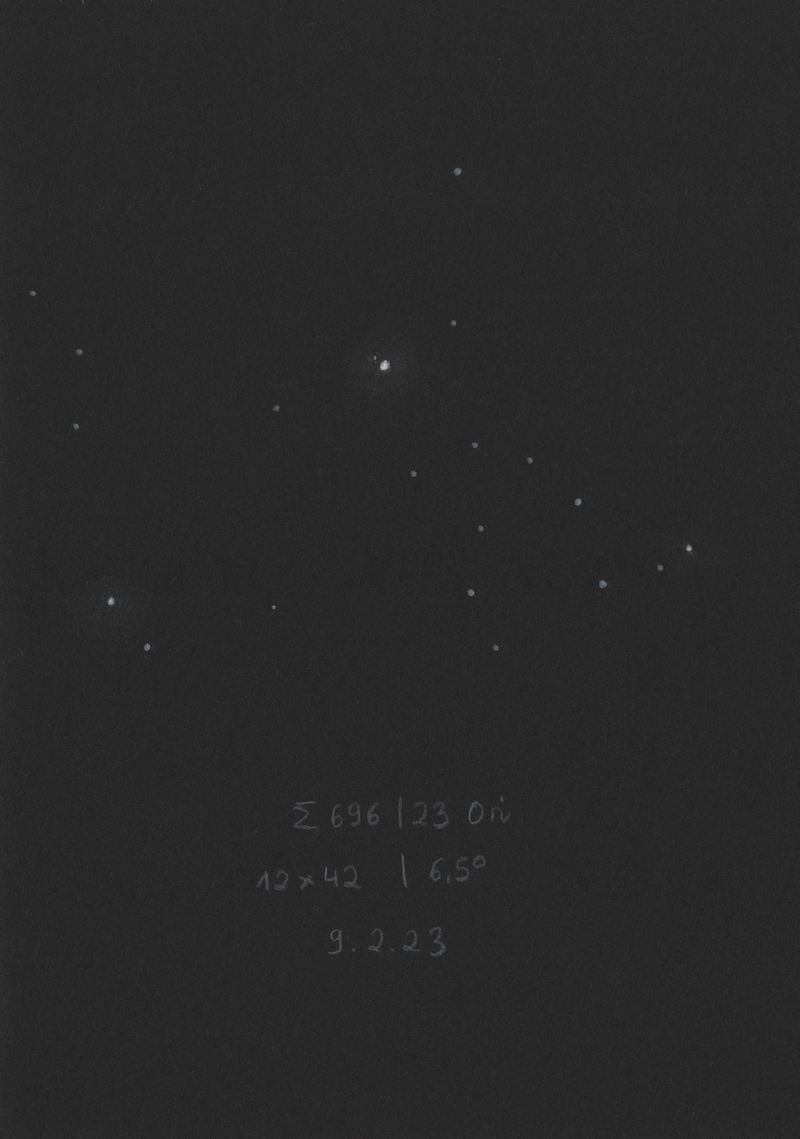
|
Christopher Hay
Seeheim (Germany) |
15x45 |
Widely separated but still a little difficult to hold due to large delta-mag.
A physical double at a distance to us of 1553 light years, which is practically the same as Theta 2 Ori in the great Orion Nebula M42. |
|
René Merting
Drachhausen (Germany) |
18x70 |
ein auffälliges gut getrenntes Paar - Komponente B im Norden ist 1.5 Größenklassen schwächer |
|
Sarah Gebauer
Germany |
254mm (96x) |
wie schon im Fernglas sehr schön und einfach getrennt |
|
|
|
|
STF697 |
|
AB |
7m.3 |
8m.1 |
25.4" |
287° |
2019 |
Ori |
05h23m31.74s / +16°02'25.80" |
René Merting
Drachhausen (Germany) |
18x70 |
ein ordentlich getrenntes Pärchen - Komponente A strahlt weißgelblich, B im NW ist etwas mehr als eine halbe Größenklasse schwächer und wirkt kupfergrau |
|
René Merting
Drachhausen (Germany) |
76mm (18x) |
bei 18x ein schön eng stehendes Sternpaar - B im Westen von A ist halb so hell und wirkt grau - in weitem Abstand im Westen (mind. siebenfach) ist noch ein ganz schwacher Stern zu erkennen (SMR 3 - Komponente D) - Komponente C (10.83 mag - WAL 38), die auch auf dieser Linie liegt, habe ich wohl übersehen |
|
|
|
|
S479 |
|
AB |
8m.3 |
8m.9 |
46.4" |
220° |
2014 |
Ori |
05h24m38.61s / +01°48'38.80" |
|
|
|
|
AC |
8m.3 |
4m.8 |
157.5" |
36° |
2013 |
|
|
Sarah Gebauer
Germany |
12x42 |
AB: leider keine Trennung geschafft, womöglich ist der Himmelshintergrund zu aufgehellt für die schwachen Komponenten |
|
René Merting
Drachhausen (Germany) |
18x70 |
AB: beide Komponenten stehen südwestlich vom hellen 25 Ori wie an einer Kette gezogen - die Trennung der Komponenten dieses Doppelsterns beträgt 1/3 Abstand 25 Ori zu Komponente A |
|
Sarah Gebauer
Germany |
254mm (42x) |
AB: mit mehr Öffnung nun eindeutig getrennt, bildet ein schönes Dreieck mit benachbarten Sternen, erinnert mich an eine Miniaturversion der Taurus-Spitze |
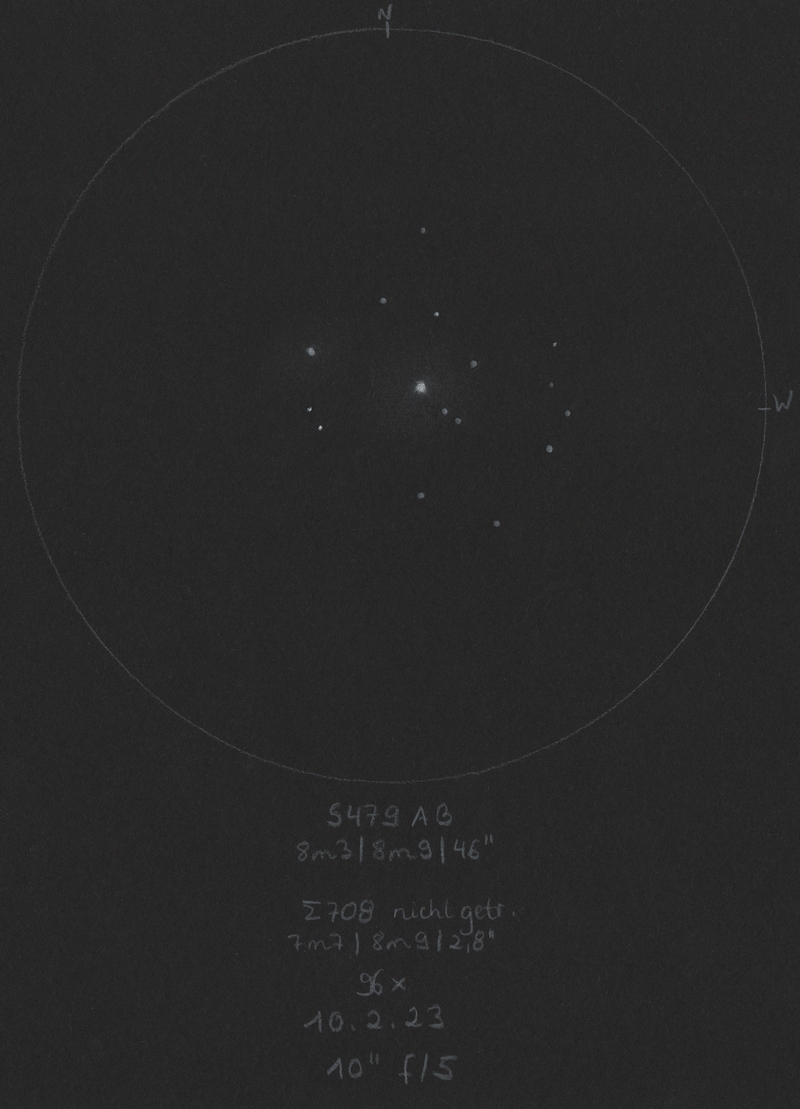
|
|
|
★
|
delta Ori, Mintaka |
BU558 |
AB |
2m.4 |
14m.2 |
33.4" |
229° |
2016 |
Ori |
05h32m00.40s / -00°17'56.70" |
|
|
|
STFA14 |
AC |
2m.4 |
6m.8 |
56.2" |
4° |
2017 |
|
|
René Merting
Drachhausen (Germany) |
10x50 |
AC: Komponente C zeigt sich gut abgesetzt im NW von A - Helligkeitsunterschied enorm, mindestens 3 Größenklassen |
|
René Merting
Drachhausen (Germany) |
12x42 |
AC: Komponente C ist schwach mit ordentlich Abstand nördlich von A zu erkennen - der Stern wirkt farblos gegen die strahlend weiße A-Komponente |
|
René Merting
Drachhausen (Germany) |
18x70 |
AC: total leicht - Komponente C thront gut getrennt nördlich über A (Mintaka) und ist gut 2 bis 3 Größenklassen schwächer (sogar 4.42 mag laut Stelle Doppie) und trotzdem noch ein mittelheller Stern - A ist gleißend weiß, C weißgrau |
|
Christopher Hay
Seeheim (Germany) |
60mm (16x) |
AC: Wide pair, secondary a very mild blue. Too much power, really, less would suffice. Either way very attractive in 4° FOV together with Orion’s belt stars and the Collinder 70 cluster around them. |
|
Christopher Hay
Seeheim (Germany) |
76mm (25x) |
AC: C set off well from A. A pure white, C steel blue. Although in the middle of Orion the pair dominates the 3.1° FOV. |
|
René Merting
Drachhausen (Germany) |
76mm (29x) |
AC: bei 29x ein weit auseinander stehendes Pärchen - C im Norden ist mindestens 2 Größenklassen schwächer und wirkt weißgelblich gegen die strahlend weiße A-Komponente |
|
Sarah Gebauer
Germany |
100mm (49x) |
AC: die Hauptkomponente erscheint mir in reinstem Weiß mit einem leichten Farbstich in einem kalten Farbton, nordwestlich davon, deutlich schwächer, die zweite Komponente auch in einem Weißton |
|
Uwe Pilz
Leipzig (Germany) |
105mm (22x) |
AC: blau und violett |

|
Uwe Pilz
Leipzig (Germany) |
105mm (200x) |
AC: sehr weit in reichem Sternfeld |
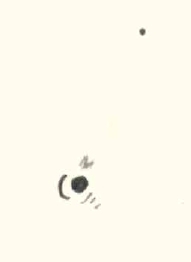
|
Uwe Pilz
Leipzig (Germany) |
105mm (288x) |
AC: reinweiß-violett |
|
|
|
★
|
STF747 & CLL22 & HDS742 |
STF747 |
AB |
4m.7 |
5m.5 |
36.3" |
224° |
2019 |
Ori |
05h35m02.68s / -06°00'07.20" |
|
|
|
CLL22 |
AC |
4m.7 |
8m.9 |
68.2" |
12° |
2000 |
|
|
|
|
|
HDS742 |
Ba-Bb |
5m.6 |
8m.5 |
0.5" |
111° |
2021 |
|
|
Christopher Hay
Seeheim (Germany) |
7x45 |
STF747 (AB): Clearly split, with very distinct magnitude difference between A and B components. Hand tremor prevents detection of colour contrast, if there is one at all. A very pleasing tip to Orion’s Sword.
A true physical pair according to Stelledoppie. Distance to us of 1610 light years could indicate membership of stellar association Orion OB1 and thus physical relationship to Orion nebula complex. |
|
René Merting
Drachhausen (Germany) |
8x30 |
STF747 (AB): zwei helle Sterne knapp getrennt, Komponente B im Südwesten nur knapp schwächer |
|
Christopher Hay
Seeheim (Germany) |
76mm (25x) |
CLL22 (AC): Comellas (CLL) 22 is the C component of STF 747 AB. C is a fine pinprick of light, a little less than twice as far from A as B is. Knowing that this is a physical triple system makes a big difference in perceiving it as such at the eyepiece. |
|
René Merting
Drachhausen (Germany) |
76mm (95x) |
STF747 (AB): bei 95x ein weit getrenntes, helles Pärchen - leichter Farbkontrast erkennbar, B im Südwesten wirkt blauweiß, A dagegen warmweiß, leicht weißgelblich - Helligkeitsunterschied gering, vielleicht eine halbe Magnitude |
|
René Merting
Drachhausen (Germany) |
100mm (20x) |
STF747 (AB): bei 32x zeigt sich B südwestlich von A gut eine halbe Größenklasse schwächer - B wirkt ein wenig kühler, bläulicher - zurück auf 20x, weiterhin leichte Trennung und Sichtbarkeit |
|
Sarah Gebauer
Germany |
100mm (49x) |
STF747 (AB): zusammen mit STF745, 752 und 754 im GF, ein wahres Doppelsterngewimmel! STF747 ist ein sehr leuchtstarkes Pärchen in deutlichem Abstand |
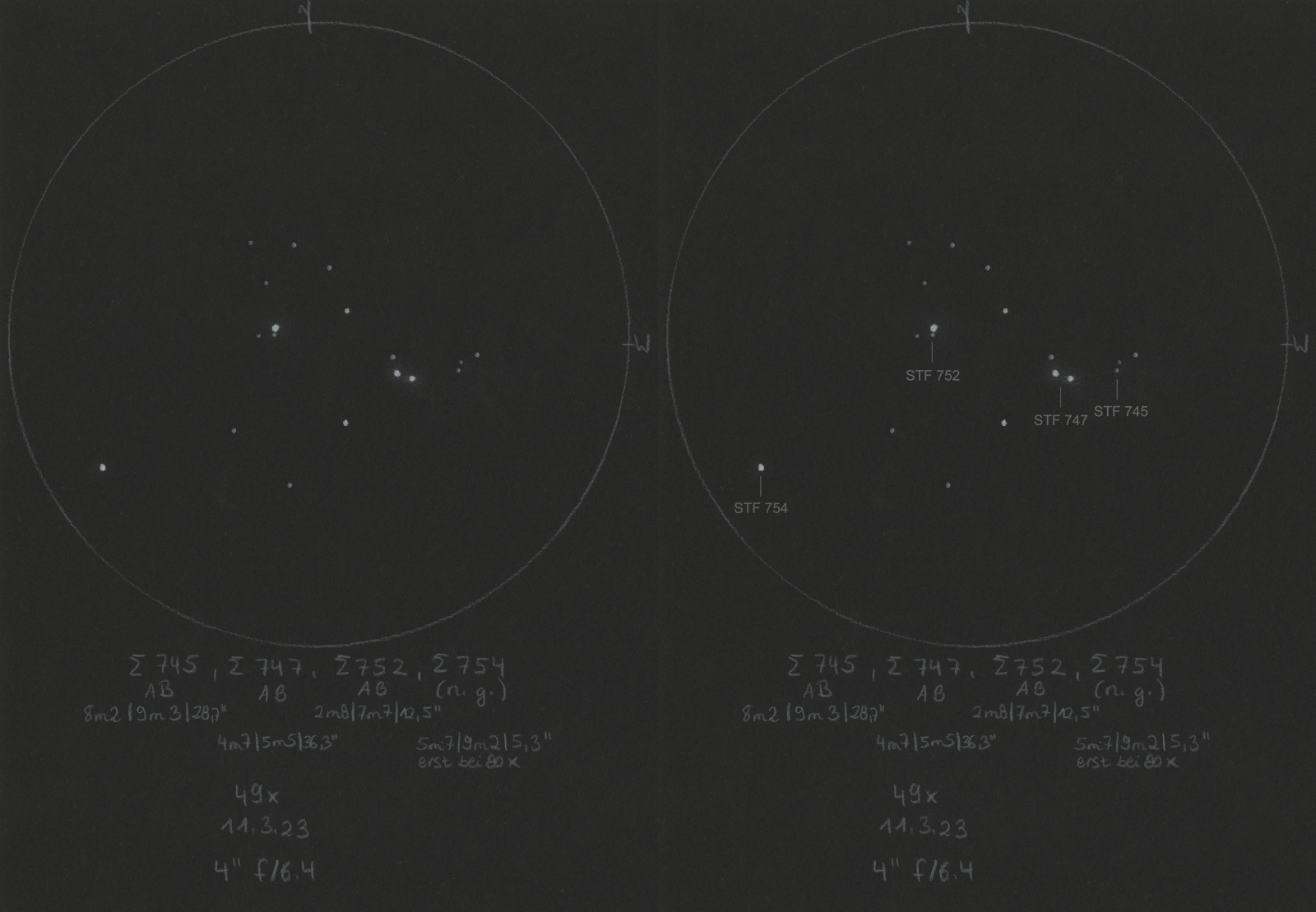
|
|
|
★★
|
STFA16, theta 2 Ori, 43 Ori |
|
AB |
5m.0 |
6m.2 |
52.3" |
93° |
2019 |
Ori |
05h35m22.88s / -05°24'57.70" |
|
|
|
|
AC |
5m.0 |
8m.5 |
128.5" |
98° |
2019 |
|
|
|
|
|
|
BC |
6m.2 |
8m.5 |
76.5" |
102° |
2019 |
|
|
Christopher Hay
Seeheim (Germany) |
7x45 |
AB: On tripod. AB distinctly separate, very double-star-ish. Slightly wider separation than STF 747 AB two degrees to the south. Embedded in glow of M42. Theta 1 Ori (Trapezium) A/C/D appears slightly box-like without resolution.
Theta2 Ori is a physical double at a distance to us of 1546 light years. |
|
|
|
★★★
|
sigma Ori, 48 Ori |
BU1032 |
AB |
4m.1 |
5m.3 |
0.3" |
70° |
2018 |
Ori |
05h38m44.77s / -02°36'00.20" |
|
|
|
STF762 |
AB-C |
3m.8 |
8m.8 |
11.4" |
239° |
2019 |
|
|
|
|
|
STF762 |
AB-D |
3m.8 |
6m.6 |
12.9" |
83° |
2019 |
|
|
|
|
|
STF762 |
AB-E |
3m.8 |
6m.3 |
41.4" |
62° |
2019 |
|
|
|
|
|
STF3135 |
AB-F |
3m.8 |
7m.9 |
208.0" |
324° |
2016 |
|
|
|
|
|
STF762 |
DC |
6m.6 |
8m.8 |
23.8" |
252° |
2019 |
|
|
|
|
|
STF762 |
EC |
6m.3 |
8m.8 |
52.9" |
241° |
2019 |
|
|
|
|
|
STF762 |
ED |
6m.3 |
6m.6 |
29.8" |
232° |
2019 |
|
|
Christopher Hay
Seeheim (Germany) |
10x42 |
Binoculars with internal stabilisation, handheld.
AB-D: No split, nor any elongation of AB towards D seen.
AB-E: E is set off well from AB but harder to split than the numbers would suggest. This is partly due to the major delta-mag, and partly to the circumstance that D effectively reduces the "free" stretch of sky to 29".
STF761 is a nice complement a few minutes of arc to the west and makes the visual impression of possibly belonging to the Sigma Ori complex, but Stelledoppie doesn't confirm this. |
|
René Merting
Drachhausen (Germany) |
12x42 |
AB-E: Komponente E ist nordöstlich abgesetzt von AB zu erkennen
AB-H: die relativ helle Komponente H steht in weitem Abstand im Südosten von AB |
|
Christopher Hay
Seeheim (Germany) |
15x45 |
Binoculars with internal stabilisation, handheld.
AB-D: No split acheived. However, focussing on AB feels uncertain, presumably due to disturbance by D. Also not split with 15x60 on tripod.
AB-E: E is set off well from AB. |
|
Christopher Hay
Seeheim (Germany) |
25x80 |
AB-D: D is set off nicely from AB and appears very slightly on the orange side, particularly in contrast to E. |
|
Christopher Hay
Seeheim (Germany) |
60mm (50x) |
AB-D: wide split, D is reddish. C not seen, perhaps seeing is too poor at time of observation. |
|
René Merting
Drachhausen (Germany) |
100mm (64x) |
AB-C: bei 64x zeigt sich Komponente C ganz schwach südwestlich von AB
AB-D: bei 32x schließt sich an die zartgelbe Komponente AB unmittelbar im Osten dicht stehend D weißorange an - ein schickes Trio zusammen mit E weiter östlich
AB-E: bei 32x zeigt sich in vierfacher Entfernung von AB-D die Komponente E weiter östlich in einer Linie - E ist ähnlich hell wie D |
|
Sarah Gebauer
Germany |
150mm (125x) |
ein sehr schönes Muster des Mehrfachsystems, auch wenn längst nicht alle Komponenten getrennt zu sehen waren, AB-C, AB-D und AB-E getrennt, A und B nicht |
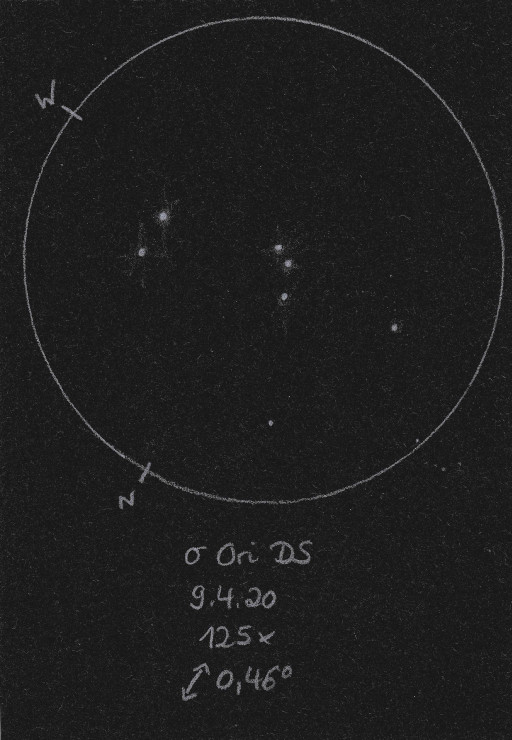
|
Uwe Pilz
Leipzig (Germany) |
320mm (80x) |
AB-C-D schon im Aufsuchokular sichtbar. Sehr lebhafte Farben, einer der schönsten Mehrfachsterne überhaupt. Im selben Feld mit STF761 |
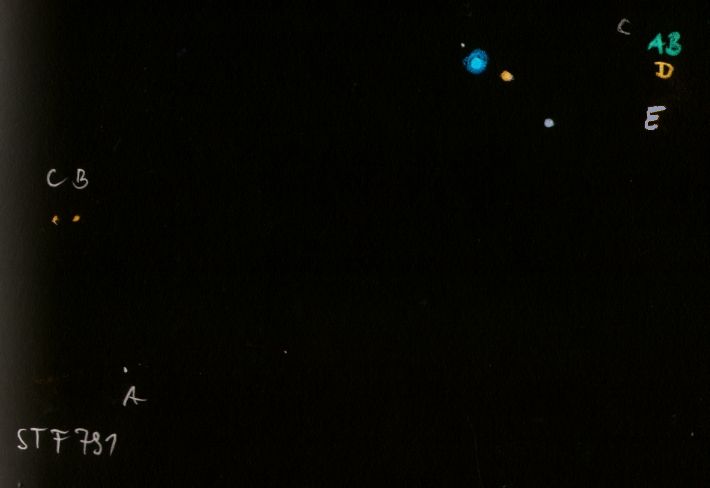
|
|
|
★★
|
STF764 |
|
|
6m.4 |
7m.1 |
25.8" |
15° |
2019 |
Aur |
05h41m20.98s / +29°29'14.70" |
Christopher Hay
Seeheim (Germany) |
7x50 |
On tripod. PA very clear and the pair splits apart in good moments. Keeping Alnath (Beta Tau) out of the FOV helps. Chi Aur is in a nice little arc of stars on north-western edge of FOV, enhances the aesthetics of the field of view. |
|
Robert Zebahl
Leipzig (Germany) |
8x44 |
2020-11-25: Cleanly split, rather close together. In beautiful star field together with beta Tauri. |
|
Christopher Hay
Seeheim (Germany) |
15x60 |
On tripod. Distinctly split, attractive sight in light orange and light blue, a visually strong pair. 26 Aur (STF753, not quite split) in same 3.3° field of view. |
|
Christopher Hay
Seeheim (Germany) |
25x80 |
Well split. Brighter star honey-yellow, companion ice-blue. Very similar brightnesses. A visually strong, compact pair at this power in 3.2° field of view. |
|
Robert Zebahl
Leipzig (Germany) |
55mm (25x) |
Easy to split with large distance and noticeable difference in brightness. |
|
Robert Zebahl
Leipzig (Germany) |
70mm (22x) |
Very easy and bright, pretty wide apart with a small difference in brightness; whitish and slightly yellowish. |
|
Christopher Hay
Seeheim (Germany) |
76mm (40x) |
Well separated, even brightness of components. A appears immediately orangish, B bluish, but after a minute of observation this impression fades to colourlessness. |
|
Uwe Pilz
Leipzig (Germany) |
105mm (88x) |
blauweiß und orange, kleiner aber gut sichtbarer Helligkeitsunterschied. Schon bei 21x sichtbar, sehr lohnend. |
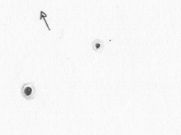
|
Christopher Hay
Seeheim (Germany) |
180mm (113x) |
Wide apart but a strong pair with slight delta-mag. Mild orange-to-blue colour contrast of A to B that remains stable in contrast to 76mm observation in same night. |
|
Mark McCarthy
Fremont (California/USA) |
317mm (277x) |
two bright whites widely separated |
|
|
|
★
|
gamma Lep, 13 Lep |
H6 40 |
AB |
3m.6 |
6m.3 |
95.5" |
349° |
2019 |
Lep |
05h44m27.79s / -22°26'54.20" |
|
|
|
H5 50 |
BC |
6m.3 |
11m.4 |
112.1" |
8° |
1999 |
|
|
Christopher Hay
Seeheim (Germany) |
6x30 |
On tripod. Clearly separated. B appears bluish. |
|
Christopher Hay
Seeheim (Germany) |
7x45 |
On tripod. Clearly separated. Large delta-mag plus scintillation of primary prevent colour perception of B. The 6x30 binoculars show the colour better in the same night. Interesting to note that the 7x45 is at a disadvantage in this regard while the 10x56, however, is superior. |
|
Christopher Hay
Seeheim (Germany) |
10x56 |
On tripod. Widely separated. Rather charming. B distinctly blue. Scintillation plus atmospheric dispersion of A (15° above horizon) prevent determination of any particular hue of A.
A physical double at a distance to us of only 29 light years, which means Gamma Leporis is in our immediate galactic neighbourhood. |
|
René Merting
Drachhausen (Germany) |
12x42 |
ein Augenöffner und sehr imposanter, heller Doppelstern - B steht weit abgesetzt im Norden von A und ist gut 1.5 Magnituden schwächer (2.64 mag laut Stelle Doppie) - B wirkt bräunlich weiß gegen die strahlend weißgelbe Komponente A |
|
René Merting
Drachhausen (Germany) |
100mm (32x) |
bei 32x wunderschön - Komponente A strahlt gleißend gelb, Komponente B extrem weit im NNW ist gut 2 Größenklassen schwächer - viele schwächere Sterne im unmittelbaren Umfeld, sie gehören aber nicht mit zum System |
|
|
|
|
BU1189 |
|
AB |
9m.3 |
10m.3 |
0.2" |
338° |
1977 |
Ori |
05h57m27.59s / +00°23'58.50" |
|
|
|
|
AB-C |
8m.0 |
8m.3 |
56.1" |
194° |
2015 |
|
|
René Merting
Drachhausen (Germany) |
18x70 |
AB-C: auffällig, zwei mittelhelle Sterne, die weit auseinander stehen - Komponente B im Süden ist knapp eine halbe Größenklasse schwächer |
|
|
|
★★★
|
59 Ori |
H5 100 |
AB |
5m.9 |
10m.4 |
36.7" |
206° |
2015 |
Ori |
05h58m24.44s / +01°50'13.60" |
|
|
|
ARN37 |
AC |
5m.9 |
6m.9 |
177.8" |
293° |
2015 |
|
|
Christopher Hay
Seeheim (Germany) |
7x45 |
AC: Handheld: AC wide apart and immediately striking as double star.
On tripod: Wide apart but still very double-star-ish. C appears light blue.
Arnold 37 is a physical double at a distance to us of 364 light years. |
|
Christopher Hay
Seeheim (Germany) |
15x45 |
AC: AC wide apart but holding together visually as strong pair in 4.5° FOV. C distinctly blue, A appears slightly orange in contrast. |
|
Christopher Hay
Seeheim (Germany) |
42mm (12x) |
AC: AC makes very much a double-star impression despite the major separation. Western component slightly bluish, eastern component faintly orange. |
|
|
|
|
STF844 & ARN64 |
STF844 |
AB |
8m.5 |
9m.3 |
23.4" |
9° |
2017 |
Ori |
06h08m18.38s / +13°59'50.30" |
|
|
|
ARN64 |
AC |
8m.5 |
10m.4 |
31.9" |
171° |
2017 |
|
|
René Merting
Drachhausen (Germany) |
18x70 |
AB: Komponente B steht unmittelbar nordwestlich von A und ist deutlich schwächer
AC: Komponente C ist schwächer als B und steht im SO von A, alle drei Sterne bilden eine Linie |
|
|
|
★
|
STF848 |
|
AB |
7m.3 |
8m.2 |
2.6" |
110° |
2019 |
Ori |
06h08m30.36s / +13°58'15.80" |
|
|
|
|
AC |
7m.3 |
11m.7 |
18.1" |
295° |
2019 |
|
|
|
|
|
|
AD |
7m.3 |
8m.3 |
28.3" |
122° |
2019 |
|
|
|
|
|
|
AE |
7m.3 |
9m.0 |
42.6" |
187° |
2019 |
|
|
|
|
|
|
DH |
8m.3 |
10m.0 |
54.0" |
110° |
2019 |
|
|
René Merting
Drachhausen (Germany) |
18x70 |
AD: Komponente D ist mit etwas Abstand östlich von Komponente A zu erkennen
AE: Komponente E ist schwächer als D und steht südöstlich von A in doppeltem Abstand wie AD
DH: Komponente H ist noch schwächer als D und steht östlich in dreifachem Abstand wie AD |
|
Robert Zebahl
Leipzig (Germany) |
70mm (100x) |
AB: Well split with obvious difference in brightness. |
|
René Merting
Drachhausen (Germany) |
76mm (95x) |
AB: bei 95x wird B südwestlich von A sichtbar, knapp getrennt - B ist eine halbe Größenklasse schwächer
AC: bei 95x zeigt C sich westlich in etwas Abstand, C ist sehr schwach
AD: bei 29x ist D einfach mit etwas Abstand südöstlich von A erkennbar, der Stern ist etwa halb so hell
AE: bei 29x ist E südlich von A sichtbar, weiter weg als D und auch nur halb so hell
DH: bei 29x ist H noch weiter südöstlich in einer Linie mit AD erkennbar |
|
Christopher Hay
Seeheim (Germany) |
125mm (100x) |
AB: When idly viewing NGC 2169, the “37 Cluster” or “IC37”, I noticed that the brightest star in the 37, namely the one at the NW corner of the 3, is a nicely split double with a thin slice of darkness between the components. PA matches the top bar of the figure-3 well. Stelledoppie lists components of STF848 from A to K, but notes that all are either not physical or uncertain. To my eye only the A-B pair appears double-like. |
|
Mark McCarthy
Fremont (California/USA) |
203mm (205x) |
AB: The "37" cluster. This pair is the star at the tip of the upper part of the three where it turns down to the center. Fine white pair, close but nicely split, two delta mag, busy field |
|
Mark McCarthy
Fremont (California/USA) |
317mm (170x) |
AB: Close bluish pair near the center of the open cluster NGC 2169 |
|
|
|
|
S513 |
|
AB |
7m.3 |
8m.9 |
59.7" |
258° |
2016 |
Gem |
06h21m14.48s / +21°07'56.70" |
|
|
|
|
AC |
7m.3 |
12m.0 |
47.4" |
250° |
2016 |
|
|
|
|
|
|
AD |
7m.3 |
7m.6 |
264.9" |
24° |
2015 |
|
|
|
|
|
|
AE |
7m.3 |
11m.3 |
83.8" |
285° |
2016 |
|
|
|
|
|
|
BE |
8m.9 |
11m.3 |
40.7" |
327° |
2015 |
|
|
|
|
|
|
BT |
8m.9 |
12m.2 |
37.8" |
295° |
2014 |
|
|
René Merting
Drachhausen (Germany) |
18x70 |
AB: weit getrenntes Pärchen - Komponente B im Westen ist gut 1.5 Größenklassen schwächer und wirkt dadurch bräunlich ggü. der weiß schimmernden Komponente A |
|
René Merting
Drachhausen (Germany) |
100mm (20x) |
AB: bei 32x popeleinfach, weit getrennt - Komponente B im Westen ist gut 1.5 Magnituden schwächer - zurück auf 20x nach wie vor sehr einfach, ein unauffälliger Doppelstern |
|
|
|
★
|
SHJ70, 15 Gem |
|
AB |
6m.7 |
8m.2 |
24.7" |
202° |
2019 |
Gem |
06h27m46.58s / +20°47'22.60" |
|
|
|
|
AC |
6m.7 |
12m.7 |
85.6" |
35° |
2015 |
|
|
Robert Zebahl
Leipzig (Germany) |
16x70 |
AB: 2021-02-22: Clearly split with noticeable difference in brightness. Pale orange with much fainter companion. Together with Nu Gem & 16 Gem in a nice curved star chain. |
|
René Merting
Drachhausen (Germany) |
18x70 |
AB: ein schönes enges Sternpaar, Komponente B ist SW ist ordentlich getrennt von A zu erkennen - etwas über eine Größenklasse Helligkeitsunterschied, dadurch leichter Farbkontrast |
|
René Merting
Drachhausen (Germany) |
76mm (57x) |
AB: bei 29x ist ein gut getrenntes Sternpaar zu erkennen, bei dem B gut 1.5 Magnituden schwächer ist - schöner Farbkontrast, A wirkt gelbweiß, B blauweiß - bei 57x verstärkt sich der Farbkontrast, hellgelb und silbergrau |
|
Sarah Gebauer
Germany |
100mm (49x) |
AB: sehr leicht zu finden, deutlich getrennt, die nördliche, helle Komponente zeigt einen sehr schönen, warmen Farbton in Richtung kupferorange, B dagegen südwestlich davon erscheint beinahe grau |
|
Uwe Pilz
Leipzig (Germany) |
105mm (88x) |
AB: Auch bei 21x trennbar |

|
Mark McCarthy
Fremont (California/USA) |
317mm (553x) |
AB: Very pretty orange A, with a brown B, ~1.5 delta mag. |
|
|
|
★
|
STTA77, nu Gem, 18 Gem |
|
AB |
4m.1 |
8m.0 |
112.8" |
330° |
2017 |
Gem |
06h28m57.79s / +20°12'43.80" |
Christopher Hay
Seeheim (Germany) |
15x45 |
Binoculars with internal stabilisation, handheld. AB are wide apart. Large brightness difference. A pure white, B possibly slightly blue.
A physical double at a distance to us of 545 light years. |
|
Axel Tute
Küssaberg (Germany) |
200mm (77x) |
13.03.2007: Very easy in the C8 with the 26mm Plössl. A is greenish, B is blue-greenish. The PA was estimated at 290°. |
|
|
|
★★
|
STF924, 20 Gem |
|
AB |
6m.3 |
6m.9 |
19.9" |
211° |
2019 |
Gem |
06h32m18.52s / +17°47'03.40" |
|
|
|
|
BC |
6m.9 |
13m.0 |
47.8" |
144° |
2014 |
|
|
Robert Zebahl
Leipzig (Germany) |
16x70 |
AB: 2021-02-22: Easy to separate with small difference in brightness. Conspicuous double star. White-yellowish & white-bluish. |
|
René Merting
Drachhausen (Germany) |
18x70 |
AB: das dicht stehende Paar fällt sofort ins Auge - Komponente A im Norden ist vielleicht eine halbe Magnitude heller als Komponente B, die leicht gräulich strahlt |
|
Robert Zebahl
Leipzig (Germany) |
70mm (22x) |
AB: At 22x bright, immediately conspicuous, although in a relatively star-rich surrounding. Moderate but beautiful color contrast: bright orange, subtle blue. Also at 44x very beautiful sight. |
|
René Merting
Drachhausen (Germany) |
76mm (29x) |
AB: bei 29x ein Paar mit auffälligem Farbkontrast - Komponente B steht ordentlich abgesetzt südlich von A und wirkt silbrig bis blaugrau gegen die gelbweiße A-Komponente im Norden |
|
Sarah Gebauer
Germany |
100mm (49x) |
AB: die beiden Sternen im Norden und Südwesten sind fast gleich hell, deutlich getrennt, die nördliche Komponente empfinde ich leicht gelb, die südwestliche macht eher einen weißen Eindruck |
|
Robert Zebahl
Leipzig (Germany) |
152mm (69x) |
AB: Easy, bright, moderately uneven. Nice contrast in color: slight orange, white-bluish. |
|
Axel Tute
Küssaberg (Germany) |
200mm (77x) |
AB: 14.03.2006; Single pair. No colours observed. Estimated PA 190°. |
|
|
|
|
S524 |
|
AB |
7m.2 |
7m.4 |
53.0" |
244° |
2017 |
Gem |
06h34m07.10s / +22°07'27.20" |
René Merting
Drachhausen (Germany) |
18x70 |
AB: popeleinfach mit dem FG - ein mehr als gut getrenntes Pärchen zweier gleich heller Sterne - die östliche Komponente wirkt ein klein wenig heller - A warmweiß, B blauweiß |
|
René Merting
Drachhausen (Germany) |
100mm (20x) |
AB: bei 32x zeigen sich zwei annähernd gleichhelle Sterne weit getrennt voneinander - Komponente B im SW wirkt kühler als A
AC: bei 32x ist südöstlich von A in doppeltem Abstand wie AB eine weitere Komponente erkennbar - C ist mindestens 2 Größenklassen schwächer als B - alle drei Sterne bilden ein schönes rechtwinkliges Dreieck, wobei die Ecke von A den rechten Winkel bildet - zurück auf 20x ist C auch noch knapp sichtbar |
|
Uwe Pilz
Leipzig (Germany) |
105mm (21x) |
selbst bei 21x einfach zu erkennen |

|
Robert Zebahl
Leipzig (Germany) |
152mm (30x) |
2022-02-27: Pretty bright, wide double star with small difference in brightness. Both components appear white. |
|
|
|
★
|
SHJ73, nu 1 CMa |
|
|
5m.8 |
7m.4 |
17.4" |
264° |
2019 |
CMa |
06h36m22.85s / -18°39'35.60" |
Christopher Hay
Seeheim (Germany) |
10x56 |
On tripod. Finely split. Attractive 6.3° field of view together with Nu2 and Nu3.
A physical double at a distance to us of 351 light years. |
|
Uwe Pilz
Leipzig (Germany) |
105mm (88x) |
|
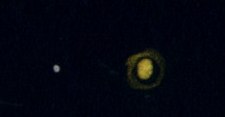
|
|
|
★
|
S529 |
|
AB |
6m.9 |
9m.3 |
52.7" |
129° |
2019 |
Gem |
06h37m33.90s / +12°10'50.00" |
|
|
|
|
AC |
6m.9 |
8m.1 |
143.5" |
165° |
2012 |
|
|
René Merting
Drachhausen (Germany) |
18x70 |
AB: ein weit getrenntes Sternpaar - Komponente B im SO ist kupferbraun, die gut 2 bis 2.5 Größenklassen hellere Komponente A strahlt weiß |
|
Sarah Gebauer
Germany |
254mm (96x) |
der nördlichste der drei Sterne strahlt besonders hell, südwestlich darunter befindet sich ein besonders schwacher Begleiter und direkt südlich darunter mit gut doppeltem Abstand strahlt nochmal ein etwas hellerer Stern |
|
|
|
★
|
H5 108 |
|
A-BC |
5m.8 |
7m.7 |
42.7" |
66° |
2015 |
CMa |
06h50m23.34s / -31°42'21.80" |
Christopher Hay
Seeheim (Germany) |
10x56 |
On tripod. A-BC wide apart. Only 3° above my horizon shortly after meridian passage. A pulsates mysteriously in the flat air, while Kappa CMa 1° to the south, at the southern fringe of the constellation, pulsates equally mysteriously in a slightly shifted tact.
H5 108 is a physical double at a distance to us of 650 light years. |
|
|
|
|
HJ740 |
|
AB |
8m.2 |
9m.1 |
21.2" |
9° |
2015 |
Mon |
06h51m46.17s / +00°27'35.90" |
|
|
|
|
BC |
9m.1 |
11m.8 |
9.1" |
286° |
2015 |
|
|
René Merting
Drachhausen (Germany) |
18x70 |
AB: Komponente B ist nördlich von A knapp getrennt erkennbar - Helligkeitsunterschied vielleicht eine Größenklasse |
|
René Merting
Drachhausen (Germany) |
100mm (32x) |
AB: bei 32x ein ordentlich getrenntes Sternpaar - Komponente B wirkt halb so hell wie A |
|
Sarah Gebauer
Germany |
254mm (96x) |
AB: inmitten des wunderschönen Sternhaufens NGC 2301, die nördliche Komponente erscheint sehr golden, die südliche leicht bläulich |
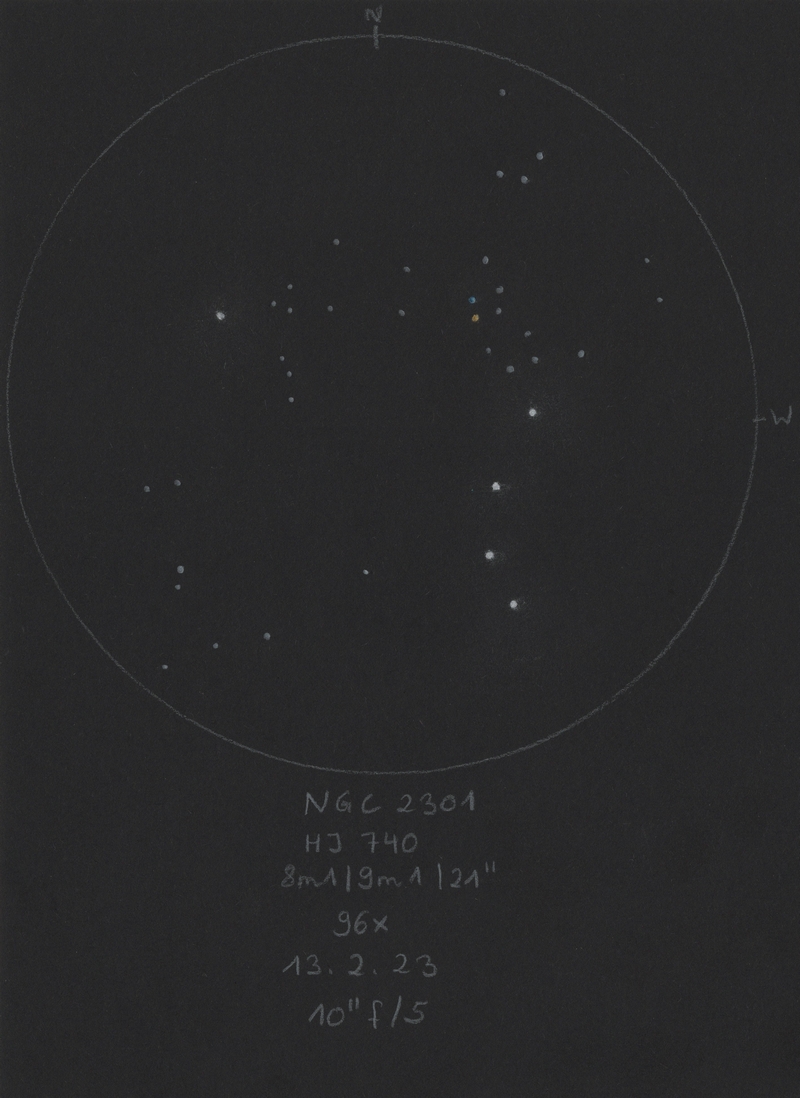
|
|
|
★★
|
STF985 |
|
|
7m.8 |
8m.4 |
32.6" |
323° |
2017 |
Mon |
06h53m56.06s / -04°23'32.80" |
René Merting
Drachhausen (Germany) |
18x70 |
leicht (bequem getrennt) und schön mit Farbkontrast - Komponente A im Südwesten ist leicht gelblich, B wirkt dagegen grau - ein paar schwächere Sterne im Umfeld sorgen dafür, dass der Doppelstern noch etwas mehr hervor gehoben erscheint |
|
René Merting
Drachhausen (Germany) |
100mm (20x) |
bei 32x ein weite Trennung - ein schöner Farbkontrast, Komponente A südöstlich ist weißgelb, B im NW dagegen ist zartorange - zurück auf 20x ordentliche Trennung |
|
Sarah Gebauer
Germany |
100mm (21x) |
schon in Aufsuchvergrößerung getrennt und direkt mit warmrotem Farbeindruck zu sehen - die südöstliche Komponente ist einen Hauch kupferfarbener - bei 49-fach ist die Trennung schon sehr weit und der Farbeindruck schwächer, obwohl nach wie vor warm ins Rotorange gehende - zwei roségoldene Steckerchen, sehr schön |
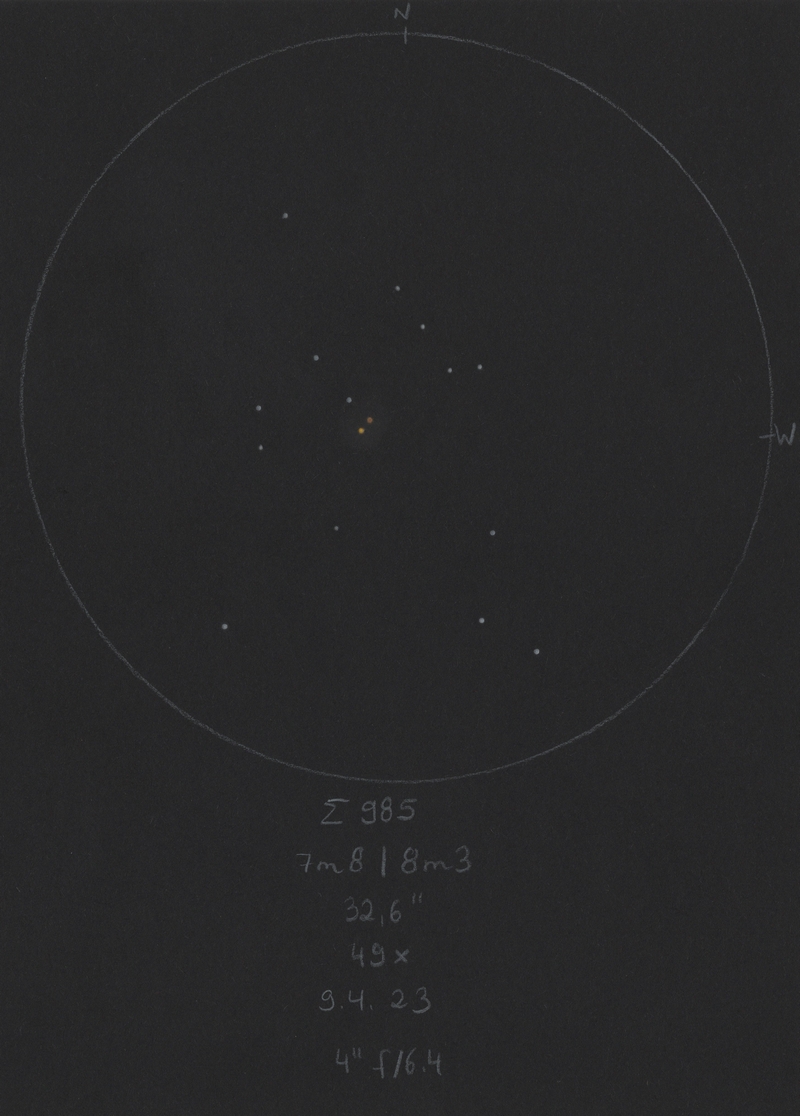
|
|
|
|
H5 65, 17 CMa |
|
AB |
5m.8 |
8m.7 |
42.9" |
147° |
2015 |
CMa |
06h55m02.74s / -20°24'17.50" |
|
|
|
|
AC |
5m.8 |
9m.2 |
48.5" |
187° |
2015 |
|
|
|
|
|
|
AD |
5m.8 |
9m.7 |
128.8" |
187° |
2015 |
|
|
|
|
|
|
BC |
8m.7 |
9m.2 |
31.3" |
247° |
2015 |
|
|
|
|
|
|
CD |
9m.2 |
9m.7 |
80.4" |
187° |
2015 |
|
|
René Merting
Drachhausen (Germany) |
15x56 |
AB & AC: ich kann südlich von A zwei schwache Begleiter erkennen, einer im Südosten (B) und einer direkt im Süden (C) - Komponente B ist leicht heller als C und steht minimal näher |
|
René Merting
Drachhausen (Germany) |
18x70 |
AB: ein mehr als ordentlich getrenntes Pärchen - Komponente B im SO ist gut 2.5 Größenklassen schwächer, aber noch gut erkennbar - schöner Farbkontrast |
|
René Merting
Drachhausen (Germany) |
100mm (107x) |
AB: bei 32x getrenntes Paar, Komponente B im Süden deutlich schwächer
AC: bei 107x wird westlich von Komponente B ein noch schwächerer Stern sichtbar, Komponente C - dieser Stern steht minimal weiter weg von A als B |
|
Uwe Pilz
Leipzig (Germany) |
105mm (144x) |
|
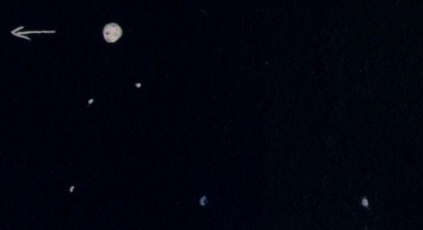
|
|
|
★★
|
STTA80 |
|
AB |
7m.2 |
7m.4 |
124.1" |
53° |
2015 |
Gem |
06h58m06.59s / +14°13'43.40" |
|
|
|
|
AC |
7m.2 |
8m.4 |
81.2" |
112° |
2015 |
|
|
Christopher Hay
Seeheim (Germany) |
7x45 |
Handheld. AB are a well separated, matching pair. Immediately striking in field. |
|
Christopher Hay
Seeheim (Germany) |
15x45 |
Binoculars with internal stabilisation, handheld. AB are a widely separated pair, and joined by a third, weaker, point of light, which is C, well separated. A charming little triangle.
Involved in (or making up?) Monti 4 asterism. |
|
Robert Zebahl
Leipzig (Germany) |
70mm (22x) |
All 3 components form a striking triangle and are slightly different in color. A (western component): white-bluish; B (northern component): white-yellowish; C (southern component): orange, partly slightly reddish. |
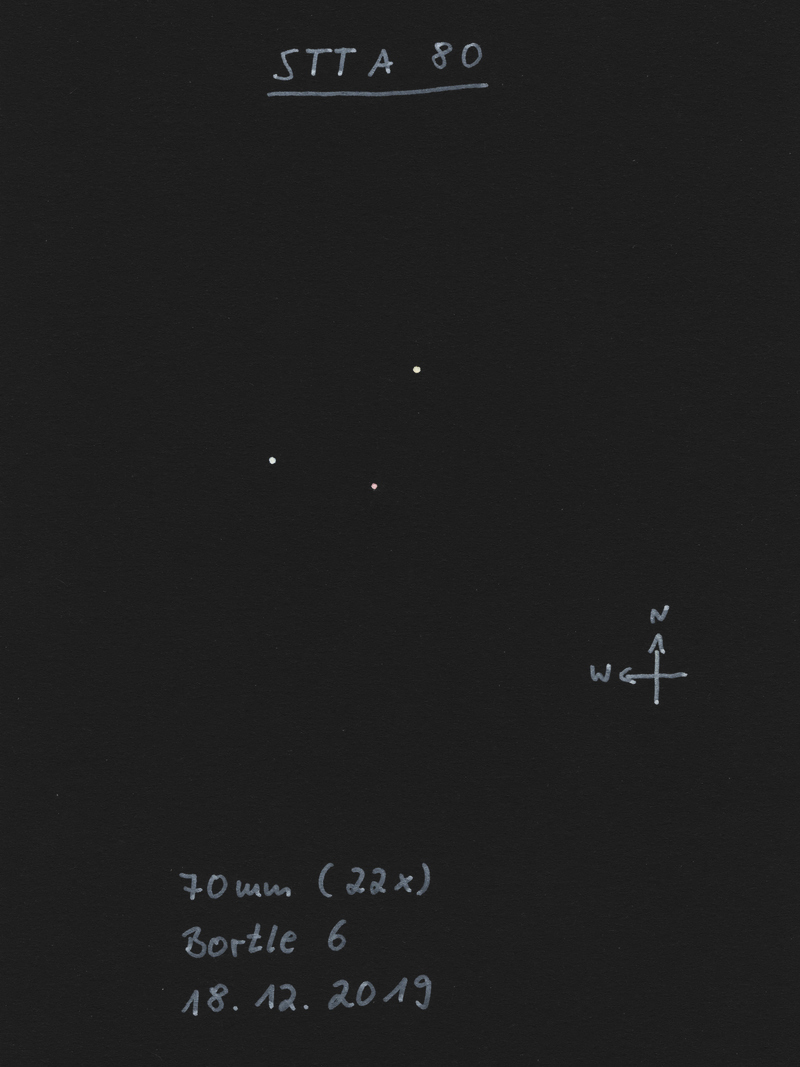
|
|
|
★★
|
STF1007 |
|
AB |
7m.4 |
11m.4 |
14.6" |
300° |
2015 |
Gem |
07h00m37.12s / +12°43'24.20" |
|
|
|
|
AC |
7m.4 |
10m.0 |
21.9" |
244° |
2015 |
|
|
|
|
|
|
AD |
7m.4 |
7m.7 |
67.7" |
28° |
2016 |
|
|
Christopher Hay
Seeheim (Germany) |
7x45 |
AD: Handheld. Stands out immediately as double with clear PA in field of several similarly bright single stars. Unsupported, hand tremor prevents actually seeing each component singly, but by bracing arms in reclining chair the well-matched pair is clearly split.
A physical double at a distance to us of 914 light years. |
|
Christopher Hay
Seeheim (Germany) |
15x45 |
Binoculars with internal stabilisation, handheld. AD well split. A is distinctly brighter and seems bluish. Nice in 4.5° FOV together with STTA80 ABC. |
|
Robert Zebahl
Leipzig (Germany) |
70mm (22x) |
AD: Wide separation, small difference in brightness. Slight difference in color, but difficult to describe. Component A at least seemed rather white. South of STF1007 there is also the double star HJ3288 and the star HD52976, which appears in a bright orange. Together in one field of view a beautiful sight. |
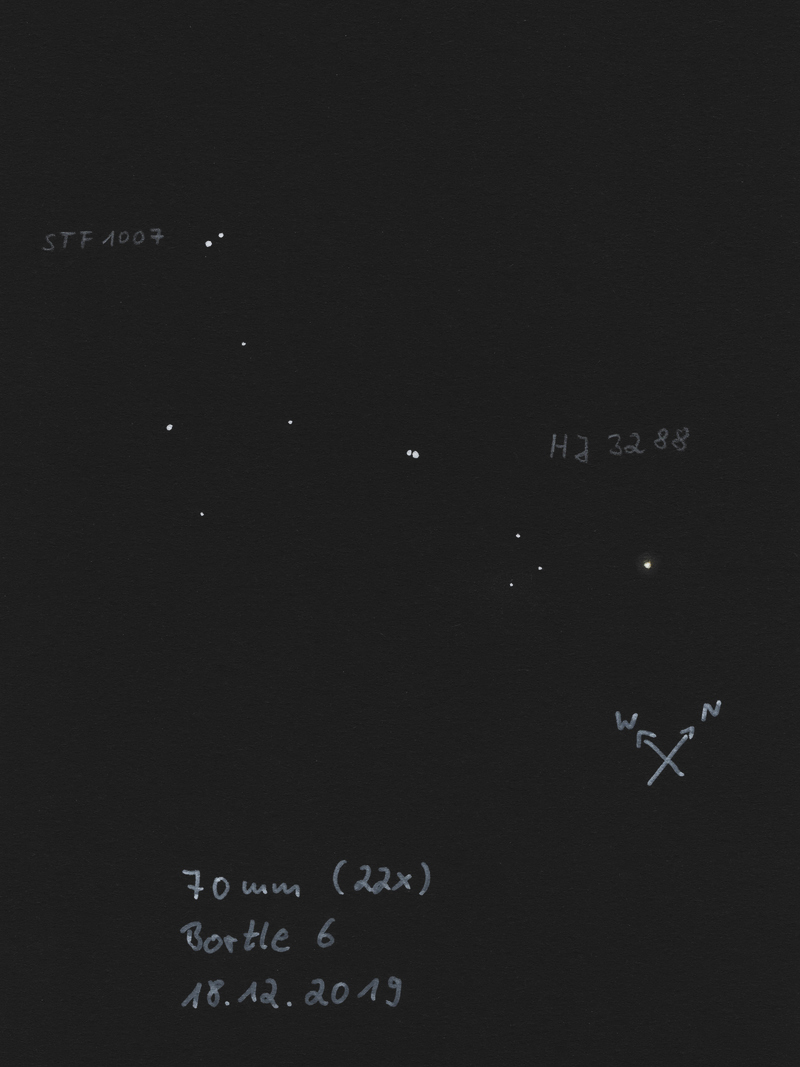
|
|
|
★
|
ARN66 |
|
AF |
6m.6 |
8m.3 |
172.0" |
301° |
2011 |
Gem |
07h01m17.01s / +32°24'52.40" |
Christopher Hay
Seeheim (Germany) |
7x45 |
Handheld. AF is an immediately striking wide pair. Viewed comfortably in 8.6° FOV together with very wide Rho Gem, a further physical pair.
Arnold 66 AF is a physical double at a distance to us of 462 light years. |
|
|
|
|
STF1010 |
|
AC |
7m.7 |
8m.8 |
22.3" |
7° |
2017 |
Mon |
07h01m27.05s / -03°07'03.30" |
René Merting
Drachhausen (Germany) |
18x70 |
ein schönes enges Pärchen - Komponente B zeigt sich nicht zu knapp getrennt nördlich von A - Helligkeitsunterschied eine Größenklasse - zwei sehr schwache Sterne flankieren nahezu symmetrisch im SO und SW das Paar - netter Anblick |
|
|
|
★
|
SHJ77, zeta Gem, 43 Gem, Mekbuda |
|
AB |
4m.0 |
11m.5 |
87.3" |
85° |
2017 |
Gem |
07h04m06.54s / +20°34'13.10" |
|
|
|
|
AC |
4m.0 |
7m.7 |
101.5" |
347° |
2017 |
|
|
|
|
|
|
AD |
4m.0 |
12m.5 |
67.0" |
355° |
2017 |
|
|
Christopher Hay
Seeheim (Germany) |
15x45 |
AC: Binoculars with internal stabilisation, handheld. AC are wide apart and a visually strong (though not physical) pair. |
|
|
|
★★★
|
ENG28 |
|
AB |
7m.9 |
7m.7 |
171.9" |
99° |
2015 |
Gem |
07h08m00.24s / +15°31'42.90" |
Christopher Hay
Seeheim (Germany) |
7x45 |
Handheld. Widely split matched pair. Easy to find half a degree south of 45 Gem. Comfortably viewed in 8.6° FOV together with STTA 80 AB and STF 1007, all three systems well-to-wide split, a charming trio of doubles. Alternatively, ENG 28 can also be viewed together with Zeta Gem (Mekbuda) 5° to the north.
Engelmann 28 is a physical double at a distance to us of 152 light years.
There is an interesting quirk about the ENG designation, on which Stelledoppie notes: Some time after publication of the IDS, the designation for Engelmann was changed from EN to ENG and that for Engelhardt from ENG to ENH. This has led to considerable confusion between the two. |
|
Mark McCarthy
Fremont (California/USA) |
80mm (13x) |
Pretty, wide equal finder split, white, nice field. |
|
|
|
★★
|
145 CMa, Winter Albireo |
HJ3945, Winter Albireo |
AB |
5m.0 |
5m.8 |
26.5" |
50° |
2020 |
CMa |
07h16m36.84s / -23°18'56.10" |
|
|
|
SHY508 |
BC |
5m.8 |
6m.8 |
999.9" |
166° |
2016 |
|
|
Christopher Hay
Seeheim (Germany) |
7x45 |
AB: On tripod. Very tight but definitely split. A tends towards orange. Proximity to A prevents determination of colour of B. |
|
René Merting
Drachhausen (Germany) |
8x30 |
AB: Winter-Albireo - ein eng stehendes Pärchen, ganz knapp getrennt - Komponente A im SW knallig orange, bei B ist schwer eine Farbnuance erkennbar, eher weißlich und deutlich schwächer als A |
|
René Merting
Drachhausen (Germany) |
10x50 |
AB: ein knapp getrenntes Paar (nicht besser als im 8x30) - Komponente A leicht gelblich, B ist kühler, weißlich |
|
Christopher Hay
Seeheim (Germany) |
10x56 |
BC: On tripod. B is set off well from visually distracting A (which in turn is the primary of HJ3945, the Winter Albireo). C seen clearly and well framed in 6.3° field of view with Tau CMa at centre of field.
Shaya 508 BC is a physical double at a distance to us of 303 light years. Reported in E.J. Shaya, R. Olling, 2011: Very Wide Binaries and Other Comoving Stellar Companions: A Bayesian Analysis of the Hipparcos Catalogue. The C component is more than 3° to the south of the B component. Coordinates of C component (= HD 35578) are RA 07h20m32.5s, DEC -26°42'01". |
|
Christopher Hay
Seeheim (Germany) |
10x56 |
AB: On tripod. Immediately striking as well-split pair. A flashing orange. Glare and scintillation of A prevent any definite colour impression of B. |
|
René Merting
Drachhausen (Germany) |
12x42 |
Conditions in the target region: SQM-L 20.5
AB: Conditions in the target region: SQM-L 20.5
ein knapp getrenntes Sternpaar - Komponente A im Südwesten schimmert hellgelb, B wirkt kühlweiß |
|
René Merting
Drachhausen (Germany) |
18x70 |
AB: ein gut getrenntes Pärchen - Komponente A im Südwesten ist apfelsinenorange, B wirkt anfangs eisblau, bei längerer Betrachtung weißgrau |
|
Christopher Hay
Seeheim (Germany) |
42mm (12x) |
AB: Clean split. Orange and blue. |
|
René Merting
Drachhausen (Germany) |
76mm (29x) |
Conditions in the target region: SQM-L 20.0
AB: Conditions in the target region: SQM-L 20.0
bei 29x ein wunderwunderschöner Doppelstern, mehr als ordentlich getrennt, aber die Farben, die machen ihn faszinierend - Komponente A im Südwesten strahlt tieforange und changiert oft ins gelbe (vermutlich dem tiefen Stand über dem Horizont geschuldet), die B-Komponente zeigt sich leicht grünbläulich, so wie man es von manchen PN kennt - Helligkeitsunterschied ist eine Größenklasse |
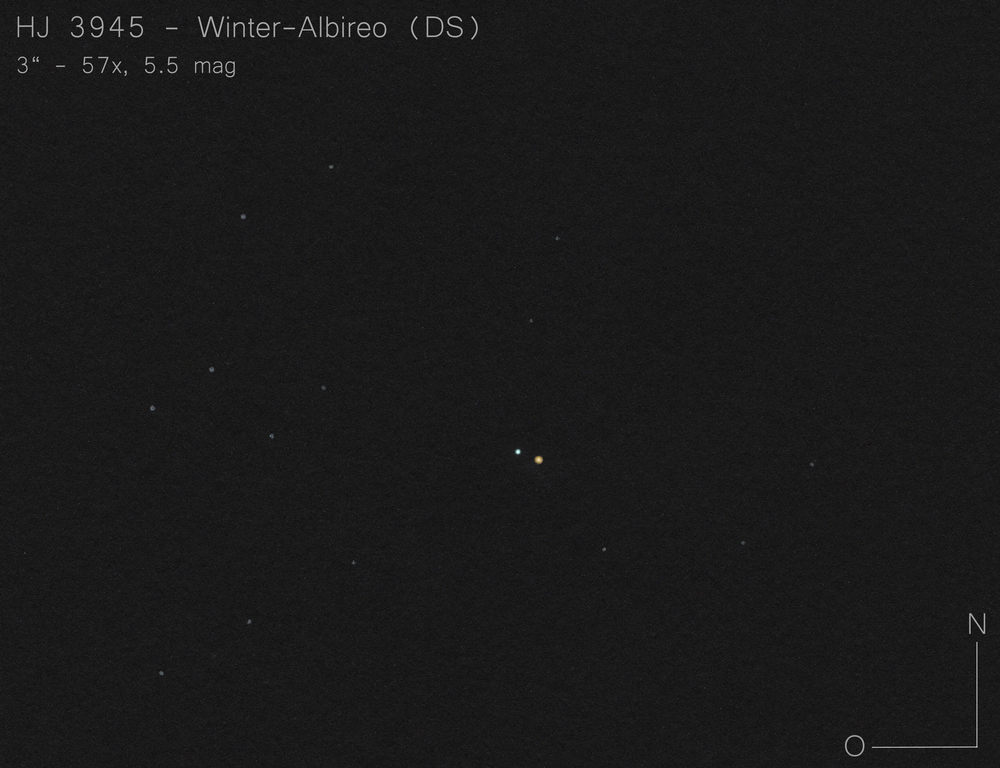
|
René Merting
Drachhausen (Germany) |
100mm (20x) |
AB: bei 32x leuchtet Komponente A goldgelb, B im NO wirkt weiß ohne den erwarteten Farbstich, auch nicht bei 107x und auch nicht, wenn ich die Sterne leicht unscharf stelle - trotzdem sehenswert - auch bei 20x zeigen sich beide Sterne ordentlich voneinander getrennt, A strahlt jetzt noch tiefgelber, fast orange |
|
Uwe Pilz
Leipzig (Germany) |
105mm (37x) |
AB: sofort auffallend, blau-orange |
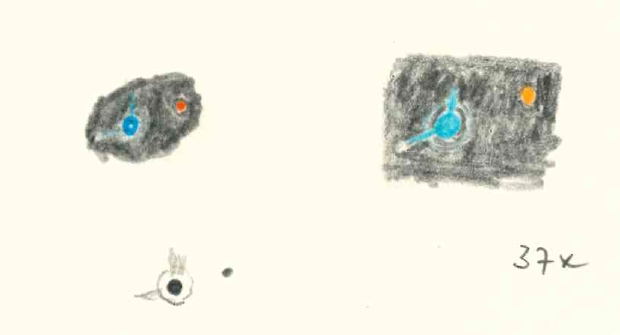
|
Robert Zebahl
Leipzig (Germany) |
120mm (23x) |
AB: Evident, easy to split at large angular distance. Brighter component appeared very orange, fainter one bluish. |
|
Sarah Gebauer
Germany |
254mm (42x) |
AB: ein richtig toll farbiges Pärchen, sauberst und weit getrennt, die südwestliche Komponente ist strahlend hellgold, die östliche leicht bläulich und blickweise manchmal grau, manchmal kobaltblau |
|
|
|
★
|
STF1090 |
|
AB |
7m.3 |
8m.2 |
60.8" |
98° |
2017 |
Gem |
07h26m27.33s / +18°31'00.80" |
|
|
|
|
AC |
7m.3 |
9m.5 |
49.0" |
80° |
2017 |
|
|
|
|
|
|
BC |
8m.2 |
9m.5 |
20.9" |
328° |
2017 |
|
|
Christopher Hay
Seeheim (Germany) |
15x45 |
Binoculars with internal stabilisation, handheld. AB are well split. Substantial delta-mag.
A physical double at a distance to us of 366 light years. |
|
Mark McCarthy
Fremont (California/USA) |
317mm (553x) |
AC: Pretty finder split, equal white. Is a 2+1 with 2x fainter BC. |
|
Mark McCarthy
Fremont (California/USA) |
317mm (553x) |
BC: Is a 2+1 with AC, C is 2 delta mag than fainter B. |
|
|
|
★
|
ES2625 & S548 |
ES2625 |
AB |
7m.0 |
12m.4 |
11.9" |
24° |
2015 |
Gem |
07h27m40.54s / +22°08'29.30" |
|
|
|
S548 |
AC |
7m.0 |
8m.9 |
35.3" |
277° |
2019 |
|
|
Christopher Hay
Seeheim (Germany) |
15x45 |
S548 (AC): Binoculars with internal stabilisation, handheld. Clean split. Secondary very faint. Primary yellowish-orange, a colour impression confirmed (without split) in handheld 7x45. Seen together with Eskimo Nebula (stellar) in 4.5° FOV.
A physical double at a distance to us of 1199 light years. |
|
René Merting
Drachhausen (Germany) |
100mm (20x) |
S548 (AC): bei 32x ein weit getrenntes Paar - Komponente A strahlt schwach gelblich … eher dunkelgelb - Komponente C im Westen von A ist gut 1.5 Magnituden schwächer und dunkelgrau bis lachsorange - der Doppelstern steht isoliert, fällt aber nicht übermäßig auf - zurück auf 20x ist das Paar weiterhin gut getrennt erkennbar |
|
Sarah Gebauer
Germany |
100mm (80x) |
S548 (AC): bei 80-fach weit getrennt, die östliche Komponenten scheint schön gelb, die westliche hauptsächlich grau und flackert nur für einen kurzen Augenblick blau auf - bei 49-fach intensiviert sich der warmgelbe Farbton stark und geht sogar ins Kupferorange, der Begleiter ist blickweise etwas häufiger leuchtend kobaltblau, aber nur selten |
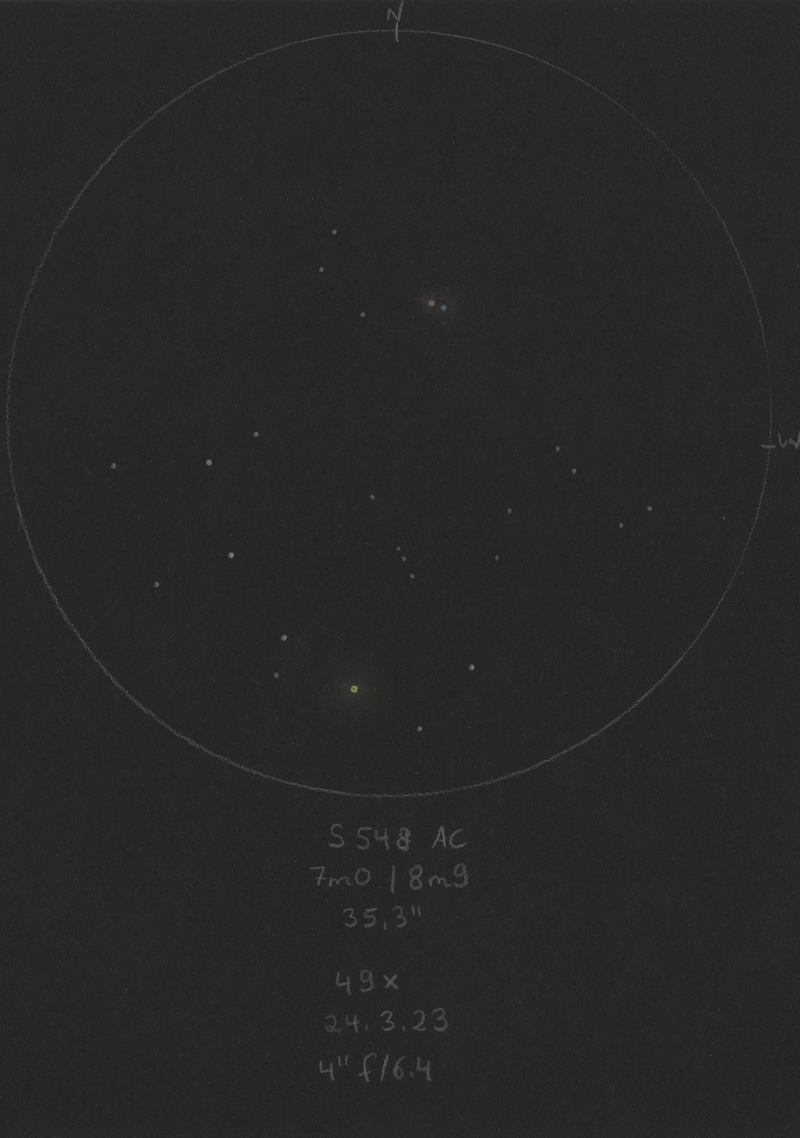
|
Uwe Pilz
Leipzig (Germany) |
105mm (88x) |
S548 (AC): bei 21x trennbar, orange und fahlblau |

|
Mark McCarthy
Fremont (California/USA) |
317mm (553x) |
S548 (AC): Orange with a 2x fainter white star, PA slightly SW. AB is 12th mag and not seen |
|
|
|
|
rho Gem, 62 Gem |
A2124 |
AB |
4m.2 |
12m.5 |
1.2" |
272° |
2006 |
Gem |
07h29m06.72s / +31°47'04.30" |
|
|
|
A2124 |
AC |
4m.2 |
11m.6 |
221.6" |
285° |
2001 |
|
|
|
|
|
ALC3 |
AE |
4m.2 |
7m.8 |
755.4" |
355° |
2001 |
|
|
|
|
|
A2124 |
CD |
11m.6 |
13m.4 |
102.1" |
271° |
2015 |
|
|
|
|
|
ALC7 |
EF |
7m.7 |
15m.4 |
2.8" |
-1° |
1991 |
|
|
Christopher Hay
Seeheim (Germany) |
7x45 |
AE: Component E is a fine pinprick of light. The distance to A is so substantial that the pair would not normally be felt to be a double. This makes it all the more interesting to contemplate that this is a true physical double in our galactic neighbourhood at 59 light years distance to us. ALC = Allen, C., published in 2000. |
|
|
|
★
|
STF1102 |
|
AB |
7m.4 |
9m.2 |
7.7" |
45° |
2016 |
Gem |
07h30m26.25s / +13°51'54.00" |
|
|
|
|
AC |
7m.4 |
13m.2 |
21.8" |
77° |
2015 |
|
|
|
|
|
|
AD |
7m.4 |
8m.0 |
111.9" |
131° |
2015 |
|
|
|
|
|
|
BC |
9m.2 |
13m.2 |
15.9" |
91° |
2015 |
|
|
|
|
|
|
BE |
9m.2 |
12m.0 |
30.4" |
3° |
2015 |
|
|
Christopher Hay
Seeheim (Germany) |
7x45 |
AD: Handheld. Clear, almost wide, split. Component A distinctly brighter.
A physical double at a distance to us of 148 light years. |
|
Christopher Hay
Seeheim (Germany) |
15x45 |
AD: Binoculars with internal stabilisation, handheld. Wide split. A visually strong pair. |
|
René Merting
Drachhausen (Germany) |
76mm (57x) |
AB: bei 57x kann ich mit ganz viel Konzentration B knapp getrennt östlich von A erkennen - Helligkeitsunterschied 1.5 bis 2 Magnituden n\AD: Komponente D im Südosten habe ich natürlich auch schon bei 29x gesehen, aber mir war nicht bewusst, dass diese zum System dazu gehört |
|
Mark McCarthy
Fremont (California/USA) |
178mm (205x) |
AB: Easy white A and ruddy B, wide, 1 delta. Physical |
|
|
|
|
STF1141 |
|
AB |
8m.4 |
9m.4 |
17.5" |
10° |
2017 |
CMi |
07h47m02.47s / +00°01'06.10" |
René Merting
Drachhausen (Germany) |
18x70 |
AB: ganz dicht nördlich über Komponente A ist B knapp getrennt als schwaches Murmelchen sichtbar, Helligkeitsunterschied schätzungsweise 1.5 Magnituden
AD: nordöstlich von A in vierfachem Abstand AB ist Komponente D als schwaches Lichtpünktchen D erkennbar
AE: Komponente E zeigt sich westlich von Komponente A in drei- bis vierfacher Entfernung wie AB, schwach |
|
René Merting
Drachhausen (Germany) |
100mm (32x) |
AB: Komponente B zeigt sich mehr als knapp getrennt nördlich von A - Komponente A ist doppelt so hell wie B
AD: Komponente D ist mir nordöstlich in vierfachem Abstand AB auch noch aufgefallen und ich konnte drei bis vier weitere schwache Sterne erkennen, sicherlich alles weitere Komponenten dieses Mehrfachsystems |
|
|
|
|
STTA88 |
|
AB |
7m.5 |
8m.9 |
57.1" |
6° |
2016 |
CMi |
07h48m58.22s / +00°39'42.90" |
|
|
|
|
AC |
7m.5 |
10m.8 |
95.8" |
51° |
2015 |
|
|
René Merting
Drachhausen (Germany) |
18x70 |
AB: ein einfacher Fernglas-Doppelstern - beide Komponenten sind gut sichtbar, weit getrennt voneinander - Komponente B im Norden ist gut 1.5 Magnituden schwächer - leichter Farbkontrast |
|
René Merting
Drachhausen (Germany) |
100mm (20x) |
AB: bei 32x ein mehr als bequem getrenntes Paar - Komponente B im Norden ist halb so hell wie A - zurück auf 20x weiterhin eine ordentliche Trennung |
|
|
|
★★★
|
STTA89 |
|
|
6m.8 |
7m.7 |
76.6" |
84° |
2017 |
Gem |
07h51m00.20s / +31°36'48.70" |
Christopher Hay
Seeheim (Germany) |
7x45 |
Handheld. Clearly split. Primary distinctly brighter. Rather charming in 8.6° FOV together with Castor and Pollux, with which it forms an almost equilateral triangle.
A physical double at a distance to us of 660 light years. |
|
Christopher Hay
Seeheim (Germany) |
20x60 |
Handheld in reclining chair, binoculars with internal stabilisation. A charming wide pair with a subtle blue/orange colour contrast. |
|
Robert Zebahl
Leipzig (Germany) |
70mm (22x) |
At 22x widely separated with moderate difference in brightness. The primary component appeared whitish, at 44x rather white-yellowish. The companion appeared slightly orange. |
|
|
|
★★
|
STF1268, iota Cnc, 48 Cnc |
|
|
4m.1 |
6m.0 |
30.6" |
308° |
2021 |
Cnc |
08h46m41.82s / +28°45'35.60" |
Christopher Hay
Seeheim (Germany) |
10x42 |
Binoculars with internal stabilisation, handheld. Secondary a pinprick of light directly next to the overpowering primary. Slightly uncertain, but PA as seen confirmed afterwards in database. In stabilised 15x45 binoculars the pair is well split, primary white tending towards yellow, secondary substantially colder.
A physical double at a distance to us of 331 light years. |
|
Christopher Hay
Seeheim (Germany) |
15x60 |
On tripod. Well split. Primary very pale yellow, secondary very pale blue. A most striking pair. |
|
Robert Zebahl
Leipzig (Germany) |
70mm (22x) |
Striking, widely separated with noticeable difference in brightness. Moderate but beautiful color contrast: white-yellowish and grey-bluish. |
|
Christopher Hay
Seeheim (Germany) |
71mm (32x) |
Compact pair. Yellow, pale blue. Totally dominates 2.2° FOV. |
|
René Merting
Drachhausen (Germany) |
76mm (57x) |
bei 29x zeigt sich A strahlend gelb, bei Konzentration auf A zeigt bei einen schönen mintgrünen Farbton - B ist gut 1.5 Magnituden schwächer - bei 57x verstärkt sich der Farbeindruck bei der B-Komponente, aber eher, wenn ich den Stern flüchtig betrachte |
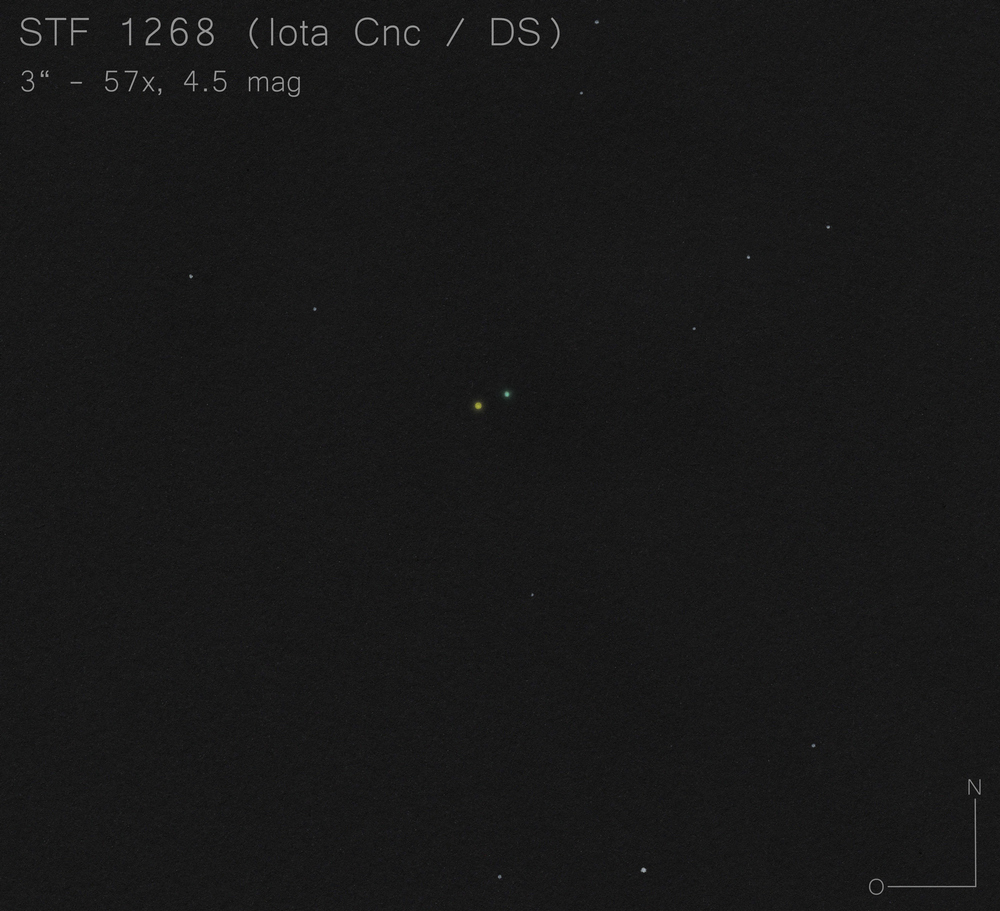
|
Axel Tute
Küssaberg (Germany) |
100mm (19x) |
13.04.2009: A: bluish, B: reddish |
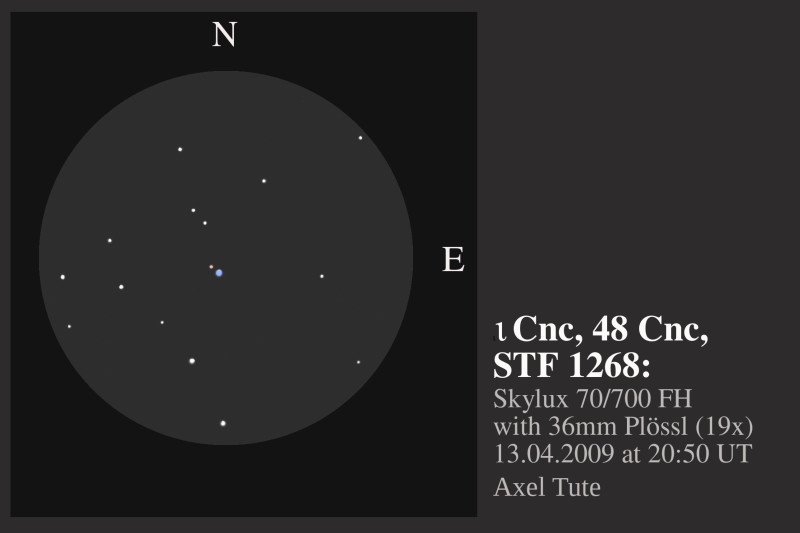
|
Sarah Gebauer
Germany |
100mm (20x) |
schon bei 20-fach schön getrennt mit einem schönen, warmen, gelben Farbton - bei 49-fach zeigt sich dann der Kontrast zu einem leicht hellgrau bis hellblauen Begleiter, während die Hauptkomponente sehr viel heller wird und warmgelb bleibt |
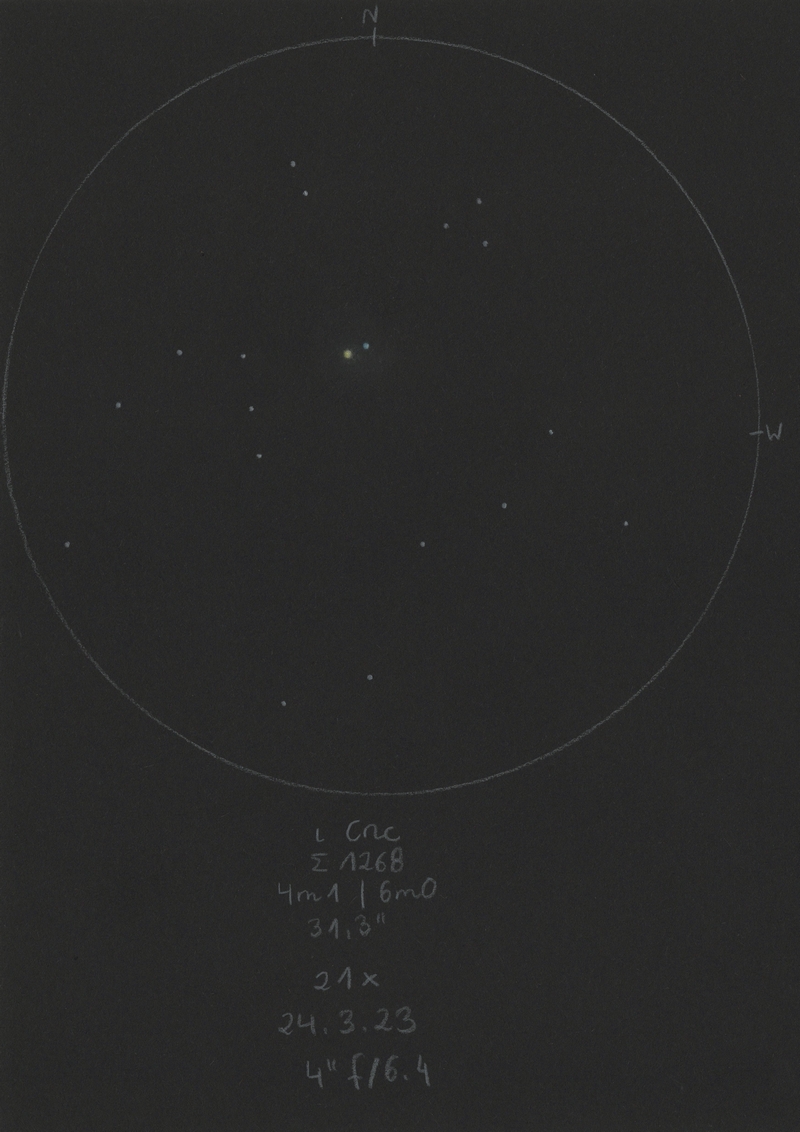
|
Robert Zebahl
Leipzig (Germany) |
102mm (28x) |
Grand sight! Pretty wide apart and unequal. A: mild orange, B: very nice light blue. |
|
Stefan Loibl
Rosenheim (Germany) |
102mm (164x) |
wide pair with nice colour contrast yellow/blue |
|
Uwe Pilz
Leipzig (Germany) |
105mm (28x) |
fahlblau und gelborange |

|
Uwe Pilz
Leipzig (Germany) |
105mm (144x) |
gelb-blaugrau |
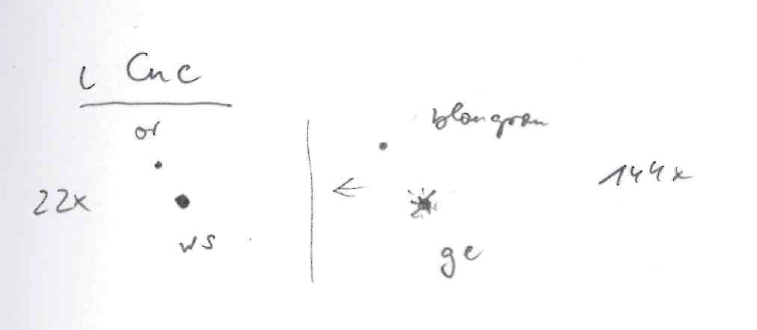
|
Sarah Gebauer
Germany |
150mm (125x) |
bei 83x schon deutlich getrennt, der Farbkontrast ist gut zu sehen, er wird bei 125x noch stärker, ein zartes Blau und Gelb sind zu sehen |
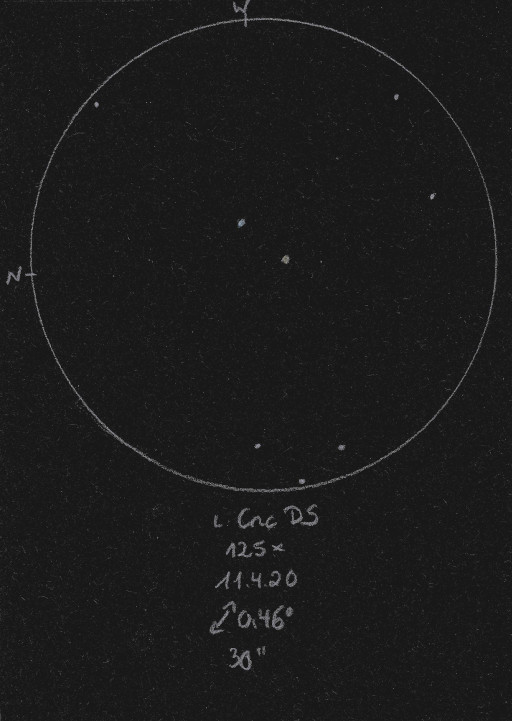
|
Mark McCarthy
Fremont (California/USA) |
317mm (553x) |
Iot Cnc: Pretty orange and pale blue, showpiece object. |
|
|
|
★
|
HJ460, 53 Cnc |
|
AB |
6m.5 |
11m.7 |
43.7" |
335° |
2003 |
Cnc |
08h52m28.60s / +28°15'33.00" |
|
|
|
|
AC |
6m.5 |
6m.0 |
276.8" |
20° |
2011 |
|
|
Christopher Hay
Seeheim (Germany) |
7x45 |
AC: Very wide. C is cold blue, A warmer and weaker.
AC is Rho1 Cnc. C is 55 Cnc, aka Copernicus AB, home to five exoplanets, fairly close to us at a distance of only 41 light years. |
|
Christopher Hay
Seeheim (Germany) |
10x42 |
AC: Binoculars with internal stabilisation, handheld. C is light blue, A brownish-orange. Attractive in 6.5° FOV together with 57 and 61 Cnc and Iota Cnc less than 2° to the west, which is split. |
|
Christopher Hay
Seeheim (Germany) |
15x60 |
AC: On tripod. A wide matching pair. Component A (53 Cnc) seems reddish. Nice together with well-split Iota Cnc in 3.3° FOV. |
|
René Merting
Drachhausen (Germany) |
76mm (57x) |
AC: bei 29x ein weit auseinander stehendes Paar - bei genauer Betrachtung wirkt C im Norden leicht gelblich und A im Süden irgendwie farbiger, dunkler im Farbton als A - interessant wird es dann bei 57x, A erscheint hellgelb und B kommt mit einem Stich ins Orange aber auch roséfarben daher |
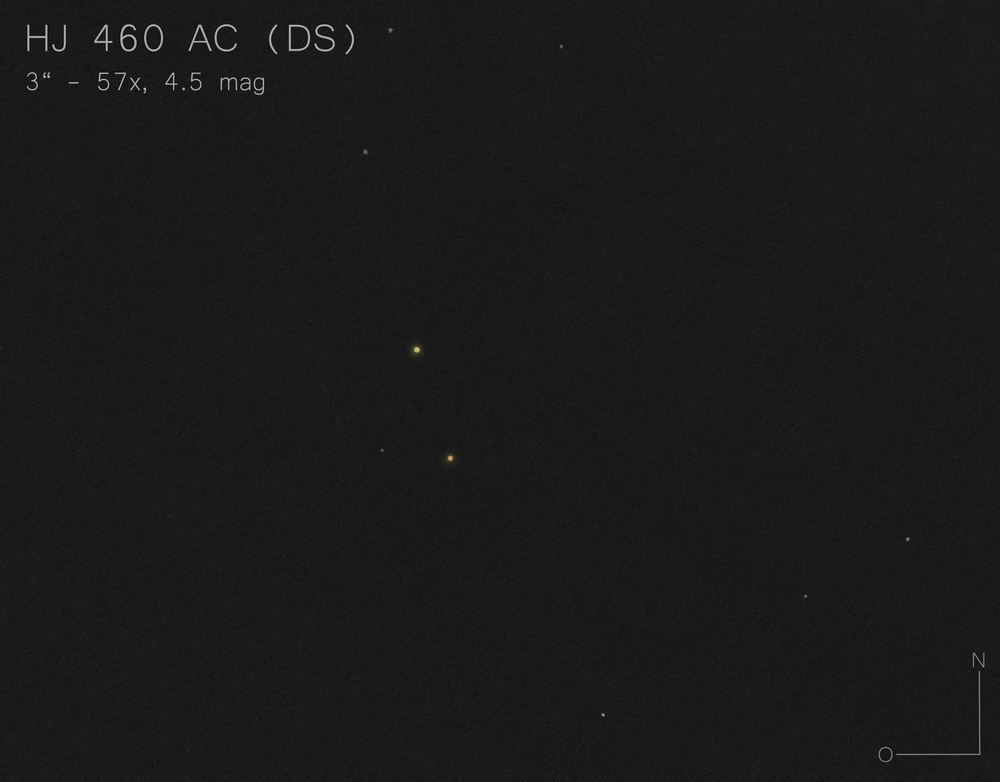
|
Sarah Gebauer
Germany |
100mm (49x) |
AC: bei 49-fach ein gleich helles Pärchen mit riesigem Abstand und einem warmweißen Farbton mit einem Stich ins Gelbliche, vielleicht ganz leicht kupferfarben - bei 20-fach passt er schön zusammen mit dem reizvollen Doppelstern Iota Cnc in ein GF, besonders schön! |
|
Mark McCarthy
Fremont (California/USA) |
317mm (553x) |
AB: 53 Cnc: Orange primary and 2x fainter blue, wide separation (this is AB). There is a second orange-yellow star of about the same magnitude very wide separation (this is AC). |
|
|
|
★
|
SHY204, 62/63 Cnc, omicron Cnc, omicron 1/2 Cnc |
|
|
5m.2 |
5m.7 |
975.6" |
17° |
2016 |
Cnc |
08h57m14.95s / +15°19'21.90" |
René Merting
Drachhausen (Germany) |
naked eye |
anfangs eine länglich schimmernde Lichtquelle - indirekt sind dann zwei schwache Sterne erkennen |
|
Christopher Hay
Seeheim (Germany) |
2x54 |
Wide apart, Omicron clearly brighter than 63 Cnc. Nice together with Praesepe (M 44) and the Head-of-the-Hydra asterism in 25° FOV.
Shaya 204, comprising Omi Cnc and 63 Cnc, is a physical double at a distance to us of 149 light years. Presumably separable naked-eye if NELM allows, the limiting factor being the 5m7 of 63 Cnc. |
|
Christopher Hay
Seeheim (Germany) |
7x45 |
Super-wide, but still holding together as a pair. Both are bluish-white. |
|
René Merting
Drachhausen (Germany) |
12x42 |
ein weit getrenntes Paar - die schwächere Komponente im Norden wirkt kühlweiß, die südlichere warmweiß |
|
Christopher Hay
Seeheim (Germany) |
15x60 |
On tripod. No particular gain anticipated over 7x45 view, but in fact in the tighter 3.3° FOV the pair is quite charming, the field sprinkled liberally with many fainter stars. Both components (i.e. Omi Cnc and 63 Cnc) have an identical bluish-white hue, very pretty. |
|
René Merting
Drachhausen (Germany) |
18x70 |
beide Sterne sind weit getrennt, die südliche Komponente wirkt etwas heller und wirkt warmweiß, die nördliche eher kaltweiß (lt. StelleDoppie aber umgedreht, nämlich A5 und F0) |
|
|
|
|
STTA97 |
|
|
8m.3 |
8m.3 |
51.5" |
274° |
2018 |
Cnc |
09h08m27.16s / +27°32'35.30" |
Christopher Hay
Seeheim (Germany) |
15x45 |
Binoculars with internal stabilisation, handheld. Well split. Very evenly matched pair.
A physical double at a distance to us of 139 light years. |
|
Mark McCarthy
Fremont (California/USA) |
80mm (13x) |
Finder split, near equal white. |
|
Mark McCarthy
Fremont (California/USA) |
317mm (553x) |
80mm finder view shows an arc of three stars. westernmost star is a wide equal pair in the telescope. |
|
|
|
★★
|
STF1321 |
|
AB |
7m.8 |
7m.9 |
16.9" |
99° |
2019 |
UMa |
09h14m22.79s / +52°41'11.80" |
|
|
|
|
AC |
7m.8 |
14m.5 |
145.7" |
64° |
2010 |
|
|
|
|
|
|
AD |
7m.8 |
11m.9 |
136.4" |
129° |
2015 |
|
|
|
|
Robert Zebahl
Leipzig (Germany) |
16x70 |
AB: 2020-07-05: Very nice view, striking, easily separable. A slight difference in brightness is visible. At first glance the double star appeared noticeably orange compared to the surrounding stars, on closer look a color difference of the two components was visible: orange & rather white. |
|
Robert Zebahl
Leipzig (Germany) |
70mm (22x) |
AB: 2020-04-11: At 22x pretty wide pair with equally bright components. Striking colors: slightly orange & white-bluish, but it was a bit difficult to assign the colors to the components. At 44x slightly better color perception. |
|
Robert Zebahl
Leipzig (Germany) |
70mm (31x) |
AB: 2020-04-19: Together with STF1312 in one field of view. At 22x very nice sight, easy to separate, attractive separation. Immediately apparent. A color difference is visible: dark yellow, orange. Also beautiful to see at 44x. Best view at 31x. |
|
Christopher Hay
Seeheim (Germany) |
71mm (32x) |
AB: April 2021: Well split, matched pair. Both orangish.
With 180mm at 200x a wide, even, strong pair. Component A is noticeably slightly brighter. Both of identical pale mandarine-orange colour, rather captivating. |
|
René Merting
Drachhausen (Germany) |
76mm (29x) |
bei 29x ein wunderschön eng stehendes Sternpaar - bei beiden Sternen fällt sofort auf, dass sie nicht weiß sind - der westliche Stern strahlt intensiver, aber ein genauer Farbeindruck lässt sich nicht festmachen |
|
Sarah Gebauer
Germany |
100mm (49x) |
AB: bei 21-fach getrennt - zwei ganz feine Murmelchen, dicht beieinander - zunächst ein spontan warm orangefarbener Eindruck, bei näherem Hinsehen ist B goldorange, A leicht roségold - bei 49-fach verstärkt sich der Farbeindruck deutlich hin zu Orange mit Roségold - steht das Pärchen mittig im Gesichtsfeld, befinden sich ein paar wunderschön versprenkelte Sterne mit im Bild, das Pärchen dominiert jedoch durch seine Helligkeit und Farbe |
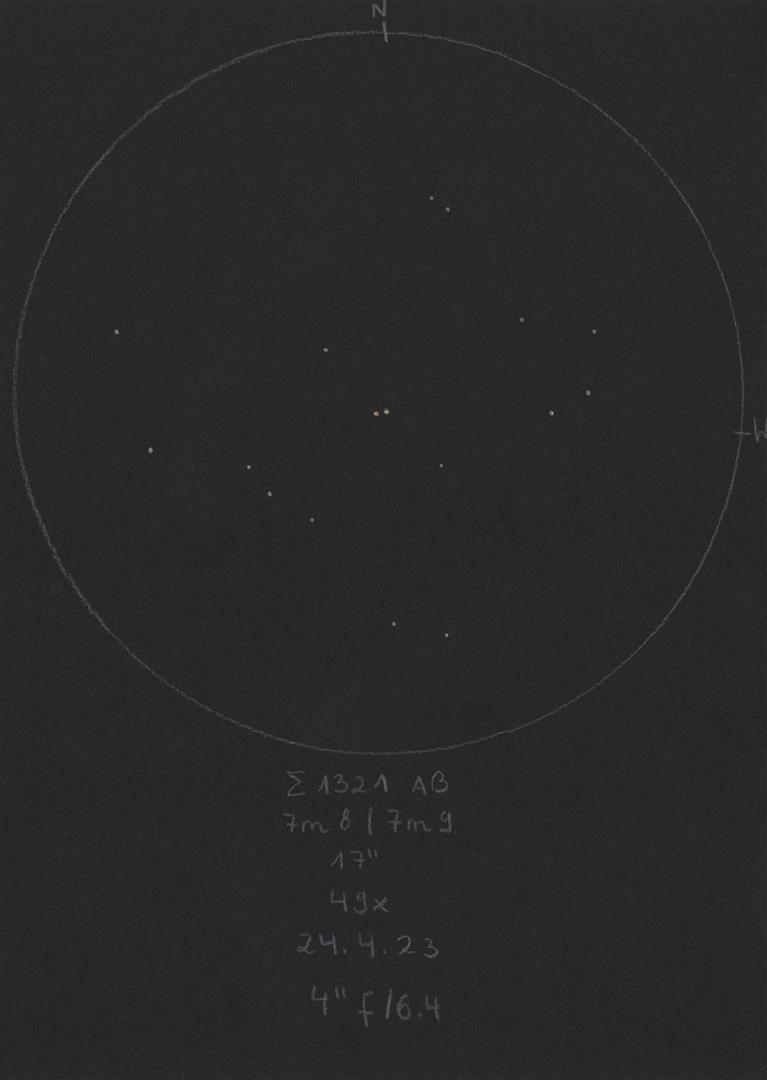
|
|
|
★
|
27 Hya |
SHJ105 |
AB |
4m.9 |
7m.0 |
229.1" |
211° |
2015 |
Hya |
09h20m29.03s / -09°33'20.30" |
|
|
|
GUI13 |
AD |
4m.9 |
16m.9 |
122.3" |
227° |
2015 |
|
|
|
|
|
DOO49 |
BC |
7m.0 |
11m.0 |
9.2" |
199° |
2016 |
|
|
Christopher Hay
Seeheim (Germany) |
7x45 |
AB: Handheld. AB wide, very disparate brightnesses. Secondary bluish.
A physical double at a distance to us of 222 light years. |
|
|
|
|
41 Lyn, S598 |
|
AB |
5m.5 |
7m.8 |
69.7" |
160° |
2017 |
UMa |
09h28m39.99s / +45°36'06.50" |
|
|
Robert Zebahl
Leipzig (Germany) |
8x40 |
Fairly well split with fainter component. |
|
|
|
★
|
HJ1167, tau 1 Hya, 31 Hya |
|
|
4m.6 |
7m.3 |
65.7" |
4° |
2016 |
Hya |
09h29m08.84s / -02°46'08.20" |
Christopher Hay
Seeheim (Germany) |
15x45 |
Binoculars with internal stabilisation, handheld. Wide, almost exactly north-south oriented. Primary slightly yellowish.
A physical double at a distance to us of only 57 light years. |
|
|
|
★
|
STF1369, DI Lyn |
|
AB |
7m.0 |
8m.0 |
25.1" |
150° |
2019 |
Lyn |
09h35m22.50s / +39°57'47.70" |
|
|
|
|
AC |
7m.0 |
8m.4 |
116.3" |
323° |
2017 |
|
|
|
|
|
|
BC |
8m.0 |
8m.4 |
141.6" |
324° |
2017 |
|
|
Christopher Hay
Seeheim (Germany) |
15x45 |
AB: Binoculars with internal stabilisation, handheld. Clearly split, a compact little pair. Involved in a nice triangle of 42 and 43 Lyn to the east plus a third bright, orangish star to the south.
AB is a physical double at a distance to us of 278 light years. |
|
Mark McCarthy
Fremont (California/USA) |
508mm (333x) |
AB: DI Lyn Very wide and bright light yellow stars, ~1 delta mag. [did not notice COU 2084 Aa,Ab, 6.98/8.79 0.2"] |
|
|
|
★★
|
alpha Leo, 32 Leo, Regulus |
STFB6 |
AB |
1m.4 |
8m.2 |
179.2" |
304° |
2019 |
Leo |
10h08m22.31s / +11°58'01.90" |
|
|
|
HDO127 |
AD |
1m.4 |
12m.1 |
195.3" |
274° |
2015 |
|
|
|
|
|
HDO127 |
BC |
8m.2 |
13m.2 |
2.2" |
94° |
2019 |
|
|
René Merting
Drachhausen (Germany) |
10x32 |
AB: Regulus strahlt weiß, B im Westnordwesten ist schwach, grau und mit großem Abstand zu erkennen, der Stern befindet sich im Halo von Regulus |
|
Christopher Hay
Seeheim (Germany) |
10x56 |
AB: On tripod. B immediately pops out from the glare of A, thanks to its substantial distance. B is a vivid blue.
Emboldened by the unexpected ease with which the pair can be seen in the 10x56, I launch an attempt with 7x50 bins on the tripod. This is thwarted by the many rays emanating from A in the image. Too much exit pupil?
AB is a physical double at a distance to us of only 79 light years. |
|
René Merting
Drachhausen (Germany) |
12x42 |
AB: Regulus präsentiert sich als strahlend weißer Persil-Riese mit einem mächtigen Halo, die B-Komponente ist weit abgesetzt aber noch immer im Halo von Regulus erkennbar, schwach, aber doch gut sichtbar - Helligkeitsunterschied enorm |
|
René Merting
Drachhausen (Germany) |
15x56 |
AB: Regulus wirkt eigenartig, er strahlt er klarweiß, mitunter mit einem Goldrand - B steht ordentlich abgesetzt im Nordwesten, gut erkennbar und doch megaschwach gegen die A-Komponente |
|
Christopher Hay
Seeheim (Germany) |
15x60 |
AB: On tripod. B is a fine pinprick of light, seems bluish. An attractive unevenly matched pair. |
|
René Merting
Drachhausen (Germany) |
18x70 |
AB: ein einfacher Doppelstern - Komponente B steht weitab nordwestlich vom gleißend weiß strahlenden Stern Regulus - B ist bedeutend schwächer als A und wirkt grau |
|
René Merting
Drachhausen (Germany) |
100mm (32x) |
AB: bei 32x ist B weit abgesetzt von A erkennbar - Regulus präsentiert sich strahlend weiß - B ist nur schwach weiß - kein echtes Doppelsternfeeling |
|
Sarah Gebauer
Germany |
100mm (49x) |
AB: bei 49-fach ein sehr weites, ungleiches Paar, gerade noch so als Doppelstern wahrnehmbar, Komponente A strahlt so hell, dass sie im Amiciprisma einen langen Spike erzeugt, wirkt sehr reinweiß - Komponente B erscheint warmbraun - bei 20-fach ist B auch noch gut zu erkennen, der Farbeindruck ist nun jedoch schwächer und B wird zu einem mausgrauen Punkt |
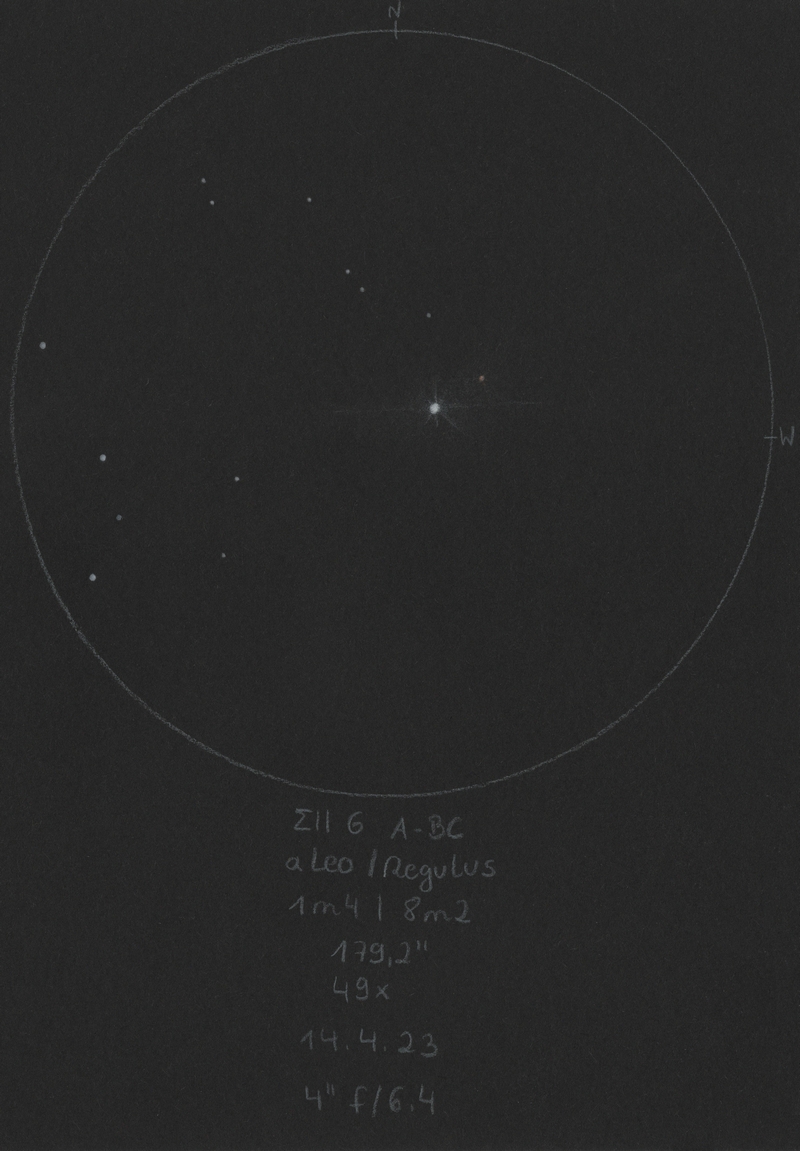
|
Uwe Pilz
Leipzig (Germany) |
105mm (288x) |
AB: sehr weit; einfach |
|
Sarah Gebauer
Germany |
150mm (30x) |
AB: relativ dicht beieinander, ein Stern sehr hell und groß, der zweite schwach und klein |
|
Gerd Kohler
Langenzenn (Germany) |
254mm (76x) |
AB: Bläulich-weiß - leicht rötlich. Großer Helligkeitsunterschied. |
|
Gerd Kohler
Langenzenn (Germany) |
254mm (76x) |
AD: Beim Begleiter von Regulus steht im fast gleichen Abstand, etwas nach Westen versetzt, ein sehr schwacher Stern. |
|
René Merting
Drachhausen (Germany) |
320mm (72x) |
AB: bei 72x extrem weit getrennt erkennbar - Komponente A ist weißblau, die wesentlich schwächere Komponente B strahlt weißgrau |
|
René Merting
Drachhausen (Germany) |
320mm (72x) |
AD: Komponente D ist südwestlich von B (STFB6) erkennbar, etwas weiter von A entfernt als B, klein und unscheinbar |
|
|
|
|
STF1415 |
|
AB |
6m.7 |
7m.3 |
16.5" |
168° |
2019 |
UMa |
10h17m50.61s / +71°03'38.90" |
|
|
|
|
AC |
6m.7 |
10m.8 |
153.3" |
13° |
2015 |
|
|
Robert Zebahl
Leipzig (Germany) |
16x70 |
AB: 2022-03-27: Beautiful double star, bright, conspicuous with small difference in brightness. The components appeared yellowish-orange and white-bluish. |
|
Robert Zebahl
Leipzig (Germany) |
70mm (22x) |
AB: 2020-04-07: At 22x immediately noticeable as double star, medium bright with rather small difference in brightness. A appeared whitish, B slightly orange, partly brownish. At 44x similar color impression: A white-bluish, B slightly orange. |
|
Robert Zebahl
Leipzig (Germany) |
70mm (44x) |
AB: 2021-04-03: At 12x easily separated, moderate brightness difference, unspectacular. At 44x, A appeared pale yellowish, B in very light blue. The color contrast was very subtle. |
|
René Merting
Drachhausen (Germany) |
320mm (45x) |
AB: bei 45x ein eng stehendes ordentlich getrenntes Paar - Komponente B im Süden wirkt weißgrau gegen die gut eine halbe Größenklasse hellere A-Komponente - das Paar sieht schick aus, es wird von drei schwächeren Sternen umrahmt |
|
|
|
|
HJL1057 |
|
|
8m.0 |
8m.8 |
205.6" |
167° |
2015 |
LMi |
10h20m02.46s / +33°33'17.30" |
Christopher Hay
Seeheim (Germany) |
7x45 |
Handheld. Wide split but secondary very faint (NELM 5m1 in target area). STTA104 one degree to the northeast has practically identical separation yet is much stronger.
The charm of this pair resides less in its visual appearance than in contemplating that it is a physical double at a distance to us of 287 light years. |
|
|
|
★
|
HJ2530 |
|
AC |
6m.4 |
6m.7 |
201.6" |
63° |
2015 |
Sex |
10h24m13.15s / +02°22'05.10" |
Christopher Hay
Seeheim (Germany) |
7x45 |
Handheld. Wide, strong, well-matched pair. Component A slightly orange, C colder. Nice in 8.6° FOV with Alpha and Beta Sextantis. |
|
Christopher Hay
Seeheim (Germany) |
12x36 |
Binoculars with internal stabilisation, handheld. Wide, very evenly matched pair, strong at this magnification in 5.6° FOV. Component A slightly orange, C slightly blue. |
|
|
|
★
|
STTA104 |
|
|
7m.2 |
7m.3 |
209.0" |
287° |
2013 |
LMi |
10h24m22.19s / +34°10'35.00" |
Christopher Hay
Seeheim (Germany) |
7x45 |
Handheld. Wide, striking matched pair. Nice together with triangle of 27/28/30 LMi, and thus also easy to find. HJL1057 also in field to southwest.
Delicate colour contrast in the triangle makes this a very attractive field: 30 LMi is yellowish-white, 28 reddish-white, 27 LMi colder.
In 15x45 binoculars STTA104 becomes almost too wide to feel it is a double, but the colour contrasts in the triangle become clearer. |
|
René Merting
Drachhausen (Germany) |
18x70 |
ein schöner Fernglasstern - die beiden gleichhellen Protagonisten sind relativ hell und stehen weit auseinander, sie werden zudem von drei noch helleren Sternen im Süden flankiert - die östliche Komponente strahlt roséweiß, B im Westen warmweiß |
|
Robert Zebahl
Leipzig (Germany) |
70mm (22x) |
2020-04-11: Very wide pair of similarly bright components, unremarkable color. The double star stands close to the stars 27, 28 & 30 LMi and is probably more appealing in smaller binoculars. |
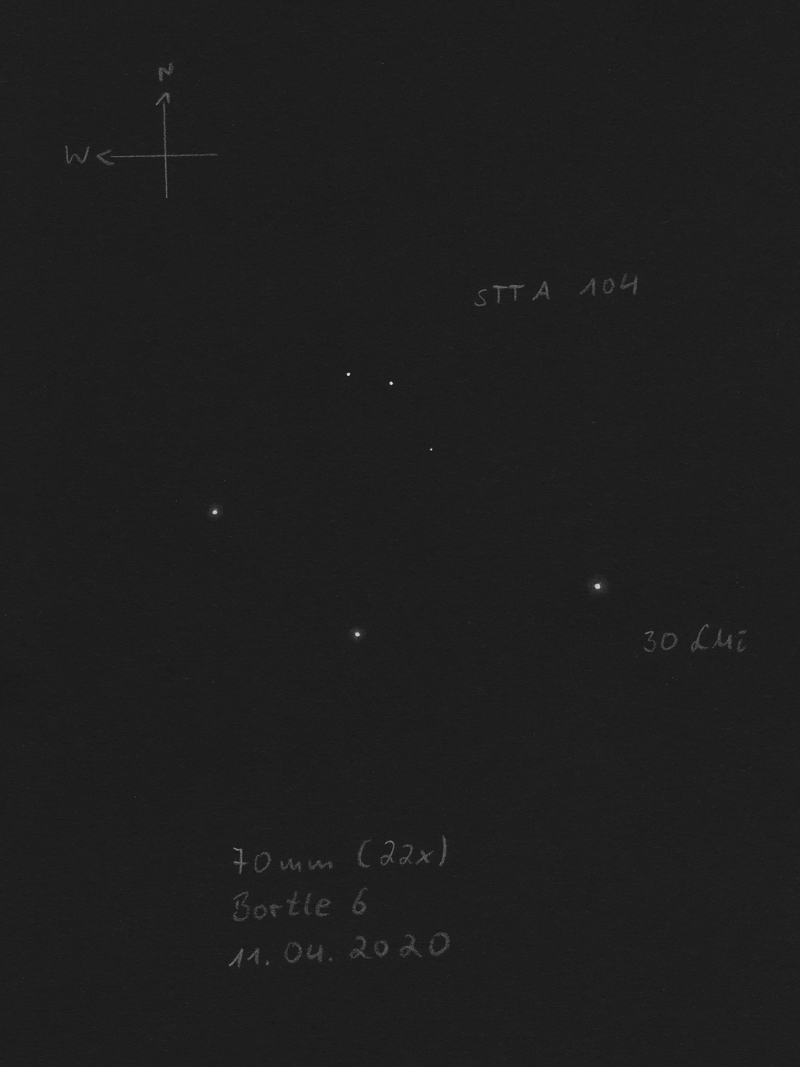
|
|
|
★
|
SMA75 |
|
AB |
5m.2 |
7m.3 |
288.0" |
88° |
2018 |
UMa |
10h43m32.89s / +46°12'13.90" |
|
|
|
|
AC |
5m.2 |
11m.1 |
152.0" |
16° |
2018 |
|
|
|
|
|
|
AD |
5m.2 |
9m.2 |
381.6" |
45° |
2018 |
|
|
|
|
|
|
BD |
7m.3 |
9m.2 |
259.2" |
357° |
2018 |
|
|
Christopher Hay
Seeheim (Germany) |
7x45 |
AB: Wide apart and large delta-mag, but still very much belonging together. No particular colour impression.
Smart 75 AB (also known as Shaya (SHY) 216) is a physical double at a distance to us of 121 light years. This is incidentally almost exactly the same distance to us as Alpha UMa AC, a further wide binocular pair in UMa. |
|
Mark McCarthy
Fremont (California/USA) |
317mm (553x) |
AB: Wide 80mm finder pair, white and slight yellow. In the scope there are some more faint stars about, so it is likely a small cluster -- 7 stars in the system. |
|
|
|
★
|
42 LMi |
S612 |
AB |
5m.3 |
7m.8 |
196.4" |
174° |
2019 |
LMi |
10h45m51.91s / +30°40'56.60" |
|
|
|
ARN3 |
AC |
5m.3 |
8m.3 |
424.6" |
94° |
2013 |
|
|
Christopher Hay
Seeheim (Germany) |
15x45 |
Binoculars with internal stabilisation, handheld. Panning around in the area the triangle of ABC is immediately striking. Component A cold-white, B reddish, C no particular colour. |
|
Robert Zebahl
Leipzig (Germany) |
70mm (22x) |
2020-04-11: Wide, striking triple system, which can be well observed with binoculars. A: quite bright, rather white, B: slightly orange, C: tending to orange. |
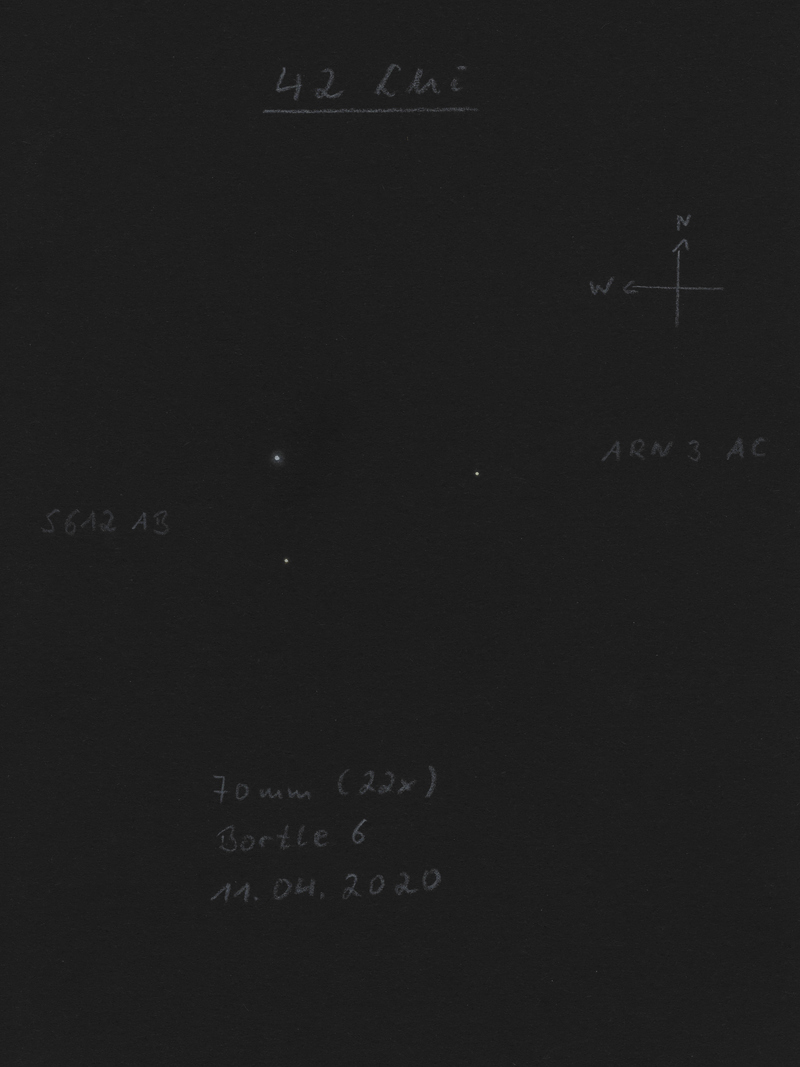
|
Mark McCarthy
Fremont (California/USA) |
80mm (13x) |
AB: Very widely separated, split in finder (196"!). white A with a slightly red B |
|
|
|
|
STF1474 |
|
AB |
6m.7 |
7m.0 |
65.9" |
27° |
2017 |
Hya |
10h47m37.93s / -15°15'42.90" |
|
|
|
|
AC |
6m.7 |
7m.6 |
72.6" |
26° |
2017 |
|
|
|
|
|
|
BC |
7m.0 |
7m.6 |
6.6" |
15° |
2020 |
|
|
Christopher Hay
Seeheim (Germany) |
7x50 |
AB: On tripod. Distinctly apart. Component A appears orangish at first sight, but the impression fades quickly. A nice matched pair. Luminous-red variable red giant star U Hydrae enhances the 7.3° FOV at its north-western margin. |
|
Christopher Hay
Seeheim (Germany) |
25x80 |
AB: So far apart that they do not make the impression of a double. A is bluish, no particular colour impression of BC.
BC: Hairfine split. The visual impression of ABC is not so much that of a triple system, rather more like a "double in a double". |
|
|
|
|
STF1495 |
|
|
7m.2 |
8m.8 |
33.8" |
36° |
2017 |
UMa |
10h59m49.47s / +58°54'23.30" |
Robert Zebahl
Leipzig (Germany) |
16x70 |
2023-02-15: Very pretty. The primary component shines in a light orange, the much fainter, nicely separated companion appears bluish. |
|
René Merting
Drachhausen (Germany) |
18x70 |
ein komfortabel getrenntes Sternpaar mit leichtem Farbkontrast - B steht versetzt nördlich von A und ist 1.5 bis 2 Magnituden schwächer |
|
René Merting
Drachhausen (Germany) |
76mm (29x) |
bei 29x einfach zu trennen - bei 57x wirkt A auf den Punkt genau gelb, starker Farbkontrast zur B-Komponente, die graublau wirkt |
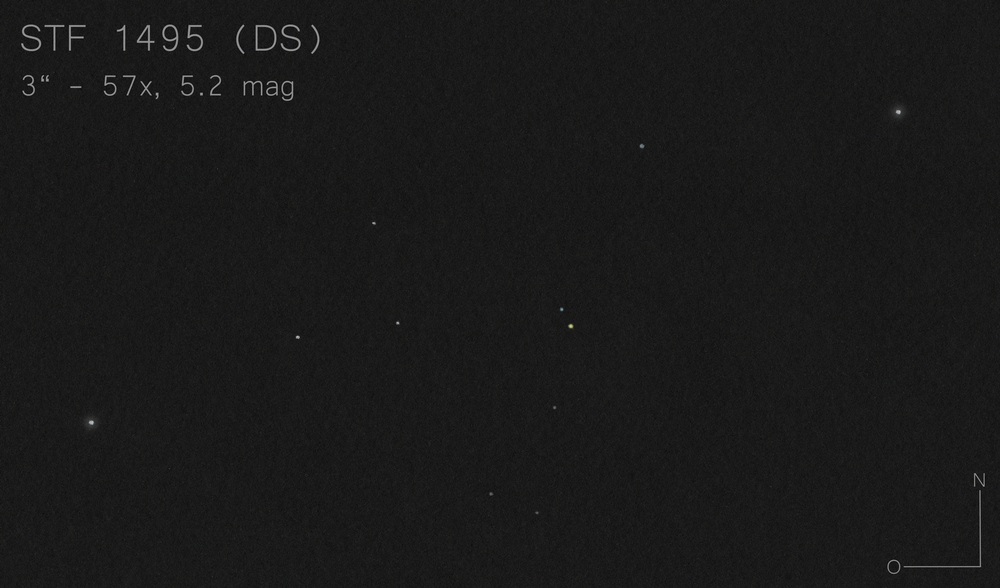
|
René Merting
Drachhausen (Germany) |
100mm (20x) |
bei 32x ein weit getrenntes Paar - Komponente B im NO ist knapp zwei Magnituden schwächer - A strahlend weiß, B die graue Maus, wie es sich gehört für die schwächere Komponente - zurück auf 20x immernoch ordentliche Trennung, der Helligkeitsunterschied wirkt nicht mehr ganz so groß |
|
Sarah Gebauer
Germany |
100mm (49x) |
schon bei 21-fach fein getrennt und leicht gelb-graublau - bei 49-fach leuchtet A nun stärker und orangegold, B etwas stärker grau mit weniger Blauhauch |
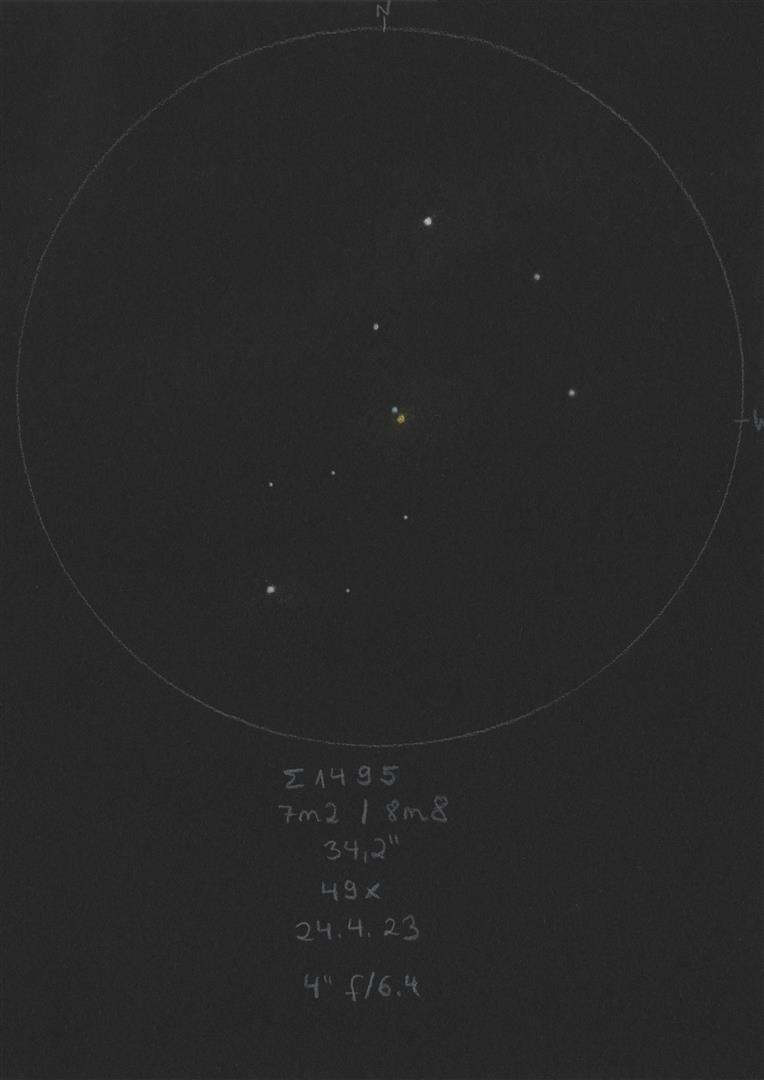
|
Sarah Gebauer
Germany |
254mm (96x) |
bei 96-fach ist der DS weit getrennt – die südliche, hellere Komponente zeigt sich leicht strohgelb, die nördliche eher grau |
|
René Merting
Drachhausen (Germany) |
320mm (45x) |
bei 45x weit getrennt - ein schönes farbiges Kontrastpaar - Komponente B im NO ist gut 1.5 Größenklassen schwächer und strahlt kupfergrau, A dagegen ist weißgelb |
|
|
|
★★
|
BU1077, alpha UMa, 50 UMa, Dubhe |
|
AB |
2m.0 |
5m.0 |
0.8" |
342° |
2017 |
UMa |
11h03m43.84s / +61°45'04.00" |
|
|
|
|
AC |
2m.0 |
7m.2 |
384.5" |
206° |
2020 |
|
|
|
|
Christopher Hay
Seeheim (Germany) |
7x45 |
AC: AC: Very wide apart but still feel as if belonging together. A golden-yellow, C seems blue, a very attractive pair.
A, B and C are a physical triple system at a distance to us of 123 light years. This is incidentally almost exactly the same distance to us as SMA75 AB, a further wide binocular pair in UMa. |
|
René Merting
Drachhausen (Germany) |
18x70 |
AC: Dubhe oder Alpha Ursae Majoris - hm, naja - C zeigt sich im Süden in Riesenabstand zum intensivgelbem A - Komponente C wirkt dagegen wie eine graue Maus und der Helligkeitsunterschied ist so enorm, dass er nicht abschätzbar ist |
|
Christopher Hay
Seeheim (Germany) |
36mm (8x) |
A wide pair but still appearing visually to belong together. Component A is a creamy gold-white. Component C is pale blue, but the colour impression fades after looking for a while. In parallel observation with 3-inch at 32x and 7-inch at 67x I see no particular colour of C, an interesting difference to observation with one-and-a-half-inch. I take a look with 7x42 binoculars and the blue impression is there again, as always with binoculars of all kinds. |
|
Robert Zebahl
Leipzig (Germany) |
70mm (22x) |
AC: 2020-04-07: Very wide, uneven & inconspicuous pair. A appeared white-yellowish, for C I could not detect any color. |
|
René Merting
Drachhausen (Germany) |
76mm (29x) |
AC: die A-Komponente präsentiert sich bei 29x als wunderschön sattgelb strahlender Stern mit ordentlichem Halo - die B-Komponente steht weit entfernt im Süden, wirkt mehr als drei Größenklassen schwächer und wirkt weißgrau |
|
René Merting
Drachhausen (Germany) |
107mm (30x) |
AC: bei 30x weit, ach was, sehr weit auseinander stehend - Komponente B ist 3 Magnituden schwächer (nein, sogar 5 Magnituden lt. Stelle Doppie) - besonders imposant ist die Farbe von A, die sehr klar wirkt, champagnergelb würde ich sagen |
|
Uwe Pilz
Leipzig (Germany) |
120mm (120x) |
|
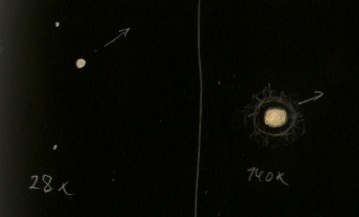
|
Robert Zebahl
Leipzig (Germany) |
152mm (43x) |
AC: 2022-04-12: Very wide and uneven pair. Component A shines in a bright, brilliant orange, companion C looks rather white. |
|
Robert Zebahl
Leipzig (Germany) |
152mm (200x) |
AB: 2022-04-12: At magnifications between 200x and 400x, there was nothing even close to a double star to be seen. The air was simply too turbulent. |
|
|
|
|
STF1516 & STT539 & HDS1603 |
STF1516 |
AB |
7m.8 |
8m.2 |
67.6" |
103° |
2017 |
Dra |
11h15m11.91s / +73°28'30.70" |
|
|
|
STT539 |
AC |
7m.8 |
11m.3 |
6.5" |
329° |
2017 |
|
|
|
|
|
STT539 |
BC |
8m.2 |
11m.3 |
72.2" |
287° |
2015 |
|
|
|
|
|
HDS1603 |
BD |
8m.2 |
10m.0 |
0.1" |
115° |
1991 |
|
|
|
|
Christopher Hay
Seeheim (Germany) |
15x45 |
STF1516 (AB): Handheld binoculars with internal stabilisation. Well separated. Quite evenly matched, visually strong pair. Western component slightly brighter and warmer. |
|
Sarah Gebauer
Germany |
100mm (49x) |
STF1516 (AB): 02.10.23: bei 21-fach ein recht schwaches, matt hellorangebraunes Pärchen - bei 49-fach ein sehr weit getrenntes Paar, recht dominant in der Bildmitte des ansonsten recht leeren Gesichtsfeldes - die östliche B-Komponente strahlt leicht in einem matten Orangebraun, die westliche A-Komponente warmweiß mit einem Hauch hellerem, kühlerem Orangebraun |
|
|
|
|
STF1520 |
|
|
6m.5 |
7m.8 |
12.4" |
344° |
2019 |
UMa |
11h16m04.03s / +52°46'23.40" |
Robert Zebahl
Leipzig (Germany) |
16x70 |
2022-03-27: Pretty view of the tightly separated components with a clear difference in brightness. A appears white, B on the other hand orange-brownish. |
|
René Merting
Drachhausen (Germany) |
18x70 |
ideal für 18x, ein schönes enges Sternpaar - Komponente B prangt nordöstlich von A ganz knapp getrennt und wirkt gut 1.5 Größenklassen schwächer - beide haben eine reinweiße Weste, was ungewöhnlich ist ob des großen Helligkeitsunterschiedes |
|
Robert Zebahl
Leipzig (Germany) |
70mm (44x) |
2020-04-08: At 22x pretty tight, uneven pair. A appeared orange, B did not show any clear color. At 44x, A appeared yellowish-orange, B silvery grey, partly grey-bluish. |
|
René Merting
Drachhausen (Germany) |
100mm (20x) |
bei 32x ein knapp getrenntes Pärchen, auffällig im Umfeld - Komponente B ist eine Größenklasse schwächer - zurück auf 20x noch schönerer Eindruck, beider Sterne können noch ganz knapp getrennt voneinander gesehen werden |
|
Mark McCarthy
Fremont (California/USA) |
178mm (205x) |
Wide 2 delta mag, light yellow A and a distinctly blue B. Physical |
|
|
|
★
|
STF1529 |
|
|
7m.1 |
7m.9 |
9.3" |
254° |
2017 |
Leo |
11h19m22.64s / -01°39'17.60" |
Robert Zebahl
Leipzig (Germany) |
16x70 |
2021-03-02: Very nice view, medium bright, very finely separated with little difference in brightness. However, the double star was too faint for detecting color. |
|
Axel Tute
Küssaberg (Germany) |
200mm (80x) |
17.03.2009: Single. B reddish. A slightly blue. |
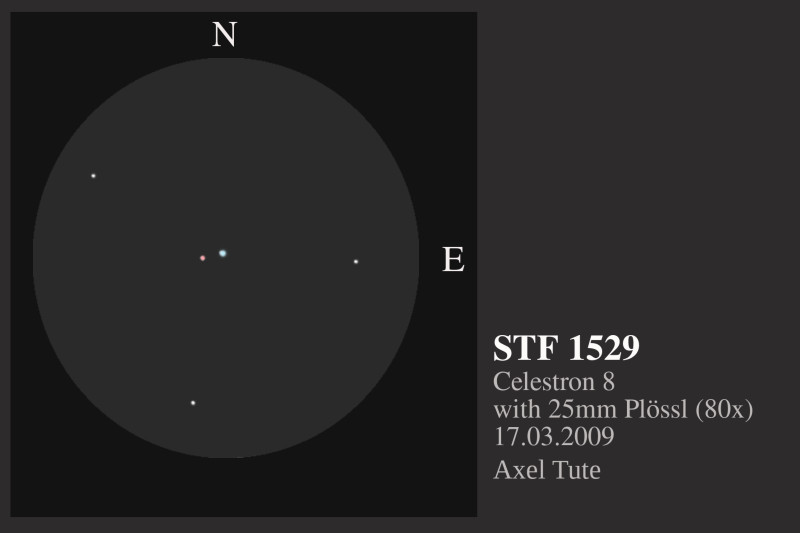
|
Mark McCarthy
Fremont (California/USA) |
508mm (205x) |
Easy bright yellow ~1 delta wide |
|
|
|
★★
|
81 Leo |
HJ4433 |
AB |
5m.6 |
10m.8 |
55.4" |
6° |
2018 |
Leo |
11h25m36.37s / +16°27'23.50" |
|
|
|
SHY224 |
AC |
5m.6 |
7m.2 |
999.9" |
207° |
1998 |
|
|
Christopher Hay
Seeheim (Germany) |
10x56 |
AC: Handheld. Components A and C, making up Shaya 224, are well framed in 6.3° FOV. Component A is cold blue.
Component C (= HIP 55262) is about three-and-a-half degrees south-southwest of component A (= 81 Leo) and is close to the Leo Triplet of galaxies. Two galaxies of the Triplet present themselves (sky quality: NELM 5m0 in target area), M66 is an elongated little nebula with its main axis pointing roughly towards C, while M65 is a faint but definite nebular presence with direct vision, closer to C than M66 is.
Shaya 224 is a physical double at a distance to us of 143 light years. |
|
René Merting
Drachhausen (Germany) |
100mm (64x) |
AB: bei 64x ploppt Komponente B weit getrennt nördlich von A auf, vorher war sie unsichtbar - B versteckt sich halb im Glanz von A - schönes Versteckspiel |
|
Mark McCarthy
Fremont (California/USA) |
317mm (170x) |
AB: bright orange-yellow A with a much fainter blue B, widely separated, a beautiful sight. |
|
René Merting
Drachhausen (Germany) |
320mm (45x) |
AB: bei 45x strahlt Komponente A gleißend hell und leicht gelblich - B zeigt sich gut abgesetzt ganz schwach im NO von A - kein echtes Doppelstern-Feeling - bei 72x verliert A ein wenig Farbe, B ist ein graues Pünktchen |
|
|
|
★★
|
STF1540, 83 Leo |
|
AB |
6m.5 |
7m.5 |
28.6" |
146° |
2019 |
Leo |
11h26m45.32s / +03°00'47.20" |
Stefan Loibl
Rosenheim (Germany) |
10x50 |
clearly split, little difference in magnitude |
|
Christopher Hay
Seeheim (Germany) |
10x56 |
On tripod. Neat split. Attractive 6.3° FOV with a sprinkling of several 5- to 7-mag stars to the south. Tau Leo widely split directly to southeast.
In 15x60 on tripod well split, component A slightly orange, forms a fine double-double with Tau Leo.
83 Leo is a physical double at a distance to us of only 58 light years. |
|
Robert Zebahl
Leipzig (Germany) |
16x70 |
2021-03-02: Splendid sight together with the double star tau Leo as well as 82 Leo. Beautiful star field. 83 Leo very nicely separated with moderate difference in brightness. Yellowish orange & slightly orange. |
|
René Merting
Drachhausen (Germany) |
18x70 |
ein ordentlich getrenntes und dennoch schön eng stehendes Pärchen - Komponente A ist leicht gelblich, Komponente B im SO ist eine dreiviertel Magnitude schwächer und grauweiß |
|
Robert Zebahl
Leipzig (Germany) |
55mm (16x) |
Wonderful double with slight color contrast in a very nice field. Together with tau Leo stunning view. Slightly unequal. A appeared white-yellowish, B rather grey-bluish. |
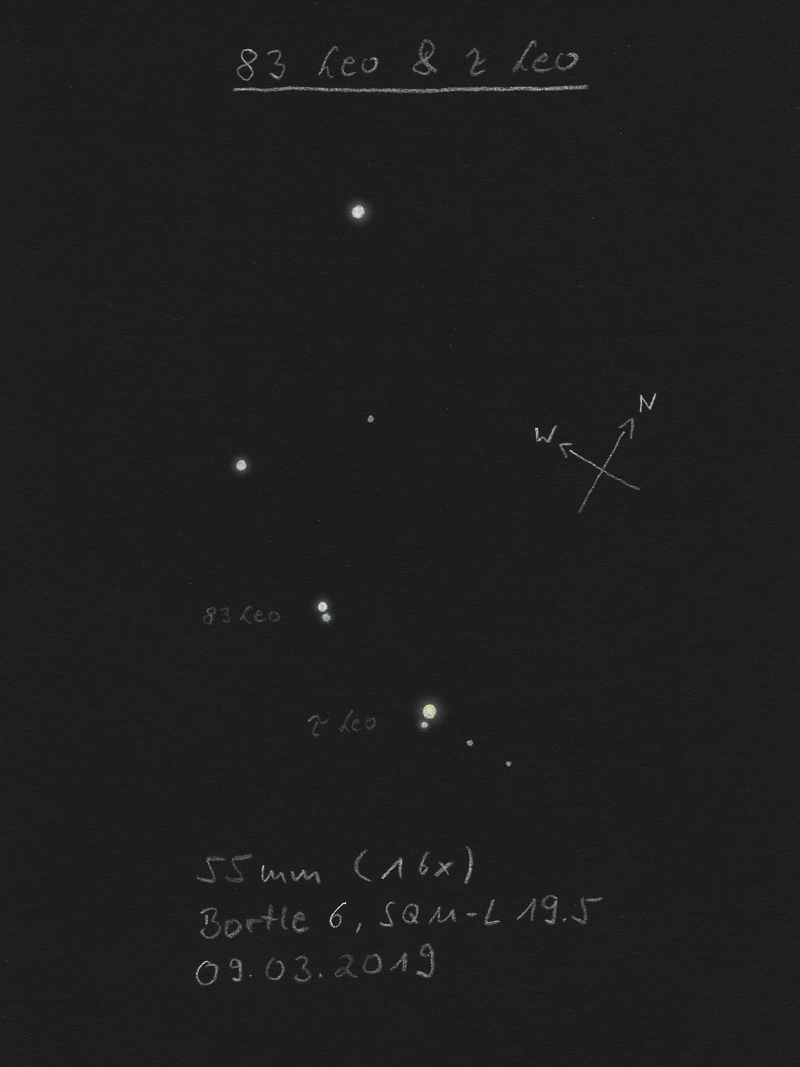
|
René Merting
Drachhausen (Germany) |
76mm (29x) |
Mondscheinnacht - bei 29x ein schönes Doppel-Doppel zusammen mit Tau Leo (STFA19) weiter östlich - beide Sterne von STF 1540 sind etwas mehr als ordentlich getrennt sichtbar - die B-Komponente im Südosten ist gut eine Größenklasse schwächer und wirkt grau gegen die warmweiß-gelblich strahlende A-Komponente, dadurch ein leichter Farbkontrast |
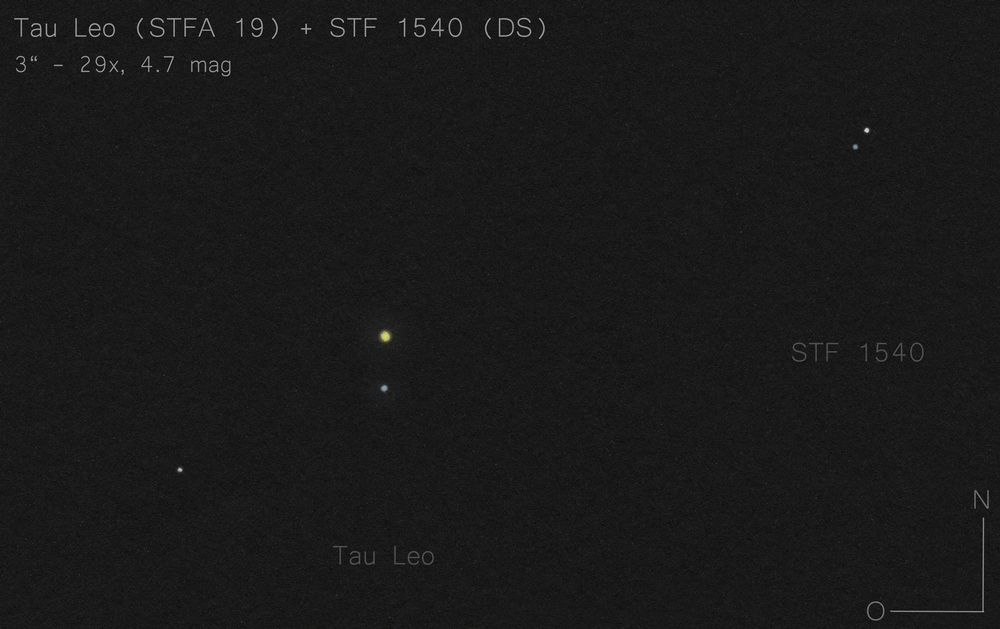
|
Mark McCarthy
Fremont (California/USA) |
80mm (13x) |
Finder split, in same field as Tau. |
|
Sarah Gebauer
Germany |
100mm (21x) |
bei 20-fach gut getrennt, ein wesentlich schwächeres, kleineres und engeres Paar als STFA 19 im selben GF - die nördliche Komponente strahlt warmgold, die südöstliche ähnlich, jedoch schwächer und matter |
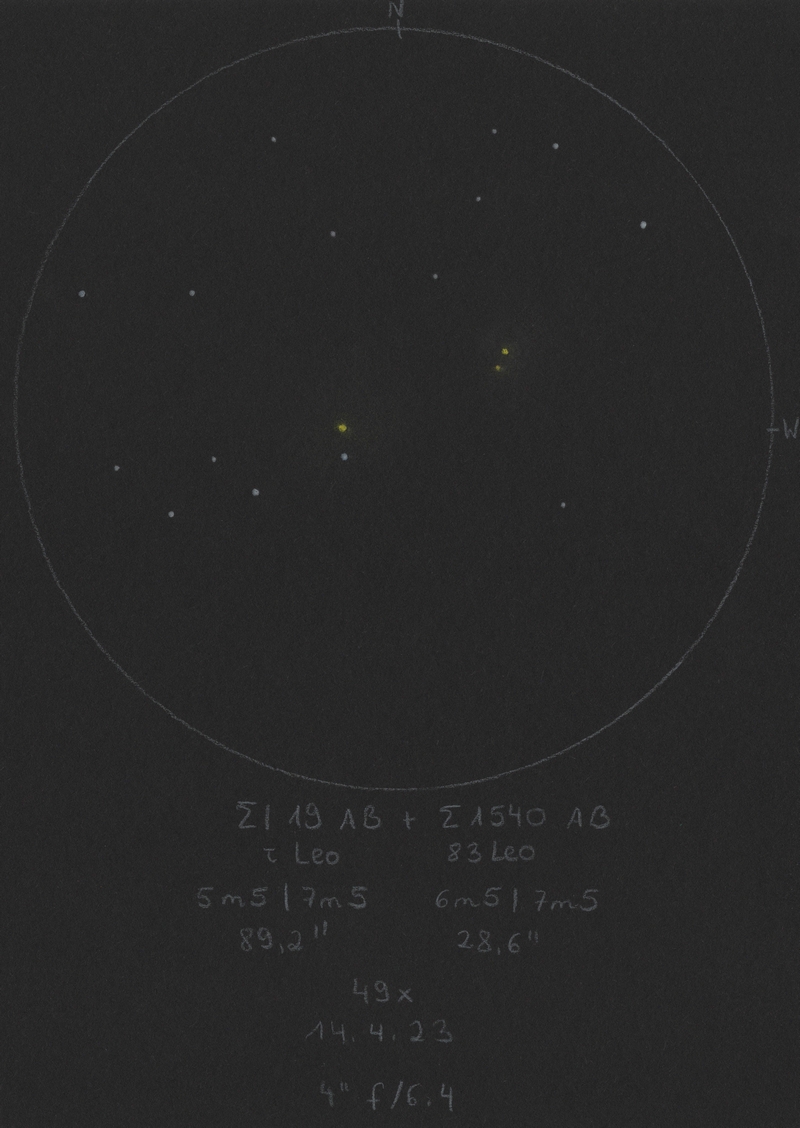
|
Mark McCarthy
Fremont (California/USA) |
178mm (205x) |
Light orange-yellow A and light blue B, >1 delta mag, very wide. Physical with 32,000-year period. Running this through the Plot Tool with EDR3 data, it confirms it is physical, only 18 parsecs / 58 light years away (which is why it has such a high proper motion) and 520 AU separation |
|
Mark McCarthy
Fremont (California/USA) |
317mm (340x) |
Yellow A and reddish B wide separation. |
|
René Merting
Drachhausen (Germany) |
320mm (72x) |
bei 72x steht das Paar zwar weit auseinander, es wirkt aber trotzdem gut zusammengehörend - Komponente B im SO ist eine dreiviertel Magnitude schwächer |
|
|
|
★★
|
STFA19, 84 Leo, tau Leo |
|
AB |
5m.0 |
7m.5 |
89.2" |
181° |
2019 |
Leo |
11h27m56.23s / +02°51'22.50" |
Christopher Hay
Seeheim (Germany) |
7x50 |
On tripod. Comfortably split. Component A is mildly orangish-yellow.
Can't quite eke out 83 Leo's secondary (NELM 5m0, elevation 40°). |
|
Christopher Hay
Seeheim (Germany) |
15x45 |
Binoculars with internal stabilisation, handheld. Wide pair. Component A dull golden-yellow, component B seems bluish. Attractive.
In 15x60 on tripod very wide. Component A very mild orange, B grey-blue. Fine sight in 3.3° FOV together with well-split 83 Leo. |
|
Robert Zebahl
Leipzig (Germany) |
16x70 |
2021-03-02: Splendid sight together with the double star 83 Leo as well as 82 Leo. Beautiful star field. Tau Leo beautifully separated with significant difference in brightness. Yellowish & bluish. |
|
Robert Zebahl
Leipzig (Germany) |
55mm (16x) |
Wonderful double with slight color contrast in a very nice field. Together with 83 Leo stunning view. Noticeable unequal. A appeared white-yellowish with a hint of orange, B grey-bluish. |

|
René Merting
Drachhausen (Germany) |
76mm (29x) |
Mondscheinnacht - bei 29x ein schönes Doppel-Doppel zusammen mit STF 1540 weiter westlich - Tau Leo ist komfortabel getrennt erkennbar - Komponente A strahlt Ampelgelb, Komponente B ist 2 Größenklassen schwächer und strahlt stahlgrau mit einem Stich ins Blaue |

|
Mark McCarthy
Fremont (California/USA) |
80mm (13x) |
Finder split, the A star is prismatic in color effects, bluish B |
|
Sarah Gebauer
Germany |
100mm (21x) |
bei 20-fach zeigt die nördliche A-Komponente einen schön warmgoldenen Farbton, die südliche B-Komponente dagegen erscheint deutlich schwächer und in einem kühlen Grau mit einem Hauch von Blau - ein schöner Farbkontrast und zudem mit STF 1540 zusammen in einem GF |

|
Mark McCarthy
Fremont (California/USA) |
317mm (340x) |
Bright yellow A, bluish B, very widely separated |
|
|
|
|
STF1565 |
|
|
7m.3 |
8m.4 |
22.2" |
304° |
2017 |
Leo |
11h39m36.50s / +18°59'48.30" |
Christopher Hay
Seeheim (Germany) |
15x60 |
Well split. Primary warmer in tone, secondary colder. No visual competition whatsoever in 3.3° FOV, making the delicate pair rather charming.
A physical double at the substantial distance to us of 2175 light years. |
|
Robert Zebahl
Leipzig (Germany) |
16x70 |
2021-03-02: Moderately bright, clear difference in brightness, attractive separation, striking. The primary component shines in a beautiful yellow with a touch of orange, the tiny companion just greyish. |
|
Robert Zebahl
Leipzig (Germany) |
70mm (22x) |
2021-04-21: At 22x very nicely separated with moderate difference in brightness. White-yellowish & grey-blue. At 44x similar color impression: slightly yellowish & slightly bluish. |
|
Sarah Gebauer
Germany |
100mm (45x) |
weit und deutlich getrennt, die westliche Komponente minimal schwächer als die östliche zu sehen |
|
Uwe Pilz
Leipzig (Germany) |
105mm (21x) |
gelb und rot |

|
|
|
★
|
STF1575 |
|
|
7m.4 |
7m.9 |
30.5" |
210° |
2021 |
Vir |
11h51m57.57s / +08°49'48.00" |
Robert Zebahl
Leipzig (Germany) |
16x70 |
2021-03-02: Very nice view! Very striking in the field together with xi Vir, 4 & 6 Vir. Fairly bright with moderate separation. Slightly orange & grey-bluish. |
|
René Merting
Drachhausen (Germany) |
18x70 |
ein sehr komfortabel getrenntes Sternpaar - B im Südwesten ist eine halbe Größenklasse schwächer - A weißorange, B weißbläulich - ein ansehnlicher FG-Stern |
|
René Merting
Drachhausen (Germany) |
100mm (32x) |
bei 32x ein schön getrenntes Sternpaar mit zwei ähnlich hellen Sternen - Komponente B im SW ist maximal eine halbe Größenklasse schwächer - deutlich wahrnehmbarer Farbkontrast, A ist weißgelb, B dagegen wirkt blaugrau |
|
Sarah Gebauer
Germany |
100mm (49x) |
schon bei 20-fach getrennt als zwei dünne Lichtpünktchen zu sehen - die nordöstliche A-Komponente hat einen warmorange Farbton, der südwestliche wirkt etwas farbloser, schwächer und matter - bei 49-fach ordentlich getrennt, A strahlt nun etwas intensiver orangegold, B wirkt nun bräunlich |
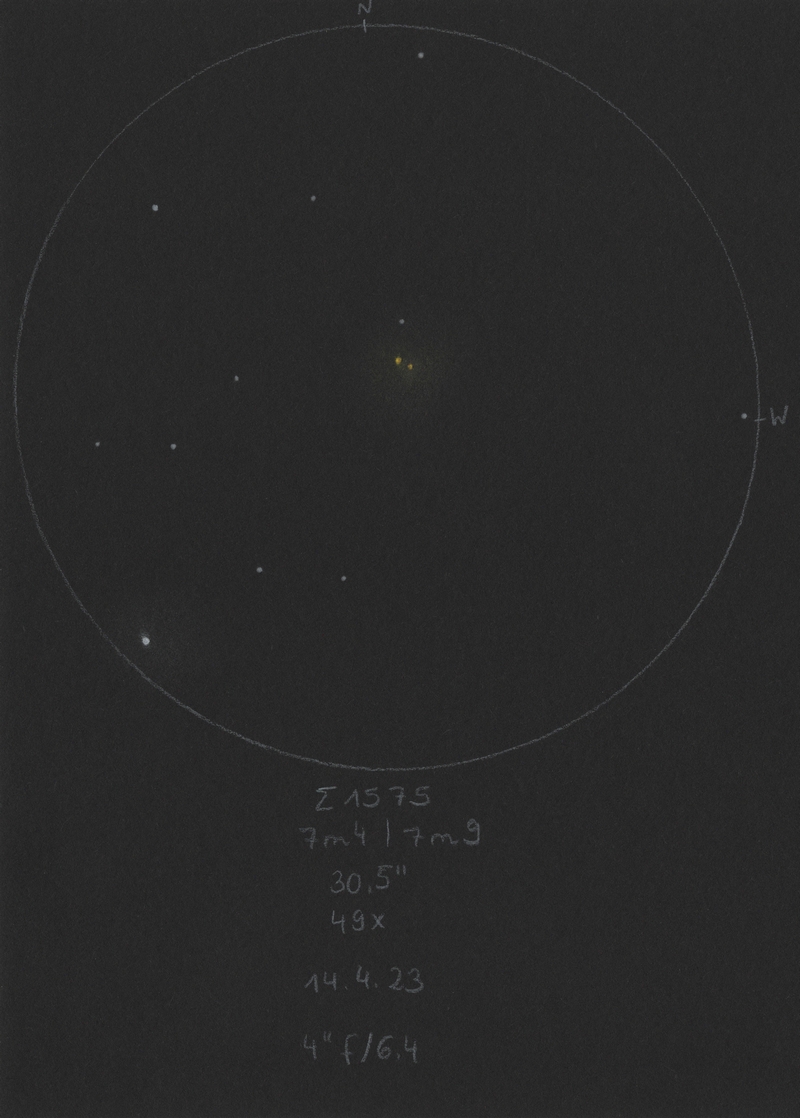
|
René Merting
Drachhausen (Germany) |
320mm (72x) |
bei 72x zwei gleichhelle Sterne, die weit getrennt auseinander stehen - A im NO ist leicht gelblich, B mit einem leichten Schlag ins Blaue, sprich weißblau - dadurch zarter Farbkontrast - beide Sterne sind schön hell und auffällig im Umfeld |
|
|
Berthold Fuchs
Wiesbaden (Germany) |
130mm |
easy DS |
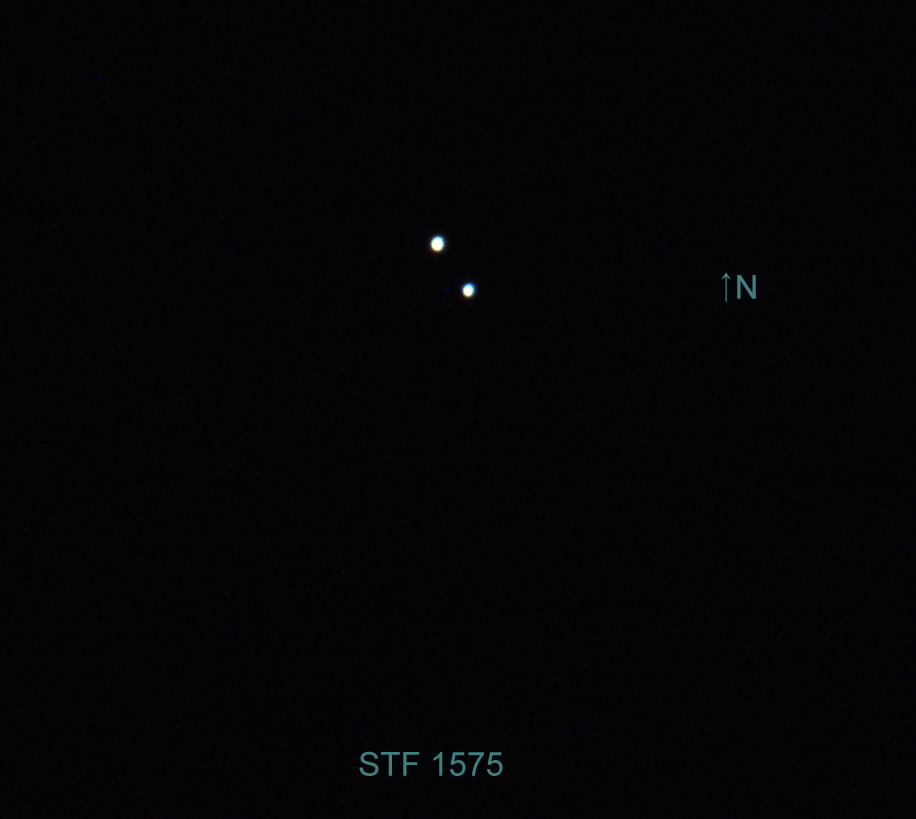
|
|
|
★
|
STTA112 |
|
AB |
8m.3 |
8m.5 |
73.4" |
36° |
2017 |
Leo |
11h54m32.07s / +19°24'40.40" |
Christopher Hay
Seeheim (Germany) |
7x45 |
Handheld. In good moments well separated, two fine pinpricks of light. Hard to maintain split at 7x handheld under my 5m0 NELM sky. On tripod or under a slightly better sky probably a pleasant matched pair.
A physical double at a distance to us of 132 light years. |
|
Christopher Hay
Seeheim (Germany) |
15x60 |
Wide, very evenly matched pair, dominates the 3.3° FOV. Primary seems more orange than the secondary, but this is uncertain. |
|
|
|
★
|
STF1579, 65 UMa |
|
AB-C |
6m.7 |
8m.3 |
3.7" |
44° |
2021 |
UMa |
11h55m05.74s / +46°28'36.60" |
|
|
|
|
AB-D |
6m.7 |
7m.0 |
62.9" |
114° |
2021 |
|
|
Christopher Hay
Seeheim (Germany) |
7x45 |
AB-D: Handheld. A bit difficult due to hand tremor, but clearly split with definite delta-mag. Nice in 8.6° FOV together with 67 UMa (Forgeren), which for its part has a bluish companion at a separation of about 300".
With 15x45 stabilised binoculars AB-D is an easy wide split, AB warmer, D colder in hue.
A physical pair at a distance to us of 691 light years. |
|
Robert Zebahl
Leipzig (Germany) |
8x40 |
AB-D: 2020-04-05: Immediately conspicuous in the field. Medium bright double star with slightly uneven components. Western component AB appeared slightly orange, component D tended to be bluish. |
|
Robert Zebahl
Leipzig (Germany) |
55mm (27x) |
AB-D: Easy to separate with large distance and very small difference in brightness. The D component showed a bluish tint, the lighter one (AB) a slightly yellowish tint. At higher magnification also the faint C component is visible. |
|
Robert Zebahl
Leipzig (Germany) |
55mm (83x) |
2019-02-09: AB, C & D easy to split, but the faint C component only appeared as a tiny star. To the south there is the brighter D component. |
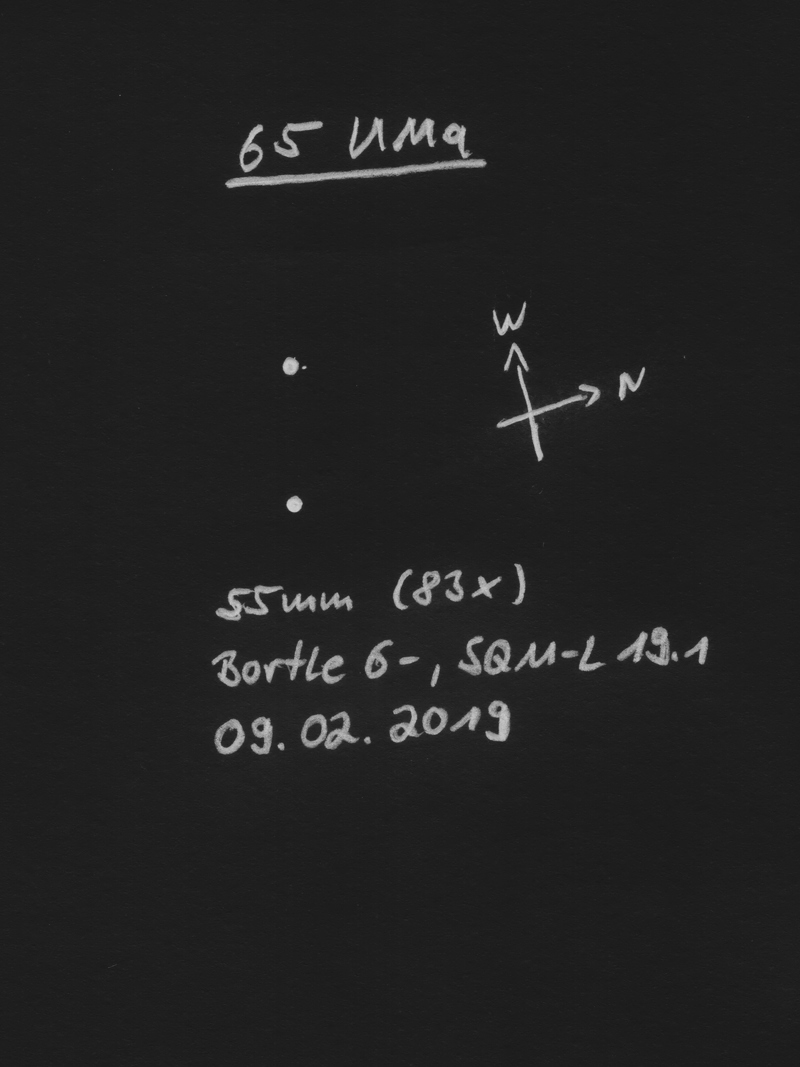
|
|
Robert Zebahl
Leipzig (Germany) |
|
|
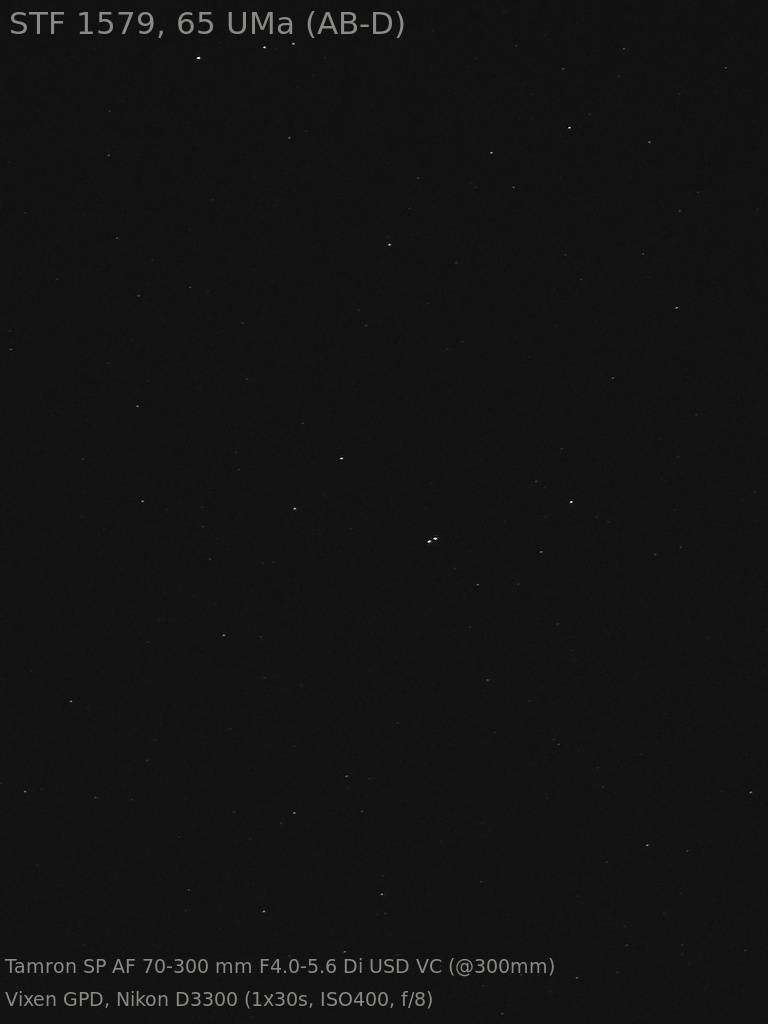
|
|
|
|
STTA116 |
|
AB |
7m.8 |
8m.5 |
73.2" |
177° |
2018 |
Vir |
12h01m56.96s / +00°06'07.50" |
Robert Zebahl
Leipzig (Germany) |
16x70 |
2021-03-02: Bright, very easy and striking. The components appear almost equally bright, with the northern one slightly warmer in color. To the south is the fainter double star STF 1591. |
|
|
|
★
|
STF1603 |
|
AB |
7m.8 |
8m.3 |
22.2" |
83° |
2021 |
UMa |
12h08m07.07s / +55°27'50.70" |
Robert Zebahl
Leipzig (Germany) |
16x70 |
2022-03-27: Medium bright at moderate separation and slight difference in brightness. Slight color difference: yellowish & slightly bluish. |
|
René Merting
Drachhausen (Germany) |
18x70 |
ein Sternpaar, das zu gefallen weiß, etwas mehr als knapp getrennt - B im Nordosten wirkt eine viertel Größenklasse schwächer - leichter Farbunterschied, wobei B Zartorange, Braunweiß, Ockergrau oder so wirkt, naja |
|
Robert Zebahl
Leipzig (Germany) |
70mm (22x) |
2020-04-07: At 22x quite apparent double star in rather poor surrounding. Nice separation with little difference in brightness. Primary component appeared slightly orange, companion grey-bluish. At 44x similar view in color appearance. |
|
Sarah Gebauer
Germany |
100mm (45x) |
schwach, sauber getrennt, nahezu gleich hell, die westliche Komponente ist minimal heller |
|
René Merting
Drachhausen (Germany) |
320mm (45x) |
bei 45x gut getrennt - Komponente B im Osten wirkt grauorange gegen die weiß strahlende Komponente A - Helligkeitsunterschied eine halbe Größenklasse - ein schön isoliert stehendes Sternpaar |
|
|
|
|
STF1615 |
|
AB |
7m.0 |
8m.6 |
26.8" |
88° |
2019 |
Com |
12h14m06.61s / +32°47'03.20" |
René Merting
Drachhausen (Germany) |
18x70 |
ein schickes enges ungleiches Pärchen - Komponente B steht nicht zu knapp getrennt von A im Osten - Helligkeitsunterschied etwa zwei Größenklassen - Komponente strahlt Warmweiß, B Grauweiß |
|
Mark McCarthy
Fremont (California/USA) |
178mm (205x) |
Very light orange A and very much fainter B which appears with averted vision and I can then just hold it direct, well separated. Physical |
|
|
|
★★
|
STF1636, 17 Vir |
|
|
6m.5 |
9m.3 |
21.0" |
338° |
2017 |
Vir |
12h22m32.14s / +05°18'20.10" |
René Merting
Drachhausen (Germany) |
15x56 |
meist klebt B noch nordwestlich an A, in ruhigen Momenten kann ich beide Komponenten knapp getrennt erkennen - B ist eine Miniperle ggü. A |
|
René Merting
Drachhausen (Germany) |
18x70 |
A und B sind knapp getrennt erkennbar - B sitzt im NW von A - großer, nicht abschätzbarer Helligkeitsunterschied - nett anzusehen, wenn man B erst einmal entdeckt hat |
|
Sarah Gebauer
Germany |
100mm (21x) |
bei 20-fach ganz knapp getrennt mit einem deutlichen Helligkeitsunterschied - für einen Farbeindruck reicht die Vergrößerung nicht aus - bei 49-fach färbt sich die Hauptkomponente sehr schön roségold - der deutlich schwächere Begleiter wirkt nun grau-bräunlich - das Sternumfeld ist dank lose verstreuter Sterne in einem großen Bogen von Norden über Osten nach Süden um den Doppelstern herum besonders schön |
|
Mark McCarthy
Fremont (California/USA) |
317mm (340x) |
17 Virginis, widely separated, large magnitude difference, with a yellow-white A and a ruddy / brownish B |
|
|
Berthold Fuchs
Wiesbaden (Germany) |
130mm |
easy DS |
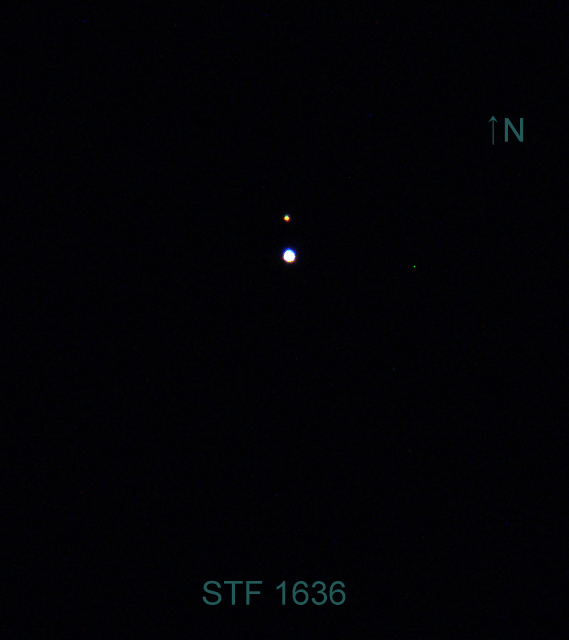
|
|
|
★★
|
STFA21, 17 Com, AI Com |
|
AB |
5m.2 |
6m.6 |
146.4" |
251° |
2018 |
Com |
12h28m54.72s / +25°54'46.40" |
Christopher Hay
Seeheim (Germany) |
7x45 |
Handheld. Well split, strong compact pair. Component A seems bluish, B warmer. At this low power 17 Com is the most double-starish pair in Melotte 111, the Coma Star Cluster. Fantastic star-strewn 8.6° FOV with the stars of the cluster.
A physical double at a distance to us of 238 light years. |
|
René Merting
Drachhausen (Germany) |
8x25 |
ein helles, weit getrenntes Sternpaar - Komponente B im Westen ist halb so hell und wirkt grau |
|
René Merting
Drachhausen (Germany) |
320mm (72x) |
bei 72x ein weit auseinander stehendes Paar - schöner Farbkontrast, A weißblau, B im SW leicht gelblich schimmernd |
|
|
|
★★★
|
SHJ146 |
|
AB |
7m.7 |
8m.7 |
49.5" |
290° |
2017 |
Vir |
12h31m14.61s / +01°19'37.00" |
René Merting
Drachhausen (Germany) |
15x56 |
beide Sterne zeigen sich mit ordentlich Abstand - Komponente A im Osten ist weiß und B ist gut 1.5 Magnituden schwächer und kommt über den graue Maus-Status nicht hinaus |
|
René Merting
Drachhausen (Germany) |
18x70 |
Komponente B ist westlich von A erkennbar - Helligkeitsunterschied 1.5 Magnituden - A weiß, B grau - das Sternpaar fällt auf, weil kaum gleichhelle Sterne in der Umgebung stehen |
|
Robert Zebahl
Leipzig (Germany) |
70mm (33x) |
Visible difference in brightness and color. I couldn't precisely define the colors itself, but A appeared rather orange, B rather bluish. |
|
Robert Zebahl
Leipzig (Germany) |
102mm (28x) |
Pretty wide pair with visible difference in brightness and lovely color contrast. A: pale orange, B: light blue. |
|
|
|
|
STF1649 |
|
|
8m.0 |
8m.4 |
15.7" |
194° |
2020 |
Vir |
12h31m36.46s / -11°04'20.20" |
René Merting
Drachhausen (Germany) |
18x70 |
ein sehr enges, helles Pärchen - Komponente B im Süden knapp getrennt und minimal schwächer - sehenswert, da kaum gleichhelle Sterne im Umfeld sichtbar sind |
|
|
|
|
HJL1070 |
|
|
8m.2 |
8m.2 |
240.3" |
79° |
2015 |
CVn |
12h34m59.37s / +36°19'30.90" |
Christopher Hay
Seeheim (Germany) |
15x45 |
Handheld, binoculars with internal stabilisation. Extremely wide, evenly matched. Would not normally look like a double at this power but is held together visually by the Upgren 1 asterism, of which it is a member.
A common proper motion pair. HJL = Halbwachs, J.L. |
|
|
|
★★
|
STF1657, 24 Com |
|
AB |
5m.1 |
6m.3 |
20.2" |
272° |
2018 |
Com |
12h35m07.76s / +18°22'37.40" |
Christopher Hay
Seeheim (Germany) |
15x45 |
Binoculars with internal stabilisation, handheld. Clean split. Strong pair dominating 4.5° FOV. Primary pale yellow. Secondary too close for clear colour impression but certainly colder.
A physical double at a distance to us of 450 light years. |
|
René Merting
Drachhausen (Germany) |
18x70 |
ein wunderschönes eng stehendes FG-Sternpaar - Komponente B im Westen ist 1.5 Magnituden schwächer - A strahlt weißgelb, B wirkt dagegen etwas unterkühlt |
|
Robert Zebahl
Leipzig (Germany) |
70mm (22x) |
2020-04-04: Splendid sight! Very nice difference in brightness and color: pale orange & grey-blue. |
|
Mark McCarthy
Fremont (California/USA) |
80mm (94x) |
24 Com. Lovely bright orange A and blue B, wide. Very deserving of its showcase reputation |
|
Robert Zebahl
Leipzig (Germany) |
102mm (28x) |
Very beautiful view with moderate distance and difference in brightness. A: glossy, light orange, B: white- bluish. |
|
Christopher Hay
Seeheim (Germany) |
125mm (64x) |
Well apart. Hugely dominant in 1.3° FOV. Primary slightly orangish yellow, secondary ice blue, extremely attractive. |
|
Robert Zebahl
Leipzig (Germany) |
200mm (60x) |
Well split with obvious difference in brightness. Fainter component appeared bluish, the brighter one slightly orange. |
|
Mark McCarthy
Fremont (California/USA) |
203mm (205x) |
Very pretty bright light orange and fainter blue, wide separation. Such a sight! |
|
|
|
|
STF1664 |
|
AB |
7m.8 |
9m.2 |
38.7" |
223° |
2019 |
Vir |
12h38m19.95s / -11°31'01.10" |
|
|
|
|
AC |
7m.8 |
11m.5 |
60.7" |
306° |
2019 |
|
|
|
|
|
|
AD |
7m.8 |
12m.4 |
83.8" |
291° |
2019 |
|
|
|
|
|
|
AE |
7m.8 |
8m.6 |
121.4" |
110° |
2019 |
|
|
|
|
|
|
BC |
9m.2 |
11m.5 |
68.1" |
341° |
2019 |
|
|
|
|
|
|
BD |
9m.2 |
12m.4 |
77.9" |
318° |
2019 |
|
|
|
|
|
|
CD |
11m.5 |
12m.4 |
30.0" |
258° |
2019 |
|
|
|
|
|
|
EF |
8m.6 |
8m.9 |
92.7" |
112° |
2019 |
|
|
René Merting
Drachhausen (Germany) |
18x70 |
AB: ein ordentlich getrenntes Pärchen - B im Südwesten ist gut eine Größenklasse schwächer - A zeigt ein wenig Farbe, weißgelblich |
|
|
|
|
STF1678 |
|
|
7m.2 |
7m.7 |
37.5" |
170° |
2018 |
Com |
12h45m26.17s / +14°22'24.90" |
Robert Zebahl
Leipzig (Germany) |
8x40 |
2020-04-05: Clearly separated, but still quite close together with a fainter companion. Well visible difference in brightness without any detectable colors. |
|
René Merting
Drachhausen (Germany) |
18x70 |
ein schönes helles Sternpaar, komfortabel getrennt - Komponente B im Süden ist nur minimal schwächer als A |
|
Robert Zebahl
Leipzig (Germany) |
70mm (22x) |
2020-04-04: At 22x noticeable double star with slight difference in brightness. Primary component appeared white-yellowish, companion appeared slightly orange. The color impression was a little better visible at 44x. |
|
Mark McCarthy
Fremont (California/USA) |
317mm (443x) |
Wide separation near equal white pair |
|
|
|
★★★
|
STF1694 |
|
AB |
5m.3 |
5m.7 |
21.8" |
324° |
2017 |
Cam |
12h49m13.80s / +83°24'46.30" |
Christopher Hay
Seeheim (Germany) |
7x45 |
Handheld. Very elongated with absolutely clear PA, but hand tremor prevents separation. |
|
Christopher Hay
Seeheim (Germany) |
7x50 |
On tripod. Split with a sliver of black inbetween, with creamy-white components, attractive sight. Dry-frozen night in January, 47° elevation above horizon. |
|
Christopher Hay
Seeheim (Germany) |
10x42 |
Binoculars with internal stabilisation, handheld. Fine split with definite difference in brightness of components. |
|
Christopher Hay
Seeheim (Germany) |
15x45 |
Binoculars with internal stabilisation, handheld. AB cleanly split with distinct difference in magnitudes. Strong visual presence of this physical double is enhanced by the complete lack of visual competition in 4.5° FOV. Interesting to contemplate that in the 9th century AD Struve 1694 was just as close to the celestial north pole as Polaris (also a physical double) is today. Also known as 32H Cam, which comes from the celestial map produced by Johannes Hevelius in the late 17th century. |
|
Christopher Hay
Seeheim (Germany) |
25x80 |
Well apart but by no means falling apart, and totally dominating the 3.2° field of view. Neither component would appear particularly colourful on its own, but viewed together the primary is definitely more on the orange side and the secondary more bluish.
At 25x in 3.2° FOV and with an exit pupil around 3mm making the sky background pitch-black, STF 1694 has such a strong visual impact that it becomes a showpiece specimen of a double star. Three-star rating awarded because of this strong visual presence plus binocular accessibility (see 7x50 observation) plus true physical nature of the double (according to Stelledoppie) plus pole-star role in the Middle Ages. |
|
Christopher Hay
Seeheim (Germany) |
36mm (8x) |
Split clearly, so clearly that I stumble across the pair while panning through the area. Primary seems yellowish, an impression confirmed by observation directly afterwards with 71mm refractor at 32x, in which the primary is distinctly yellowish and the pair visually very strong. |
|
Robert Zebahl
Leipzig (Germany) |
70mm (15x) |
2017-12-21: Easy to split with noticeable angular distance and slight difference in brightness. The faint component tends to be more bluish, the brighter one appeared more light yellowish. |
|
René Merting
Drachhausen (Germany) |
100mm (32x) |
bei 32x strahlen beide Komponenten richtig hell und gut getrennt - leichter Farbkontrast, Komponente A ist leicht gelblich, B wirkt eher unterkühlt |
|
Robert Zebahl
Leipzig (Germany) |
152mm (30x) |
2022-10-25: Easily separable, bright and very dominant in the field. The difference in brightness is small. Due to the brightness, both components shine in brilliant colors: light yellow & white-bluish. |
|
|
|
★
|
STF1685 |
|
AB |
7m.3 |
7m.8 |
16.0" |
202° |
2018 |
Com |
12h51m54.80s / +19°10'19.90" |
René Merting
Drachhausen (Germany) |
18x70 |
ein schicker FG-Doppelstern - ein enges Paar mit der leicht schwächeren Komponente B im Süden - schwacher Farbkontrast, der wieder mal zwischen den Sternen hin und her zu springen scheint |
|
Robert Zebahl
Leipzig (Germany) |
70mm (22x) |
2020-04-04: Lovely sight! Beautifully separated with little difference in brightness. Together with two other brighter stars the double star forms an almost right-angled triangle. At 44x the primary component appears in pale orange, the companion rather grey-bluish. |
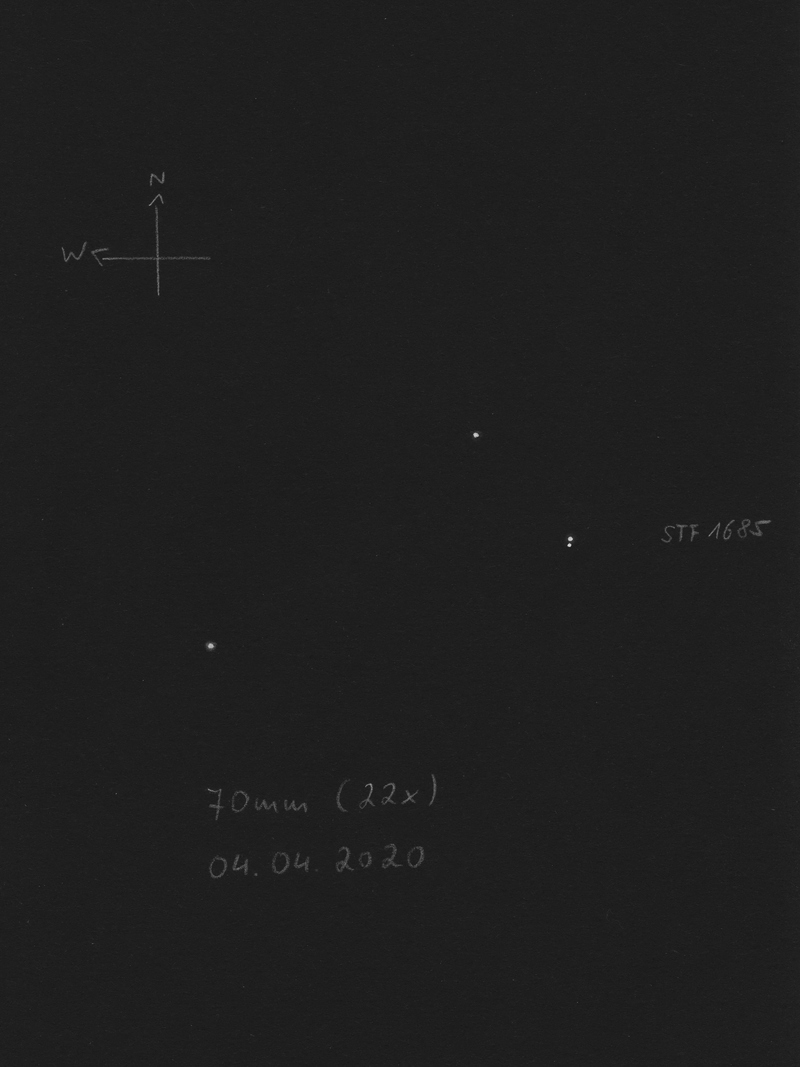
|
Christopher Hay
Seeheim (Germany) |
125mm (64x) |
Wide split. Component A bluish, B warmer. Well-matched pair.
A physical double at a distance to us of 722 light years. |
|
Mark McCarthy
Fremont (California/USA) |
317mm (553x) |
Brighter white A, 0.5 delta mag B, pretty wide separation. |
|
|
|
★
|
STFA23, 32 Com |
|
AB |
6m.5 |
7m.0 |
196.3" |
51° |
2015 |
Com |
12h52m12.26s / +17°04'26.20" |
|
|
|
|
AC |
6m.5 |
8m.9 |
905.4" |
262° |
2015 |
|
|
Christopher Hay
Seeheim (Germany) |
7x45 |
AB: Wide compact pair. Component A (=32 Com) is brighter than component B (=33 Com) and orangish.
Nice in 8.6° FOV together with globular cluster M53, which presents as a fluffy little ball. 2° north of 32/33 Com is an interesting 2° long east-west oriented clustering of stars, and 1° north of M53 is a similar, brighter and more compact clustering. Overall an extremely attractive field. |
|
René Merting
Drachhausen (Germany) |
8x25 |
AB: ein weit auseinander stehendes Pärchen - Komponente B im Nordosten ist halbe Größenklasse schwächer - A wirkt auf den ersten Blick farbig, gelblich, je länger ich schaue, desto farbloser wird er aber - B dagegen ist grauweiß |
|
Robert Zebahl
Leipzig (Germany) |
8x40 |
AB: 2020-04-05: Widely separated pair. The component A (32 Com) appeared slightly orange, the component B rather grey-bluish. Overall a beautiful sight. The double star is located right in the middle between the two bright stars 27 & 36 Com. |
|
Christopher Hay
Seeheim (Germany) |
15x45 |
AB: Striking pair, very wide but holding together well thanks to matched brightnesses. Component A (=32 Com) more orangish, component B (=33 Com) more bluish. |
|
René Merting
Drachhausen (Germany) |
18x70 |
AB: zwei helle Sterne mit riesigem Abstand - die B-Komponente im Nordosten ist eine viertel bis halbe Größenklasse schwächer - A wirkt leicht gelblich, B dagegen ist mehr unterkühlt weiß |
|
|
|
|
STF1689 |
|
|
7m.1 |
9m.1 |
30.2" |
223° |
2015 |
Vir |
12h55m30.32s / +11°29'46.40" |
René Merting
Drachhausen (Germany) |
15x56 |
Komponente B ist knapp getrennt südwestlich von A erkennbar - während die Hauptkomponente weißgelb strahlt, zeigt B sich ohne Farbe |
|
René Merting
Drachhausen (Germany) |
18x70 |
ein sehr ungleiches Paar - Komponente A ist der hellste Stern in der Umgebung, B ist sehr schwach und steht ordentlich abgesetzt im Südwesten von A - Helligkeitsunterschied 2.5 Magnituden |
|
Mark McCarthy
Fremont (California/USA) |
317mm (443x) |
Orange and blue, very wide separation |
|
|
|
★
|
STFA24 |
|
AB |
6m.0 |
6m.3 |
275.6" |
296° |
2012 |
CVn |
13h10m03.27s / +38°29'55.90" |
|
|
Robert Zebahl
Leipzig (Germany) |
8x40 |
Both components similar in brightness with large distance. |
|
Christopher Hay
Seeheim (Germany) |
15x45 |
Already clearly split in 3x opera glass. In 15x45 the pair becomes interesting due to clear colour contrast, 17 CVn orangish, 15 CVn much colder, almost bluish.
Charming in 4.5° FOV together with asterism two degrees northeast made up of 19/20/23 CVn plus an unnamed fourth bright star to the southwest of those three. |
|
Mark McCarthy
Fremont (California/USA) |
317mm (277x) |
Wide bright pair |
|
René Merting
Drachhausen (Germany) |
320mm (45x) |
extrem weit getrennt, ein auffälliges Trio zusammen mit 16 CVn nördlich - eher etwas für Kleinst-Ferngläser |
|
|
|
★★
|
BGH46 |
|
AB |
6m.5 |
7m.6 |
202.9" |
58° |
2015 |
Com |
13h16m32.26s / +19°47'07.00" |
Christopher Hay
Seeheim (Germany) |
7x45 |
Handheld. Well apart. Nice in 8.6° FOV with very similar, slightly wider and brighter 1 Boo six degrees due east.
BGH = S. van den Bergh. BGH46 is a physical double at a distance to us of 279 light years. |
|
Robert Zebahl
Leipzig (Germany) |
8x40 |
2020-04-05: Widely separated with well visible difference in brightness. A appeared slightly white-bluish, B darker in color and not clearly definable. |
|
Christopher Hay
Seeheim (Germany) |
15x45 |
Wide apart. Would probably no longer feel like a pair in a crowded Milky Way field, but here, not all too far from the North Galactic Pole, the two components hold together well (and are indeed a physical pair).
Very attractive 4.5° FOV to south with east-west string of stars followed by fluffy ball of globular M53 and finally brilliant Alpha Com. |
|
Mark McCarthy
Fremont (California/USA) |
80mm (13x) |
Wide finder split, 1 delta mag, not much to recommend. Triangle of stars to the south, pointing to Bgh 46. [I did look at this at 667x to see if one of the wide pair had a pair of its own, but did not scrutinize well enough. This one should try on a really good night with 20": HDS1862 = Aa,Ab 6.56/9.69 0.4".] |
|
Mark McCarthy
Fremont (California/USA) |
178mm (205x) |
Super-wide pair even in the finder, and I am very surprised to see it is listed as physical, at least as proper motion is concerned. The close pair HDS1862Aa-Ab I thought I saw but it is too fleeting, seeing not supporting higher magnification. Reviewing the Gaia DR3 data, which includes parallax, it confirms there is overlap in the weighted distance but the weighted separation of the pair is 19,121 AU, which means this is very likely not a physical pair |
|
|
|
|
STF1740 |
|
|
7m.1 |
7m.4 |
25.6" |
75° |
2018 |
Vir |
13h23m39.16s / +02°43'24.00" |
Stefan Loibl
Rosenheim (Germany) |
10x50 |
close double star for binoculars, clearly split, component A slightly reddish |
|
René Merting
Drachhausen (Germany) |
15x56 |
sehr schön anzusehen, ein helles Sternpaar, mehr als knapp getrennt - Komponente B im Osten ist eine viertel Magnitude schwächer |
|
René Merting
Drachhausen (Germany) |
18x70 |
ein auffälliges, schön eng zusammen stehendes Sternpaar - Komponente B im Osten ist nur knapp schwächer |
|
Robert Zebahl
Leipzig (Germany) |
70mm (33x) |
Easy to separate, slightly unequal with moderate angular distance. A: pale orange, B: color not clearly perceptible. |
|
Uwe Pilz
Leipzig (Germany) |
105mm (88x) |
gelb und orange, der westliche ist einen Hauch heller. Schon auffallend bei 2x, sehr schön bei 88x |

|
Mark McCarthy
Fremont (California/USA) |
203mm (333x) |
hair split equal white pair. Suspected elongation at 205x but needed 333x to split. 667x too much power given the conditions. |
|
|
Berthold Fuchs
Wiesbaden (Germany) |
130mm |
easy DS |
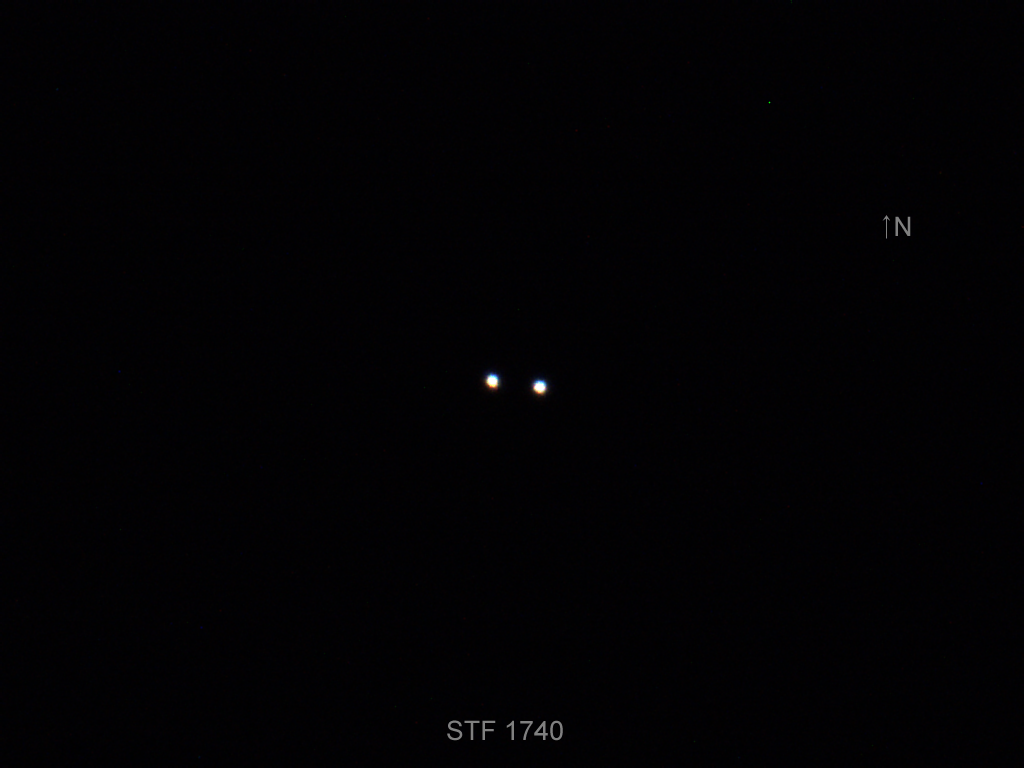
|
|
|
★★
|
STF1744 & SMR4, zeta UMa |
STF1744, 79 UMa, Mizar |
AB |
2m.2 |
3m.9 |
14.7" |
154° |
2020 |
UMa |
13h23m55.42s / +54°55'31.50" |
|
|
|
STF1744, Mizar & Alcor |
AC |
2m.2 |
4m.0 |
715.5" |
73° |
2020 |
|
|
|
|
|
SMR4 |
AD |
2m.2 |
7m.6 |
498.1" |
103° |
2020 |
|
|
René Merting
Drachhausen (Germany) |
naked eye |
AC: perfekte Bedingungen: der Doppelstern steht im Zenit, gute Transparenz … und siehe da, das kleine Reiterlein Komponente C ist zu erkennen, ach was sage ich, leicht zu erkennen - C ist deutlich schwächer, Trennung mehr als knapp - heute so einfach, wie oft bin ich im Vorfeld gescheitert mit bloßem Auge |
|
Christopher Hay
Seeheim (Germany) |
naked eye |
AC: Mizar/Alcor: After seeing the two stars separated for the first time under clear corona skies in spring 2020, this became a regular and easy sighting. Naked-eye star splitting is a skill that develops rapidly with practice. Mizar and Alcor are wide apart with my 60-year-old eyes, and occasionally Alcor appears slightly bluish. |
|
Christopher Hay
Seeheim (Germany) |
7x50 |
On tripod. Mizar (AB) is an uneven figure-8, the smaller circle of the 8 pointing to an estimated PA of 150°. Without knowing that this is a double star one might think the binoculars have collimation issues, but Epsilon UMa displays a perfect little Airy disk.
Alcor (C) appears bluish, Mizar creamy-white.
D seems reddish. |
|
René Merting
Drachhausen (Germany) |
8x25 |
AC: ein weit getrenntes Pärchen - Helligkeitsunterschied 1.5 Magnituden\AD: Komponente D kann ich auch erkennen, diese steht näher an C und ist nochmal um einiges schwächer als diese |
|
René Merting
Drachhausen (Germany) |
8x30 |
AC: ein ultraweit getrenntes Pärchen - Komponente C im NO schätze ich eine Größenklasse schwächer ein (1.78 mag laut stelle Doppie)\AD: Komponente D (SMR4) ist östlich der beiden Sterne ganz schwach erkennbar, D steht dabei näher zu C |
|
Robert Zebahl
Leipzig (Germany) |
8x40 |
AB: 2020-04-05: Even with tripod not separable. |
|
Christopher Hay
Seeheim (Germany) |
10x56 |
AB: On tripod. Touching stars with a sliver of black in-between in good moments. Very aesthetic 6.3° field of view together with a little star group around 82 UMa. |
|
Christopher Hay
Seeheim (Germany) |
12x24 |
AB: On tripod. Very finely split, but stable. |
|
Christopher Hay
Seeheim (Germany) |
15x45 |
AB: Binoculars with internal stabilisation, handheld. AB nicely split with strong difference in magnitudes between A and B, very pretty. |
|
René Merting
Drachhausen (Germany) |
15x56 |
AB: bei guten Bedingungen ist Komponente B südöstlich von A erkennbar, der Stern klebt noch an A, deutliche Einschnürung, aber noch keine Trennung - in einer anderen Nacht mit schlechteren Bedingungen (heller, mäßige Durchsicht) gelingt mir die Trennung\AC: ja, was soll ich sagen, klar sehe ich die beiden Sterne getrennt ;-), manche schaffen das mit bloßem Auge, ich nicht\AD: D ist leicht nach Süden versetzt zwischen A und C erkennbar, die mit Abstand schwächste der vier sichtbaren Komponenten |
|
Christopher Hay
Seeheim (Germany) |
42mm (12x) |
AB: At 6.3x substantially elongated with clear positions of the brighter/darker components. At 10.7x a very stretched figure-eight tantalisingly close to popping apart. At 12x cleanly split with a stable sliver of black between A and B. |
|
Robert Zebahl
Leipzig (Germany) |
70mm (10x) |
AB: 2020-04-12: Observation from city with a 70/400mm ED refractor, for which I made aperture masks from 10mm to 60mm. Goal was to find the minimum magnification for a successful split.
70mm: At 12.5x no separation of the components possible due to outshining. Grey filters brought a slight improvement, but again no separation or elongation was visible.
60mm: At 12.5x slight outshining of the companion, clearly elongated and almost separated.
50mm: At 12.5x the companion was almost outshined. A separation was just possible.
40mm: At 12.5x both components appear finely separated from each other.
30mm: At 10x not clearly separable due to outshining, but clearly elongated. At 12.5x then quite easy to separate with a fine star rendition.
20mm: At 10x the companion is still clearly visible, but quite close to the primary component. At 12.5x best view under the used apertures with a very fine rendition!
10mm: At 10x the companion appears very faint. Separation possible, but extremely tight. At 12.5x reasonably well separated. |
|
Robert Zebahl
Leipzig (Germany) |
70mm (22x) |
AB: 2020-04-11: At 12x no separation possible, because the bright primary component outshines the companion. At 22x clearly separated, but still quite close together. |
|
René Merting
Drachhausen (Germany) |
76mm (29x) |
bei 29x sind alle vier Komponenten gut erkennbar - im Süden die östlich von Komponente A strahlende B-Komponente strahlt etwas schwächer als A und leicht gelblich, Trennung ordentlich - C weit im Norden ist der dritthellste Stern - Komponente D im Osten bildet ein Flaches Dreieck mit den anderen Komponente und ist dabei näher an C als an AB |
|
Robert Zebahl
Leipzig (Germany) |
102mm (28x) |
First pastel sketch (Pitt pastel by Faber-Castell) of a double star on black paper, where also the halos were sketched around the stars. The stars themselves were redrawn with an Edding (Edding 1500, Soft Pastel white). The sketch shows the components A to D. |
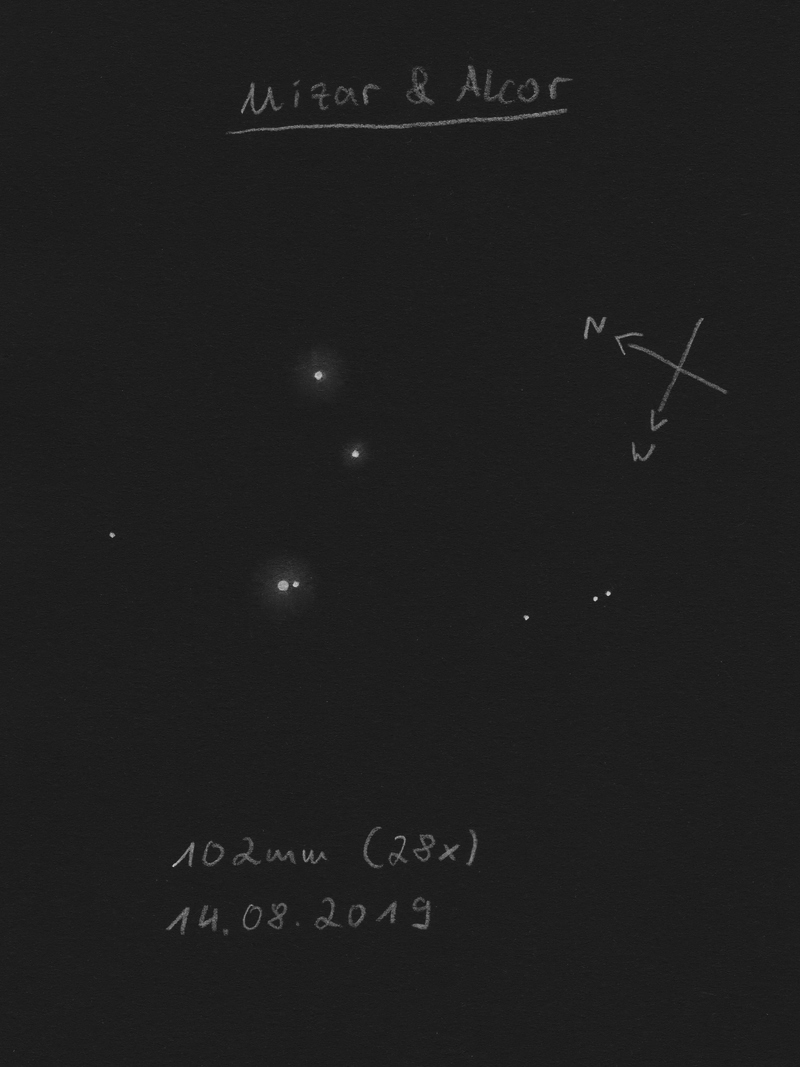
|
Uwe Pilz
Leipzig (Germany) |
105mm (288x) |
AB: mit viel Schwarz zwischen den Beugungsscheiben (1“9) |
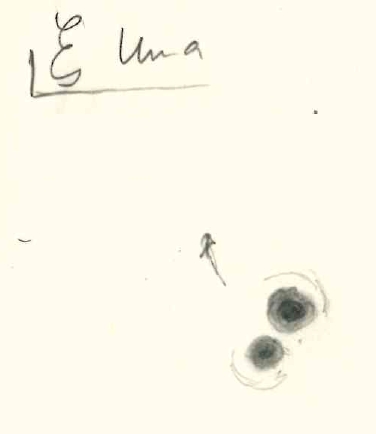
|
Jörg S. Schlimmer
Germany |
127mm (87x) |
easy to split |
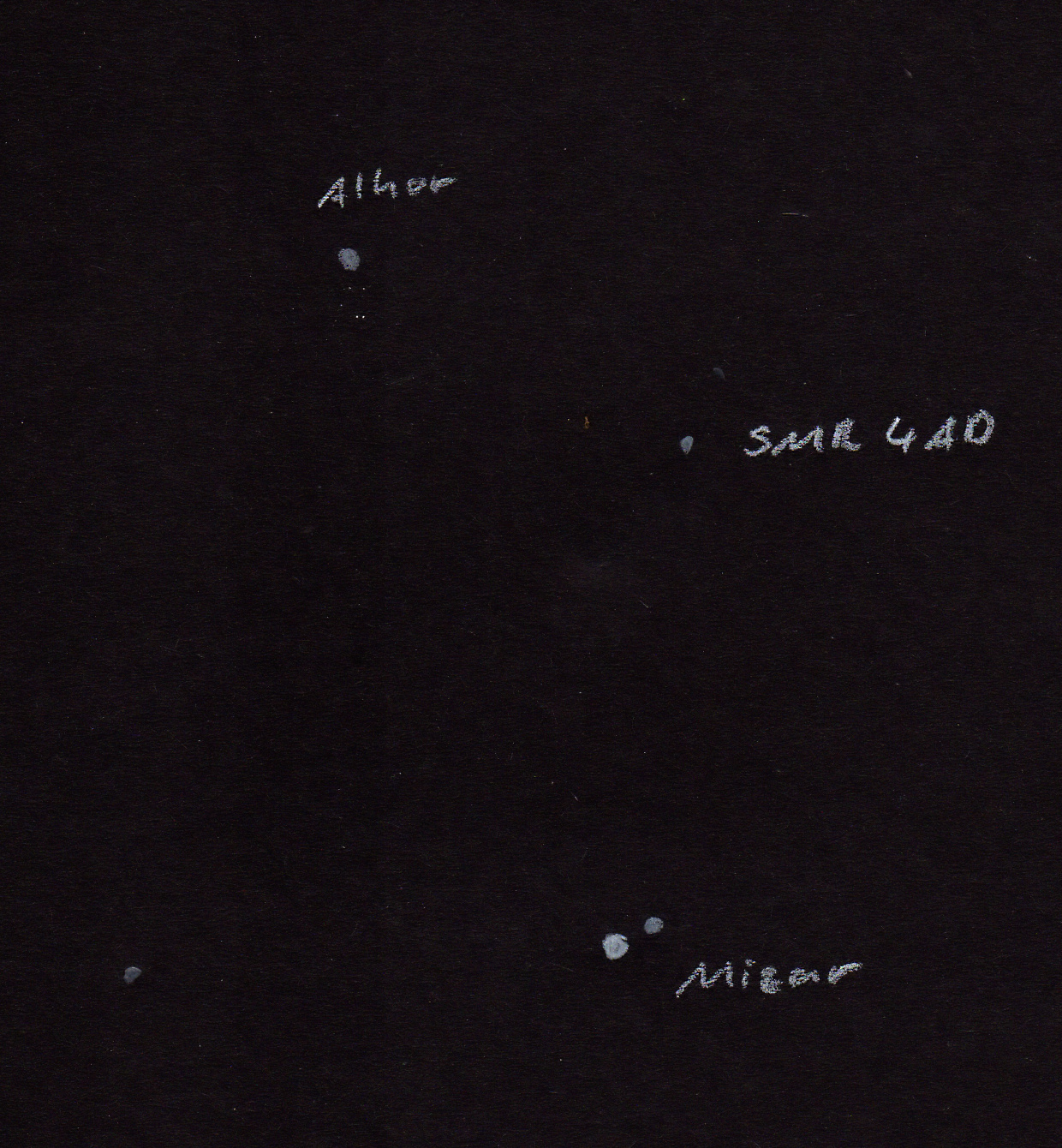
|
Sarah Gebauer
Germany |
150mm (83x) |
AB: einfacher, aber sehr schöner Doppelstern, Komponenten A und B mit 14,4'' Abstand stehen mit schönen Feldsternen zusammen im Bild |

|
René Merting
Drachhausen (Germany) |
320mm (45x) |
drei wunderschöne Juwelen strahlen mich an, A und B knapp getrennt, C weit entfernt im Nordosten von den beiden - Komponente B wirkt weißgelblich gegen die kühlweiß strahlende A-Komponente - Komponente D, die zwischen AB und C steht, wirkt eher grauweiß |
|
|
Robert Zebahl
Leipzig (Germany) |
|
|
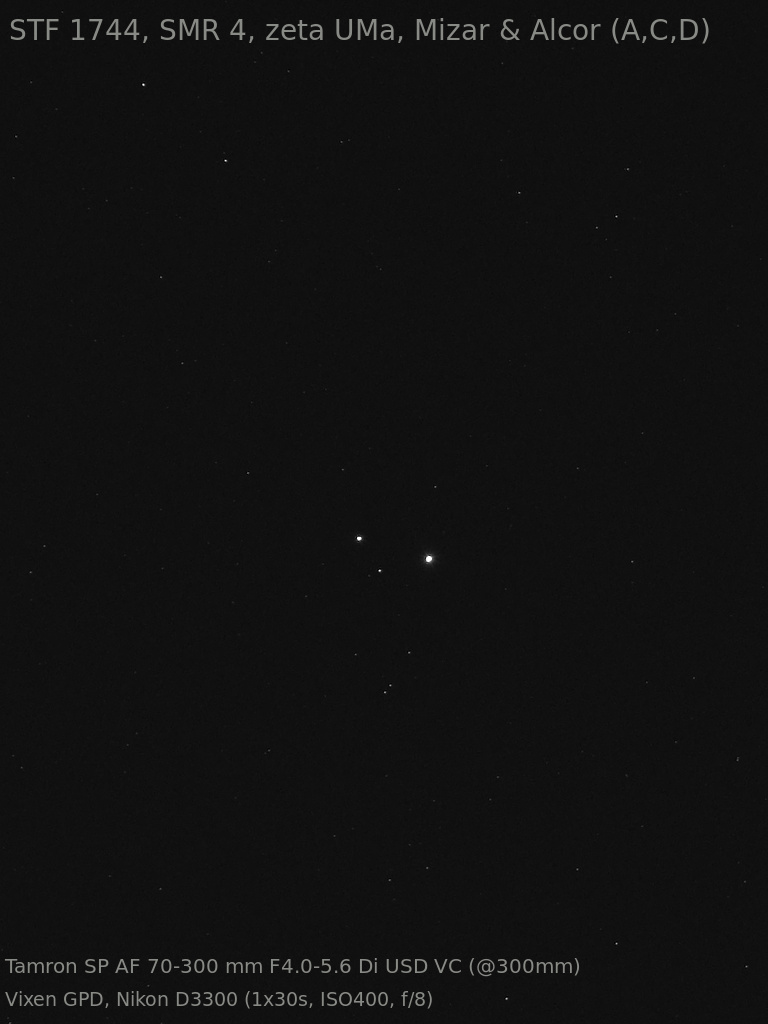
|
Werner E. Celnik
Rheinberg (Germany) |
120mm |
|
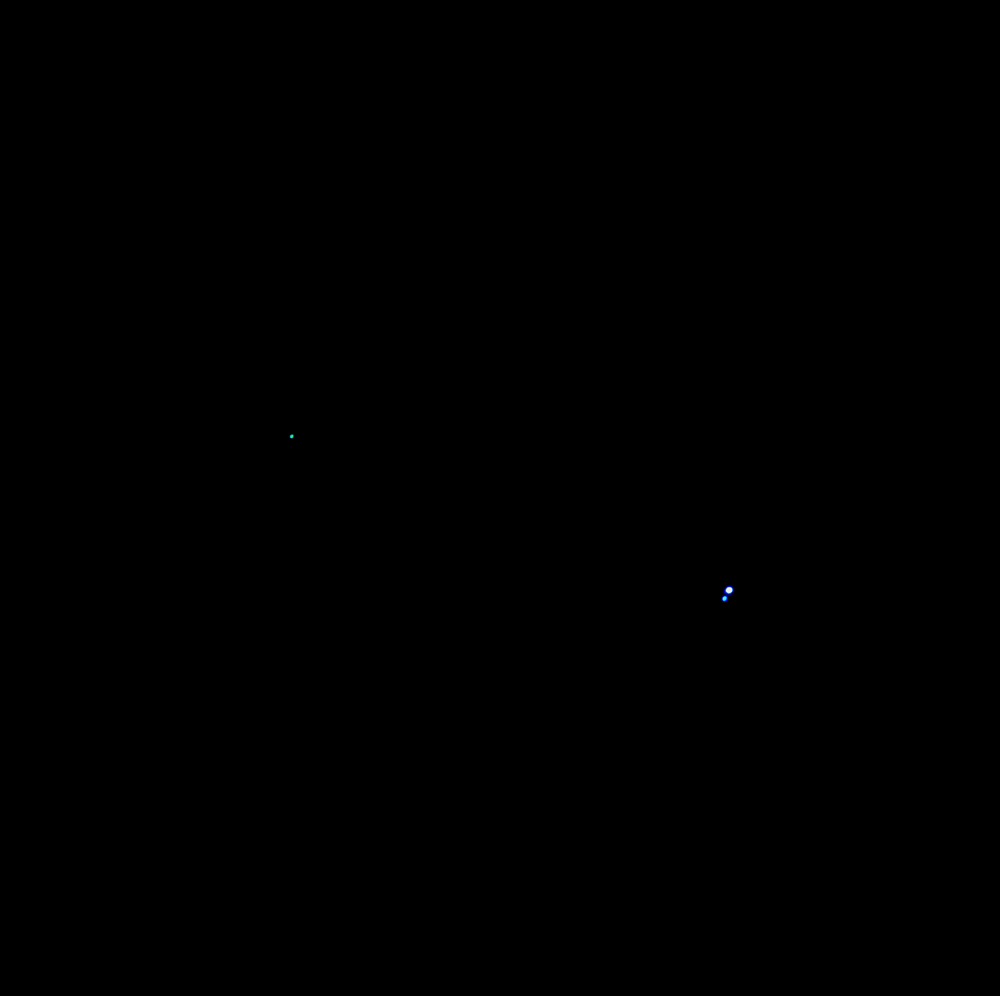
|
|
|
★
|
STTA123 |
|
AB |
6m.7 |
7m.0 |
69.7" |
148° |
2020 |
Dra |
13h27m04.70s / +64°44'07.60" |
|
|
|
|
BC |
7m.0 |
12m.0 |
40.1" |
98° |
2020 |
|
|
Christopher Hay
Seeheim (Germany) |
7x45 |
AB: Handheld binoculars. Difficult due to hand tremor, but clearly split. |
|
Christopher Hay
Seeheim (Germany) |
15x45 |
AB: Handheld binoculars with internal stabilisation. Wide split. Mild colour contrast between components, hard to grasp.
Analysis by Shaya and Olling (2011) found that this is a physical pair with near 100% probability. Catalogued as Shaya 622. |
|
|
|
|
STT268 & H5 70 & GAT2, FK Com |
STT268 |
AB |
7m.7 |
13m.0 |
19.1" |
77° |
2016 |
Com |
13h30m52.21s / +24°14'15.30" |
|
|
|
H5 70 |
AC |
7m.7 |
8m.3 |
76.8" |
256° |
2018 |
|
|
|
|
|
H5 70 |
AD |
7m.7 |
13m.5 |
78.7" |
27° |
2015 |
|
|
|
|
|
GAT2 |
Ba-Bb |
13m.0 |
13m.1 |
1.5" |
35° |
2016 |
|
|
Christopher Hay
Seeheim (Germany) |
15x45 |
AC: Binoculars with internal stabilisation, handheld. Wide split. Fairly well-matched pair with small delta-mag. Nicely framed by a straight line of three 6-mag stars, one of which is the double A567. |
|
Mark McCarthy
Fremont (California/USA) |
317mm (553x) |
AB: Very faint wide B, bluish. Averted vision best, and with seeing. |
|
|
|
★★
|
STF1772, 1 Boo |
|
AB |
5m.8 |
9m.6 |
4.4" |
133° |
2019 |
Boo |
13h40m40.50s / +19°57'20.40" |
|
|
|
|
AC |
5m.8 |
12m.2 |
86.7" |
26° |
2020 |
|
|
|
|
|
|
AD |
5m.8 |
7m.4 |
208.7" |
1° |
2020 |
|
|
Christopher Hay
Seeheim (Germany) |
7x50 |
AD: On tripod. Wide split. Component D blueish. Fine in 7.3° field together with S 656.
A physical double at a distance to us of 328 light years. |
|
Christopher Hay
Seeheim (Germany) |
15x60 |
AD: On tripod. Very wide split. Component A cream-white, D pale blue. |
|
Robert Zebahl
Leipzig (Germany) |
70mm (22x) |
AD: 2020-04-24: Very widely split with clearly visible difference in brightness. The primary component appeared white-yellowish, the companion pale orange. |
|
Christopher Hay
Seeheim (Germany) |
80mm (63x) |
AB: B pops in and out of view as a very fine pinprick of light reasonably well set off from A. No success at 50x. |
|
Christopher Hay
Seeheim (Germany) |
150mm (96x) |
AB: Well split. Remarkably easy considering the 4-mag difference in brightness. A seems dusky yellow. B perhaps bluish, but hard to determine. 9-mag star a few arcminutes to the north makes the view even more pleasing. According to Stelledoppie AB is a physical double. |
|
Mark McCarthy
Fremont (California/USA) |
203mm (333x) |
AB: 1 Boo. Odd colors. Blue-white to greenish stars, wide, about 3 delta mag. AC is the very faint star well separated at nearly a right angle PA from the AB pair |
|
Karsten Kopp
Köln (Germany) |
600mm (180x) |
AB: Im CLT bei 180 x kein Problem. Der Reiz hier macht den größeren Helligkeitsunterschied von knapp 4 mag aus. Auch die Farben, der hellere erstrahlt eher weiß und der schwächere schwach rotbraun, sind schön anzusehen. |
|
|
Berthold Fuchs
Wiesbaden (Germany) |
130mm |
AB: difficult DS |
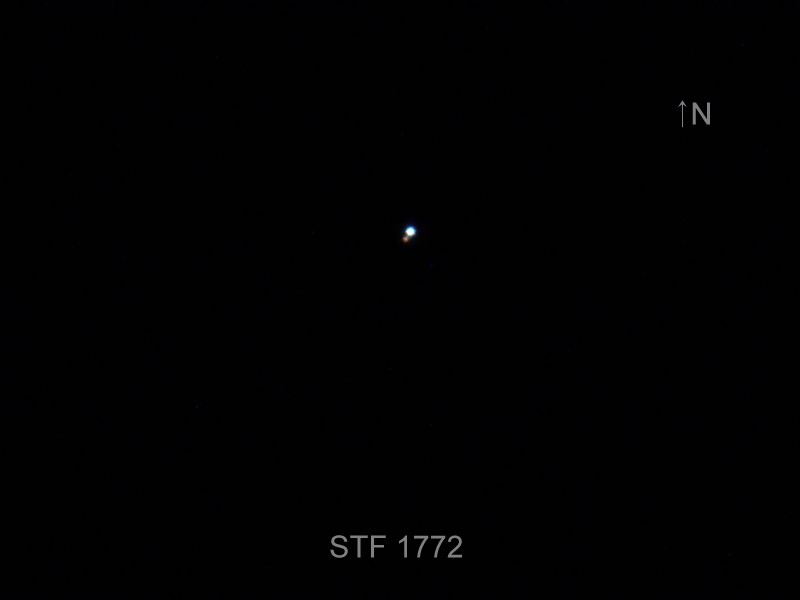
|
|
|
★
|
S654 & SHY633 |
S654 |
AB |
5m.6 |
8m.9 |
71.3" |
239° |
2018 |
CVn |
13h46m59.77s / +38°32'33.70" |
|
|
|
SHY633 |
AC |
5m.6 |
8m.9 |
999.9" |
296° |
2020 |
|
|
Christopher Hay
Seeheim (Germany) |
7x42 |
AB: With handheld 7x42 binoculars I cannot separate B from A. With handheld 10x42 binoculars with internal stabilisation, B emerges in fleeting moments from the glare of A, wide. Yellow-orange hue of A that I had already noticed with 7x42 binoculars becomes clearer with 10x42.
With stabilised 20x60 binoculars I can hold B constantly, but B is far more difficult than component C (AC = Shaya 633) despite B and C having practically identical brightnesses.
AC: With handheld 7x42 binoculars component C is clear and very wide from A. A seems yellow-orange. Not visually exciting, it is nonetheless pleasurable to contemplate that this is in fact a physical pair travelling together in space, 317 light years distant from us.
SHY = E.J. Shaya, R. Olling, 2011: Very Wide Binaries and Other Comoving Stellar Companions: A Bayesian Analysis of the Hipparcos Catalogue. Component A is HIP 67250, C is 67041. AB is also physical, hence ABC is a triple system. |
|
Sarah Gebauer
Germany |
100mm (21x) |
S654 (AB): 02.10.23: bei 21-fach gut und weit getrennt, die nordöstliche Komponente strahlt sehr schön hellgolden, die südwestliche ist ein dunkelgraues Pünktchen - in etwa fünffachem Abstand südwestlich strahlt der benachbarte Stern HD120048 in einem schön kontrastreichen Warmweiß - bei 49-fach ist der Anblick auch noch schön, der Goldton von A intensiviert sich ins Roségoldene |
|
René Merting
Drachhausen (Germany) |
100mm (32x) |
S654 (AB): bei 32x ein weit getrenntes Pärchen - B im Südwesten ist deutlich schwächer und farblos ggü. der weiß strahlenden Komponente A |
|
Mark McCarthy
Fremont (California/USA) |
317mm (277x) |
S654 (AB): Striking yellow-orange and blue-green fainter B. |
|
|
|
★★★
|
S656 |
|
|
6m.9 |
7m.4 |
86.2" |
209° |
2018 |
Boo |
13h50m23.51s / +21°16'35.80" |
Christopher Hay
Seeheim (Germany) |
7x50 |
On tripod. Well split. A compact pair directly next to orangish-yellow 6 Boo in a remarkably attractive 7.3° FOV together with widely separated 1 Boo (STF 1772 AD) two degrees southwest plus Eta and Tau Boo about three degrees south.
A physical double at a distance to us of 345 light years. This means that South 656 is not just close to 1 Boo AD in our perspective but also actually in space, making the two pairs one of the finest physical double-doubles in the sky for 7x binoculars. |
|
Robert Zebahl
Leipzig (Germany) |
8x40 |
2020-04-05: Wide, medium bright pair. Primary component appeared slightly orange, the companion greyish. The double star is in close vicinity to the star 6 Boo, which shines in a pale orange. |
|
Christopher Hay
Seeheim (Germany) |
15x60 |
On tripod. Wide split. Primary orangish. Well-matched pair, very striking. Nicely accentuated by yellowish 6 Boo a few arc-minutes to the west. |
|
Christopher Hay
Seeheim (Germany) |
30mm (6x) |
While panning towards globular M3 I stumble across this striking pair in the finder, very even and well split. |
|
Robert Zebahl
Leipzig (Germany) |
70mm (22x) |
2020-04-24: Widely separated with little difference in brightness. Both components appeared slightly yellowish. Standing close to 6 Boo, which also shines in a slight yellow. |
|
Mark McCarthy
Fremont (California/USA) |
178mm (205x) |
Wide, white, half delta. WDS says it's physical but I calculate no parallax overlap and the two are too far apart to be gravitationally bound |
|
Christopher Hay
Seeheim (Germany) |
254mm (100x) |
At this power very wide, slight delta mag. At first sight no evident colour contrast, but after a while it becomes increasingly clear that the secondary is bluer than the primary. This effect is rather charming. |
|
|
|
★★
|
STF1821, kappa Boo, 17 Boo, Asellus Tertius |
|
AB |
4m.5 |
6m.6 |
13.8" |
236° |
2021 |
Boo |
14h13m29.00s / +51°47'23.80" |
|
|
Christopher Hay
Seeheim (Germany) |
15x60 |
On tripod. Fine split. Attractive together with well-split Iota Boo in 3.3° FOV.
Iota, Kappa, Theta were called Aselli by Johannes Bayer in the 17th century, meaning The Donkeys. The group is found easily naked-eye under a 5mag sky. Kappa Boo is Asellus Tertius, The Third Donkey.
A physical double at a distance to us of 163 light years. |
|
René Merting
Drachhausen (Germany) |
18x70 |
Komponente A strahlt so hell, dass B deutlich schwächer ganz knapp im SW von A abgesetzt sichtbar ist - Helligkeitsunterschied schätzungsweise 3 Magnituden (nur 2.09 mag laut Stelle Doppie) |
|
Robert Zebahl
Leipzig (Germany) |
70mm (22x) |
2020-04-24: Clearly separated with significant difference in brightness. The primary component showed a pale yellowish-orange color with a greyish companion. To the southeast there is the double star STFA 26. |
|
Sarah Gebauer
Germany |
100mm (49x) |
02.10.23: die nordöstliche A-Komponente strahlt bei 49-fach warmweiß mit einem Hauch Zitronengelb, die südwestliche, sehr dicht stehende und getrennte B-Komponente wirkt weißlicher - zusammen ergeben sie ein Gelbgold-Weißgold-Schmucksternpaar in einem schönen Sternumfeld mit STFA 26 südöstlich, der eine ähnliche Farbe zeigt |
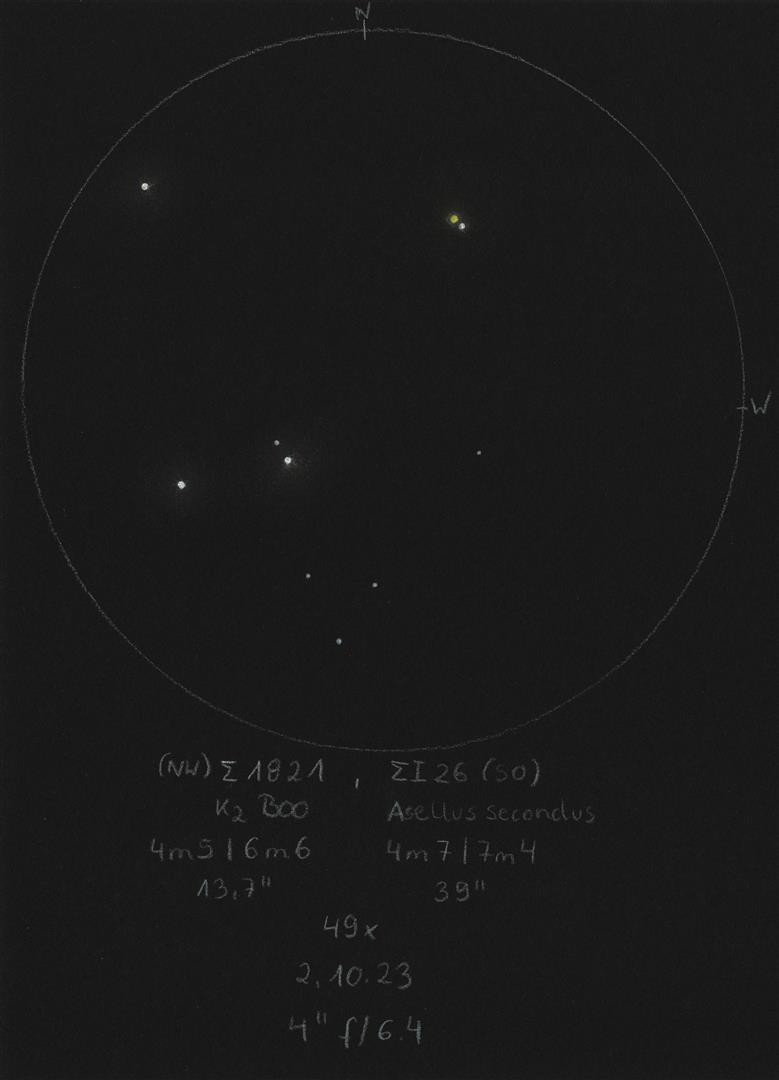
|
Sarah Gebauer
Germany |
100mm (73x) |
sehr schön zusammen mit STFA 26 in einem Gesichtsfeld bei 73x, dabei sehr schön getrennt |
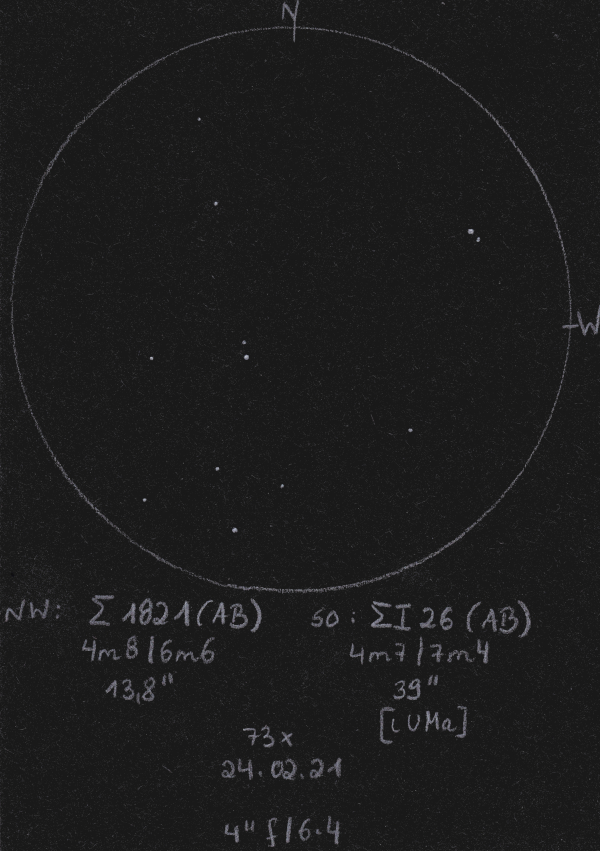
|
Uwe Pilz
Leipzig (Germany) |
105mm (144x) |
weiß-grau, trennbar bei 22x |
|
René Merting
Drachhausen (Germany) |
320mm (45x) |
bei 45x schicker Anblick und schön zusammen im Gesichtsfeld mit sehr ähnlichen Doppelstern STTA 26 - hier aber eine knappere Trennung und B steht im Südwesten von A - ähnlicher Farbkontrast wie beim Nachbardoppelstern, A ist weiß-gelb, B ist blau-grau |
|
Karsten Kopp
Köln (Germany) |
600mm (180x) |
Im CLT leicht zu trennen. Beider Sterne erscheinen weißlich. |
|
|
|
★★
|
STF1830 & STF1831 |
STF1831 |
AB |
7m.2 |
9m.6 |
5.8" |
138° |
2017 |
UMa |
14h16m08.47s / +56°42'45.70" |
|
|
|
STF1831 |
AC |
7m.2 |
6m.7 |
112.2" |
219° |
2017 |
|
|
|
|
|
STF1831 |
CD |
6m.7 |
13m.1 |
112.1" |
116° |
2016 |
|
|
|
|
|
STF1830 |
CE |
6m.7 |
9m.3 |
138.2" |
245° |
2020 |
|
|
|
|
|
STF1830 |
EF |
9m.3 |
10m.3 |
10.6" |
312° |
2017 |
|
|
|
|
|
STF1830 |
EG |
9m.3 |
12m.2 |
35.2" |
81° |
2017 |
|
|
Christopher Hay
Seeheim (Germany) |
7x45 |
STF1831 (AC): Wide split at 7x but still a very distinct impression of being a double. No colour impression. Two fine pinpricks of light, rather attractive in 8° FOV.
According to Stelledoppie the A-C pair, at 509 light years distance to us, is the only physical pair in the whole STF 1830/1831 complex. A nice physical double for small binoculars. |
|
Robert Zebahl
Leipzig (Germany) |
8x40 |
STF1831 (AC): 2020-04-05: Fairly wide pair with slight differences in brightness and color. C appeared slightly orange, A on the other hand slightly bluish. Comparatively bright double star, which gives a nice view. |
|
René Merting
Drachhausen (Germany) |
15x56 |
AC: beide Sterne sind gleich hell und mehr als komfortabel voneinander getrennt\CE: Komponente E im Südwesten von C fällt ebenfalls sofort ins Auge, wenn auch der Stern deutlich schwächer ist - Abstand zu C in etwa so groß, wie der Abstand AC |
|
Robert Zebahl
Leipzig (Germany) |
55mm (27x) |
STF1831 (AC): 2020-04-05: Moderate difference in brightness. C: pale orange, A: subtle blue. |
|
Robert Zebahl
Leipzig (Germany) |
70mm (57x) |
2020-04-11: At 22x the components AB, C, E & F are well visible and widely separated. E & F are comparatively faint. The C component in the middle appeared white-yellowish, AB rather white with a slight tendency to blue. At 57x, the pair AB with a clear difference in brightness can be easily split. An altogether rewarding and unusual multiple system. |
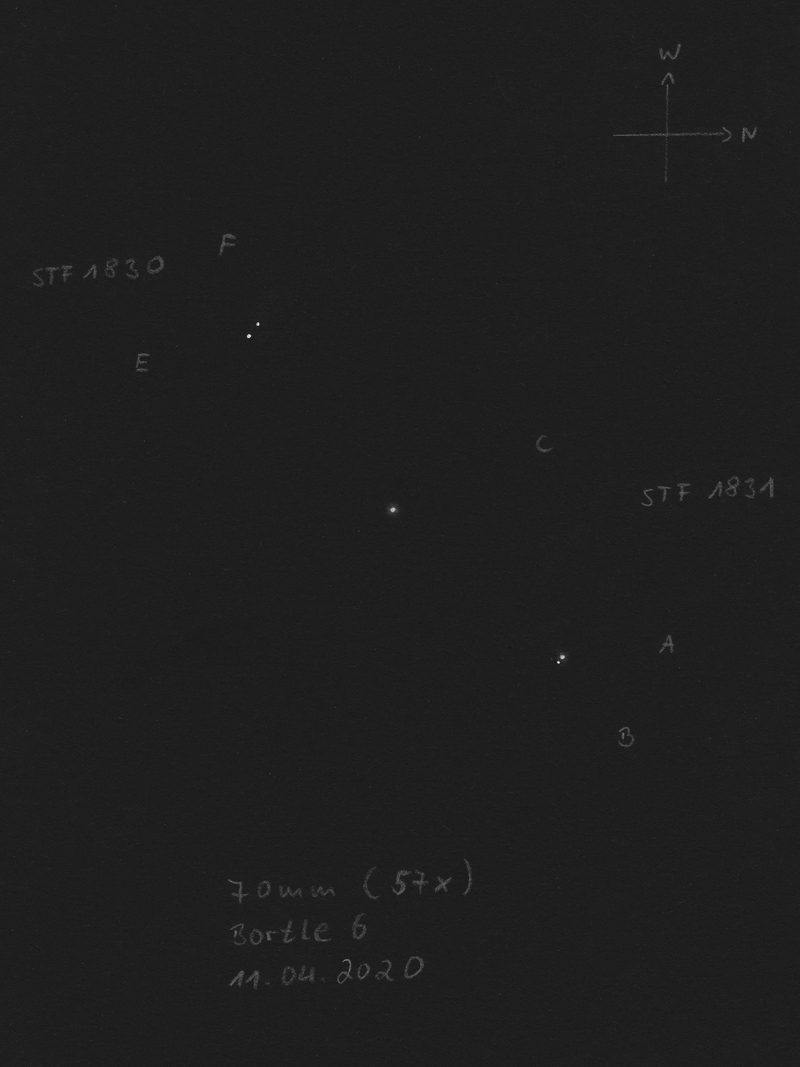
|
Sarah Gebauer
Germany |
100mm (80x) |
STF1830 (EF): ein ungleiches Doppel-Doppel zusammen mit STF 1830 (AC) - das feine Pärchen ist bei 49-fach gerade so getrennt und zeigt zwei nahezu gleich helle Sternpünktchen |
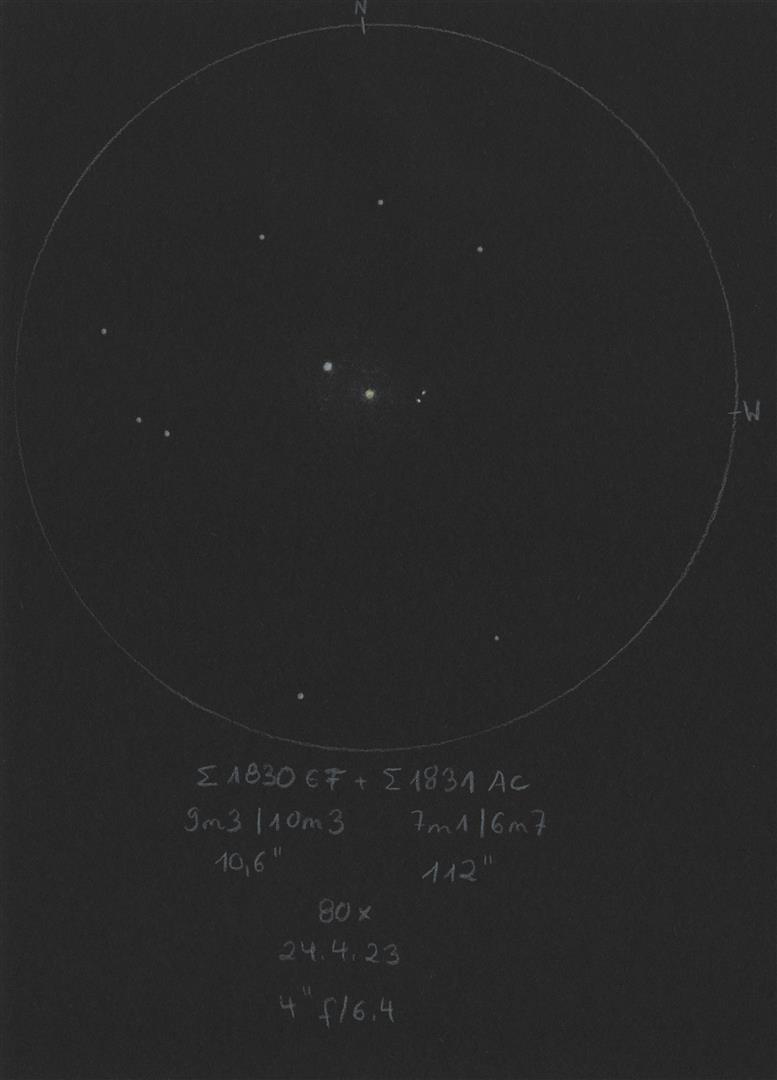
|
Sarah Gebauer
Germany |
100mm (80x) |
STF1831 (AC): ein ungleiches Doppel-Doppel zusammen mit STF 1831 (EF) - bei 49-fach zeigt das weite, helle Pärchen eine leicht gelbliche C-Komponente und einen leichten Helligkeitsunterschied |

|
Uwe Pilz
Leipzig (Germany) |
105mm (88x) |
Komponente G erforderte 200x |
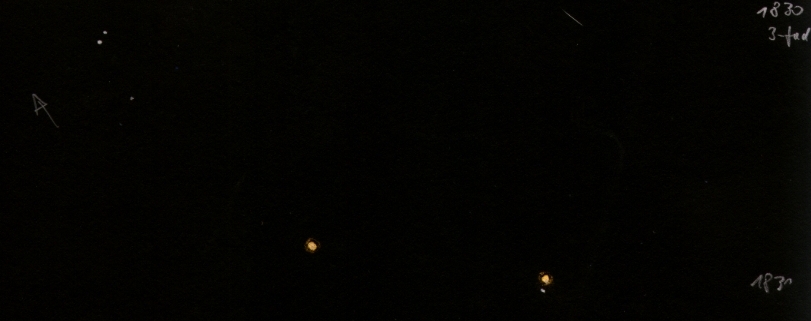
|
Mark McCarthy
Fremont (California/USA) |
317mm (553x) |
STF1831 (AB): One pair close to another, 5" and 2 delta mag. Part of a widely separated equal pair, and a gang of three stars further away -- five additional pairings in the system. |
|
René Merting
Drachhausen (Germany) |
320mm (72x) |
EF: bei 72x ein schwaches Sternpaar, gut getrennt - E ist gelblich, F eine halbe Größenklasse schwächer und grau
EG: bei 72 ist nordöstlich von EF noch ein ganz schwacher Lichtpunkt erkennbar - G hat ungefähr mit dreifachem Abstand EF |
|
René Merting
Drachhausen (Germany) |
320mm (72x) |
AB: bei 144x ist B ein bisschen mehr als knapp getrennt im SO von A erkennbar - B ist deutlich schwächer und grau gegen den weißgelblich strahlenden A - zurück auf 72x kann ich die beiden auch noch extrem knapp getrennt erkennen in guten Momenten - ein schönes Doppel zusammen mit STF1830 EF
AC: bei 72x fällt die helle Komponente C im Südwesten von AB zwar auf, ich hätte aber nicht vermutet, dass der Stern dazu gehört |
|
|
|
★★
|
STFA26, iota Boo, 21 Boo |
|
AB |
4m.8 |
7m.4 |
39.0" |
33° |
2020 |
Boo |
14h16m10.07s / +51°22'01.30" |
Robert Zebahl
Leipzig (Germany) |
8x40 |
2020-04-05: Even with tripod the faint companion was not visible. |
|
Christopher Hay
Seeheim (Germany) |
15x60 |
On tripod. Well split, companion seems bluish.
Fine 3.3° FOV star field with Kappa Boo (also split) and Theta Boo plus several 6th to 7th mag stars. Iota, Kappa, Theta were called Aselli by Johannes Bayer in the 17th century, meaning The Donkeys. The group is found easily naked-eye under a 5mag sky. Iota Boo is Asellus Secundus, The Second Donkey.
A physical double at a distance to us of 95 light years. |
|
Robert Zebahl
Leipzig (Germany) |
16x70 |
2021-03-21: Very beautifully embedded in a group of bright and medium bright stars. Significant difference in brightness. Primary component appeared white-yellowish, the much fainter companion grey-bluish at best. |
|
René Merting
Drachhausen (Germany) |
18x70 |
ein schönes ungleiches Paar, aber Komponente B ist deutlich besser abgesetzt von A erkennbar als beim Nachbar-DS STF1821 - leichter Farbkontrast |
|
Robert Zebahl
Leipzig (Germany) |
70mm (22x) |
2020-04-24: Similar view to the northwest standing kappa Boo. Nicely separated with larger distance and fainter companion. The primary component appeared rather white. |
|
Sarah Gebauer
Germany |
100mm (73x) |
bei 73x weit getrennt mit sichtbarem Helligkeitsunterschied, passt zusammen mit STF1821 in ein Gesichtsfeld und ist sehr schön anzusehen |

|
Uwe Pilz
Leipzig (Germany) |
105mm (144x) |
sehr weit, auffallend bei 22x |
|
René Merting
Drachhausen (Germany) |
320mm (45x) |
bei 45x weite Trennung der beiden Protagonisten - Komponente B im Nordwesten ist mehr als zwei Größenklassen schwächer - leichter Farbkontrast gelb-weiß vs. grau-weiß |
|
|
|
★
|
STF1850 |
|
|
7m.1 |
7m.6 |
25.2" |
263° |
2018 |
Boo |
14h28m33.29s / +28°17'25.90" |
Robert Zebahl
Leipzig (Germany) |
8x40 |
2020-04-05: Separated, but still quite close together with a moderate difference in brightness. |
|
Christopher Hay
Seeheim (Germany) |
15x45 |
Handheld, binoculars with internal stabilisation. A tight pair, indirect vision helps to see black in-between. Eastern component clearly brighter. Nice in 4.5° FOV with Rho and Sigma Boo.
A physical double at a distance to us of 1140 light years. |
|
René Merting
Drachhausen (Germany) |
16x70 |
ein gut getrenntes Paar zweier gleich heller Sterne - beide weiß |
|
Robert Zebahl
Leipzig (Germany) |
70mm (22x) |
2020-04-24: Easily separated, medium bright with rather small difference in brightness and moderate distance. Fairly conspicuous. The components appeared white-yellowish and white-bluish. Beautiful double star. |
|
René Merting
Drachhausen (Germany) |
100mm (20x) |
bei 20x locker getrennt - Komponente B ist vielleicht eine halbe Magnitude schwächer als A und strahlt ein wenig dumpfer bzw. weniger weiß |
|
Sarah Gebauer
Germany |
100mm (49x) |
bei 49-fach ein gleich helles, unscheinbares, feines und weit getrenntes Pärchen |
|
Uwe Pilz
Leipzig (Germany) |
120mm (72x) |
recht weit, schöner Farbkontrast |
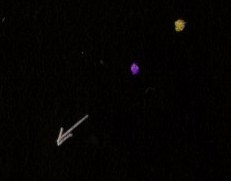
|
Mark McCarthy
Fremont (California/USA) |
178mm (205x) |
Near equal white wide. WDS claims physical, and their parallax do overlap, however they are separated by 7168 AU, too far than the known 5000 AU limit of known orbital pairs |
|
|
Berthold Fuchs
Wiesbaden (Germany) |
130mm |
easy DS |
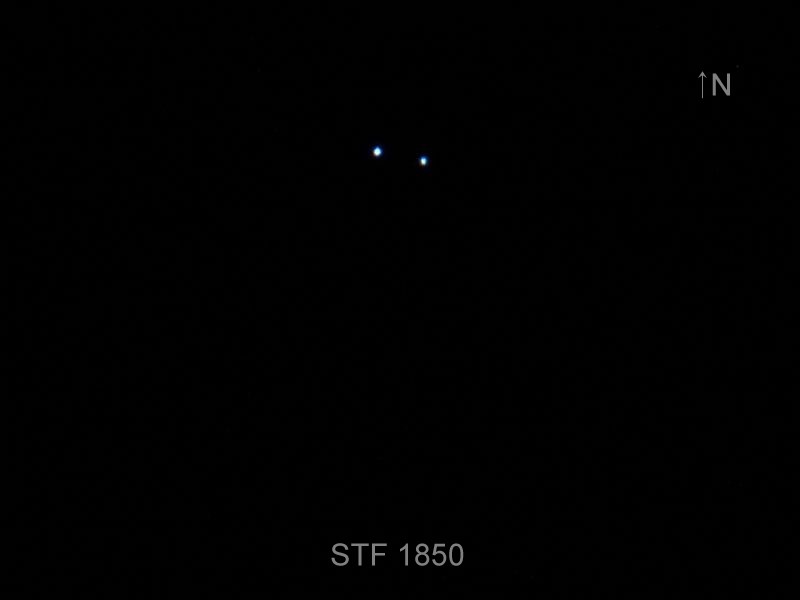
|
|
|
★★★
|
alpha Lib, Zubenelgenubi, Kiffa Australis, Lanx Australis |
SHJ186 |
AB |
2m.7 |
5m.2 |
231.1" |
314° |
2012 |
Lib |
14h50m52.78s / -16°02'29.80" |
|
|
|
AOT53 |
AC |
2m.7 |
12m.5 |
275.6" |
291° |
2000 |
|
|
|
|
Christopher Hay
Seeheim (Germany) |
naked eye |
AB: Noticed with naked eye and without prior PA knowledge that a secondary was flickering next to Zubenelgenubi. Unexpected and first naked-eye sighting. Checked position with binoculars to be sure. Further naked-eye look at Mizar/Alkor (Zeta UMa) to gauge my momentary acuity and assess the difference to Alpha Lib. Zeta UMa more easily and widely split than ever before, and Alkor appeared for the first time bluish, so this was an exceptional night for naked-eye double-star splitting. Three-star rating awarded because Zubenelgenubi is the second-best naked-eye true-physical double star in the summer sky after Mizar/Alkor. |
|
René Merting
Drachhausen (Germany) |
8x25 |
AB: ein schöner Fernglas-Doppelstern mit leichtem Farbkontrast - beide Sterne stehen weit auseinander - B im Nordwesten wirkt braungrau gegen die warmweiße A-Komponente - Helligkeitsunterschied eine Größenklasse (total verschätzt, es sind 2.45 mag) |
|
Christopher Hay
Seeheim (Germany) |
10x56 |
AB: Handheld. A strong, wide pair. Both cold white, the secondary more bluish than the primary.
Delightful in 6.3° FOV together with the "Zub's Hat" (Hay-Merting 9) asterism directly above (north of) the pair, an array of six stars looking very much like a hat or cap on Zubenelgenubi. |
|
Gerd Kohler
Langenzenn (Germany) |
254mm (76x) |
AB: Bläulich-weiß - leicht bläulich. |
|
Gerd Kohler
Langenzenn (Germany) |
254mm (76x) |
AC: Bläulich-weiß - weiß. Sehr schwacher Begleiter. |
|
|
|
★★
|
STFA27, delta Boo, 49 Boo |
|
AB |
3m.6 |
7m.9 |
105.0" |
78° |
2021 |
Boo |
15h15m30.16s / +33°18'53.40" |
Christopher Hay
Seeheim (Germany) |
15x45 |
Handheld, binoculars with internal stabilisation. Very wide. Component A is of a slight yellow-orange hue, its companion too weak (NELM in target area: 5m0) for colour impression.
Nice in 4.5° FOV with Mu Boo AB, which is visibly slightly wider than Delta Boo and whose component B is slightly brighter than that of Delta Boo.
Delta Boo is a physical double at a distance to us of 122 light years. |
|
René Merting
Drachhausen (Germany) |
18x70 |
ein sehr ungleiches, weit auseinander stehendes Sternpaar - Komponente A im Westen strahlt gleißend cremegelb, die wesentlich schwächere Komponente B im Osten ist weißgrau bis bräunlich |
|
Robert Zebahl
Leipzig (Germany) |
70mm (22x) |
2020-04-24: Widely separated pair with large difference in brightness. Less striking. The bright primary component shines in a bright yellow. |
|
Mark McCarthy
Fremont (California/USA) |
80mm (13x) |
Split in 80mm finder. Very wide pair, very bright A, 3 delta mag B. Orange-yellow and blue-white B |
|
Mark McCarthy
Fremont (California/USA) |
80mm (94x) |
Delta Boo. Wide, large delta mag B, a 76,000-period pair! |
|
Sarah Gebauer
Germany |
100mm (49x) |
bei 49-fach zeigt A ein schönes, zartes Gelb, der weit entfernte Begleiter ist sehr fein, wesentlich schwächer und schafft es nicht über einen grauen Farbeindruck hinaus |
|
René Merting
Drachhausen (Germany) |
107mm (30x) |
bei 30x deutlich getrennt - Komponente A strahlt ein einem seidenen Gelb, B ist mehr als zwei Größenklassen schwächer und wirkt weißlich |
|
Mark McCarthy
Fremont (California/USA) |
203mm (205x) |
Bright star with many nearby faint stars. Didn't bother trying to figure out which are which. |
|
|
Frederik Wanink
Itterbeck (Germany) |
254mm |
|
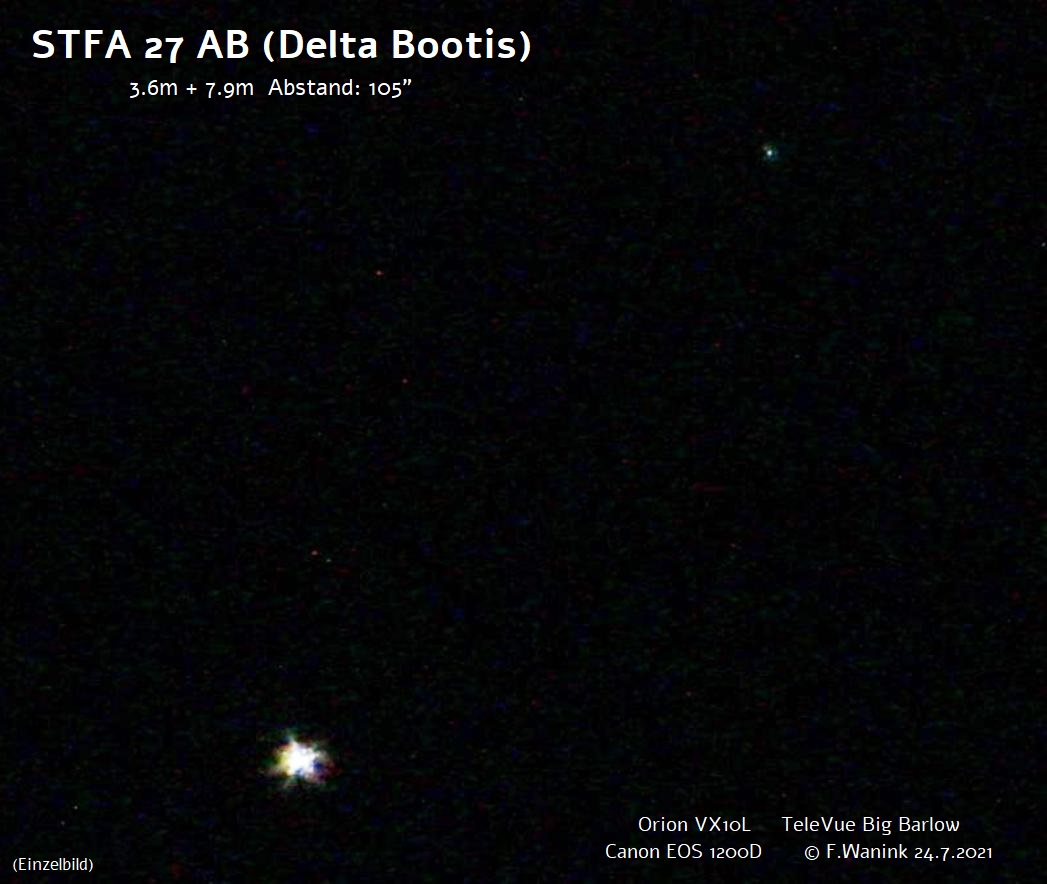
|
|
|
★★★
|
mu Boo, 51 Boo, Alkalurops |
CHR181, mu 1 Boo |
Aa-Ab |
4m.3 |
|
0.1" |
188° |
2012 |
Boo |
15h24m29.54s / +37°22'37.10" |
|
|
|
STFA28, mu 1 Boo |
AB |
4m.3 |
7m.1 |
109.2" |
171° |
2020 |
|
|
|
|
|
STF1938, mu 2 Boo |
Ba-Bb |
7m.1 |
7m.6 |
2.2" |
2° |
2020 |
|
|
|
|
Christopher Hay
Seeheim (Germany) |
7x45 |
STFA28 (AB): Handheld. Wide split. A compact uneven pair. Component A is bluish-white.
Rather charming in 8.6° FOV with Nu1/2 Boo, which has a gorgeous colour contrast, golden-orange and ice-blue, making it one of the strongest colour-contrast pairs in the sky for binoculars and greatly accentuating the sight of Mu Boo.
In 15x45 binoculars STFA28 AB is very wide, component A bluish-white, B warmer. |
|
Robert Zebahl
Leipzig (Germany) |
8x40 |
STFA28 (AB): Easily split with obvious difference in brightness. |
|
Robert Zebahl
Leipzig (Germany) |
16x70 |
STFA28 (AB): 2021-06-14: Wide, relatively striking pair. Pale yellow & dark orange. |
|
René Merting
Drachhausen (Germany) |
16x70 |
STFA28 (AB): weit getrenntes Pärchen, aufgrund der großen Helligkeitsunterschiedes schöner Farbkontrast - Komponente A im Norden gelblich, B im Süden mehr grau-braun |
|
Robert Zebahl
Leipzig (Germany) |
70mm (22x) |
STFA28 (AB): Evident, very wide apart and unequal. A: white-yellowish, B: grey. |
|
Mark McCarthy
Fremont (California/USA) |
80mm (94x) |
STFA28 (AB): Alkalurops Bright yellow-white A and bluish B, which is itself a slightly unequal close double, finely split (STF 1938 Ba,Bb) -- 256.5-year period, now coming off apastron |
|
Sarah Gebauer
Germany |
100mm (21x) |
STFA28 (AB): 02.10.23: bei 21-fach sehr eindeutig auszumachen, das Paar sticht durch eine sehr helle, blass zitronengelbe A-Komponente und eine graue bis schmutzig weiße, weit abgesetzte B-Komponente hervor |
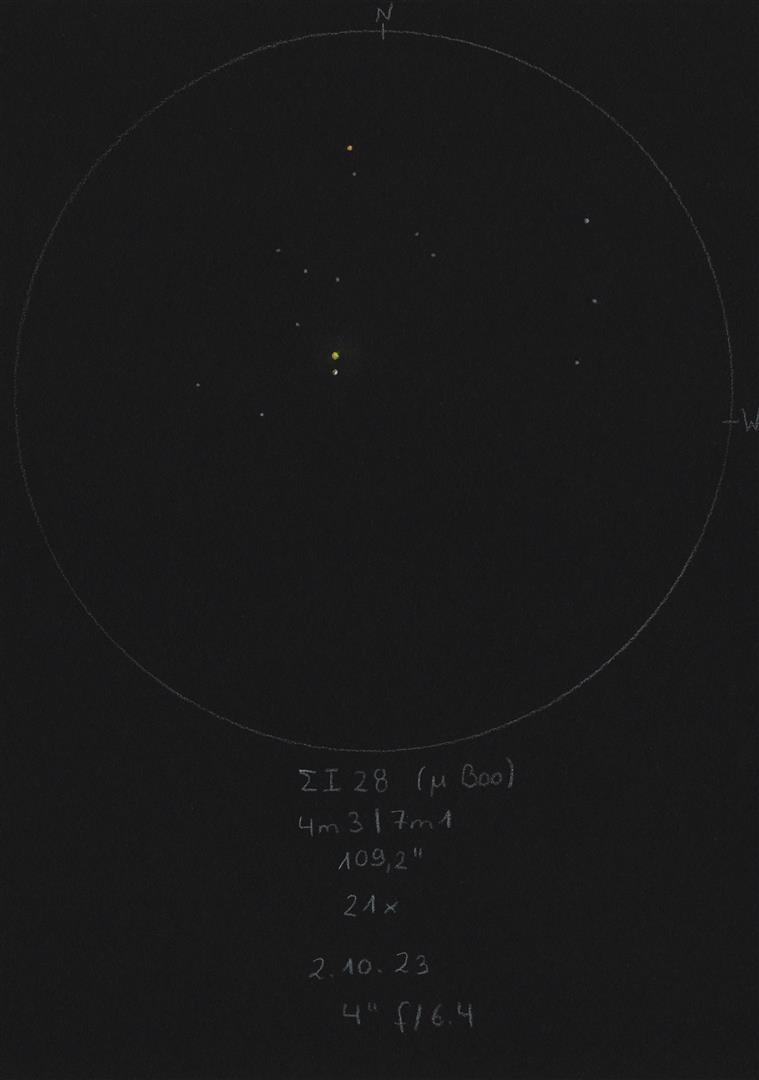
|
Sarah Gebauer
Germany |
100mm (49x) |
STFA28 (AB): bei 49-fach sehr hell und sehr weit, unterschiedlich hell und dominiert das ohnehin schon eher leere Gesichtsfeld |
|
Robert Zebahl
Leipzig (Germany) |
102mm (125x) |
Beautiful view! This triple system includes STFA 28 and STF 1938. |
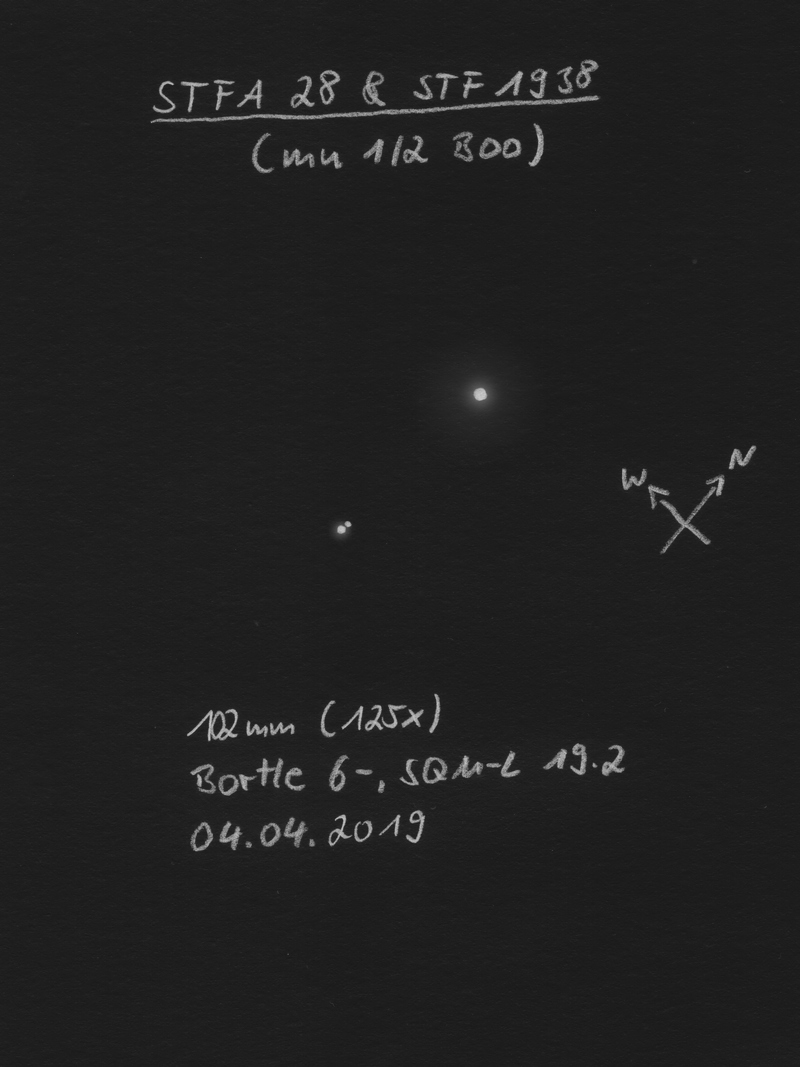
|
Uwe Pilz
Leipzig (Germany) |
105mm (288x) |
ein heller 4m und zwei nahe dunkle 7m, lohnend. |
|
René Merting
Drachhausen (Germany) |
107mm (30x) |
STFA28 (AB): AB: das Paar ist bei 30x komfortabel getrennt erkennbar, A strahlt leicht gelblich - Komponente B besteht aus zwei Sternen Ba, Bb (STF 1938), die ab 120x getrennt zu sehen sind - Bb im Norden ist gut eine viertel bis halbe Größenklasse schwächer als Ba |
|
René Merting
Drachhausen (Germany) |
107mm (120x) |
STF1938 (Ba-Bb): bei 86x ist nördlich von Ba ein zweiter etwas schwächerer Stern erkennbar, er klebt noch an Ba - 120x reichen dann für eine knappe Trennung - Bb im Norden ist eine viertel bis halbe Größenklasse schwächer |
|
Robert Zebahl
Leipzig (Germany) |
120mm (23x) |
STFA28 (AB): Easy to split with large angular distance and noticeable difference in brightness. |
|
Sarah Gebauer
Germany |
150mm (125x) |
A-BC mit 109'' sind bei 125x sehr weit getrennt, es ist der Ansatz eines engen Doppelsterns zu erkennen, der sich mit 2,2'' Abstand auch bis 250x nicht auftrennen ließ |
|
Christopher Hay
Seeheim (Germany) |
180mm (105x) |
STF1938 (Ba-Bb): At 105x in poor seeing a kissing, evenly matched pair. At 180x clearly split despite the poor seeing, southern component (Ba) seems slightly brighter than Bb. |
|
Mark McCarthy
Fremont (California/USA) |
203mm (205x) |
STFA28 (AB): Bright A star does not seem round. The B star is a tight equal pair, pretty set. [Aa,Ab is CHR 181 0.1", and I'd be shocked if I actually detected it. STFA 28 is technically the bright star and the tight pair, the tight pair is Ba,Bb = STF 1938, 7.09/7.63, 2.2"] |
|
Mark McCarthy
Fremont (California/USA) |
203mm (205x) |
STFA28 (AB): Bright A star does not seem round (CHR181). B star is a tight equal pair (STF1938 Ba-Bb). Pretty set. STFA 28 is technically the bright star and the tight pair |
|
Mark McCarthy
Fremont (California/USA) |
203mm (205x) |
CHR181 (Aa-Ab): Bright A star does not seem round (CHR181). B star is a tight equal pair (STF1938 Ba-Bb). Pretty set. STFA 28 is technically the bright star and the tight pair |
|
Mark McCarthy
Fremont (California/USA) |
203mm (205x) |
STF1938 (Ba-Bb): Bright A star does not seem round (CHR181). B star is a tight equal pair (STF1938 Ba-Bb). Pretty set. STFA 28 is technically the bright star and the tight pair |
|
Frederik Wanink
Itterbeck (Germany) |
254mm (640x) |
STF1938 (Ba-Bb): 3er System, schön |
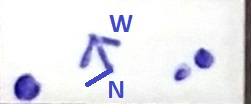
|
Mark McCarthy
Fremont (California/USA) |
317mm (277x) |
STFA28 (AB): Bright white star with tight yellow pair STF 1938 as its companion. |
|
Mark McCarthy
Fremont (California/USA) |
317mm (553x) |
STFA28 (AB): Striking. Bright star with near equal double STF 1938 paired with it. A star is a spectroscopic binary |
|
Mark McCarthy
Fremont (California/USA) |
317mm (553x) |
STF1938 (Ba-Bb): Near equal close but well split double also paired with STFA28 |
|
Karsten Kopp
Köln (Germany) |
600mm (257x) |
Hier handelt es sich um ein Dreifachsternsystem, welches jetzt aber nicht durch eine besondere Färbung der Sterne auffällt. Die A - B/C Komponenten stehen noch sehr weit auseinander, wobei auch die A-Komponente um einiges heller erscheint. Die beiden Komponenten B/C sind wesentlich näher beieinander und unterscheiden sich auch kaum in ihrer Helligkeit. |
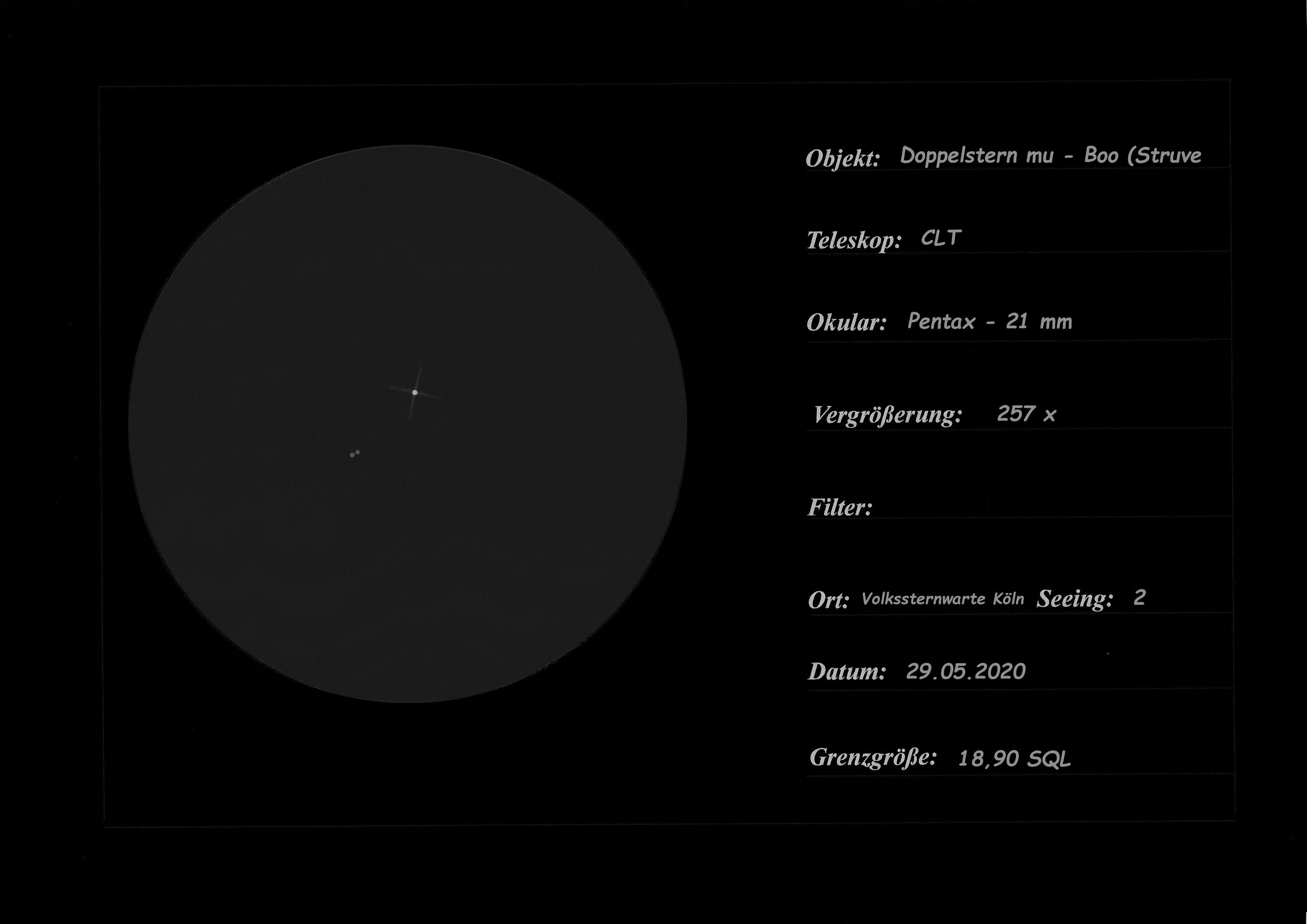
|
|
|
|
STF2010, kappa Her, 7 Her |
|
AB |
5m.1 |
6m.2 |
26.8" |
14° |
2020 |
Her |
16h08m04.55s / +17°02'49.20" |
|
|
|
|
AC |
5m.1 |
13m.4 |
62.7" |
212° |
2016 |
|
|
René Merting
Drachhausen (Germany) |
16x70 |
AB: ein eng stehendes Pärchen mit einem leichten Farbkontrast, weil Komponente B im Norden mindestens eine Größenklasse schwächer erscheint - dadurch wirkt B gegenüber nicht rein weiß, sondern dumpf grau-weiß |
|
René Merting
Drachhausen (Germany) |
76mm (29x) |
AB: bei 29x ein ordentlich getrenntes Paar - Komponente A im Südwesten ist eine dreiviertel Größenklasse heller und strahlt hellgelb, bei B kann ich keinen Farbunterschied erkennen |
|
René Merting
Drachhausen (Germany) |
100mm (20x) |
AB: bei 20x leicht zu trennen - zwei richtig helle Sterne, B im Norden eine halbe Größenklasse schwächer - bei 64x schöner Farbkontrast, Komponente A satt gelb, B weiß mit einem Stich ins orange |
|
Sarah Gebauer
Germany |
100mm (49x) |
AB: 01.10.23: bei 21-fach schon ein sehr markanter, heller Doppelstern, der mit einem sehr warmen, dunkel creme- bis pfirsichgelben Farbton aus dem feinen Sternfeld heraussticht - bei 49-fach sind die beiden Komponenten nahe gleich hell, komfortabel getrennt, wenn auch dicht beieinander, der Begleiter erscheint etwas kleiner, feiner und dunkler |
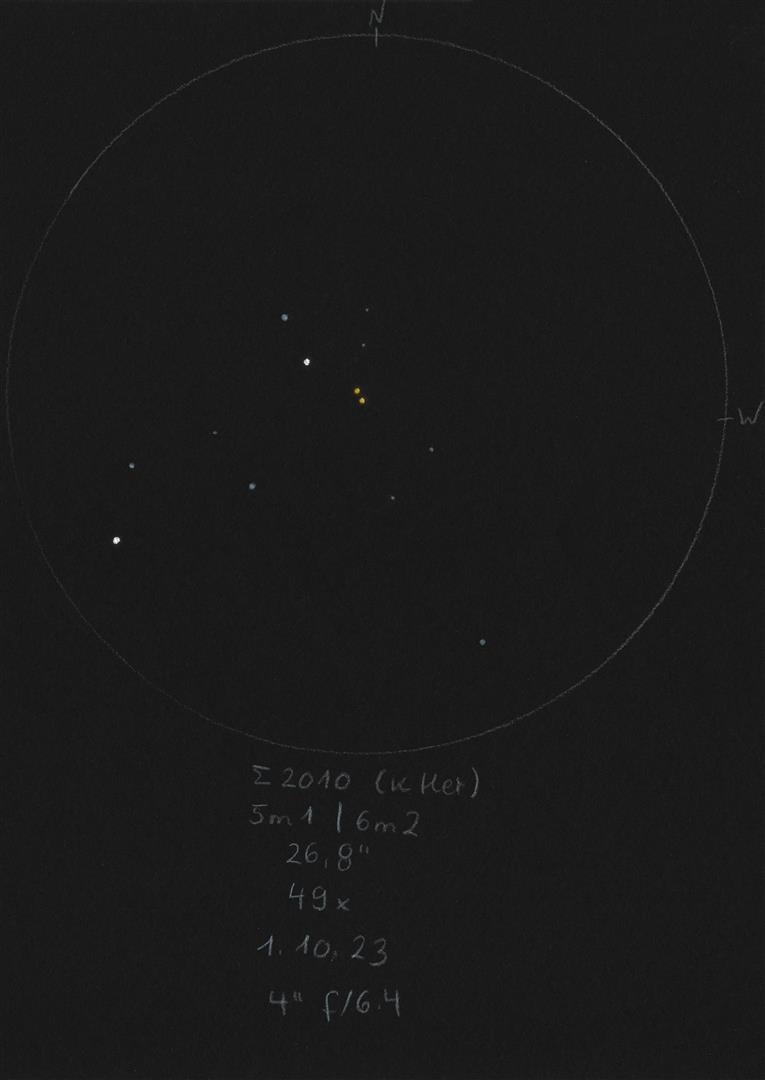
|
René Merting
Drachhausen (Germany) |
107mm (30x) |
AB: bei 30x ein auffallendes Sternpaar, A im Süden wirkt hellgelb, B mit einem schönen Farbkontrast, der nicht greifbar ist, sondern eher changierend - Trennung ordentlich - bei 144x ist B dann weißgelblich und die beiden Sterne zeigen sich weiter als schickes Farbpaar |
|
Axel Tute
Küssaberg (Germany) |
200mm (77x) |
AB: 02.07.2006: Nice pair. A is blue. B is green. Separated with the 26mm Plössl (77x). The estimated PA is 10°. |
|
Karsten Kopp
Köln (Germany) |
600mm (135x) |
AB: Sehr einfacher Doppelstern.
Komponente A erscheint orange, während die Komponente B weiß scheint. |
|
|
|
★
|
nu Sco, 14 Sco, Jabbah |
BU120 |
AB |
4m.3 |
5m.3 |
1.4" |
1° |
2021 |
Sco |
16h11m59.74s / -19°27'38.30" |
|
|
|
H5 6 |
AC |
4m.3 |
6m.6 |
41.3" |
336° |
2019 |
|
|
|
|
|
MTL2 |
CD |
6m.6 |
7m.2 |
2.4" |
55° |
2019 |
|
|
Christopher Hay
Seeheim (Germany) |
15x45 |
AC: Stabilised binoculars, handheld. Widely separated. Nice pair reminiscent of Beta Lyrae at 10x. Also split clearly in stabilised handheld 10x42, but view not as pleasing as in 15x45. |
|
Christopher Hay
Seeheim (Germany) |
15x60 |
AC: Wide split. Secondary faint blue, a fine contrast to the very slightly yellowish-white primary. |
|
René Merting
Drachhausen (Germany) |
18x70 |
AC: ein schönes Sternpaar mit einem leichten Farbkontrast - Komponente A im SSO ist leicht gelblich, die schwächere C-Komponente weißbläulich - A ist nicht ganz rund, aber das kann auch vom FG herrühren |
|
|
|
|
SHJ225 |
|
AB |
7m.4 |
8m.1 |
47.1" |
333° |
2018 |
Sco |
16h20m05.49s / -20°03'23.00" |
René Merting
Drachhausen (Germany) |
10x35 |
ein Paar mit zwei sehr feinen, gleich hellen Sternen - Trennung einfach erkennbar |
|
René Merting
Drachhausen (Germany) |
15x56 |
ein komfortabel getrenntes Sternpaar - Helligkeitsunterschied eine halbe Größenklasse |
|
René Merting
Drachhausen (Germany) |
18x70 |
ein bequem getrenntes Sternpaar - Komponente B im NNW ist eine halbe Magnitude schwächer |
|
|
|
|
SHJ226 |
|
CE |
7m.6 |
8m.3 |
12.6" |
20° |
2019 |
Sco |
16h20m30.58s / -20°06'51.80" |
René Merting
Drachhausen (Germany) |
15x56 |
Trennung nicht möglich, aber mit einiger Konzentration ist das Sternpaar leicht länglich erkennbar |
|
René Merting
Drachhausen (Germany) |
18x70 |
ein genauer Blick lohnt sich, dann ist C knapp getrennt nordnordöstlich von AB erkennbar - interessant wird dieses Sternpaar im Zusammenhang mit dem nahe stehenden Doppelstern SHJ 225 - beide Sternpaare unterscheiden sich deutlich und stehen schön isoliert |
|
|
|
★★
|
nu CrB, nu 1/2 CrB, 20 CrB |
STFA29 |
AB |
5m.4 |
5m.6 |
354.7" |
164° |
2011 |
CrB |
16h22m21.42s / +33°47'56.90" |
|
|
|
HN 81 |
AC |
5m.4 |
12m.6 |
68.1" |
241° |
2002 |
|
|
|
|
|
STFA29 |
AD |
5m.4 |
11m.5 |
277.2" |
153° |
2020 |
|
|
|
|
|
H6 18 |
BD |
5m.6 |
11m.5 |
98.7" |
16° |
2020 |
|
|
Christopher Hay
Seeheim (Germany) |
7x45 |
AB: A strong, well separated pair. Both orangish, Nu1 with a touch of yellow.
Nicely framed in 8.6° FOV with globular cluster M13, which presents as a fluffy little ball under a NELM 5m2 sky. |
|
René Merting
Drachhausen (Germany) |
18x70 |
AB: auffallend, zwei gleichhelle Sterne weit getrennt - die südliche Komponente strahlt zartgelb |
|
Sarah Gebauer
Germany |
100mm (21x) |
STFA29 (AB): bei 21-fach sehr weit getrennt, nicht mehr als Doppelstern zu erkennen, wären da nicht die nahezu gleiche Helligkeit und ähnliche Farbe von A und B, die aprikosengelb wirken - ein sehr strahlendes Paar, das im Sternumfeld mit einigen schwächeren Sternchen hervorsticht |
|
Christopher Hay
Seeheim (Germany) |
101mm (51x) |
AB: Extremely wide apart but still holding together very strongly thanks to identical, substantial brightnesses and identical yelowish-orange colours. Very impressive in 1.6° FOV. |
|
René Merting
Drachhausen (Germany) |
107mm (30x) |
bei 30x ein wunderschönes Sternpaar zweier gleichheller Sterne - beide strahlen in einem schönen warmgelben Farbton, wie ein klares Schlüsselblumengelb, die nördliche Komponente ist dabei noch ein kleines bisschen intensiver |
|
René Merting
Drachhausen (Germany) |
320mm (72x) |
AB: bei 72x ein weit auseinander stehendes helles Pärchen - die nördliche Komponente ist leicht heller - diesen Doppelstern macht die relativ gleiche hellgelbe Färbung beider Komponenten aus - was diesen Doppelstern noch ausmacht, dass beide hellen Komponenten einen schwachen Begleiter haben
AC: bei 72x blinkt bei der nördlichen A-Komponente südwestlich ein schwacher Lichtpunkt auf, Abstand ordentlich
BD: bei 72x steht bei der südlichen B-Komponente ein schwacher Lichtpunkt nordöstlich, D ist etwas weiter entfernt, als der Abstand AC - ein schickes Quartett |
|
Mark McCarthy
Fremont (California/USA) |
508mm (667x) |
STFA29 (AD): Nu 1 CrB. Nice bright orange finder split. AD is a wide faint star in the scope |
|
|
|
★★★
|
STF2078 & STFA30, 16/17 Dra |
STF2078, 17 Dra |
AB |
5m.4 |
6m.4 |
2.9" |
104° |
2021 |
Dra |
16h36m13.72s / +52°55'27.80" |
|
|
|
STFA30, 16/17 Dra |
AC |
5m.4 |
5m.5 |
90.2" |
193° |
2018 |
|
|
Christopher Hay
Seeheim (Germany) |
3x63 |
Clean split. Separation is much clearer than that of Nu1/2 Dra (STFA35), which is also in 14° FOV and is hair-fine split.
A physical double at a distance to us of 412 light years. |
|
Christopher Hay
Seeheim (Germany) |
7x45 |
A well split and nicely compact pair. When 16/17 Dra is put at the edge of the 8.6° field of view, Nu1/2 Dra stands at the opposite edge. Their comparison thus suggests itself. 16/17 is somewhat wider than Nu1/2. While the components of Nu1/2 are of equal brightness and whiteness, those of 16/17 display a slight difference in both brightness and colour. 17 (A) first seems bluer than 16 (C), but after 20 seconds this impression flips to C and from then on goes back and forth. |
|
Robert Zebahl
Leipzig (Germany) |
55mm (27x) |
STFA30 (AC): Rather wide pair with almost equal components. C component appeared slightly yellowish-orange. |
|
Robert Zebahl
Leipzig (Germany) |
55mm (71x) |
Grand sight! |
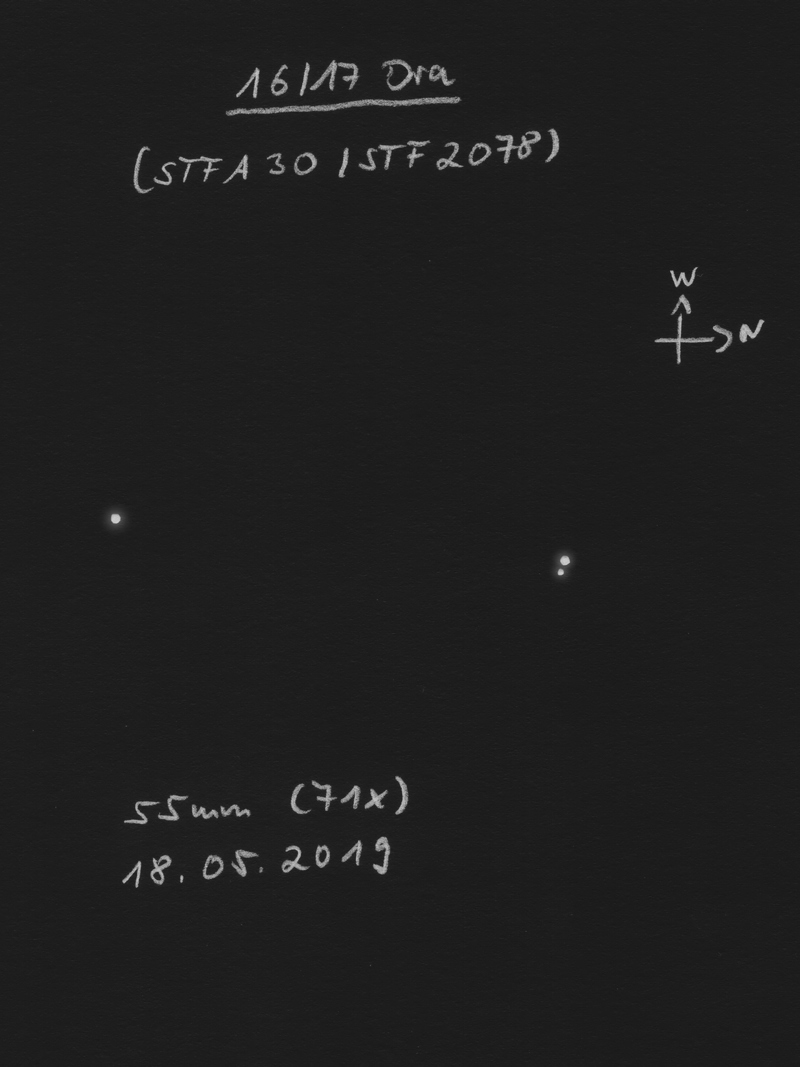
|
Christopher Hay
Seeheim (Germany) |
80mm (30x) |
16 Dra seems more bluish than 17 Dra, the latter seems slightly yellow in comparison and is distinctly elongated. At 84x 17 Dra is cleanly split and such a delightful view together with 16 Dra that I had no desire to ramp up the magnification. All three stars belong to a physical system. |
|
Sarah Gebauer
Germany |
100mm (80x) |
01.10.23: das Doppel 16/17 Dra zeigt bei 80-fach zum ersten Mal eine feine, warmweiße B-Komponente extrem knapp östlich neben der warmweißen, leicht gelblichen A-Komponente - Komponente C im Süden strahlt reinweiß und wirft einen ebenso großen Halo wie AB zusammen, sodass sich beide Halos überlagern - die D-Komponente ist als grauer, schwacher Stern südöstlich versetzt zu sehen |
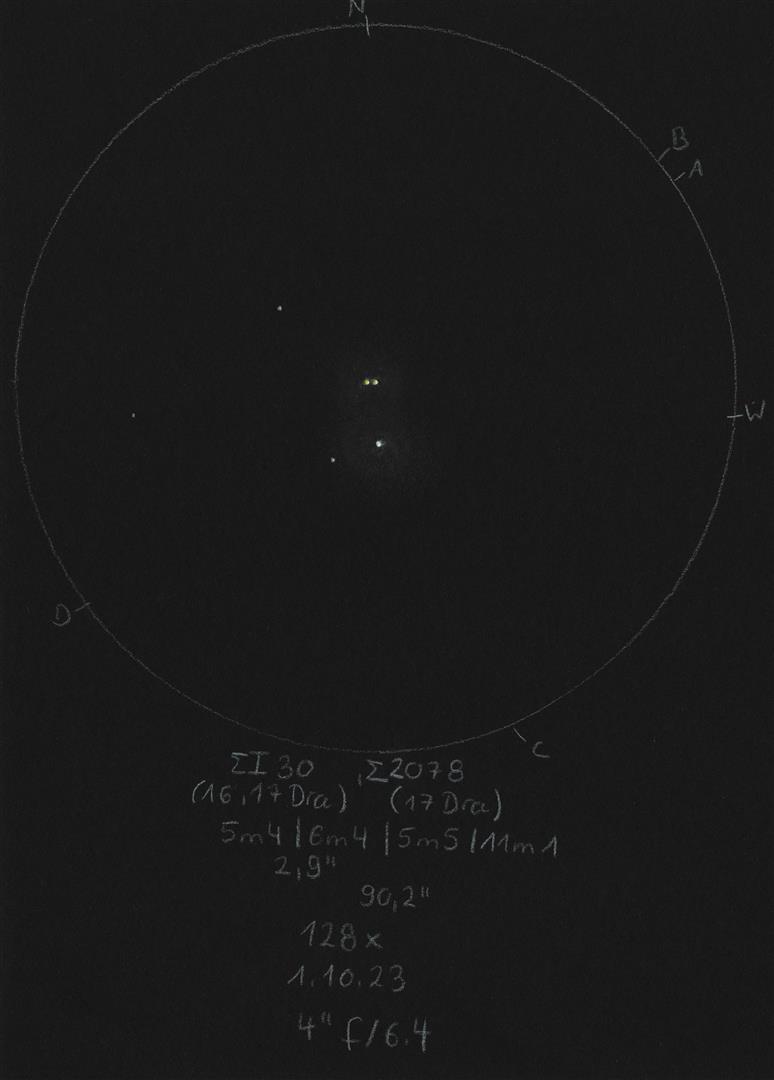
|
René Merting
Drachhausen (Germany) |
100mm (107x) |
AB: bei 64x noch ein Stäbchen, bei 107x ist B dann knapp getrennt östlich von A erkennbar - B ist auch noch relativ hell bzw. maximal eine Magnitude schwächer
AC: bei 32x weit auseinander stehend - Komponente C im Süden ist maximal eine viertel Magnitude schwächer - leichter Farbkontrast, A weißgelb und C kühlweiß |
|
Frederik Wanink
Itterbeck (Germany) |
254mm (640x) |
STF2078 (AB): sehr schönes Dreiersystem |
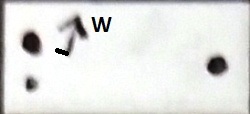
|
|
|
|
STF2079 |
|
|
7m.6 |
8m.1 |
16.7" |
91° |
2017 |
Her |
16h39m36.33s / +23°00'06.10" |
Robert Zebahl
Leipzig (Germany) |
16x70 |
2021-05-31: Nicely separated, very striking. The double star is located at the northern edge of a prominent group of stars. The components appear slightly orange and light blue with a moderate difference in brightness. Colors changed between components during observation. Worthwhile. |
|
René Merting
Drachhausen (Germany) |
18x70 |
zwei sehr dicht zusammenstehende Sterne, knapp getrennt - die B-Komponente im Osten ist nur ganz knapp schwächer - schön fürs Fernglas |
|
René Merting
Drachhausen (Germany) |
100mm (20x) |
bei 20x locker getrennt, aber richtig schön bei 32x, dann ein weit getrenntes Pärchen - Komponente B im Osten schätze ich gut eine halbe Magnitude schwächer als A ein - schöne Farbkombination, A ist Gelblichweiß, B ist Zinnoberrotbraun |
|
René Merting
Drachhausen (Germany) |
107mm (30x) |
bei 30x ein auffallendes Sternpaar, beide ordentlich getrennt - Komponente B im Osten ist nur knapp schwächer und wirkt Kühlweiß gegen die warmweiß strahlende A-Komponente |
|
Mark McCarthy
Fremont (California/USA) |
152mm (175x) |
Wide, white, near equal |
|
Mark McCarthy
Fremont (California/USA) |
317mm (277x) |
Wide separation, half delta mag. A is yellowish and B slight red tint |
|
René Merting
Drachhausen (Germany) |
320mm (72x) |
bei 72x ein gut getrenntes Sternpaar, auffällig - B im Osten ist eine viertel Magnitude schwächer und strahlt graublau - A ist weiß, dadurch leichter Farbkontrast |
|
Karsten Kopp
Köln (Germany) |
600mm (180x) |
Einfacher Doppelstern mit geringem Helligkeitsunterschied. Beide Komponenten erstrahlen gelblich-weiß. |
|
|
|
|
SHJ247, nu Ser, 53 Ser |
|
|
4m.3 |
9m.4 |
45.6" |
25° |
2015 |
Ser |
17h20m49.66s / -12°50'48.80" |
René Merting
Drachhausen (Germany) |
15x56 |
Komponente A ist so gleißend hell, dass B nur mit viel Konzentration nordöstlich von der Hauptkomponente erkennbar ist - Trennung ordentlich - Helligkeitsunterschied enorm |
|
René Merting
Drachhausen (Germany) |
18x70 |
nordnordöstlich von A ploppt die B-Komponente in ordentlichem Abstand ganz schwach auf - A ist weißgelb, B wirkt braun - trotz des riesen Helligkeitsunterschiedes ein schönes Sternpaar |
|
René Merting
Drachhausen (Germany) |
76mm (29x) |
bei 29x ist Komponente B mit ordentlich Abstand nordöstlich von der wunderschön weißgelblich strahlenden Komponente A zu erkennen - B ist deutlich schwächer und wirkt dadurch bräunlich |
|
|
|
★★
|
STFA35, nu Dra, nu 1/2 Dra, 24/25 Dra |
|
|
4m.9 |
4m.9 |
62.3" |
311° |
2021 |
Dra |
17h32m15.88s / +55°10'22.10" |
Christopher Hay
Seeheim (Germany) |
3x63 |
Hair-fine split.
A physical double at a distance to us of 99 light years. |
|
Christopher Hay
Seeheim (Germany) |
7x45 |
Well split and very compact. A very evenly matched pair, both colourless. Attractive in 8.6° FOV together with the rest of the head of the dragon, namely Beta, Gamma and Xi Dra (Rastaban, Etamin, Grumium). |
|
Christopher Hay
Seeheim (Germany) |
10x42 |
Clearly split, components of identical brightness, no colour. One of the finest doubles for 10x. |
|
René Merting
Drachhausen (Germany) |
16x70 |
der Doppelstern ist bereits mit bloßem Auge zu erkennen, im FG dann offenbart sich ein ordentlich getrenntes Pärchen zweier gleich heller Sterne |
|
René Merting
Drachhausen (Germany) |
18x70 |
zwei sehr helle reinweiße Sterne, komfortabel voneinander getrennt - sehr auffällig |
|
René Merting
Drachhausen (Germany) |
100mm (32x) |
bei 32x ein schönes, auffallendes Pärchen zweier gleich heller Sterne - beide sind komfortabel getrennt erkennbar und präsentieren sich weiß |
|
Sarah Gebauer
Germany |
100mm (50x) |
Nu1 und Nu2 Draconis starrt mich so richtig eindringlich als Augenpaar an, sie stehen in einem ansonsten ganz leeren, schwarzen Umfeld |
|
Robert Zebahl
Leipzig (Germany) |
102mm (28x) |
Wide, bright, equal pair. Both components looked cream-white. Due to the distance a double for binoculars. |
|
René Merting
Drachhausen (Germany) |
107mm (30x) |
die zwei Wölfe im Drachen zeigen sich bei 30x ordentlich getrennt schön strahlend hellgelb und gleich hell, die südliche Komponente strahlt minimal gelber - einfach immer wieder schön im Umfeld anzuschauen |
|
Christopher Hay
Seeheim (Germany) |
125mm (80x) |
Gorgeous sight, widely split, dominating the FOV. The more northern B-component (=Nu1 Dra = 24 Dra) appears brighter and more yellowish than the A-component (=Nu2 Dra = 25 Dra). |
|
Sarah Gebauer
Germany |
150mm (85x) |
auf den ersten Blick "zwei Augen", die mich anleuchten, ansonsten aufgrund der wenigen Feldsterne eher unspektakulär |
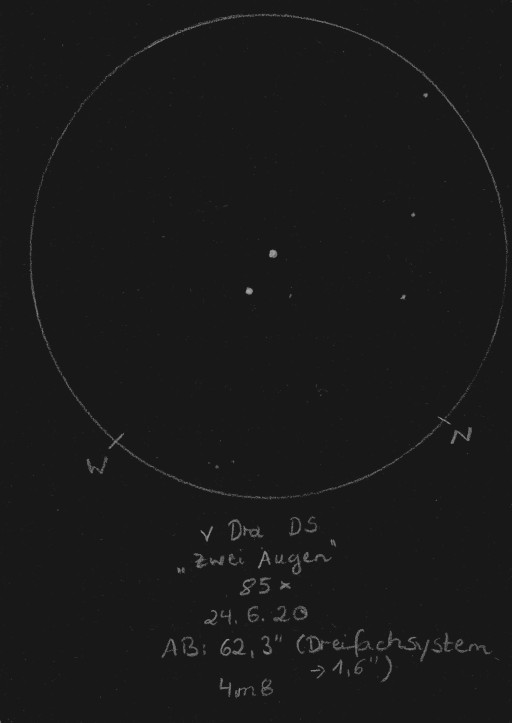
|
René Merting
Drachhausen (Germany) |
320mm (45x) |
bei 45x zwei wunderschöne Diamanten, gleich hell - beide strahlen cremeweiß - sehr auffällig im Umfeld |
|
|
|
★★
|
STF2241, psi 1 Dra, 31 Dra |
|
AB |
4m.6 |
5m.6 |
29.6" |
14° |
2019 |
Dra |
17h41m56.36s / +72°08'55.80" |
Sarah Gebauer
Germany |
12x42 |
sehr hell und schon schön getrennt mit warmweißem Farbeindruck |
|
Christopher Hay
Seeheim (Germany) |
15x45 |
Stabilised binoculars, handheld. Easily split. A appears pearl white, B brick red. A very fine pair for 15x. Resolved in stabilised 10x42 but not so pleasantly. Psi1 Dra is a physical double with a period of roughly 10,000 years. |
|
René Merting
Drachhausen (Germany) |
16x70 |
ein auffälliges Pärchen in einem wilden Sterngewimmel vieler heller Sterne, beide Komponenten sind knapp getrennt zu erkennen - Komponente B ist mindestens eine Größenklasse schwächer und strahlt nicht so schön reinweiß wie A |
|
Christopher Hay
Seeheim (Germany) |
80mm (30x) |
Widely split. A light yellow, B light blue. |
|
Sarah Gebauer
Germany |
100mm (21x) |
bei 20-fach ein schmales, helles und warmweiß-golden strahlendes Pärchen, sehr dominant und schön |
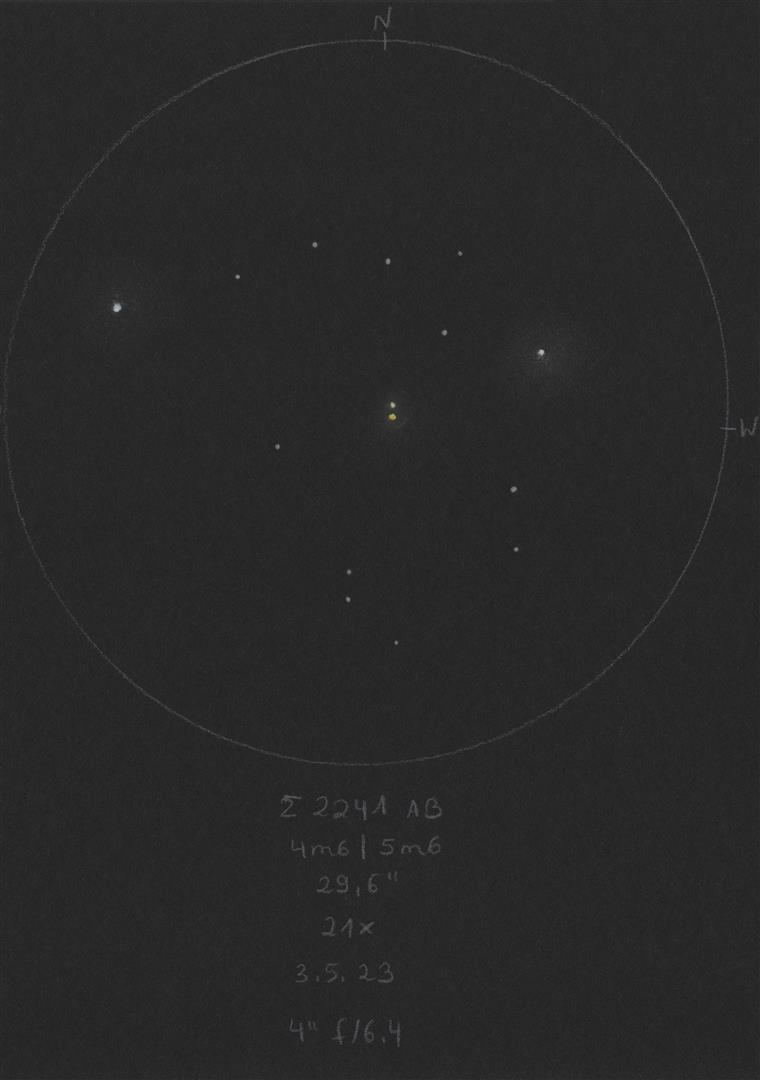
|
Uwe Pilz
Leipzig (Germany) |
105mm (55x) |
weiß-orange |
|
Sarah Gebauer
Germany |
254mm (49x) |
bei 49-fach ein fast gleich helles Paar mit zwei sehr warmen, hell strohgelben Komponenten – ein sehr durchdringendes Augenpaar – die dritte Komponente, die direkt nach Osten weist, ist auch noch ganz schwach zu sehen |
|
René Merting
Drachhausen (Germany) |
320mm (144x) |
die beiden bei 144x gut getrennten Sterne strahlen blass goldgelb mit relativ großen Halos, die sich überlagern, B im Nordosten ist etwa eine halbe bis dreiviertel Größenklasse schwächer als A |
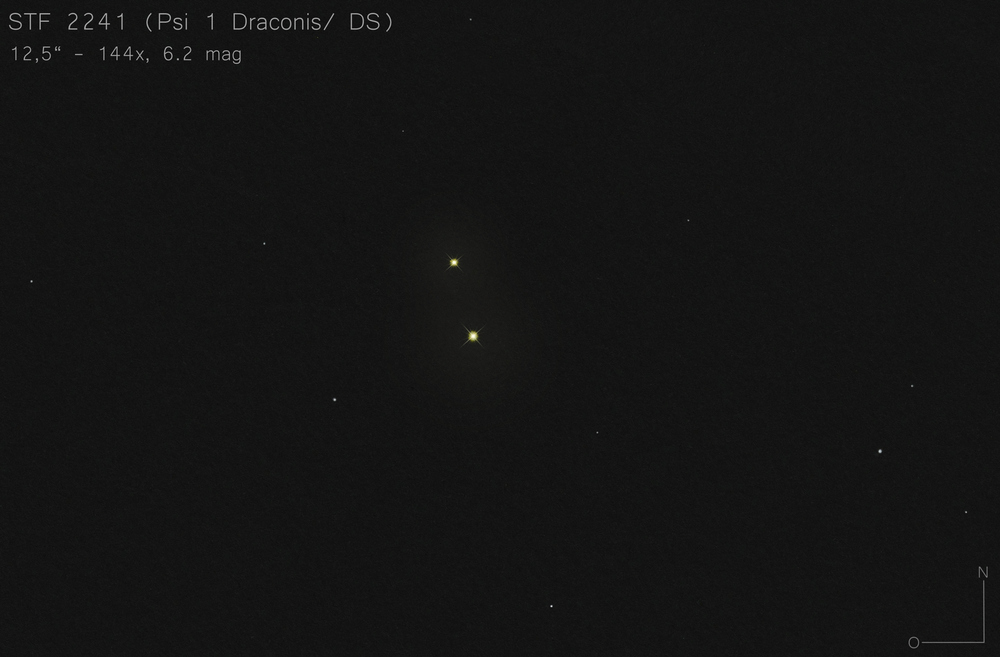
|
René Merting
Drachhausen (Germany) |
320mm (144x) |
die beiden bei 144x gut getrennten Sterne strahlen blass goldgelb mit relativ großen Halos, die sich überlagern, B im Nordosten ist etwa eine halbe bis dreiviertel Größenklasse schwächer als A |
|
|
|
★★★
|
STF2202, 61 Oph |
|
AB |
6m.1 |
6m.5 |
20.8" |
92° |
2019 |
Oph |
17h44m34.09s / +02°34'45.90" |
René Merting
Drachhausen (Germany) |
8x30 |
die B-Komponente ist östlich von A erkennbar, lässt sich aber noch nicht trennen - eine klassische Ameise |
|
René Merting
Drachhausen (Germany) |
10x35 |
ein richtig schöner Doppelstern für 10-fache Vergrößerung - zwei gleich helle Sterne, knapp getrennt |
|
René Merting
Drachhausen (Germany) |
10x50 |
ein ausgesprochen schönes knapp getrenntes Sternpaar - beide Sterne sind in etwas gleich hell - Komponente B im Osten ist nicht ganz so weiß wie A |
|
René Merting
Drachhausen (Germany) |
15x56 |
wunderschön - ein sauber getrenntes Sternpaar, wobei B im Osten nur minimal schwächer wirkt - beide Sterne zeigen sich strahlend weiß |
|
René Merting
Drachhausen (Germany) |
16x70 |
ein schön eng stehendes Pärchen, knapp getrennt - Komponente A im Westen ist nur leicht heller als B - beide Komponenten wirken weiß |
|
Uwe Pilz
Leipzig (Germany) |
16x70 |
beide gelb |
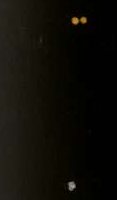
|
René Merting
Drachhausen (Germany) |
100mm (20x) |
bei 20x leicht zu trennen - Komponente B im Osten ist nur minimal schwächer (keine halbe Größenklasse, denke ich) - Komponente A stahlt ein wenig wärmer als B |
|
Sarah Gebauer
Germany |
150mm (30x) |
bei geringer Vergrößerung (30x) schon sauber getrennt, beide Sterne wirken gleich groß und gleich hell, ein nettes Pärchen |
|
Sarah Gebauer
Germany |
150mm (54x) |
zwei nicht ganz enge Glanzpünktchen in einer eher uninteressanten Umgebung |
|
Mark McCarthy
Fremont (California/USA) |
203mm (667x) |
Half delta mag wide separation white. |
|
|
Berthold Fuchs
Wiesbaden (Germany) |
130mm |
easy DS |
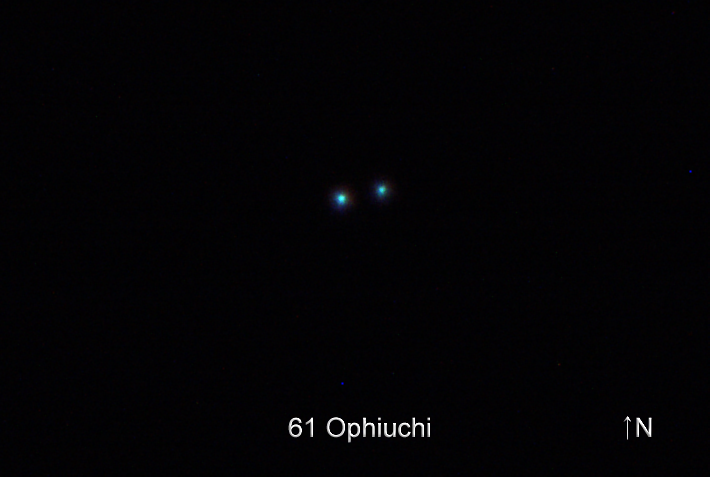
|
|
|
|
STF2259 |
|
|
7m.3 |
8m.4 |
19.6" |
277° |
2017 |
Her |
17h59m03.63s / +30°02'56.10" |
René Merting
Drachhausen (Germany) |
10x50 |
Komponente B ist knapp getrennt westlich von A erkennbar - Helligkeitsunterschied eine halbe Magnitude (1.17 mag laut Stelle Doppie) - der Doppelstern muss sich gegen viele helle Sterne im Umfeld durchsetzen, er wirkt dadurch ein wenig verloren, aber auch filigraner |
|
René Merting
Drachhausen (Germany) |
18x70 |
ein schöner FG-Doppelstern - zwei eng stehende Sterne - Komponente B ist gut eine dreiviertel Größenklasse schwächer |
|
Robert Zebahl
Leipzig (Germany) |
70mm (22x) |
2020-07-30: At 22x clearly split with noticeable difference in brightness. The components appeared yellowish & grey-bluish. At 44x the colors appeared a bit more intense: yellowish to bright orange & subtle blue. |
|
Axel Tute
Küssaberg (Germany) |
70mm (78x) |
12.08.2009: Simple. A reddish. Nü bluish. |
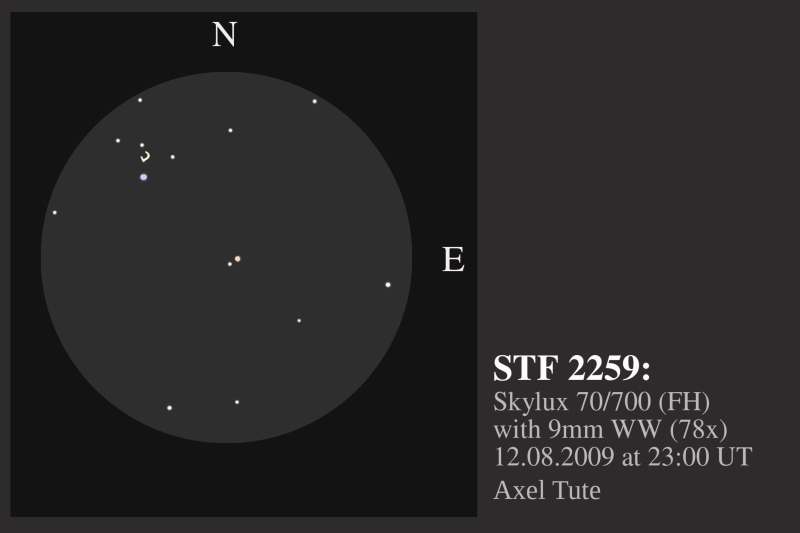
|
René Merting
Drachhausen (Germany) |
100mm (20x) |
bei 32x ein gut getrenntes Paar mit einem schönen Farbkontrast - Komponente B im Westen ist eine Größenklasse schwächer - A weißgelb, B blaugrau - auch bei 20x zeigt sich das Pärchen gut getrennt |
|
Mark McCarthy
Fremont (California/USA) |
317mm (553x) |
Orange and slightly blue tnged B, 2 delta mag, wide, 15" or more. |
|
|
|
★★
|
STF2308 |
40/41 Dra |
AB |
5m.7 |
6m.0 |
18.9" |
232° |
2022 |
Dra |
18h00m09.07s / +80°00'13.70" |
|
|
|
|
AC |
5m.7 |
8m.3 |
225.3" |
129° |
2017 |
|
|
|
|
Robert Zebahl
Leipzig (Germany) |
8x44 |
2020-06-27: The pair AB split, but very tight with components of equal brightness. In acute angle far apart the component C was also visible. |
|
Christopher Hay
Seeheim (Germany) |
15x45 |
AB: Clearly split, brighter component seems bluish. One of the finest doubles for 15x, hence my two-star rating. In 10x42 a difficult split at the limit. |
|
René Merting
Drachhausen (Germany) |
16x70 |
ein schön eng stehendes Pärchen, die Himmelsrichtungen erschließen sich mir hier leider nicht, aber die Komponenten sind beide ähnlich hell und weiß - schöner Anblick im Fernglas |
|
Christopher Hay
Seeheim (Germany) |
50mm (8x) |
AB: An elongated figure-8 very close to splitting |
|
Christopher Hay
Seeheim (Germany) |
80mm (30x) |
AB: Very clearly split, dominates the 2.5° FOV, with interesting sprinkling of fainter stars throughout the field. |
|
Sarah Gebauer
Germany |
100mm (49x) |
AB: bei 50-fach sehr eindeutig getrennt - zwei helle Augenpunkte, die beide warmweiß und leicht gelb strahlen |
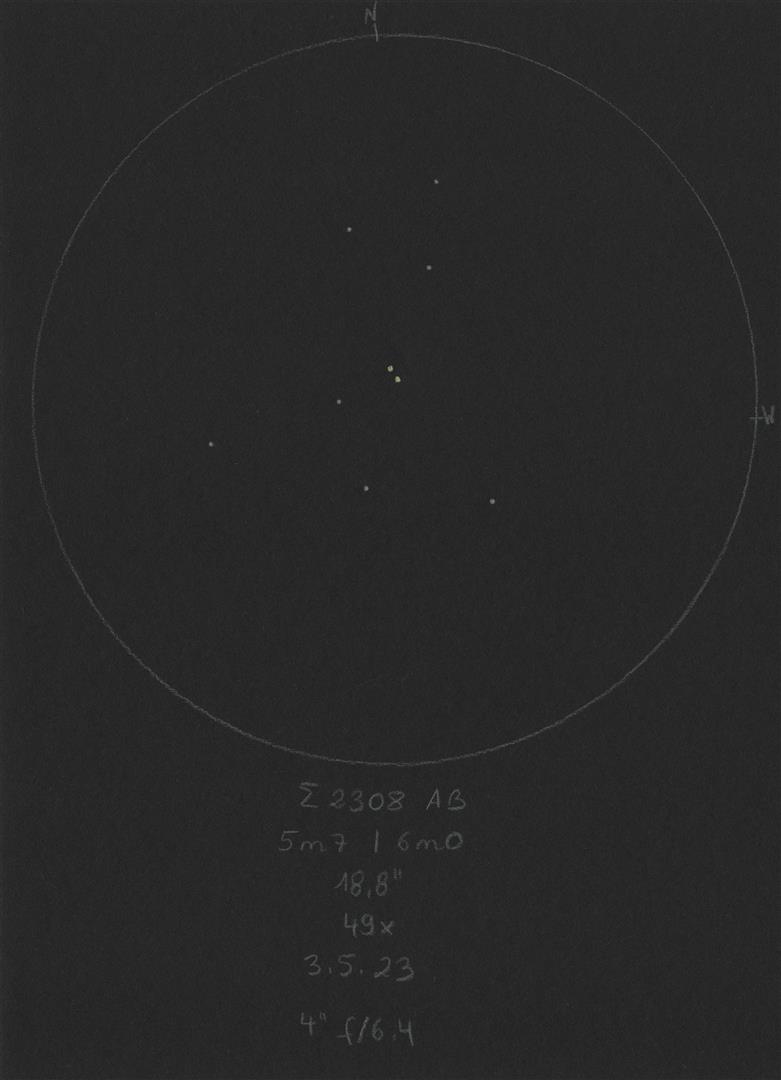
|
Robert Zebahl
Leipzig (Germany) |
102mm (28x) |
Very nice, slightly uneven pair. Components appeared yellowish-white. Beautiful surroundings. On the sketch the components A, B and C are visible. |
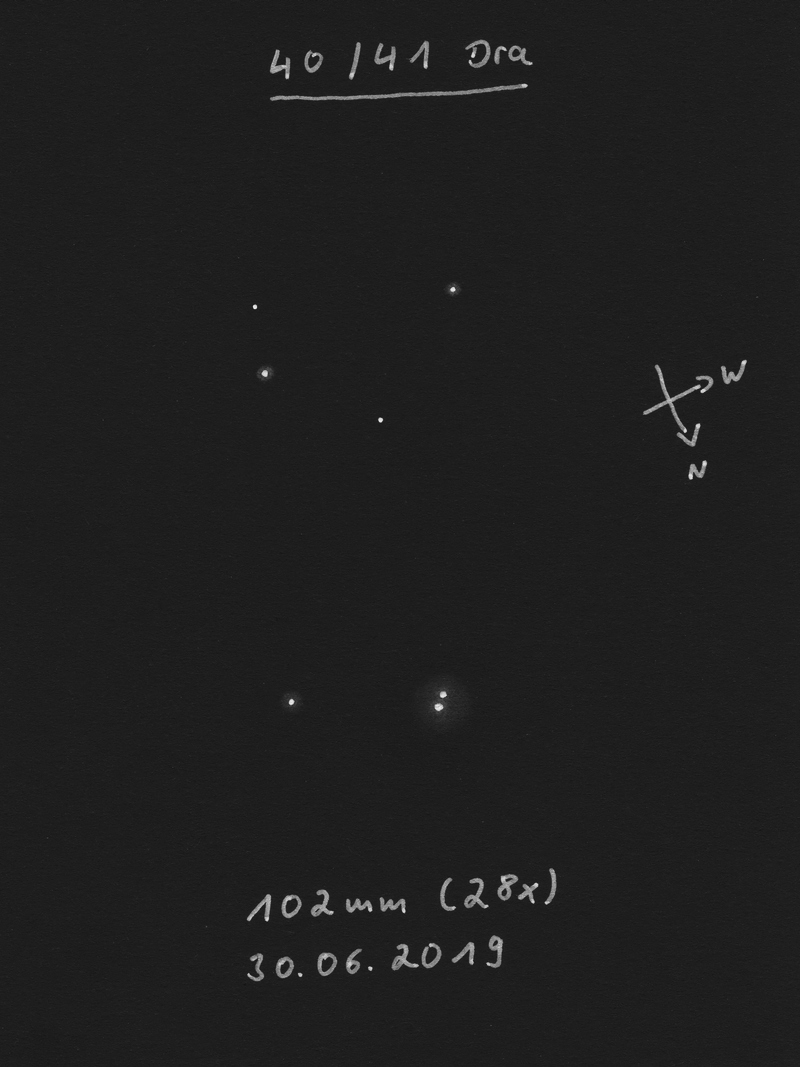
|
Uwe Pilz
Leipzig (Germany) |
105mm (100x) |
AB: =40/41 Dra. Auffallend |
|
Christopher Hay
Seeheim (Germany) |
140mm (75x) |
AB: Wide apart, the pair absolutely dominates the field of view, with attractive sprinkling of fainter stars to the west. Very delicate colour contrast that was hard to grasp in 3-inch scope now becomes clear, component B (40 Dra) is bluish, component A (41 Dra) yellowish. |
|
|
|
★
|
H6 2, 67 Oph |
|
AC |
4m.0 |
8m.1 |
54.7" |
143° |
2019 |
Oph |
18h00m38.72s / +02°55'53.70" |
René Merting
Drachhausen (Germany) |
10x35 |
zwischen beide Sterne passt maximal ein halbes Blatt Papier - C im Südosten kommt mir entgegen aller früheren Erfahrungen nicht so schwach vor wie sonst, ich würde hier nur auf maximal eine Größenklasse schätzen, eigenartig |
|
René Merting
Drachhausen (Germany) |
10x50 |
ein einfacher Doppelstern - Komponente C steht mit gutem Abstand südöstlich von A - Komponente A ist gleißend weiß, C wirkt dagegen richtiggehend grau-braun |
|
Christopher Hay
Seeheim (Germany) |
15x45 |
Stabilised binoculars, handheld. Components wide apart, almost too wide to appear as a double star. Secondary a fine speck of light beside the primary, which is >4mag brighter. According to Stelledoppie a true physical pair at a distance of 1230 light years. It is interesting to contemplate that at this distance in space the companion still looks so separate. “H“ in the catalogue name means that this double star is listed in the catalogue of W. Herschel. The 6 in the name means that it is a double star of the 6th Class [separation 1’ or larger] in Herschel’s system. |
|
René Merting
Drachhausen (Germany) |
16x70 |
auf den ersten Blick bin ich enttäuscht, weil ich nur einen hell strahlenden Stern erkennen kann - dann aber mit etwas Konzentration ist südöstlich von der Leuchtgranate ein ganz schwacher Begleiter zu erkennen - ein sehr ungleiches Paar mit geschätzt 4 Größenklassen Unterschied - Komponente C wirkt rotbraun und steht ordentlich getrennt von A |
|
Uwe Pilz
Leipzig (Germany) |
16x70 |
der helle ist gelb-weiß |

|
Christopher Hay
Seeheim (Germany) |
25x80 |
Very far apart, almost so far as to appear to not belong together. However, in the 3° field of view 70 Ophiuchi, which is also a physical double, is seen to be also split. Thus a very attractive field overall.
67 Oph and 70 Oph are the left and right nostrils of the bull in the old constellation Taurus Poniatowski (Poniatowski’s Bull). 68 Oph (the tip of the bull’s nose) and 73 Oph (the bull’s right eye) are also double stars, but can’t be split at 25x. All four doubles – 67, 68, 70 and 73 Oph – are physical, a rare assemblage! |
|
René Merting
Drachhausen (Germany) |
100mm (20x) |
bei 20x großer Abstand zwischen beiden Sternen - weil Komponente A so gleißend hell strahlt, fehlt der mindestens um 3 Größenklassen schwächeren Komponente C im SO die Farbe, eher gräulich |
|
Sarah Gebauer
Germany |
254mm (49x) |
zentral inmitten von Taurus Poniatowski/Melotte 186 liegt dieser schöne Doppelstern mit einer hellen, sehr warmweißen Komponente und weit abgesetzt bei 49-fach einem deutlich schwächeren Begleiter |
|
|
|
|
STF2278 |
|
AB |
7m.8 |
8m.1 |
35.1" |
31° |
2022 |
Dra |
18h02m52.88s / +56°25'40.30" |
|
|
|
|
AC |
7m.8 |
8m.5 |
33.6" |
38° |
2017 |
|
|
|
|
|
|
AD |
7m.8 |
10m.2 |
197.9" |
189° |
2022 |
|
|
|
|
|
|
BC |
8m.1 |
8m.5 |
6.0" |
146° |
2018 |
|
|
Christopher Hay
Seeheim (Germany) |
10x42 |
AB: Handheld binoculars with internal stabilisation. Well split. Spidery-fine, well matched pair. |
|
René Merting
Drachhausen (Germany) |
18x70 |
A und BC sind getrennt zu erkennen, sehr dicht zusammen stehend, unauffällig - B und C kann ich nicht trennen |
|
Sarah Gebauer
Germany |
100mm (49x) |
bei 50-fach sind im Norden zwei sehr eng beisammen stehende, gleich helle Sternpünktchen und eher weit entfernt im Süden die dritte Komponente - ein hübsches Dreifachsystem |
|
Mark McCarthy
Fremont (California/USA) |
203mm (205x) |
AB: Pretty white-blue stars, in a 2+1 set. Not physical |
|
René Merting
Drachhausen (Germany) |
320mm (72x) |
bei 45x erkenne ich drei Sterne, ein Ameisenpaar (BC) und Komponente A im Südwesten davon - bei 72x ist das Ameisenpaar getrennt erkennbar, die westliche Komponente ist minimal schwächer - auf D habe ich nicht geachtet |
|
|
|
★
|
STF2280, 100 Her |
|
AB |
5m.8 |
5m.8 |
14.3" |
182° |
2019 |
Her |
18h07m49.56s / +26°06'04.40" |
René Merting
Drachhausen (Germany) |
10x35 |
ein 8, eine Einschnürung ist ab und an erkennbar - Trennung nicht möglich |
|
René Merting
Drachhausen (Germany) |
10x50 |
zwei extrem dicht stehende helle Sterne - noch nicht getrennt, aber schön als 8 erkennbar |
|
Robert Zebahl
Leipzig (Germany) |
16x70 |
2020-07-05: Very nice, rather isolated double star. Striking. Similar bright component, both white. |
|
René Merting
Drachhausen (Germany) |
18x70 |
perfekt für 18-fache Vergrößerung - zwei gleich helle, dicht zusammen stehende Sterne - reinweiß und sehr auffällig, weil keine ähnlich hellen Sterne im Umfeld zu sehen sind |
|
Axel Tute
Küssaberg (Germany) |
70mm (117x) |
16.07.2009: Both light yellow. |
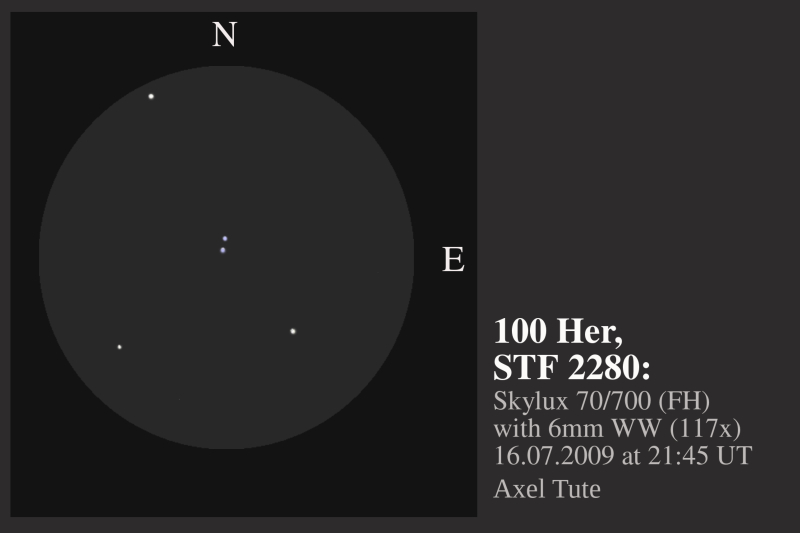
|
René Merting
Drachhausen (Germany) |
100mm (32x) |
bei 32x ein schönes, enges Pärchen zweier gleichheller Sterne - beide gleich hell und reinweiß - zurück auf 20x zeigen sich beide Protagonisten weiterhin ganz knapp getrennt - Komponente B im Süden wirkt leicht gelblich und schwächer |
|
Uwe Pilz
Leipzig (Germany) |
105mm (26x) |
Weiß-orangeweiß |
|
Robert Zebahl
Leipzig (Germany) |
120mm (40x) |
Conditions in the target region: SQM-L 20.5
Very nice, evident double star with equally bright components. |
|
Karsten Kopp
Köln (Germany) |
140mm (94x) |
Doppelstern ist einfach zu trennen. Das besondere ist hier, dass die beiden Sterne recht alleine zu stehen scheinen. Beide erscheinen weiß. |
|
Sarah Gebauer
Germany |
150mm (54x) |
zwei hübsche Glanzpünktchen, die mich an ein Knöpflein mit zwei Löchern erinnern, der "typische" DS für mich: nicht zu eng, nicht zu weit, gleich hell, sehr nett |
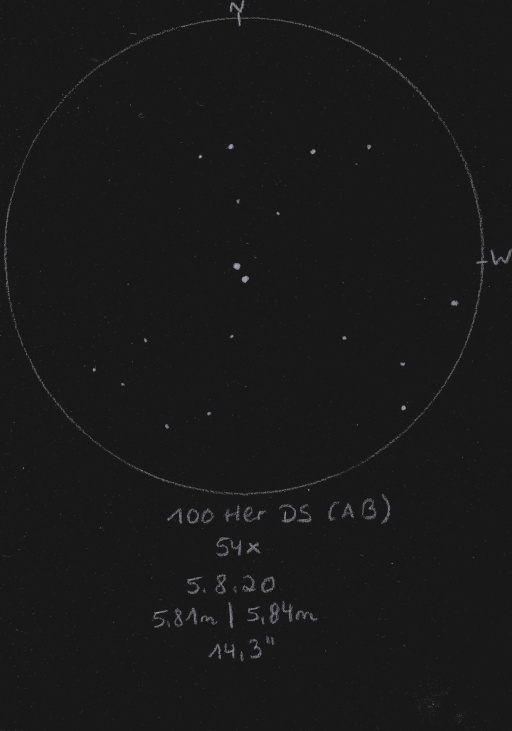
|
Robert Zebahl
Leipzig (Germany) |
152mm (22x) |
Beautiful view. Easy to separate with components of the same brightness. It is noticeable that there are no brighter stars in the immediate vicinity, so that the double star stands out very well. |
|
Mark McCarthy
Fremont (California/USA) |
203mm (205x) |
100 Her. Bright equal wide yellow-white stars. [not physical] |
|
|
Berthold Fuchs
Wiesbaden (Germany) |
130mm |
easy DS |
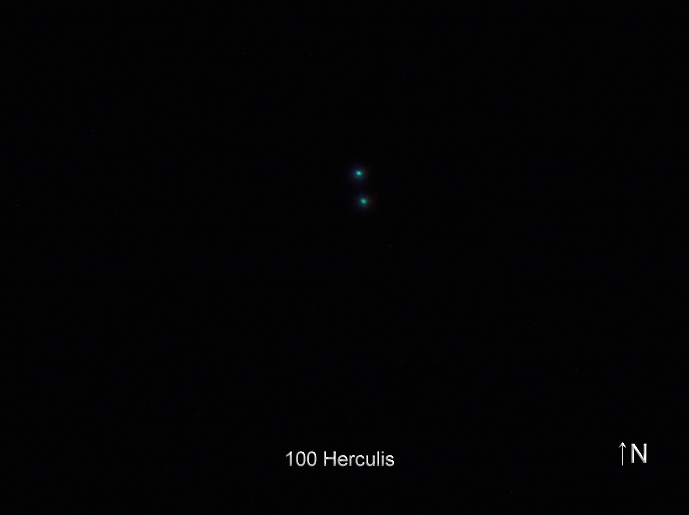
|
|
|
|
STTA167 |
|
|
8m.0 |
9m.1 |
53.0" |
73° |
2016 |
Oph |
18h16m13.87s / +04°34'02.90" |
René Merting
Drachhausen (Germany) |
10x50 |
ordentlich getrennt und mangels Konkurrenz im Umfeld leicht auffindbar - Komponente A ist schwach, B ist nochmal eine Größenklasse schwächer, aber noch problemlos erkennbar |
|
René Merting
Drachhausen (Germany) |
100mm (32x) |
bei 32x leicht zu trennen - Komponente B im NW ich gut eine Magnitude schwächer, deutlich dumpfer und gräulicher, Komponente A dagegen strahlt weiß |
|
|
|
|
STTA168 |
|
AB |
7m.7 |
8m.8 |
47.2" |
161° |
2016 |
Ser |
18h28m33.52s / +04°50'55.20" |
|
|
|
|
AC |
7m.7 |
9m.3 |
244.2" |
217° |
2016 |
|
|
René Merting
Drachhausen (Germany) |
10x50 |
AB: ordentlich getrenntes Sternpaar - Komponente B im Süden ist schon relativ schwach, aber ohne Mühe erkennbar - das Sternpaar steht schön isoliert, da keine vergleichbar hellen Sterne im unmittelbaren Umfeld sichtbar sind |
|
René Merting
Drachhausen (Germany) |
18x70 |
AB: ein sehr entspannter Doppelstern - kein auffallendes Sternpaar - Komponente B steht komfortabel getrennt im Südosten von A und ist 1 bis 1.5 Magnituden schwächer - leichter Farbkontrast |
|
René Merting
Drachhausen (Germany) |
76mm (29x) |
AB: bei 29x ein weit auseinander stehendes Paar - B im Süden ist halb so hell und wirkt blaugrau, A mit strahlend weißer Weste |
|
|
|
|
STF2378 |
|
AB |
8m.9 |
9m.9 |
11.5" |
190° |
2018 |
Lyr |
18h43m21.93s / +35°32'55.30" |
René Merting
Drachhausen (Germany) |
10x50 |
beide Sterne sind nebeneinander stehend erkennbar, aber noch nicht getrennt, schwache Einschnürung nur in guten Momenten |
|
Mark McCarthy
Fremont (California/USA) |
178mm (205x) |
1 delta, white, wide. WDS says its physical due to parallax, and indeed I find 62% overlap in the parallax ranges and a 3,228 AU weighted separation, stellar masses 2.13 & 1.67 -- so may be gravitational. No radial velocity data |
|
|
|
★★★
|
epsilon Lyr |
STF2382, 4 Lyr, epsilon 1 Lyr |
AB |
5m.2 |
6m.1 |
2.2" |
345° |
2021 |
Lyr |
18h44m20.34s / +39°40'12.40" |
|
|
|
STFA37 |
AB-CD |
4m.7 |
4m.6 |
209.4" |
172° |
2021 |
|
|
|
|
|
STFA37 |
AI |
5m.2 |
10m.1 |
150.4" |
137° |
2021 |
|
|
|
|
|
STF2383, 5 Lyr, epsilon 2 Lyr |
CD |
5m.2 |
5m.4 |
2.3" |
75° |
2021 |
|
|
|
|
Christopher Hay
Seeheim (Germany) |
naked eye |
STFA37 (AB-CD): While waiting for Comet Neowise at 3 in the morning in July 2020 surprised myself with my first naked-eye separation of Alpha1 und Alpha2 Capricornis (observing site at 50° northern latitude, Alpha1/2 passing through meridian). Encouraged by this, I lay down and had a close look at Epsilon Lyrae, without really expecting to be able to split it naked-eye, having never succeeded previously. At first Epsilon Lyrae appeared as a very short dash of light. Then the dash resolved into two pinpoints. After 15 years in the hobby and at age 60, at last got Eps Lyr split! No precise prior PA knowledge. After memorising PA as seen naked-eye carefully, confirmed it with binoculars. Eps Lyr is the third-easiest physical double in the (northern hemisphere) summer sky for the naked eye, after Zeta UMa (much easier) und Alpha Lib (marginally easier). |
|
Christopher Hay
Seeheim (Germany) |
2x54 |
STFA37 (AB-CD): Clean split. Actually more pleasant than in 4x10 binoculars, presumably due to more steady handheld view. |
|
Robert Zebahl
Leipzig (Germany) |
55mm (59x) |
STF2382 (AB): At 42x slightly elongated, at 59x elongated and obviously notched. |
|
Robert Zebahl
Leipzig (Germany) |
55mm (59x) |
STF2383 (CD): At 42x clearly elongated, but without any visible notch. At 59x split with touching diffraction disks. |
|
Robert Zebahl
Leipzig (Germany) |
70mm (57x) |
STF2382 (AB): Obviously seen as figure '8'. |
|
Robert Zebahl
Leipzig (Germany) |
70mm (57x) |
STF2383 (CD): Split, but extremely tight with almost touching diffraction disks. |
|
René Merting
Drachhausen (Germany) |
76mm (95x) |
AB-CD: bei 29x schön getrennt erkennbar, ohne dass sich AB und CD schon trennen lassen
AB: bei 57x leicht länglich mit kleiner Einschnürung - bei 95x schön eng getrennt, B nördlich wirkt etwas schwächer- bei 127x wunderschön, das Sternpaar hat zwei Beugungsscheibchen, die wie ein Heiligenschein um die beiden Sterne stehen
CD: bei 57x eine 8 - bei 95x ein schön eng getrenntes Pärchen gleichheller Sterne - bei 127x wunderschön, das Sternpaar hat zwei Beugungsscheibchen, die wie ein Heiligenschein um die beiden Sterne stehen
EF und I: bei 127x sind alle drei Sterne (I 10.1 mag / E 12.3 mag / F 12.7 mag) erkennbar |
|
René Merting
Drachhausen (Germany) |
100mm (107x) |
AB: bei 64x ist das Sternpaar mit leichter Einschnürung und Nord-Süd-Ausdehnung erkennbar - beide Sterne stehen minimal enger zusammen als das südlichere Paar CD - bei 107x knappe Trennung, Komponente B nördlich ist mindestens eine halbe Größenklasse schwächer als A
CD: bei 64x als 8 mit Ost-West-Ausdehnung erkennbar - bei 107x knapp getrennt, beide Komponenten sind etwa gleich hell |
|
Sarah Gebauer
Germany |
100mm (136x) |
ein Test mit dem neuen Refraktor, um einen Vergleich zum 6''-Newton zu ziehen: bei 136x schon astrein getrennt, natürlich ziemlich eng und ganz fein getrennt, aber dennoch ein überraschend positives Ergebnis |
|
Robert Zebahl
Leipzig (Germany) |
102mm (125x) |
Stunning view of the components A-D and I! |
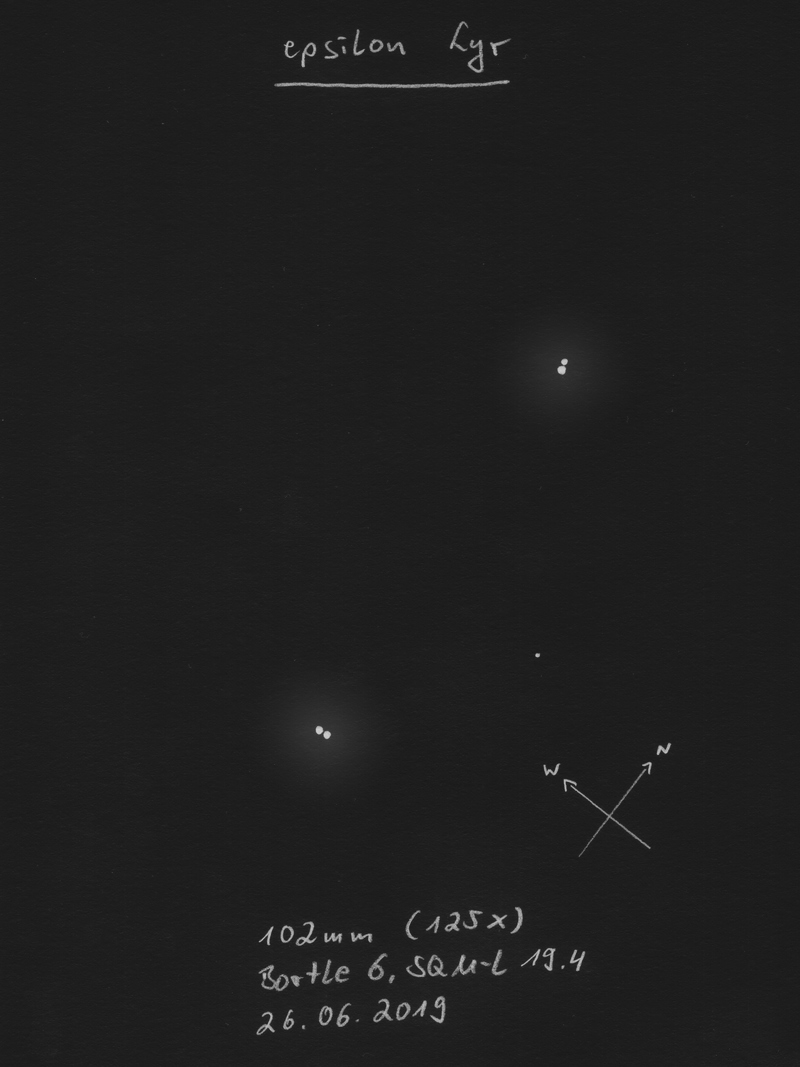
|
Uwe Pilz
Leipzig (Germany) |
105mm (26x) |
bei 22x nicht trennbar |
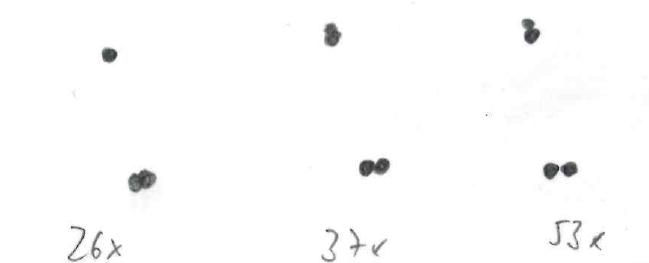
|
Jörg S. Schlimmer
Germany |
127mm (203x) |
easy to split |
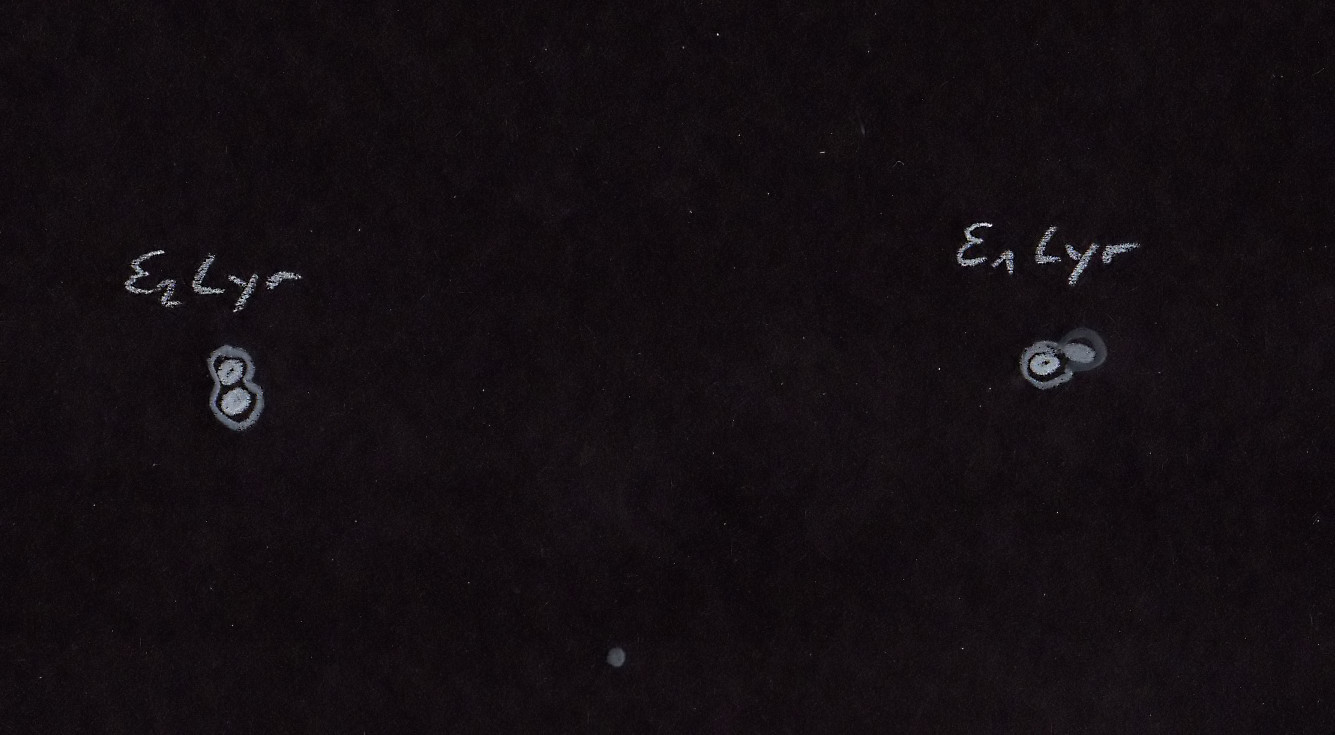
|
Sarah Gebauer
Germany |
150mm (250x) |
August 2019 zum ersten Mal die nah beieinanderstehenden Komponenten sauber getrennt, ein grandioser Doppel-Doppel-Anblick |
|
Winfried Kräling
Marburg (Germany) |
152mm (175x) |
|
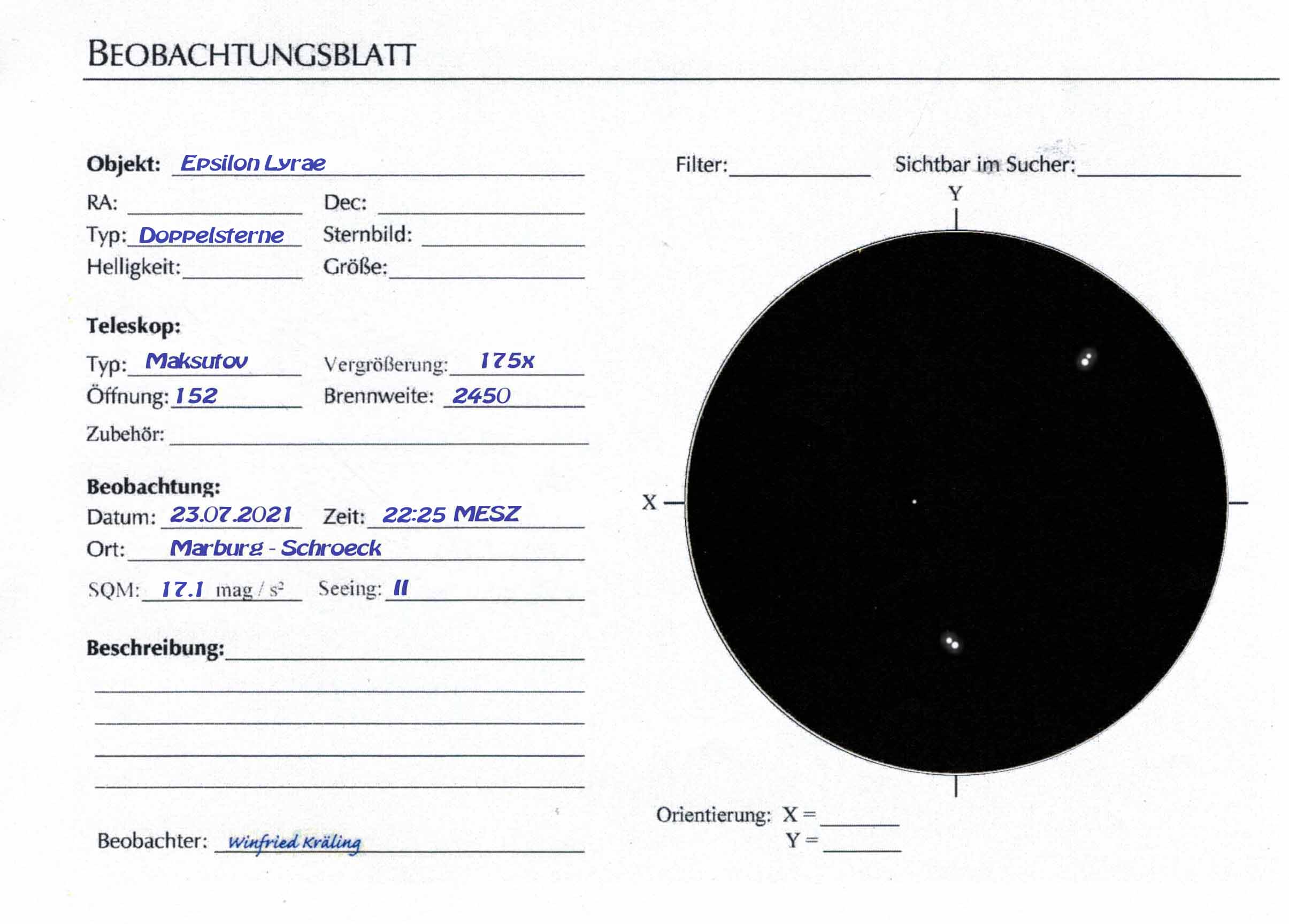
|
René Merting
Drachhausen (Germany) |
320mm (144x) |
AB: bei 72x ist erkennbar, in welche Richtung die Sterne elongieren, bei 43x dann ist eine deutliche 8 sichtbar - erst bei 206x lassen sich A und B zweifelsfrei trennen, zeigen sich aber auch schon ordentlich aufgebläht
CD: bei 103x ist die südliche Komponente als 8 erkennbar - bei 144x kann ich C und D trennen |
|
René Merting
Drachhausen (Germany) |
320mm (144x) |
bei 144x sind die Komponenten von AB und CD gerade so getrennt voneinander erkennbar, sie tanzen wie wild miteinander - mit Arperturmaske und Abblendung auf 120 mm zeigen die vier nun deutlich schwächeren Sterne schöne Beugungsscheibchen und sind besser getrennt voneinander sichtbar |
|
Uwe Pilz
Leipzig (Germany) |
320mm (200x) |
7 Komponenten!! A-B-C-D-E-F-I |

|
|
Berthold Fuchs
Wiesbaden (Germany) |
130mm |
Double-Double |
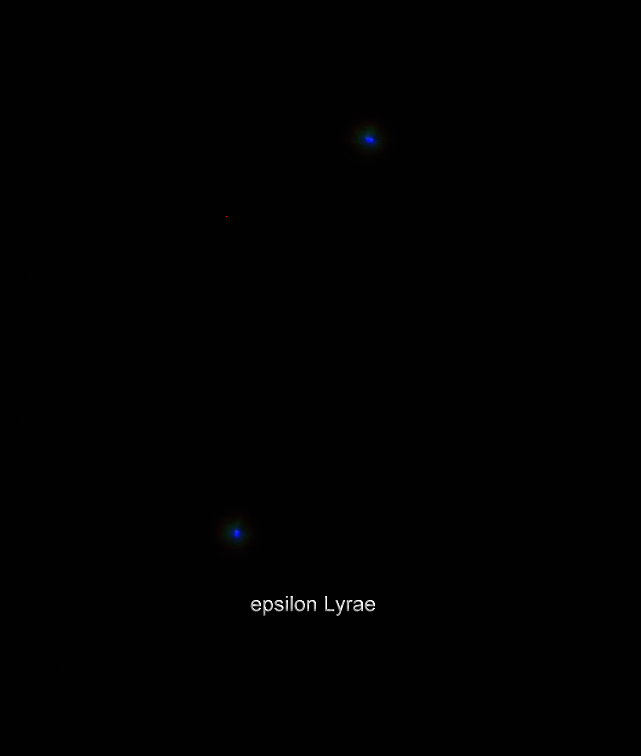
|
|
|
★★
|
STFA38, zeta Lyr, zeta 1/2 Lyr, 6/7 Lyr |
|
AD |
4m.3 |
5m.6 |
43.7" |
150° |
2018 |
Lyr |
18h44m46.36s / +37°36'18.40" |
Christopher Hay
Seeheim (Germany) |
7x45 |
Handheld. Clearly split, almost wide. Primary bluish-white. Fantastic 8.6° FOV together with Eps1/2 and Delta1/2 Lyrae. One of the best doubles for 7x. |
|
Christopher Hay
Seeheim (Germany) |
10x42 |
Clearly separated. Colour contrast between bluish A and orangish D is there if one knows it, but not as striking as in 15x45 binoculars. |
|
Sarah Gebauer
Germany |
12x42 |
gut getrennt, mit schönem Helligkeitsunterschied und weißem Farbeindruck - zusammen mit Vega, ihrem weiten Halo und dem einfachen Epsilon-Lyrae-Doppel ein wundervoller Anblick |
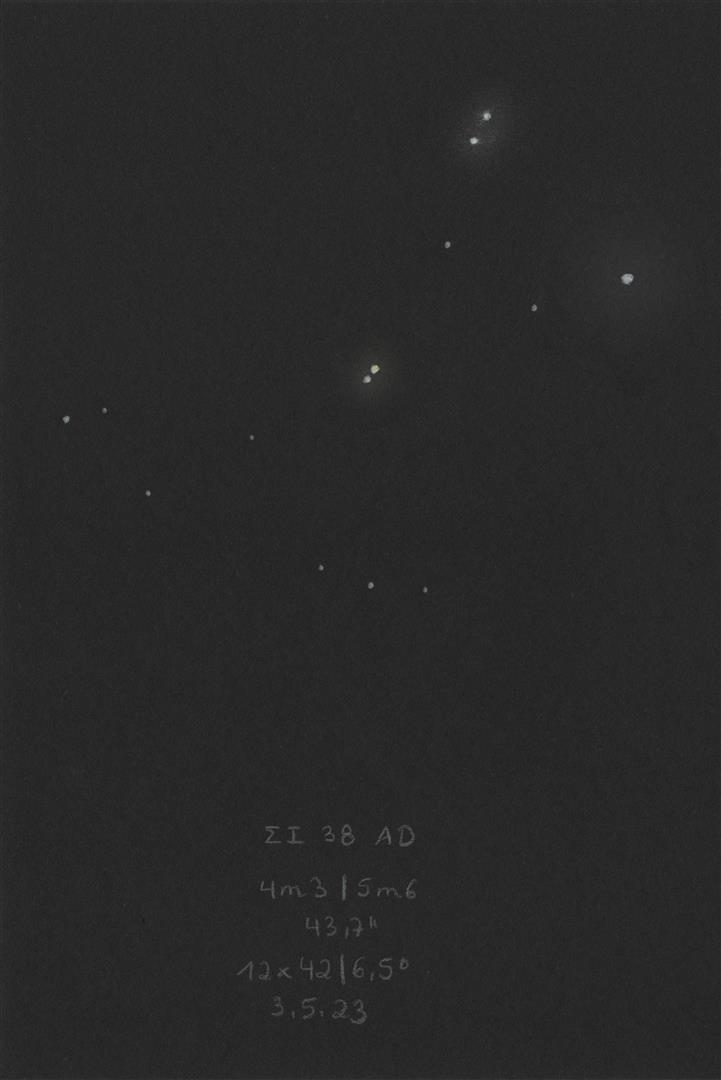
|
Christopher Hay
Seeheim (Germany) |
15x45 |
Component A clear blue-white, component D very pale tangerine orange. Wide split. Colour contrast seems even greater than that of nearby Delta 1/2 Lyrae. Physical double. |
|
René Merting
Drachhausen (Germany) |
76mm (29x) |
bei 29x ein sehr auffälliges Sternpaar, ordentlich getrennt - ein extrem schöner, dezenter Farbkontrast, A ist hellst gelb, D strahlt hell mintfarben, aber nur, wenn man nicht genau drauf schaut, sondern nur beiläufig - bei 57x verstärkt sich der Farbeindruck, vor allem, wenn man die Sterne leicht unscharf stellt, A ist dann samtgelb, B wirkt nicht mehr mintgrün sondern zart braunorange |
|
René Merting
Drachhausen (Germany) |
76mm (29x) |
bei 29x ein schön getrenntes Pärchen - D im Südosten ist 1.5 Magnituden schwächer und wirkt blaugrau gegen die weißgelbe A-Komponente |
|
Mark McCarthy
Fremont (California/USA) |
80mm (13x) |
Zeta 2 Lyr. Slightly greenish-white stars. Best view in finder, cleaner. Wide, 1 delta mag. |
|
René Merting
Drachhausen (Germany) |
100mm (20x) |
bei 20x weit getrennt, Komponente A weißlich, D leicht gelblich |
|
Sarah Gebauer
Germany |
100mm (21x) |
bei 20-fach auf den ersten Blick farblos bzw. warmweiß - ein sehr dominantes Pärchen in der Sternumgebung durch seine Helligkeit - mit etwas Geduld beim Beobachten zeigt sich ein gelber Farbhauch |
|
Sarah Gebauer
Germany |
100mm (80x) |
ein typisches Augenpaar, der nördliche Stern leuchtet leicht heller als der südliche |
|
Axel Tute
Küssaberg (Germany) |
100mm (217x) |
11.10.2023: Simple. No colours noted. |
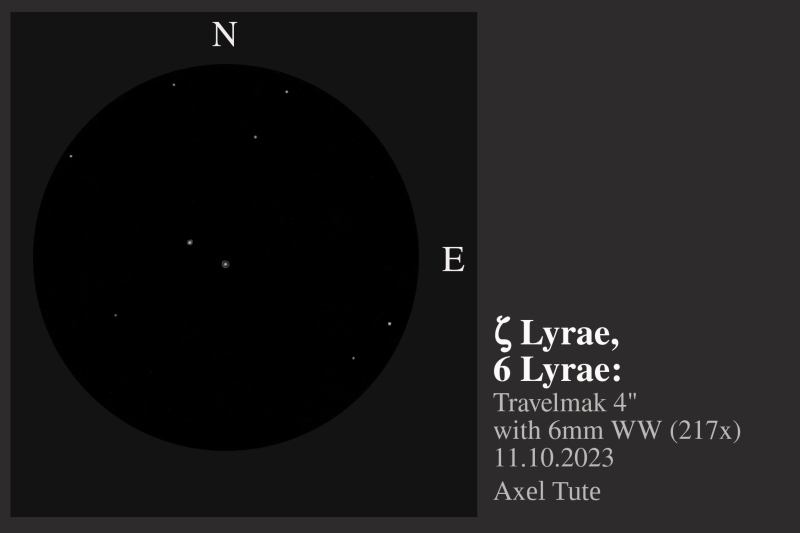
|
Uwe Pilz
Leipzig (Germany) |
105mm (88x) |
weiß-orange |
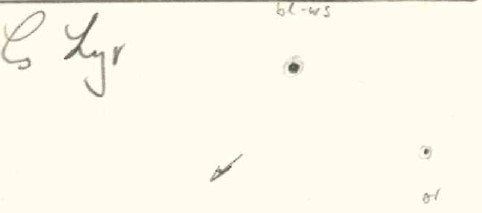
|
Sarah Gebauer
Germany |
150mm (85x) |
weit getrennt, unspektakulär |
|
Winfried Kräling
Marburg (Germany) |
152mm (175x) |
|
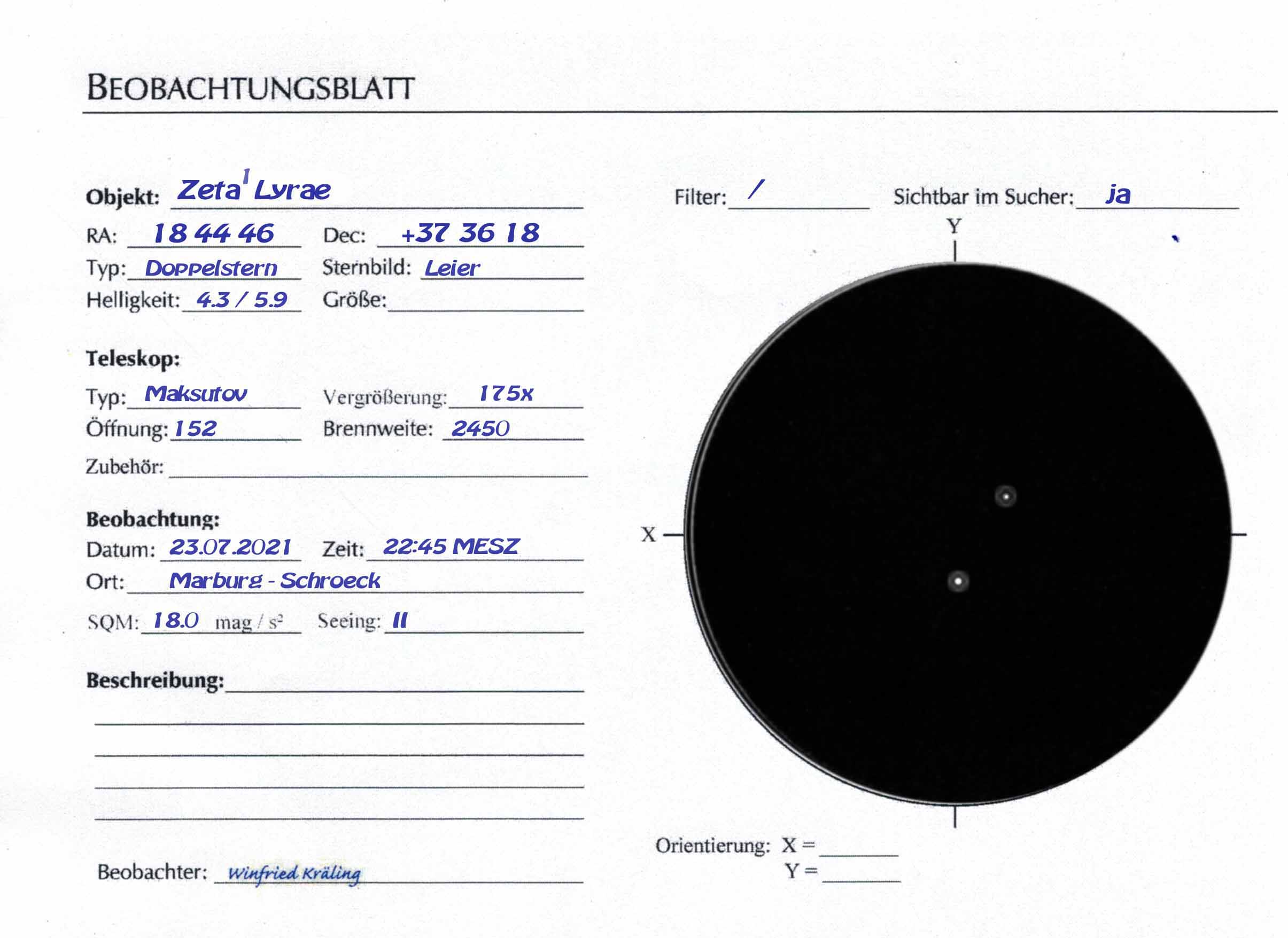
|
Mark McCarthy
Fremont (California/USA) |
152mm (175x) |
Wide, white-yellow stars, one delta |
|
René Merting
Drachhausen (Germany) |
320mm (45x) |
bei 45x ein helles Sternpaar mit leichtem Farbkontrast - die südöstlich stehende B-Komponente wirkt eine halbe Größenklasse schwächer und strahlt zartgelb, A dagegen wirkt weiß |
|
|
Frederik Wanink
Itterbeck (Germany) |
254mm |
|
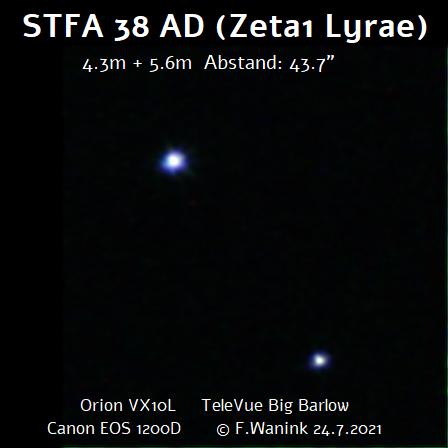
|
|
|
★★
|
STT525 & SHJ282 |
STT525 |
AB |
6m.1 |
9m.1 |
1.8" |
130° |
2015 |
Lyr |
18h54m52.52s / +33°58'06.90" |
|
|
|
SHJ282 |
AC |
6m.1 |
7m.6 |
45.4" |
349° |
2018 |
|
|
|
|
|
SHJ282 |
AD |
6m.1 |
11m.0 |
214.8" |
295° |
2015 |
|
|
Christopher Hay
Seeheim (Germany) |
10x42 |
SHJ282 (AC): Stabilised binoculars, handheld. Wide split, the A component yellowish. Alias South 282. According to Stelledoppie a physical double. |
|
Robert Zebahl
Leipzig (Germany) |
16x70 |
SHJ282 (AC): 2020-07-06: Easy, striking with reasonably apparent color contrast: yellowish to slightly orange & bluish. |
|
Christopher Hay
Seeheim (Germany) |
60mm (15x) |
SHJ282 (AC): Wide split. Blue colour of C component much more striking than the orange colour of the A component. |
|
Robert Zebahl
Leipzig (Germany) |
70mm (22x) |
SHJ282 (AC): Fairly bright and wide pair. The double star was conspicuous, especially in regard to its color: A appeared orange, C rather grey-bluish. It could be observed together with Messier 57 and beta & gamma Lyrae. Very nice. |
|
René Merting
Drachhausen (Germany) |
76mm (18x) |
SHJ282 (AC): bei 18x ist das Pärchen schon sehr auffällig - A ist hellgelb mit schönem Kontrast zur nördlich stehenden, gut getrennten B-Komponente - bei 57x präsentiert sich B in einem zarten stahlblau |
|
Sarah Gebauer
Germany |
100mm (49x) |
SHJ282 (AC): bei 50-fach weit getrennt mit nur geringem Helligkeitsunterschied, dafür aber einem schönen, warmgelb-graublauen Farbeindruck der beiden Komponenten - außerdem zusammen mit dem leicht südöstlich stehenden, deutlich schwächeren STF 2421 zusammen im Bild |
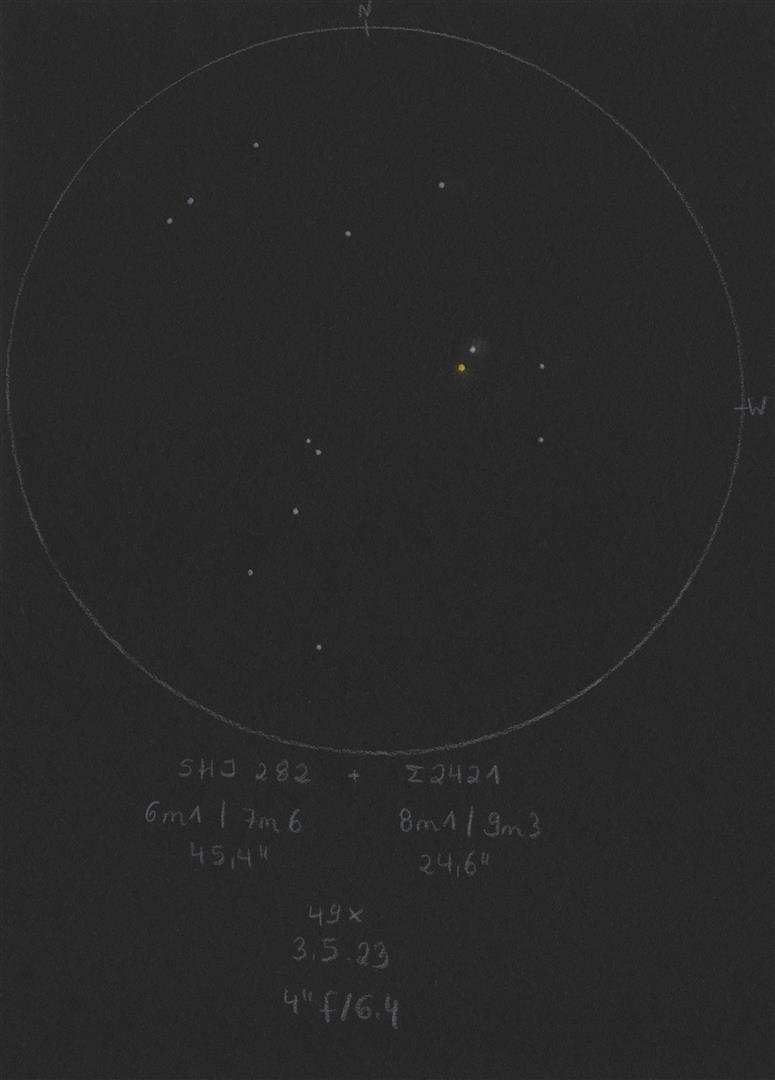
|
Uwe Pilz
Leipzig (Germany) |
105mm (21x) |
SHJ282 (AC): Orange und türkis |
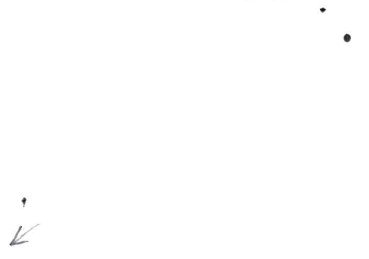
|
Uwe Pilz
Leipzig (Germany) |
105mm (180x) |
STT525 (AB): gelbweiß-blau |
|
Christopher Hay
Seeheim (Germany) |
125mm (23x) |
SHJ282 (AC): Widely split, dominates the field of view, very attractive. A component is tangerine orange, C component ice blue. An echo of Albireo. A true physical pair. |
|
Mark McCarthy
Fremont (California/USA) |
152mm (285x) |
STT525 (AB): Suspected at 175x, best seen 285x. Orange A, subtle elongation to notched with best seeing, unequal. Wide SHJ 282 AC also seen. WDS uncertain but there is a -34% parallax overlap, so it's not possible to be |
|
Mark McCarthy
Fremont (California/USA) |
178mm (205x) |
STT525 (AB): Extremely fine point shows just outside bright white A's first diffraction, only with best seeing and when A is a perfect disk. WDS uncertain, however unfortunately there is -34% parallax overlap, it is not physical |
|
Christopher Hay
Seeheim (Germany) |
180mm (200x) |
SHJ282 (AC): A is very distant from C but the two are still a fine pair. Colour of C is more striking than that of A, in a manner similar to my simultaneous observation with 60mm at 15x, but not quite as pronounced.
C has a companion set off from it by a hair of black. I estimate PA from C at approx. 80°, separation very roughly 2". Surprisingly can't find this companion in the double star catalogues. |
|
Frederik Wanink
Itterbeck (Germany) |
254mm (640x) |
STT525 (AB): 3er System, sehr schwierig wegen Helligkeitsunterschied |
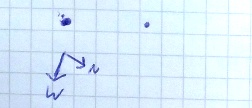
|
Mark McCarthy
Fremont (California/USA) |
317mm (277x) |
SHJ282 (AC): Wide separation orange and blue, 2 delta mag. |
|
|
Frederik Wanink
Itterbeck (Germany) |
254mm |
STT525 (AB) |
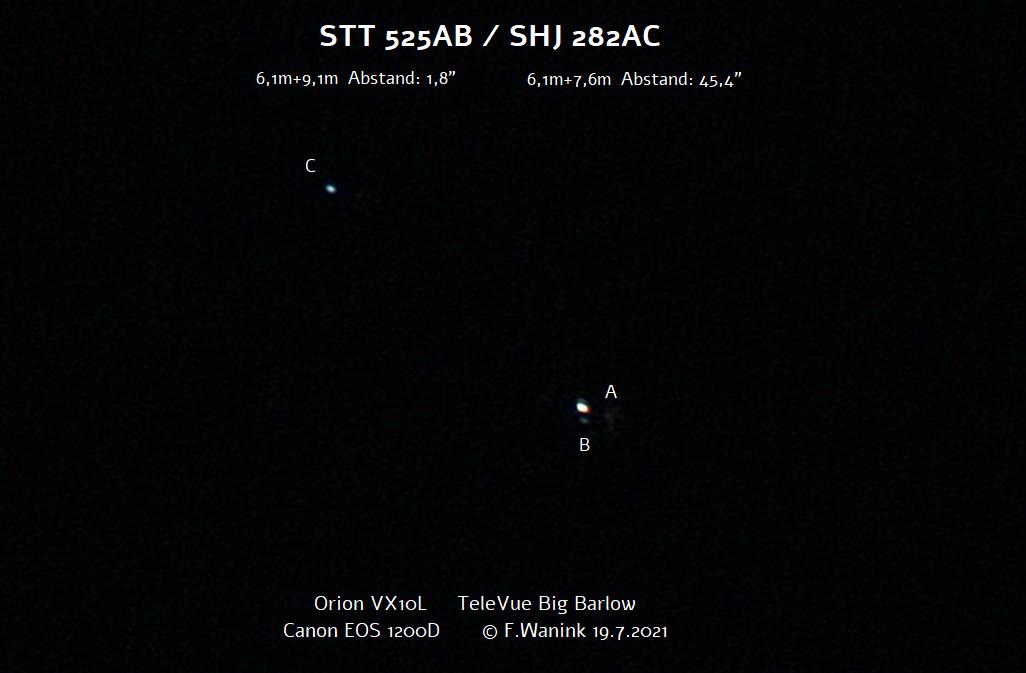
|
Claus-Dieter Jahn
Leipzig (Germany) |
|
SHJ282 (AC): TS APQ 65/420mm, ZWO ASI 178mc, Livestack with Sharpcap, Exposure time: 1600x 0.6s |
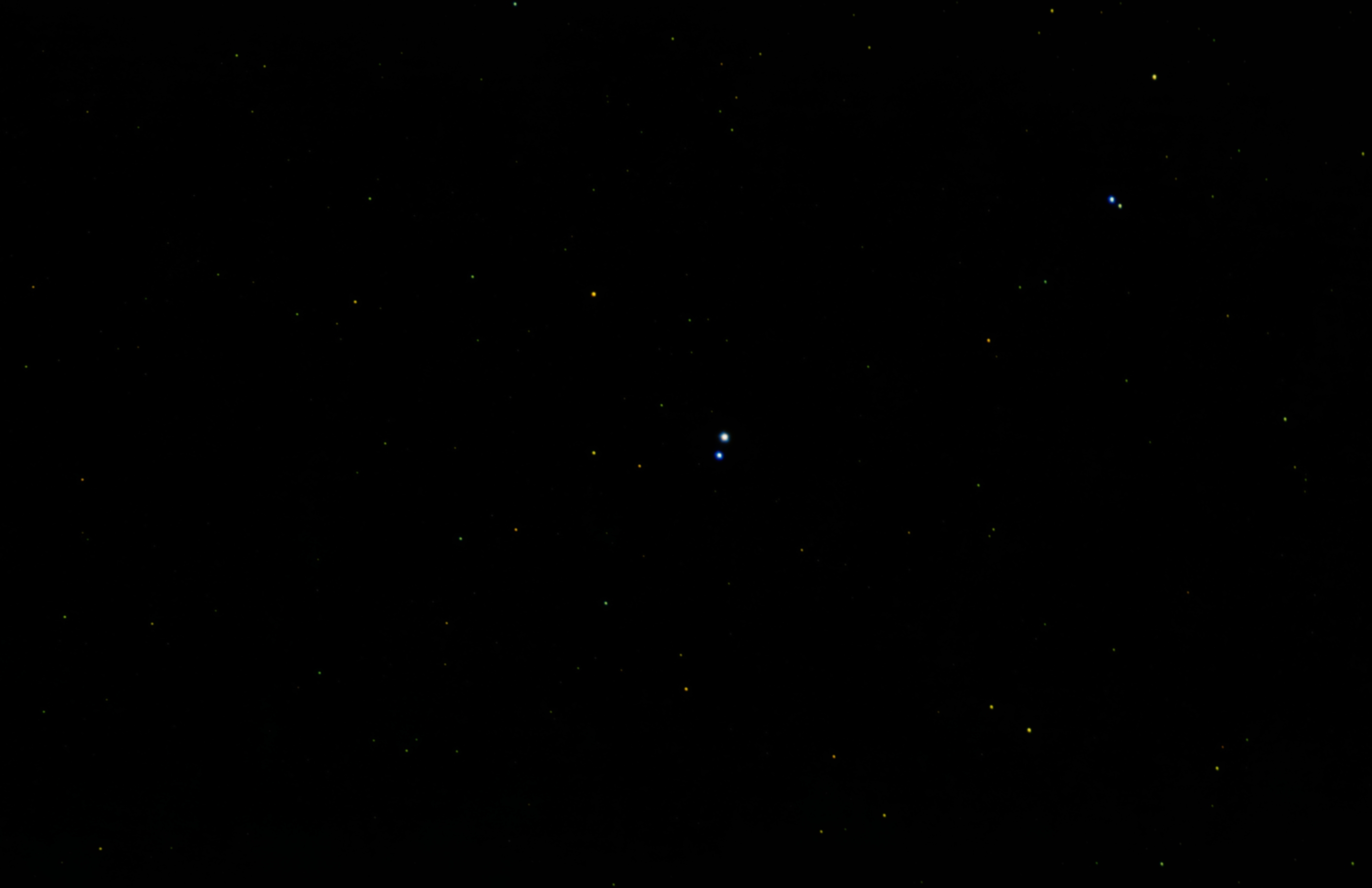
|
|
|
★
|
STF2417, theta Ser, 63 Ser, Alya |
|
AB |
4m.6 |
4m.9 |
22.4" |
106° |
2019 |
Ser |
18h56m13.18s / +04°12'12.90" |
|
|
|
|
AC |
4m.6 |
6m.8 |
421.0" |
58° |
2007 |
|
|
René Merting
Drachhausen (Germany) |
10x35 |
AB: wunderschön für diese Vergrößerung - zwei helle dicht beieinander stehende Sterne, knapp getrennt - die hellsten Sterne im Umfeld |
|
René Merting
Drachhausen (Germany) |
10x50 |
AB: zwei helle schneeweiße Sterne, knapp getrennt - B im Osten ist nur knapp schwächer - ein schönes enges Pärchen |
|
René Merting
Drachhausen (Germany) |
16x70 |
AB: ein gut getrennt zu sehendes Pärchen - beide Sterne stahlen weiß, Komponente B im Osten ist keine halbe Größenklasse schwächer |
|
René Merting
Drachhausen (Germany) |
100mm (20x) |
AB: bei 20x ein auffälliges gut getrenntes Sternpaar - Komponente B östlich ist nur leicht schwächer und strahlt ein wenig warm-weißer |
|
Sarah Gebauer
Germany |
100mm (73x) |
AB: die mit deutlichem Abstand bei 73x getrennten Doppelsterne liegen wie in einem U aus recht gleich hellen Sternen und bilden dabei im Süden den unteren Bereich des Buchstabens |
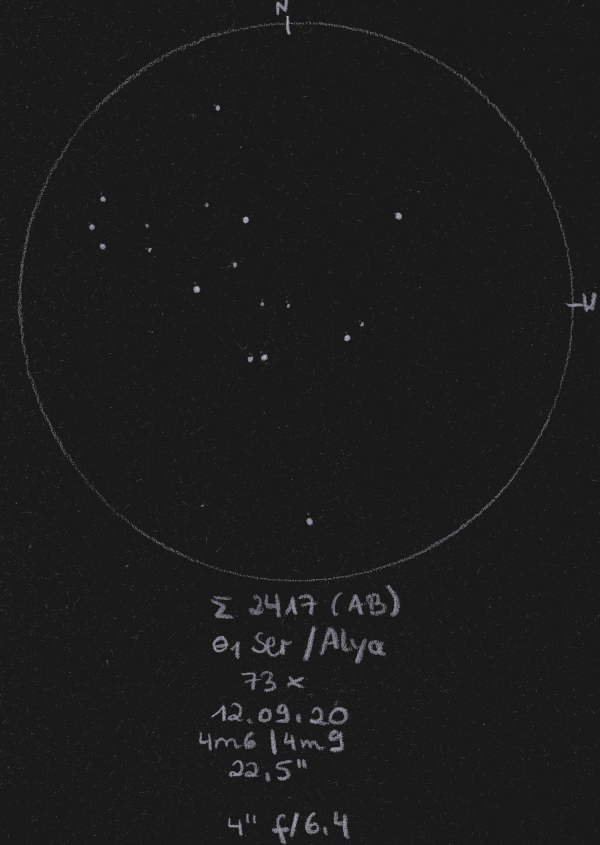
|
Stefan Loibl
Rosenheim (Germany) |
102mm (102x) |
AB: wide pair, hardly any difference in brightness, wonderful field, double stars looks like an embedded pair of eyes |
|
|
Berthold Fuchs
Wiesbaden (Germany) |
130mm |
AB: easy DS |
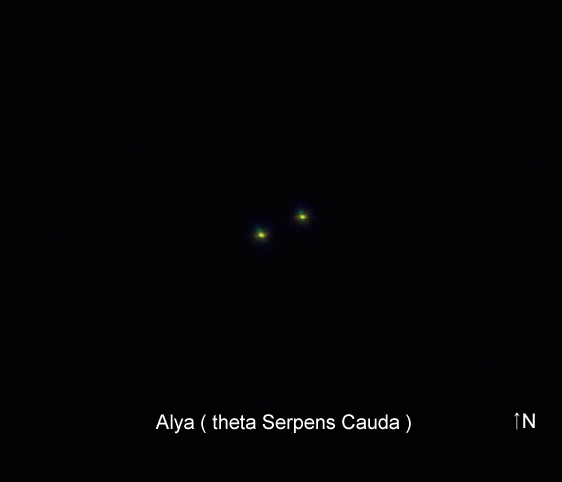
|
|
|
★
|
15 Aql, SHJ286 |
|
|
5m.5 |
7m.0 |
39.6" |
211° |
2019 |
Aql |
19h04m57.67s / -04°01'53.10" |
Christopher Hay
Seeheim (Germany) |
7x42 |
Handheld binoculars in reclining chair. Difficult due to hand tremor and significant delta-mag, but definitely split.
In handheld 15x60 binoculars quite clearly split.
In handheld stabilised 20x60 binoculars a strong wide pair, primary is golden-yellow. |
|
René Merting
Drachhausen (Germany) |
8x30 |
beide Sterne zeigen sich gut getrennt, wobei B im Süden lediglich dunkler wirkt, Farben sind nicht wirklich erkennbar |
|
René Merting
Drachhausen (Germany) |
10x32 |
beide Sterne sind ein klein wenig mehr als knapp getrennt - A im Norden wirkt hell gelb, B im Süden ist eher grauweiß und knapp 2 Magnituden schwächer |
|
René Merting
Drachhausen (Germany) |
10x35 |
ein wunderschöner Doppelstern - die beiden Mitglieder sind sehr hell - B im Südwesten wirkt kupfern, A eher gelblich - Trennung ordentlich |
|
René Merting
Drachhausen (Germany) |
10x50 |
sehr auffälliges dicht zusammen stehendes Sternpaar - Komponente A im Norden ist hellgelb, B grau-orange, schöner Farbkontrast |
|
René Merting
Drachhausen (Germany) |
12x50 |
ein ordentlich getrenntes Sternpaar - A im NO ist weißgelb, B wirkt gelborange |
|
René Merting
Drachhausen (Germany) |
16x70 |
ein wunderschönes ordentlich getrenntes Sternpaar - Komponente A im NO samtgelb, B dagegen apricot-orange und gut 1.5 Magnituden schwächer als A - zudem ein interessanter Farbvergleich möglich zu dem mit im Gesichtsfeld stehenden V Aql gut 1.7° weiter südlich, der farblich noch eine Schippe drauf legen kann mit einem kräftigen zinnober-orange |
|
Robert Zebahl
Leipzig (Germany) |
70mm (22x) |
Striking, pretty wide, uneven pair. Primary component gleamed in shiny orange, the companion appeared slightly orange. |
|
René Merting
Drachhausen (Germany) |
76mm (29x) |
bei 29x ein weit getrenntes Pärchen, B ist eine Größenklasse schwächer - A ist buttergelb, B wirkt noch etwas dunkelgelblicher |
|
René Merting
Drachhausen (Germany) |
100mm (32x) |
bei 32x weit getrennt, Komponente A hellgelb, B dagegen orangefarben - sehenswert |
|
Sarah Gebauer
Germany |
150mm (125x) |
gut gefunden, beide Sterne stehen in weitem Abstand zueinander |
|
Robert Zebahl
Leipzig (Germany) |
200mm (37x) |
Conditions in the target region: SQM-L 19.9
Easy to split, evident. Both components appeared slightly orange colored. |
|
Sarah Gebauer
Germany |
254mm (49x) |
bei 49-fach strahlt A in schönstem Gold – die schwächere B-Komponente in gutem Abstand zeigt auch einen roségoldenen Farbton |
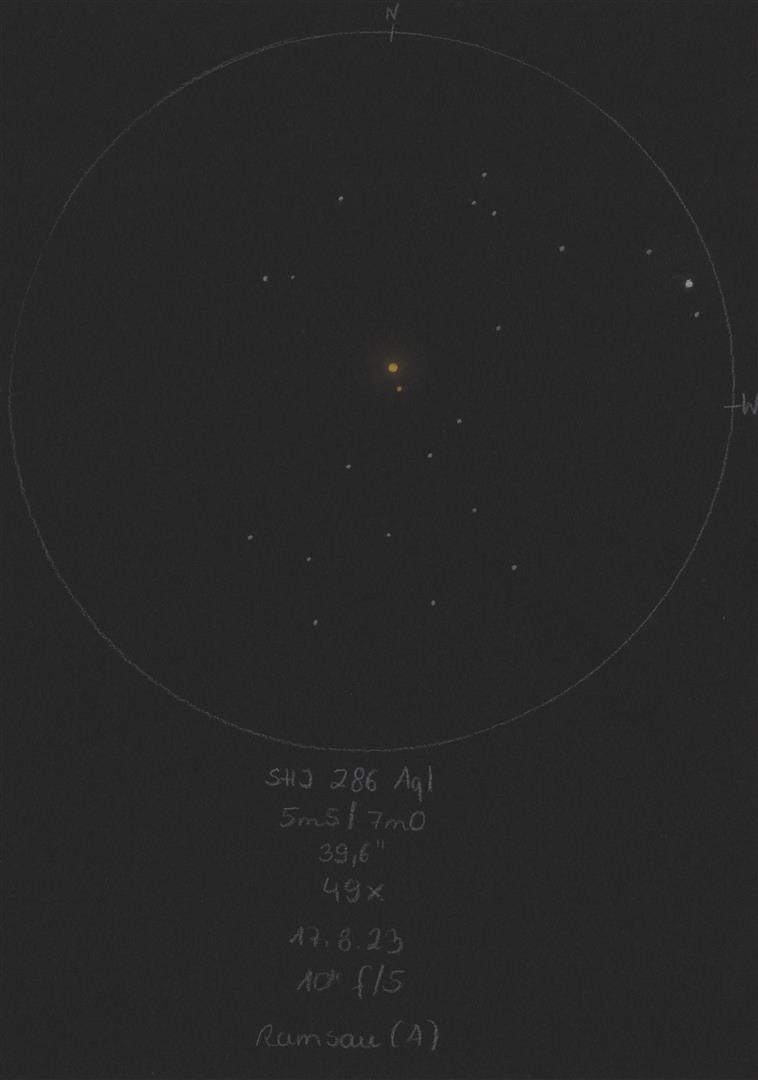
|
|
|
★
|
STF2470 |
|
|
7m.0 |
8m.4 |
13.8" |
267° |
2017 |
Lyr |
19h08m45.20s / +34°45'37.10" |
Robert Zebahl
Leipzig (Germany) |
16x70 |
2020-07-06: Striking with well visible brightness difference. Very nice together with STF2474, which gives a similar view. A double-double for binoculars. |
|
René Merting
Drachhausen (Germany) |
100mm (20x) |
bei 20x knapp getrennt - wunderschönes Synchrontänzer-Doppel-Doppel zusammen mit STF2474 unmittelbar 10' südlich, weil A und B bei beiden Paaren mit gleichen Helligkeiten und Positionswinkel strahlen - A-Komponente von STF2470 knapp schwächer als A-Komponente von STF2470 |
|
Axel Tute
Küssaberg (Germany) |
100mm (144x) |
07.09.2023: A light blue. B white. Very nice star field with STF2474 |
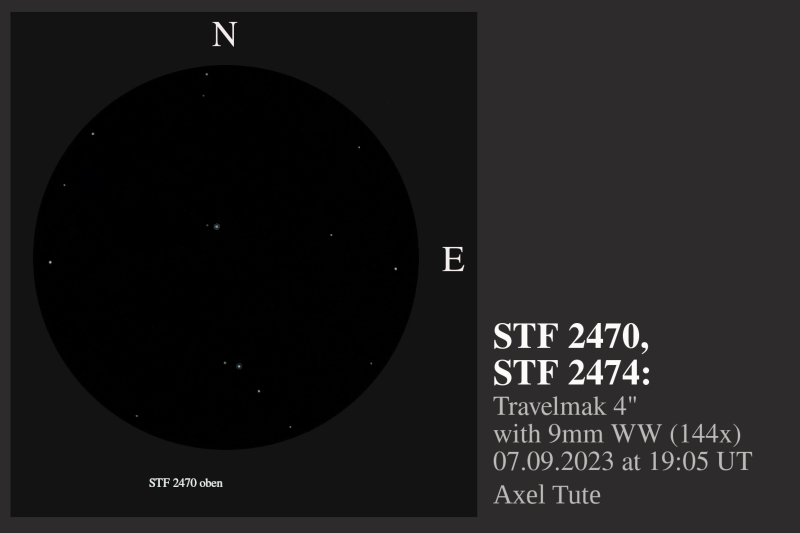
|
Robert Zebahl
Leipzig (Germany) |
102mm (40x) |
Striking, especially with STF 2474 in one visual field. The color of the components was not clearly visible. Worthwhile! Sketch see STF 2474. |
|
Sarah Gebauer
Germany |
150mm (85x) |
nach mehreren Anläufen dann gefunden und bei 85x wie ein Doppel-Doppel im Bild, sehr sehenswert, auch der Abstandsunterschied (13,8'' bei STF 2470 und 15,9'' bei STF 2474) ist zu erkennen |
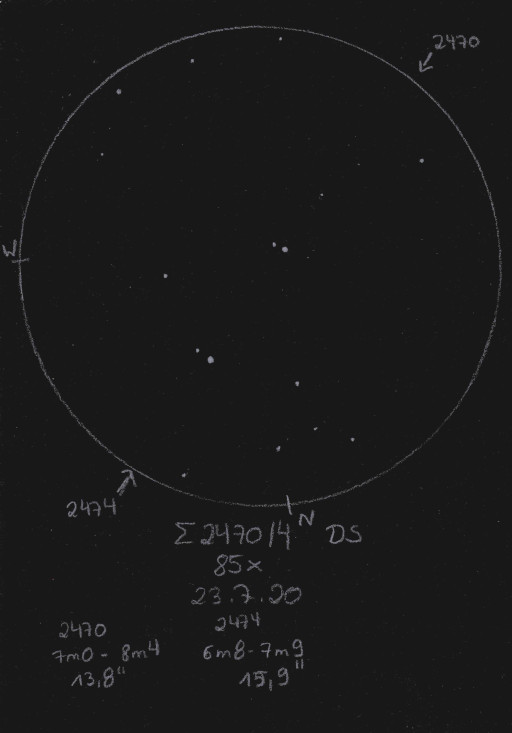
|
|
|
★★
|
STF2474 |
|
AB |
6m.8 |
7m.9 |
16.0" |
262° |
2019 |
Lyr |
19h09m04.35s / +34°35'59.90" |
Robert Zebahl
Leipzig (Germany) |
16x70 |
2020-07-06: Striking with well visible brightness difference. Very nice together with STF2470, which gives a similar view. A double-double for binoculars. |
|
René Merting
Drachhausen (Germany) |
100mm (20x) |
bei 20x knapp getrennt - wunderschönes Synchrontänzer-Doppel-Doppel zusammen mit STF2470 unmittelbar 10' nördlich, weil A und B bei beiden Paaren mit gleichen Helligkeiten und Positionswinkel strahlen - A-Komponente von STF2474 knapp heller als A-Komponente von STF2470 - bei 64x Komponente A ein wenig gelblich |
|
Axel Tute
Küssaberg (Germany) |
100mm (144x) |
07.09.2023: A light blue. B white. Very nice star field with STF2470 |

|
Robert Zebahl
Leipzig (Germany) |
102mm (40x) |
Pretty conspicuous, easy double star. Especially attractive with the nearby double star STF 2470, as both are very similar in brightness, distance and position angle. The color of both components appeared slightly yellowish-orange. |
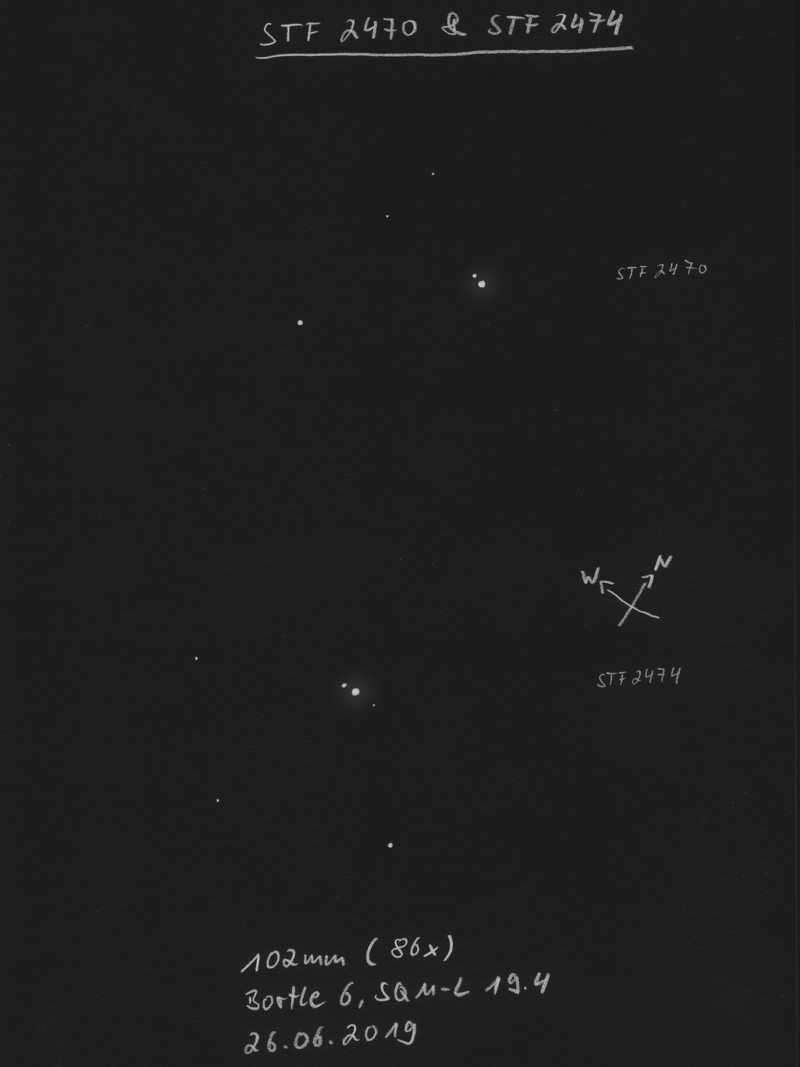
|
Sarah Gebauer
Germany |
150mm (85x) |
nach mehreren Anläufen dann gefunden und bei 85x wie ein Doppel-Doppel im Bild, sehr sehenswert, auch der Abstandsunterschied (13,8'' bei STF 2470 und 15,9'' bei STF 2474) ist zu erkennen |

|
Christopher Hay
Seeheim (Germany) |
150mm (96x) |
Widely separated. Component A yellowish, B light ice-blue. A true physical pair in 171 LY distance. Very attractive in field of view together with Struve 2470 about 10 arcseconds north. The components of each of the two Struves have almost the same position angles, similar separations and very similar delta-magnitudes. Struve 2470 is like an echo of 2474 but with no definite colour impression. |
|
|
|
★★★
|
beta Cyg, 6 Cyg, Albireo, STFA43 |
|
AB |
3m.2 |
4m.7 |
34.6" |
54° |
2022 |
Cyg |
19h30m43.29s / +27°57'34.90" |
Sarah Gebauer
Germany |
6x24 |
auf Anhieb schön getrennt, wenn auch sehr, sehr eng - der leichte Orangefarbton der Hauptkomponente ist sofort auszumachen, das Blau des Begleiters noch ganz zart und blass - wirklich entzückend in der Kleinstvergrößerung! |
|
Christopher Hay
Seeheim (Germany) |
7x42 |
Handheld binoculars in reclining chair. Following a surprisingly easy split of Zeta Lyr, I try out whether Albireo may also be splittable. Indeed, the pair is split, difficult but definite. Staring at Altair (Alpha Aql) for a few seconds with the binoculars prior to observing Albireo heigtens my acuity and makes the split more definite. Component A exhibits a mild orange-yellow hue. |
|
Robert Zebahl
Leipzig (Germany) |
8x40 |
Well split, but I didn't recognised any color. |
|
René Merting
Drachhausen (Germany) |
10x50 |
Komponente A ist gleißend hell und stroh-gelb, Komponente B ist deutlich schwächer leicht abgesetzt von A erkennbar und strahlt eigenartig mintgrün |
|
Christopher Hay
Seeheim (Germany) |
12x36 |
Well split. A golden-red, B cold blue. Gorgeous! |
|
René Merting
Drachhausen (Germany) |
12x42 |
ein bisschen mehr als knapp getrenntes Pärchen - A strahlt in einem schönen, hellen Gelb, B wirkt blaugrau - Helligkeitsunterscheid etwas mehr als eine Größenklasse |
|
Sarah Gebauer
Germany |
12x42 |
ein knackscharfes, farbiges, leuchtendes Paar, nach der Saisonpause endlich wieder sichtbar - A strahlt warm, orangegold, kräftig - B glitzert kristalleisblau klein daneben - ein traumhafter Anblick im Fernglas, die Sternumgebung nimmt sich scheinbar bewusst zurück und sprenkelt das Bild mit zahlreichen schwachen Sternen |
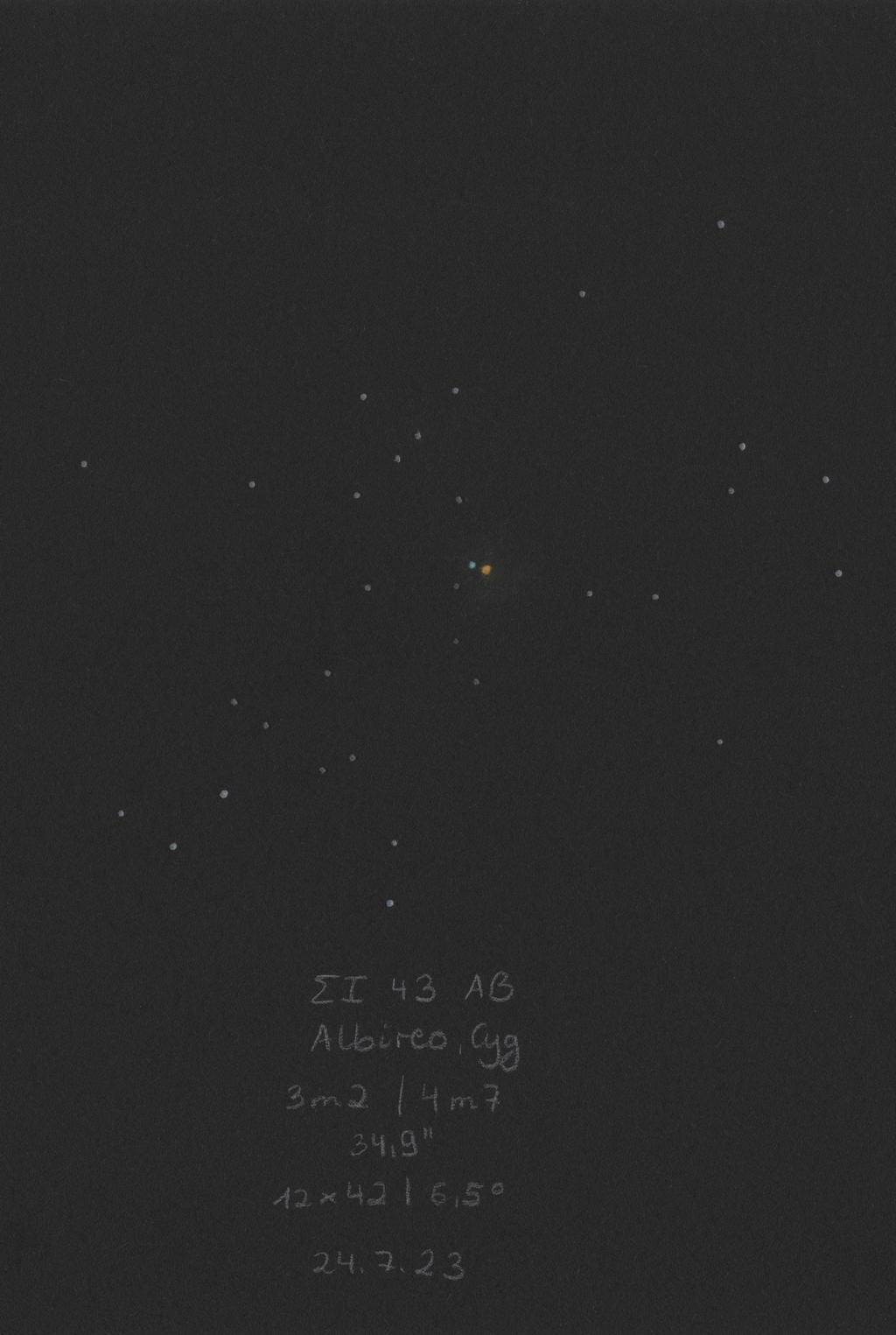
|
René Merting
Drachhausen (Germany) |
15x56 |
die Hauptkomponente strahlt in einem schönen buttergelb, die Komponente B zeigt sich westlich und wirkt bim ersten Eindruck mintgrün, der Farbeindruck verliert sich aber, je länger ich dieses schöne Sternpaar bewundere - Helligkeitsunterschied 1.5 bis 2 Größenklassen |
|
Robert Zebahl
Leipzig (Germany) |
16x70 |
2020-07-06: Bright orange & white-bluish. |
|
Robert Zebahl
Leipzig (Germany) |
80mm (25x) |
One of the most beautiful double stars in the northern hemisphere. Differences in brightness and color (orange-blue) are brilliant! Even under urban conditions with small aperture an enjoyment! |
|
René Merting
Drachhausen (Germany) |
100mm (32x) |
bei 32x stehen beide Sterne weit getrennt - Komponente A mit einem satten zitronen-gelb, Komponente B mit einem leichten Stich ins Blaue |
|
René Merting
Drachhausen (Germany) |
107mm (43x) |
bei 43x zeigt die hellere Komponente ein wunderschönes Samtgelb, kurz davor, ein richtig kräftiges Gelb zu sein - die schwächere Komponente wirkt auf den ersten Blick blauweiß |
|
Jörg S. Schlimmer
Germany |
127mm (203x) |
easy to split |
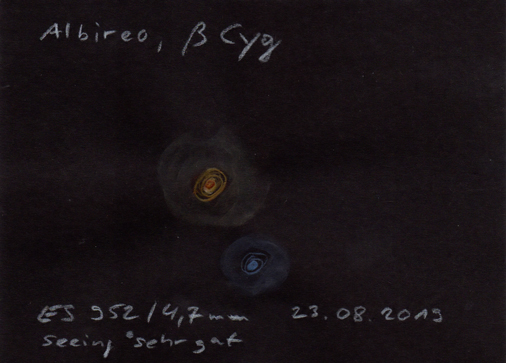
|
Sarah Gebauer
Germany |
150mm (116x) |
Erstbeobachtung August 2019: deutlicher Farbunterschied zwischen blau und sattem Gelb zu sehen |
|
Jörg S. Schlimmer
Germany |
305mm (170x) |
alle Komponenten einfach zu trennen |
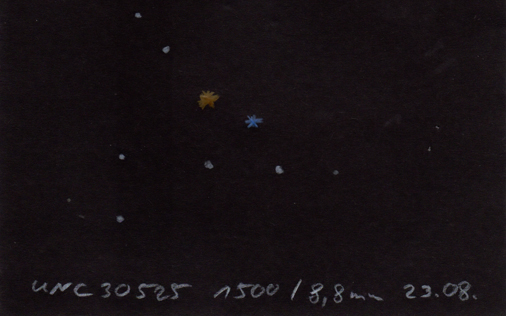
|
René Merting
Drachhausen (Germany) |
320mm (45x) |
|
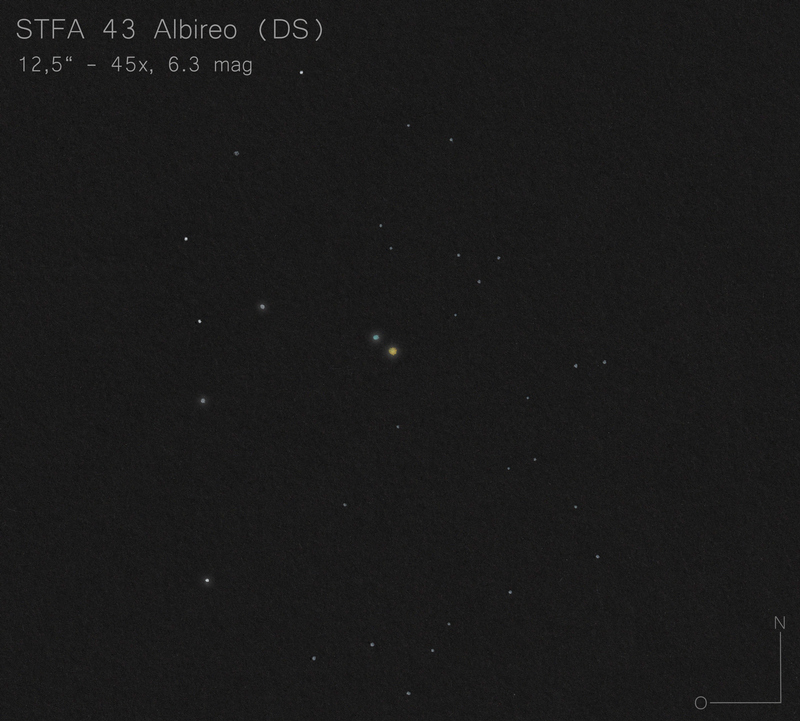
|
|
Werner E. Celnik
Rheinberg (Germany) |
150mm |
|
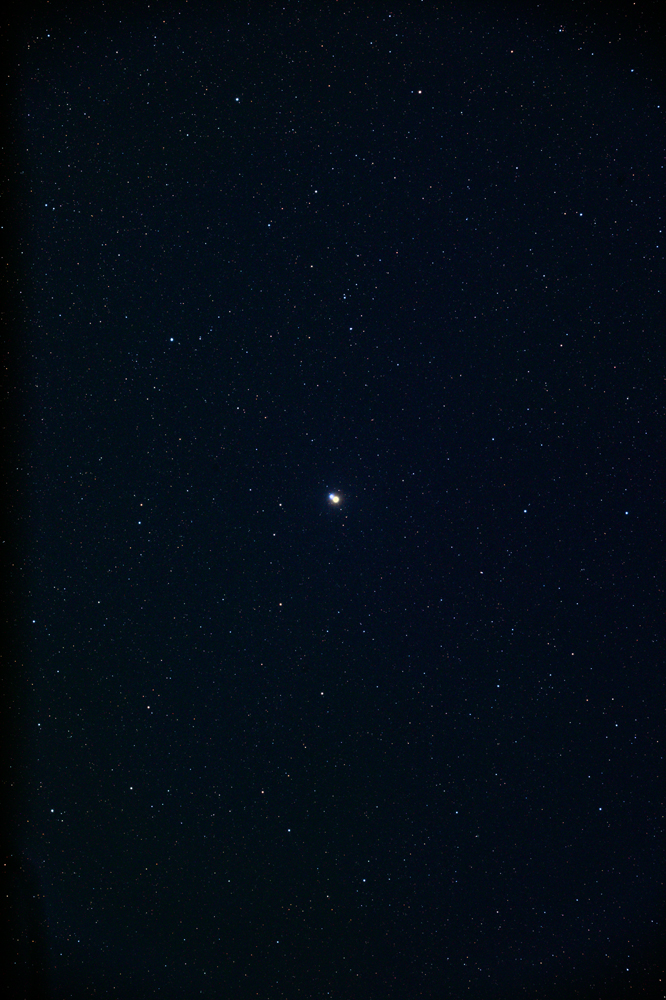
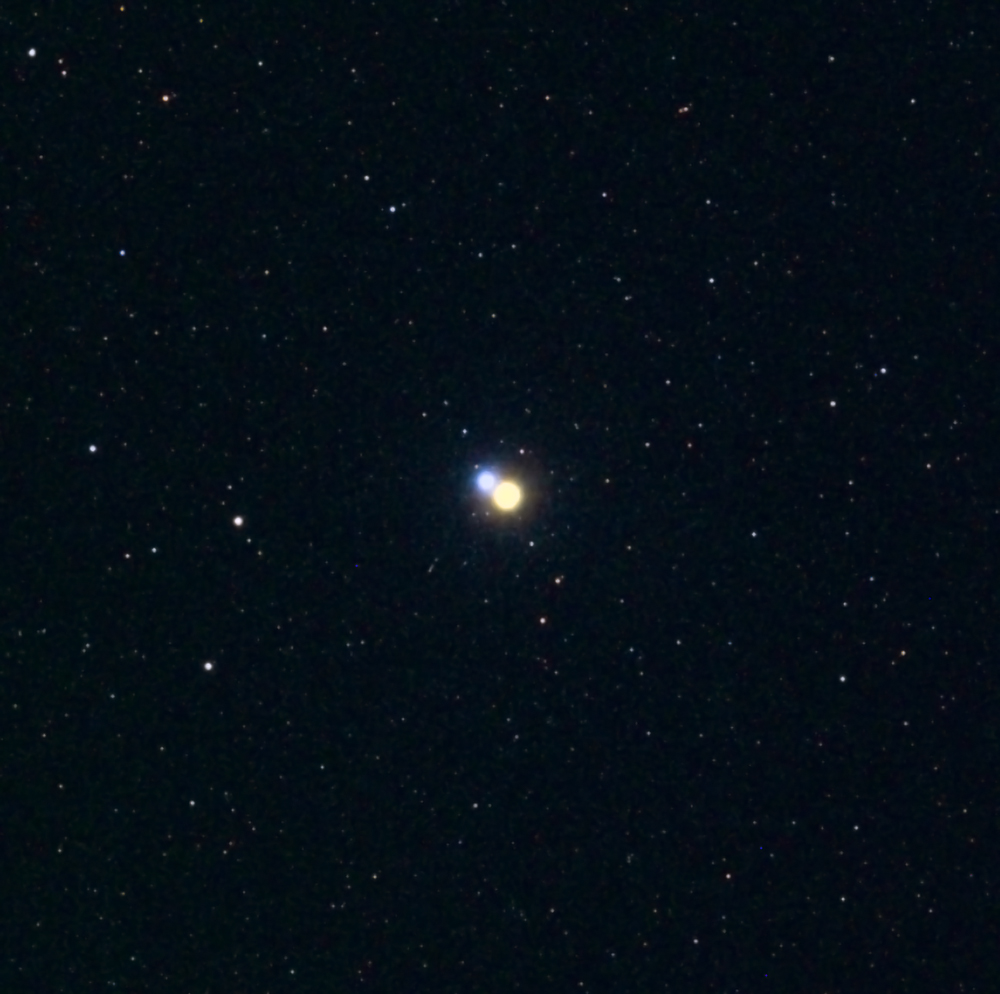
|
Werner E. Celnik
Rheinberg (Germany) |
150mm |
|
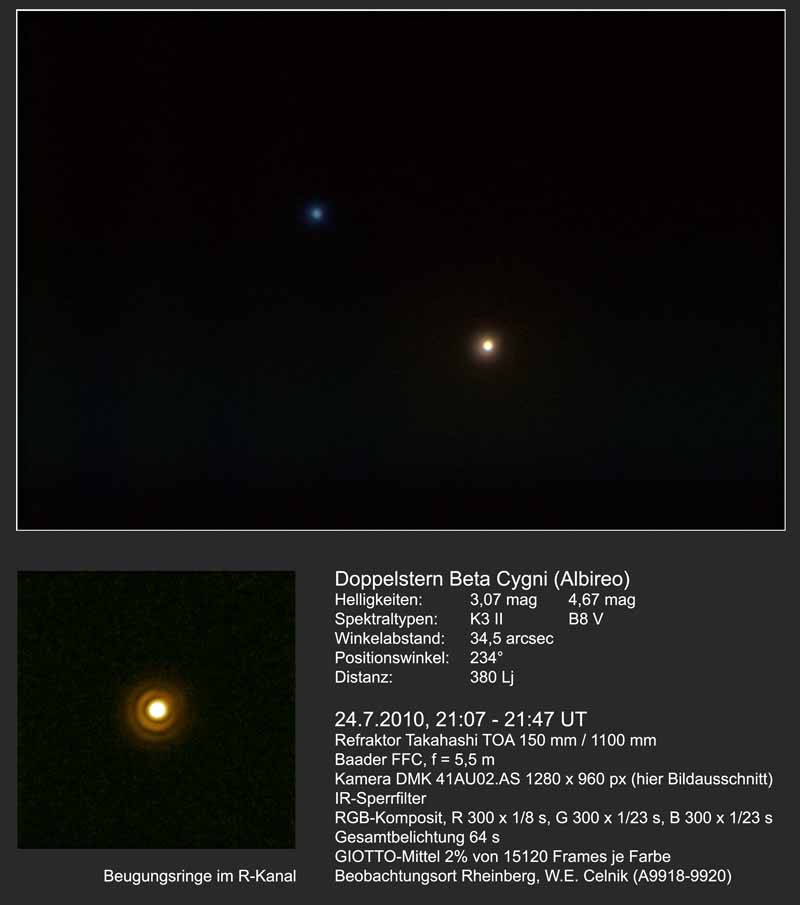
|
|
|
★★★
|
HN 84, V340 Sge |
|
|
6m.4 |
9m.5 |
28.4" |
301° |
2013 |
Sge |
19h39m25.33s / +16°34'16.00" |
Sarah Gebauer
Germany |
12x42 |
etwas mehr als knapp getrennt, A strahlt sehr schön dunkelgelb bis goldbraun |
|
René Merting
Drachhausen (Germany) |
12x50 |
verdammt schwer - Komponente B ist ganz schwach nordwestlich von A auszumachen - beide Sterne berühren sich noch |
|
René Merting
Drachhausen (Germany) |
16x70 |
beide Sterne präsentieren sich gut getrennt, nicht zu weit aber auch nicht zu nah - Komponente A meint es gut mit der Farbe gelb, bei Komponente B kann ich keine Farbe erkennen |
|
Christopher Hay
Seeheim (Germany) |
80mm (30x) |
Primary ruddy red, secondary wide apart but too faint for any colour impression. Straw-yellow Epsilon Saggitae half a degree to the west with its ice-blue eastern companion enhances the experience of colour contrast in the FOV and is actually more attractive than HN 84 with this aperture and power. |
|
René Merting
Drachhausen (Germany) |
100mm (20x) |
bei 20x sind beide Komponenten weit getrennt - Komponente A auffällig gelb-orange, B dagegen grau-blau, ein schöner Farbkontrast, der sich bei 32x verstärkt |
|
Sarah Gebauer
Germany |
150mm (85x) |
Holden 84, eine sehr goldgelbe Komponente und in 28'' Abstand die zweite, sehr schwache und weiße Komponente mit einem Hauch von Blau, sehr, sehr schön! |
|
Christopher Hay
Seeheim (Germany) |
150mm (96x) |
Main component ruddy tangerine orange, companion wide apart and ice blue. The longer I look the stronger the colour contrast becomes, which is by no means normal in many doubles. Epsilon Saggitae in same 0.8-degree field of view is straw-yellow with a cold blue companion (a field star?) pointing away from Epsilon in the direction of HN 84. I can’t think offhand of a better colour-contrast pair that can be framed in this manner in the same FOV. |
|
Sarah Gebauer
Germany |
150mm (160x) |
die hellere Hauptkomponente ist deutlich und stark goldfarben, die zweite dagegen sehr schwach, silbrig und dumpf |
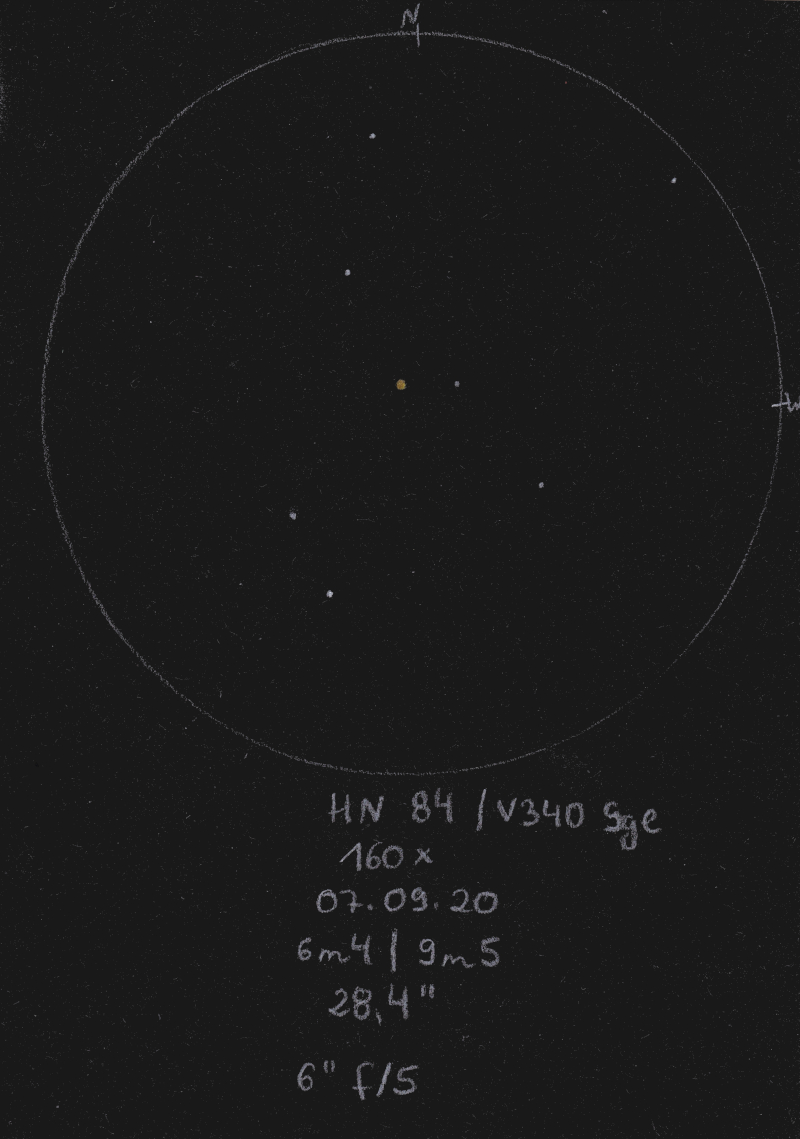
|
Mark McCarthy
Fremont (California/USA) |
178mm (205x) |
Very pretty orange A and neon blue B, 1 delta mag, very wide |
|
René Merting
Drachhausen (Germany) |
320mm (103x) |
bei 45x weit getrennt, für den Farbeindruck aber auf 103x vergrößert, dann strahlt A in einem tiefsatten Gelb - B im Westen wirkt beiläufig betrachtet Türkis bis Blaugrau - wenn ich mich aber auf B konzentriere, verwandelt sich der Stern in eine grauweiße Maus |
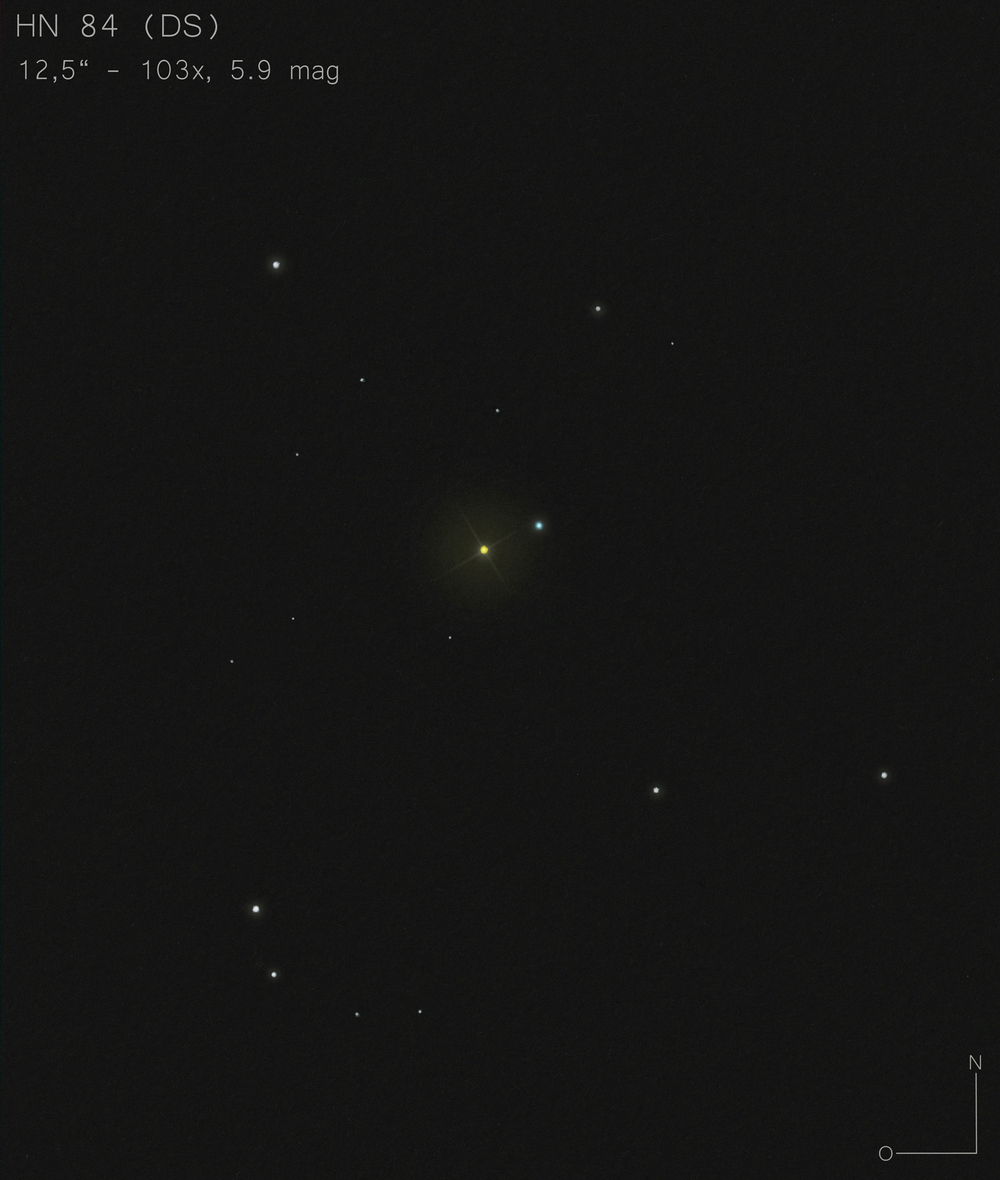
|
|
|
★★
|
STFA46, 16 Cyg |
|
AB |
6m.0 |
6m.2 |
39.7" |
133° |
2020 |
Cyg |
19h41m49.09s / +50°31'31.60" |
Christopher Hay
Seeheim (Germany) |
3x63 |
Self-built binoculars, hence the unusual specification. Made of top-quality teleconverters, apochromatic and sharp to the edge.
With naked eye under good suburban sky 16 Cyg is just seen. In the 3x binoculars the double is split into two finest points of light in good moments despite the low magnification. A physical pair according to Stelledoppie.
Two-star rating awarded because this is a true physical pair that can be split with the smallest binoculars and reveals increasingly more with growing binocular size (brightness disctinction between A and B in 7x50, colour distinction in 15x45). |
|
Christopher Hay
Seeheim (Germany) |
7x50 |
Finely split, A-component appears very slightly brighter than B-component. A very pleasing binocular pair. |
|
Christopher Hay
Seeheim (Germany) |
15x45 |
Wide split, very strong visual presence dominating 4.5° FOV. A-component very pale orange, B-component equally pale blue. |
|
Robert Zebahl
Leipzig (Germany) |
16x70 |
2021-06-01: Very striking, bright at moderate separation and small difference in brightness. White-yellowish & white. |
|
René Merting
Drachhausen (Germany) |
18x70 |
zwei ordentlich getrennte fast gleich helle Sterne - beide Komponenten sind reinweiß und die hellsten Sterne im unmittelbaren Umfeld - auffällig |
|
Christopher Hay
Seeheim (Germany) |
44x100 |
Extremely strong pair in 1.9° FOV. Northern component marginally brighter and with slightest touch of yellow. |
|
Sarah Gebauer
Germany |
100mm (21x) |
27.09.23: bei 21-fach ein schmales, sehr helles, warmweiß bis leicht goldenes Farbsternpaar mit nahezu gleich hellen und gleichfarbigen Komponenten - westlich strahlt noch R Cyg etwas heller und in einem leicht intensiveren Gelb |
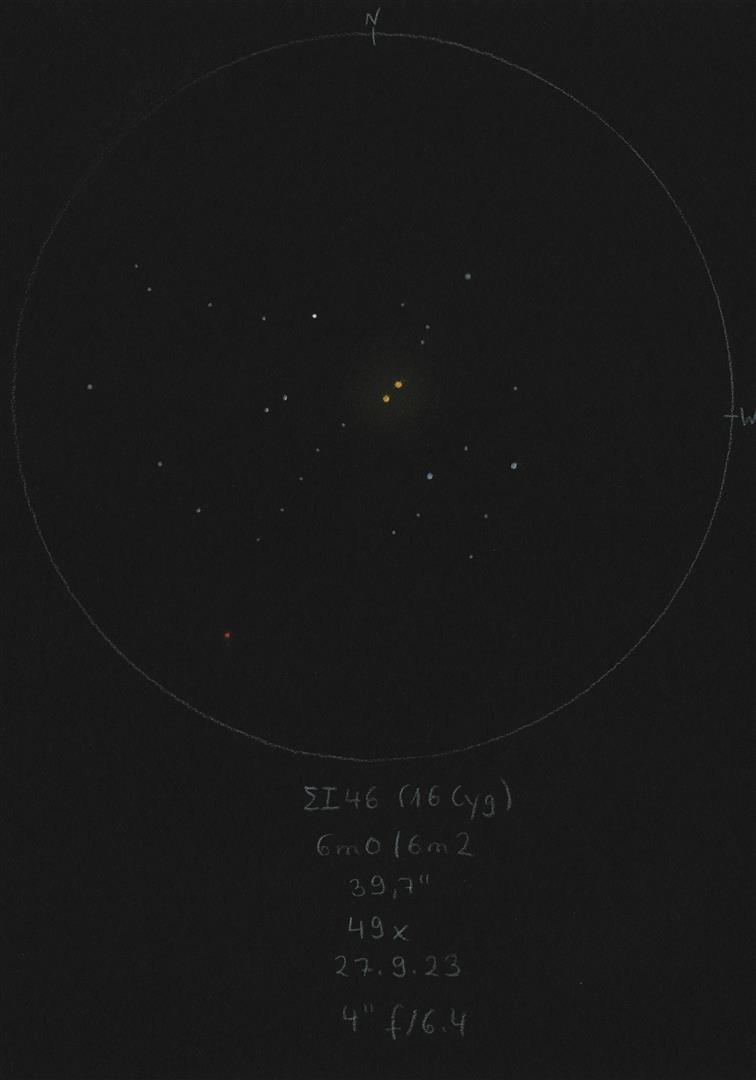
|
Sarah Gebauer
Germany |
100mm (80x) |
der Doppelstern springt mich regelrecht an bei der Suche nach dem Blinking PN, es sind zwei ganz durchdringende, gleich helle Sternpunkte, die zwar schon einem sternreichen Umfeld stehen, aber dennoch deutlich heller hervortreten; südlich davon befindet sich rein optisch betrachtet eine abgeschwächte Kopie davon |
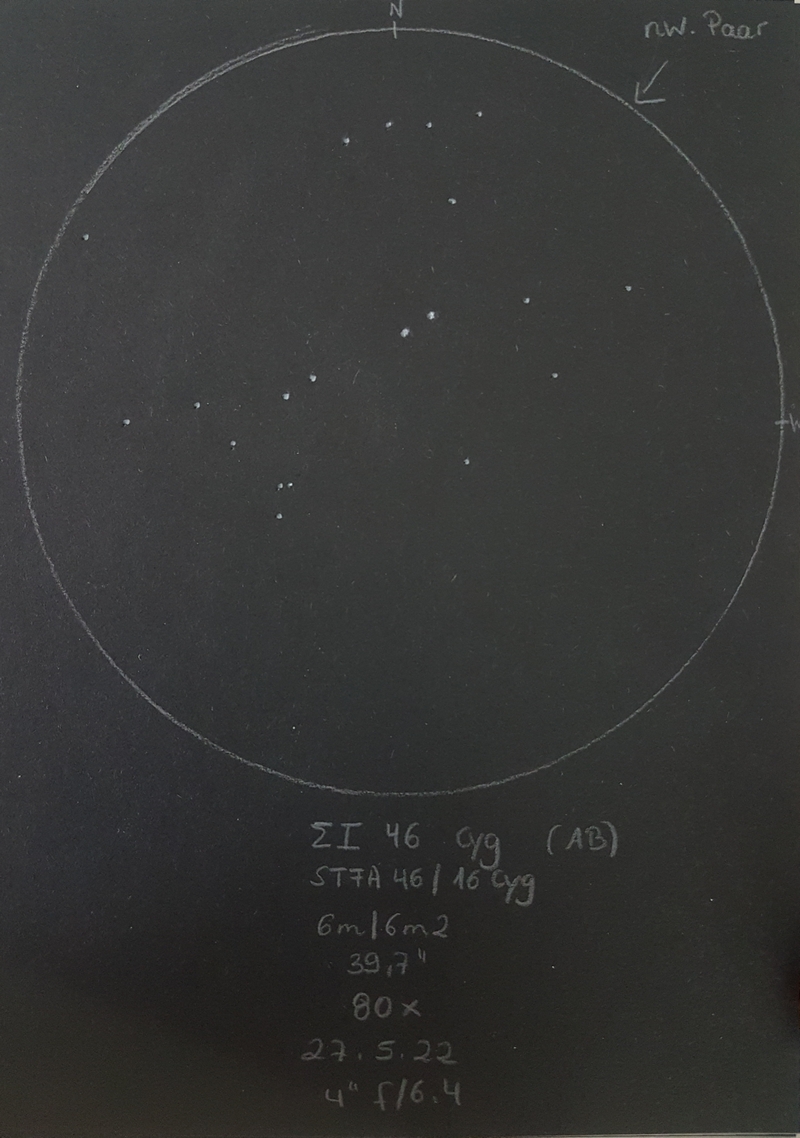
|
Mark McCarthy
Fremont (California/USA) |
317mm (553x) |
16 Cyg: Wide equal orange-yellow, also split in 80mm finder |
|
|
|
|
STF2594, 57 Aql |
|
AB |
5m.7 |
6m.3 |
36.3" |
171° |
2019 |
Aql |
19h54m37.65s / -08°13'38.30" |
René Merting
Drachhausen (Germany) |
10x50 |
ein einfacher Doppelstern - schön getrennt - Komponente A strahlt etwas weißer |
|
René Merting
Drachhausen (Germany) |
16x70 |
ein ansehnliches gut getrenntes Sternpaar - Komponente B im Süden ist gut eine halbe Größenklasse schwächer - das Weiß von Komponente A wirkt etwas kühler, während B eher in einem wärmeren zarten creme-gelb strahlt |
|
René Merting
Drachhausen (Germany) |
100mm (20x) |
bei 32x ein sehr auffälliges, komfortabel getrenntes Sternpaar - Komponente B im Süden ist eine halbe Magnitude schwächer - zurück auf 20x immernoch eine ordentliche Trennung, B wirkt jetzt etwas schmutziger weiß |
|
Sarah Gebauer
Germany |
100mm (21x) |
02.10.23: bei 21-fach ein gut getrenntes, helles, weißes Pärchen, die nördliche Komponente strahlt etwas warmweißer, die südliche etwas kaltweißer - bei 49-fach ändert sich zumindest am Farbeindruck nichts - schön mit im Bild ist weiter südlich der roségoldene 56 Aql |
|
Uwe Pilz
Leipzig (Germany) |
105mm (22x) |
orange-blau |
|
Uwe Pilz
Leipzig (Germany) |
320mm (36x) |
|
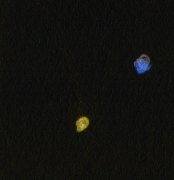
|
René Merting
Drachhausen (Germany) |
320mm (45x) |
der DS ist bei 45x schon sehr gut getrennt zu sehen, A ist leicht gelblich, B blauweiß, ein schönes Farbkontrastpaar mit weitem Abstand und etwa einer dreiviertel Größenklasse Helligkeitsunterschied |
|
|
Berthold Fuchs
Wiesbaden (Germany) |
130mm |
easy DS |
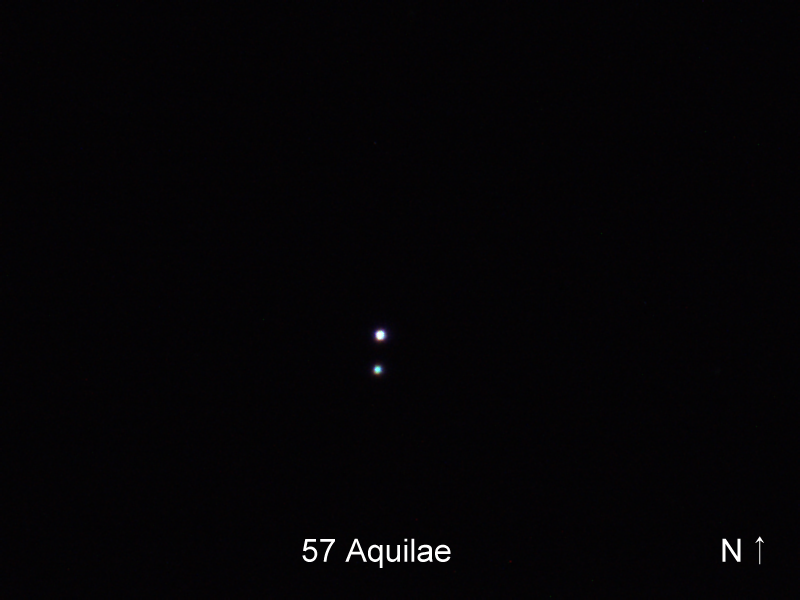
|
|
|
|
STTA198 |
|
AB |
7m.1 |
7m.5 |
64.6" |
185° |
2018 |
Aql |
20h06m38.76s / +07°34'34.20" |
René Merting
Drachhausen (Germany) |
12x50 |
ein schöner, einfacher FG-Doppelstern - ein Paar heller Sterne, gut getrennt - das Paar steht gut isoliert - B ist eine halbe Größenklasse schwächer |
|
Sarah Gebauer
Germany |
100mm (21x) |
25.09.23: bei 21-fach der östlichste Stern in einer Fünferkette, zwei gleich helle Glanzpünktchen im Norden und Süden - der westlichste Kettenstern mit leicht gelber Farbe ist am hellsten, es folgen drei besonders schwache Sternchen, dann folgt das weit getrennte, unspektakulär weiße Doppel |
|
|
|
|
S735 |
|
|
7m.2 |
8m.0 |
56.4" |
211° |
2019 |
Aql |
20h11m18.86s / -00°07'35.30" |
René Merting
Drachhausen (Germany) |
10x50 |
ein einfaches zu trennendes Paar - Komponente B im SW ist keine ganze Größenklasse schwächer - leichter Farbkontrast, A weiß, B grau-weiß |
|
René Merting
Drachhausen (Germany) |
12x50 |
leicht zu trennen - B steht im SSW von A und wirkt grau gegen die weißgelb strahlende A-Komponente |
|
René Merting
Drachhausen (Germany) |
320mm (45x) |
ein weit getrenntes Paar - Komponente B im Südwesten ist eine halbe Magnitude schwächer - A wirkt etwas warmweißer mit einem zarten Gelbstich |
|
|
|
★★★
|
STFA50, 30/31 Cyg, omicron Cyg |
|
AC |
3m.9 |
7m.0 |
108.6" |
173° |
2016 |
Cyg |
20h13m37.90s / +46°44'28.80" |
|
|
|
|
AD |
3m.9 |
4m.8 |
336.7" |
322° |
2016 |
|
|
Robert Zebahl
Leipzig (Germany) |
naked eye |
AD: Well split with noticeable difference in brightness. |
|
René Merting
Drachhausen (Germany) |
naked eye |
meist sehe ich nur einen diffusen Lichtpunkt und dann irgendwann … immer wieder sind A und D klar erkennbar und getrennt voneinander zu sehen - D steht in Richtung Nordwesten von A aus gesehen |
|
Sarah Gebauer
Germany |
naked eye |
AC: 16.09.23 Jeßnigk: Ohne zu wissen, dass es möglich ist, lässt sich Omicron 1 Cygni in beide Komponenten auftrennen - mit deutlichem Helligkeitsunterschied und sichtbarem Abstand zueinander sind beide Sterne sehr gut einzeln zu sehen |
|
Christopher Hay
Seeheim (Germany) |
3x63 |
AD: Self-built binoculars, hence the unusual specification.
Widely split, A (31 Cyg) light orange, D (30 Cyg) light blue. |
|
Christopher Hay
Seeheim (Germany) |
7x50 |
A-D: Widely split, A (31 Cyg) luminous orange-red, D (30 Cyg) luminous ice-blue. C set off from A as a fine speck of light. |
|
Robert Zebahl
Leipzig (Germany) |
8x40 |
AC: Observation at full moon. Easily split with big difference in brightness. Brighter component slightly orange. C component rather faint. |
|
Robert Zebahl
Leipzig (Germany) |
8x40 |
AD: Wonderful double star for binoculars. Large distance of the components, brighter once (31 Cyg) appeared slightly orange, the fainter (Cyg 30) more bluish. |
|
Christopher Hay
Seeheim (Germany) |
15x45 |
A-D: Very wide apart but still perceived as belonging together. A (31 Cyg) orange-red, D (30 Cyg) ice-blue. C well set off from A and light ice-blue, like an echo of D. A delightful group of three for binoculars at this power, further accentuated by nearby orange Omicron2 Cygni. Both the brightnesses and colour hues of Omi1A and Omi2 appear practically identical. |
|
Robert Zebahl
Leipzig (Germany) |
16x70 |
2020-07-03: Fantastic sight. A: bright orange, D: white-bluish, C: light blue. Very beautiful field. |
|
René Merting
Drachhausen (Germany) |
18x70 |
wunderschön - Komponente A präsentiert sich buttergelb - die südliche, schwächste Komponente C zeigt sich aquamarinblau - D im Norden ist reinweiß und steht dreimal weitere entfernt wie AC |
|
René Merting
Drachhausen (Germany) |
76mm (57x) |
Mondscheinnacht - bei 29x ein wunderschönes Sterntrio, A wirkt goldgelb, D weiß mit einem Stich ins türkise, C ist kühlweiß mit einem Stich ins Blaue |
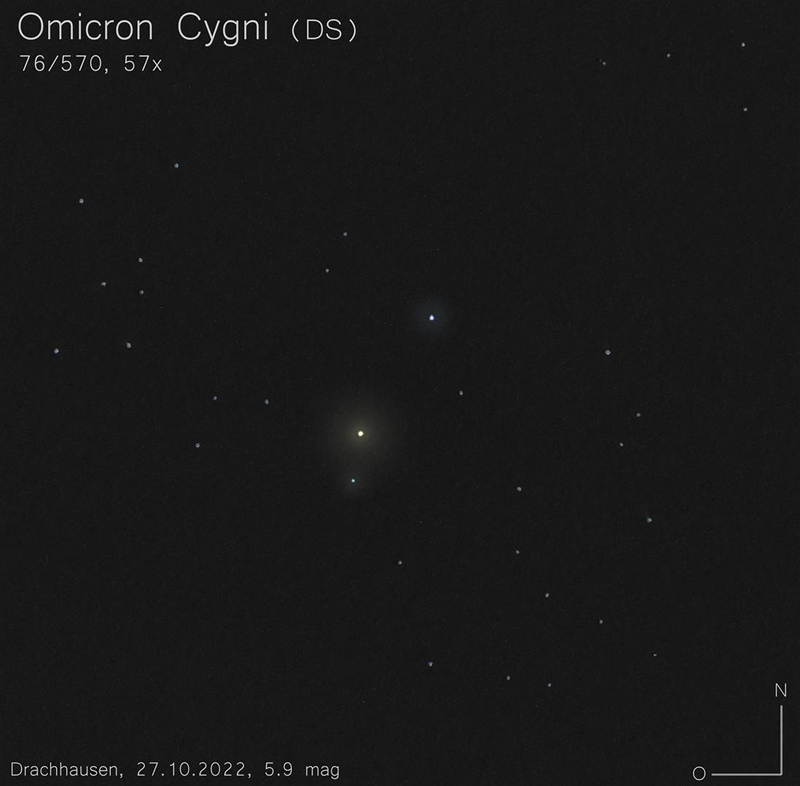
|
Robert Zebahl
Leipzig (Germany) |
80mm (25x) |
AC: Similar to the observation with binoculars. C component appeared bluish and gave good contrast to the orange colored 31 Cyg. |
|
René Merting
Drachhausen (Germany) |
100mm (32x) |
bei 32x sind alle drei Sterne weit getrennt und doch irgendwie zusammengehörend, Komponente A ist rapsgelb und am auffälligsten, Komponente D strahlt weiß und die schwächste Komponente C schimmert bläulich, schöner Anblick |
|
Robert Zebahl
Leipzig (Germany) |
102mm (28x) |
Bright, wide apart and wonderful contrast in color. A: light yellowish-orange, C: blue, D: light blue. |
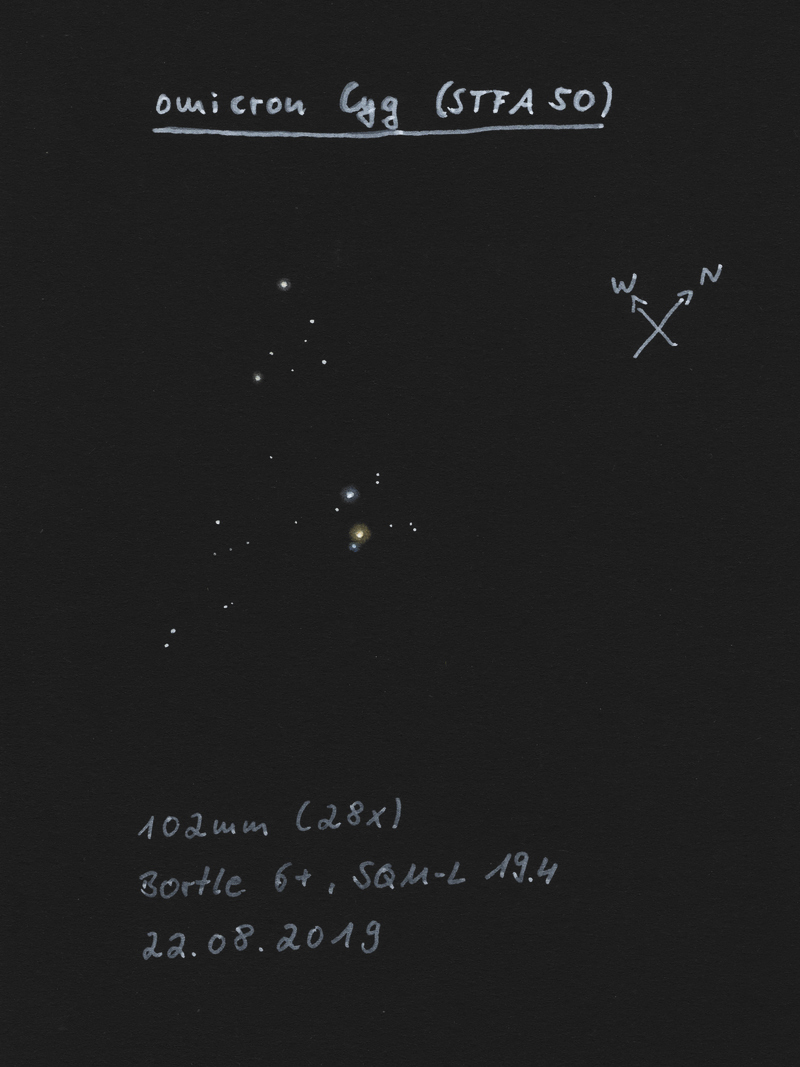
|
René Merting
Drachhausen (Germany) |
107mm (30x) |
|
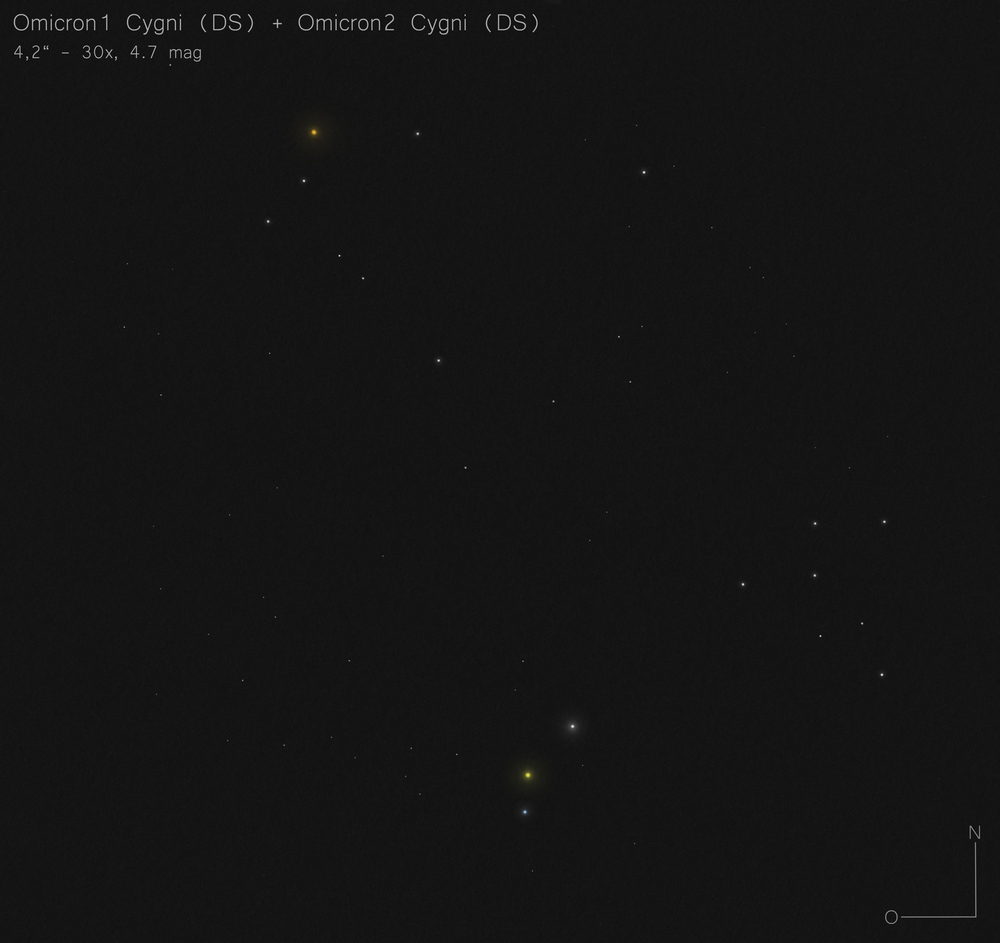
|
Sarah Gebauer
Germany |
150mm (30x) |
die drei Komponenten plus Omicron2 bilden ein wunderschönes, sehr langes und spitzes Dreieck und zeigen dabei wundervolle Farben, Komponente A von o1 sowie o2 erscheinen schön gelblich, Komponente D von o1 hat einen deutlichen Blaustich im Weißen, wirklich ein sehr schönes Gesamtbild - auf Komponente C hatte ich nicht geachtet |
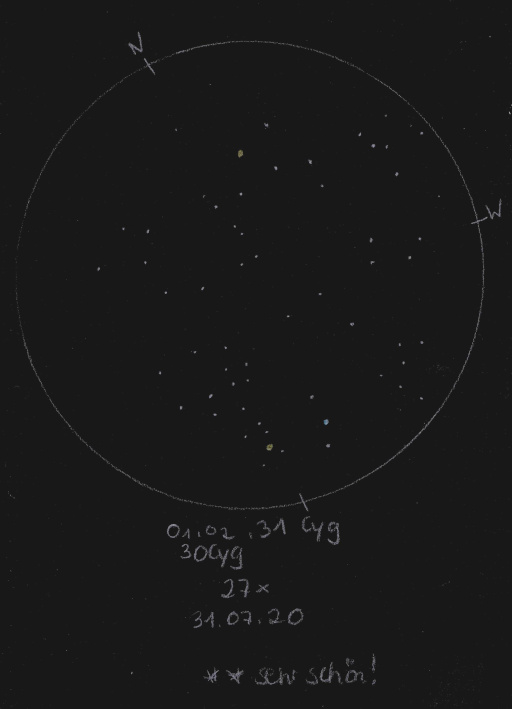
|
Sarah Gebauer
Germany |
150mm (85x) |
dieses Mal nur die drei dicht beieinanderstehenden Komponenten A, C und D im Sichtfeld gehabt, Komponente A ist wieder deutlich gelbgold, C wirkt leicht bläulich und Komponente D wirkt dieses Mal eher weiß |
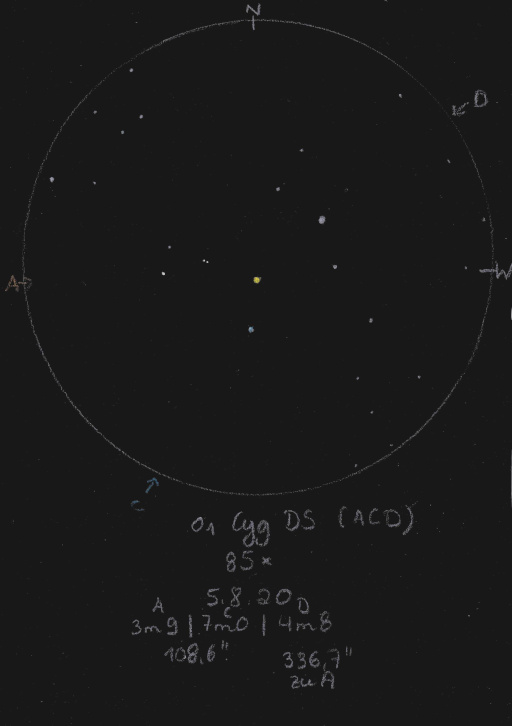
|
|
|
|
S740 |
|
AB |
7m.8 |
8m.1 |
43.9" |
192° |
2019 |
Aql |
20h14m09.77s / +06°35'20.30" |
René Merting
Drachhausen (Germany) |
10x50 |
ordentlich getrenntes gut sichtbares Sternpaar - Komponente A im Norden ist nur unwesentlich heller |
|
René Merting
Drachhausen (Germany) |
12x50 |
zwei schwache Sterne, gut getrennt voneinander - B im Süden ist nur knapp schwächer als A |
|
René Merting
Drachhausen (Germany) |
100mm (20x) |
bei 20x zeigen sich beide Sterne weit getrennt und sind gut sichtbar - Helligkeitsunterschied eine halbe Magnitude - Komponente A im Norden ist weiß-gelblich, B leicht blau-grau |
|
|
|
|
ENG72, 29 Cyg |
|
AB |
5m.0 |
6m.7 |
215.3" |
155° |
2016 |
Cyg |
20h14m31.98s / +36°48'22.10" |
Robert Zebahl
Leipzig (Germany) |
16x70 |
2020-09-20: Widely separated pair in nice star field with moderate difference in brightness and beautiful color contrast: whitish & yellow-orange. |
|
|
|
★
|
STFA51, alpha Cap, alpha 1/2 Cap |
|
AE |
3m.7 |
4m.3 |
381.2" |
290° |
2012 |
Cap |
20h18m03.22s / -12°32'41.40" |
Sarah Gebauer
Germany |
naked eye |
mit freiem Auge sind am südlichen Horizont in Dänemark zwei helle Sterne zu sehen, die verdächtig nach Doppelstern ausschauen |
|
Christopher Hay
Seeheim (Germany) |
naked eye |
While waiting for Comet Neowise at 3 in the morning in July 2020 surprised myself with my first naked-eye separation of Alpha1 und Alpha2 Capricornis (observing site at 50° northern latitude, Alpha1/2 passing through meridian). Western, weaker component Alpha 1 Cap well separated from Alpha 2 Cap in good moments. Much more difficult to split naked-eye than Mizar/Alcor (Zeta UMa). Not a physical double. |
|
Sarah Gebauer
Germany |
8x30 |
im Fernglas ein ganz toller, heller und weit getrennter Doppelstern, sehr schöne Sichtung abwechselnd mit und ohne FG |
|
René Merting
Drachhausen (Germany) |
12x50 |
ein wunderschönes Sternpaar, obwohl beide so weit auseinander stehen - die hellere östliche Komponente strahlt buttergelb, der Begleiter ist weiß |
|
René Merting
Drachhausen (Germany) |
15x56 |
ein schönes Paar zweier gelblich schimmernder Sterne - weit auseinanderstehend und doch wirken beide gut zusammen - die westliche Komponente E ist ein wenig schwächer |
|
Sarah Gebauer
Germany |
100mm (21x) |
bei 21x sind alpha1 und alpha2 deutlich getrennt voneinander mit ganz leicht orangefarbenem Eindruck, sie stechen wie zwei helle Augen hervor |
|
René Merting
Drachhausen (Germany) |
320mm (45x) |
?1 und ?2 Capricorni - bei 45x zwei strahlend hellgelbe, weit getrennte Bananensterne, von denen die westliche Komponente auch noch einmal einen schwachen Begleiter im Südwesten hat, der bereits sichtbar ist |
|
|
|
|
STF2664 |
|
|
8m.1 |
8m.3 |
27.8" |
322° |
2019 |
Del |
20h19m38.48s / +13°00'17.20" |
René Merting
Drachhausen (Germany) |
10x50 |
zwei gleich helle Sterne in Südost-Nordwest-Ausrichtung - Trennung eindeutig, aber sehr knapp |
|
Robert Zebahl
Leipzig (Germany) |
16x70 |
2020-08-19: Well separated with a clear, but not too wide separation. Slightly different in color, with the southern component appearing slightly cooler. Beautiful surrounding field. |
|
Robert Zebahl
Leipzig (Germany) |
16x70 |
2021-09-02: Quite conspicuous as a double star, moderately bright with very little difference in brightness. Slightly orange & white-bluish. |
|
Uwe Pilz
Leipzig (Germany) |
16x70 |
|
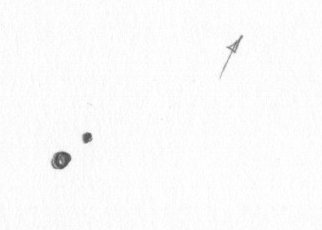
|
René Merting
Drachhausen (Germany) |
100mm (20x) |
bei 32x sehr weit getrennt - trotz der großen Trennung auffällig, da kaum weitere Sterne im unmittelbaren Umfeld stehen - Komponente B im NW ist nicht viel schwächer als A - zurück auf 20x ist der Abstand zwischen beiden Sternen immer noch sehr groß |
|
Mark McCarthy
Fremont (California/USA) |
152mm (285x) |
Wide, white, slight magnitude difference |
|
Karsten Kopp
Köln (Germany) |
600mm (180x) |
Doppelstern ist einfach zu trennen, mit sehr leichtem Helligkeitsunterschied. Komponente A leuchtet leicht gelblich und Komponente B geht ins bläuliche. |
|
|
|
★★★
|
BLL49, U Cyg |
|
|
8m.0 |
9m.0 |
65.4" |
231° |
2015 |
Cyg |
20h19m41.66s / +47°54'19.90" |
|
|
Robert Zebahl
Leipzig (Germany) |
16x70 |
2020-07-03: Easy split with very good color contrast: white and clear orange. |
|
Sarah Gebauer
Germany |
100mm (80x) |
20.09.23: absolut vergleichbar mit der Beobachtung mit dem 10''-Spiegel, alle Sterne wirken nur etwas schwächer, der Farbeindruck ist jedoch genau so intensiv |
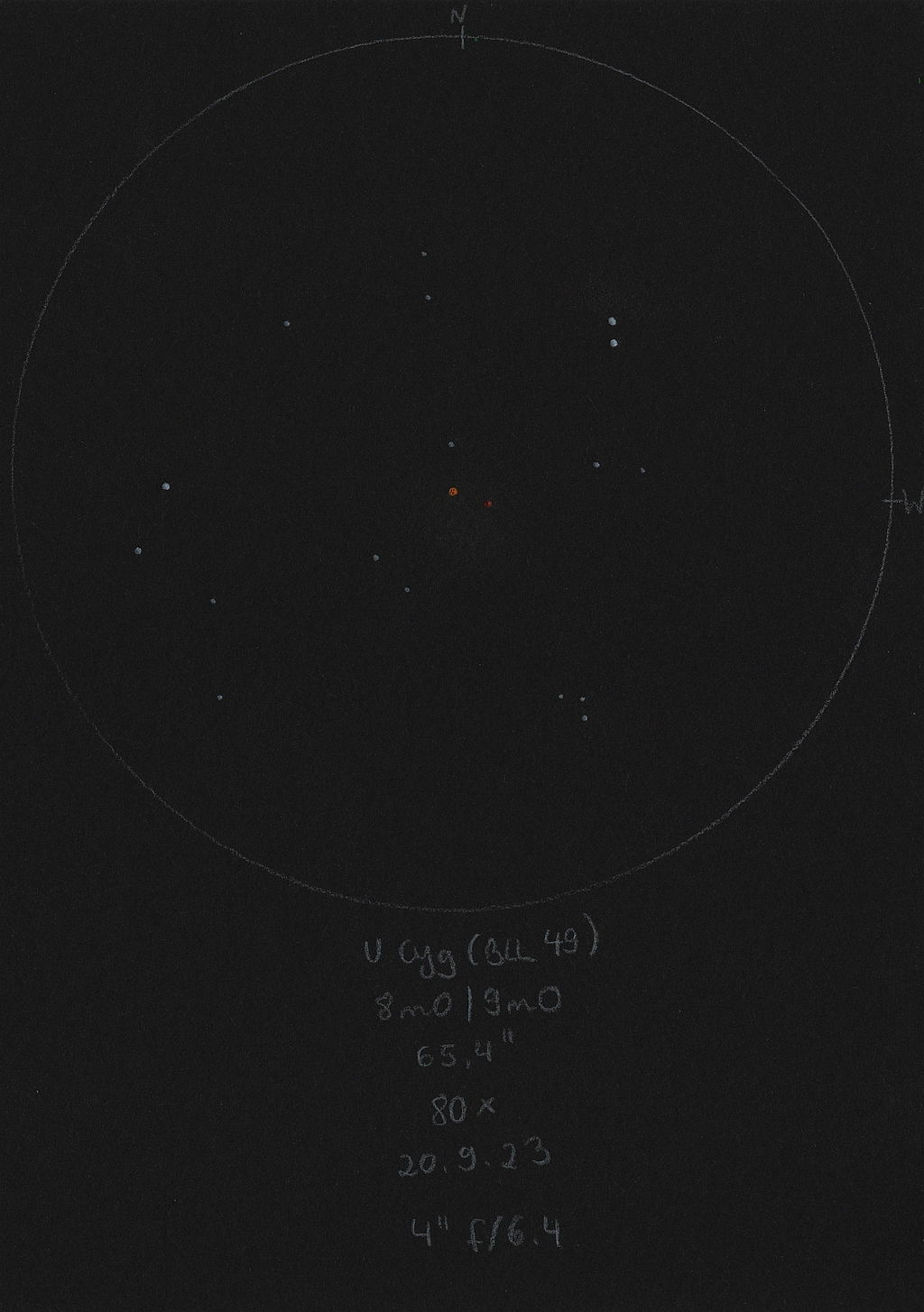
|
Robert Zebahl
Leipzig (Germany) |
102mm (28x) |
2019-08-22: While the primary component appears quite unspectacular in a white, the companion U Cygni is much more interesting. It is a carbon star whose brightness varies between 5m9 and 12m1 with a period of about 463 days. It appears in mostly intensely orange, and even deep red in the towards its minimum. Extremely rewarding! |
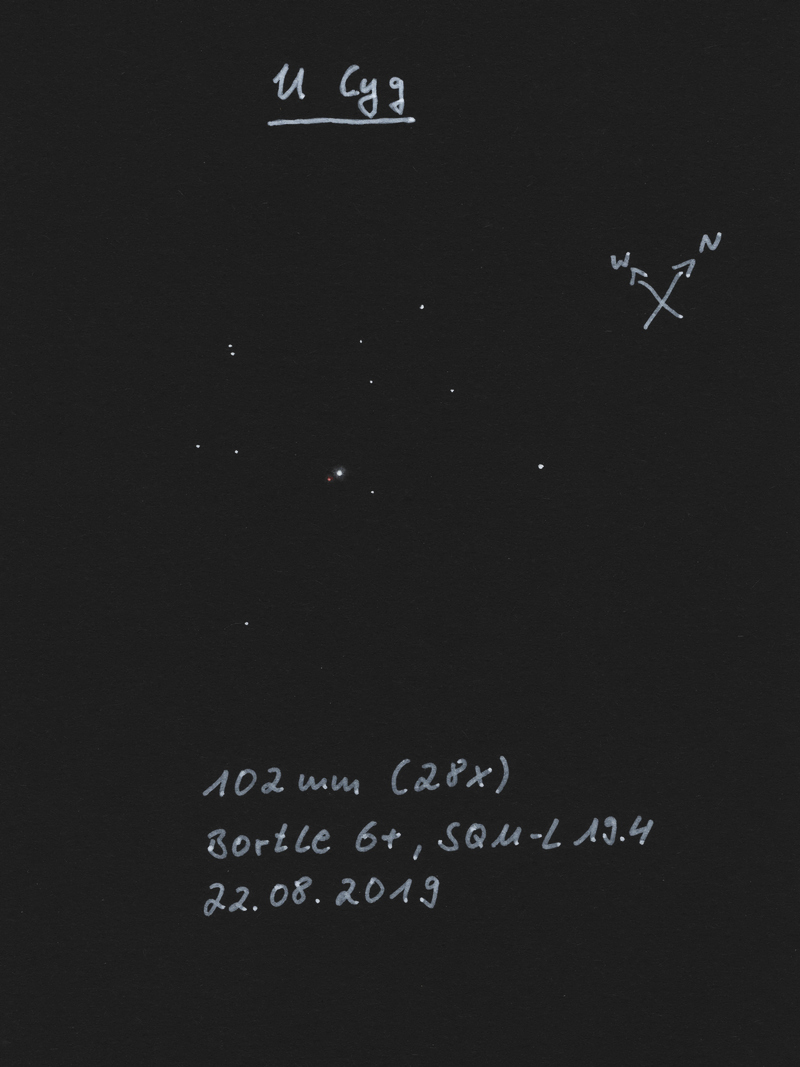
|
Sarah Gebauer
Germany |
254mm (96x) |
12.09.23: abartig krebsrot, richtig metallisch, dunkel, stark und ein richtiger Kracher bei 96-fach - der Begleiter im Nordosten mit recht weitem Abstand zeigt ein ganz zartes, hellbuttriges Cremegelb |
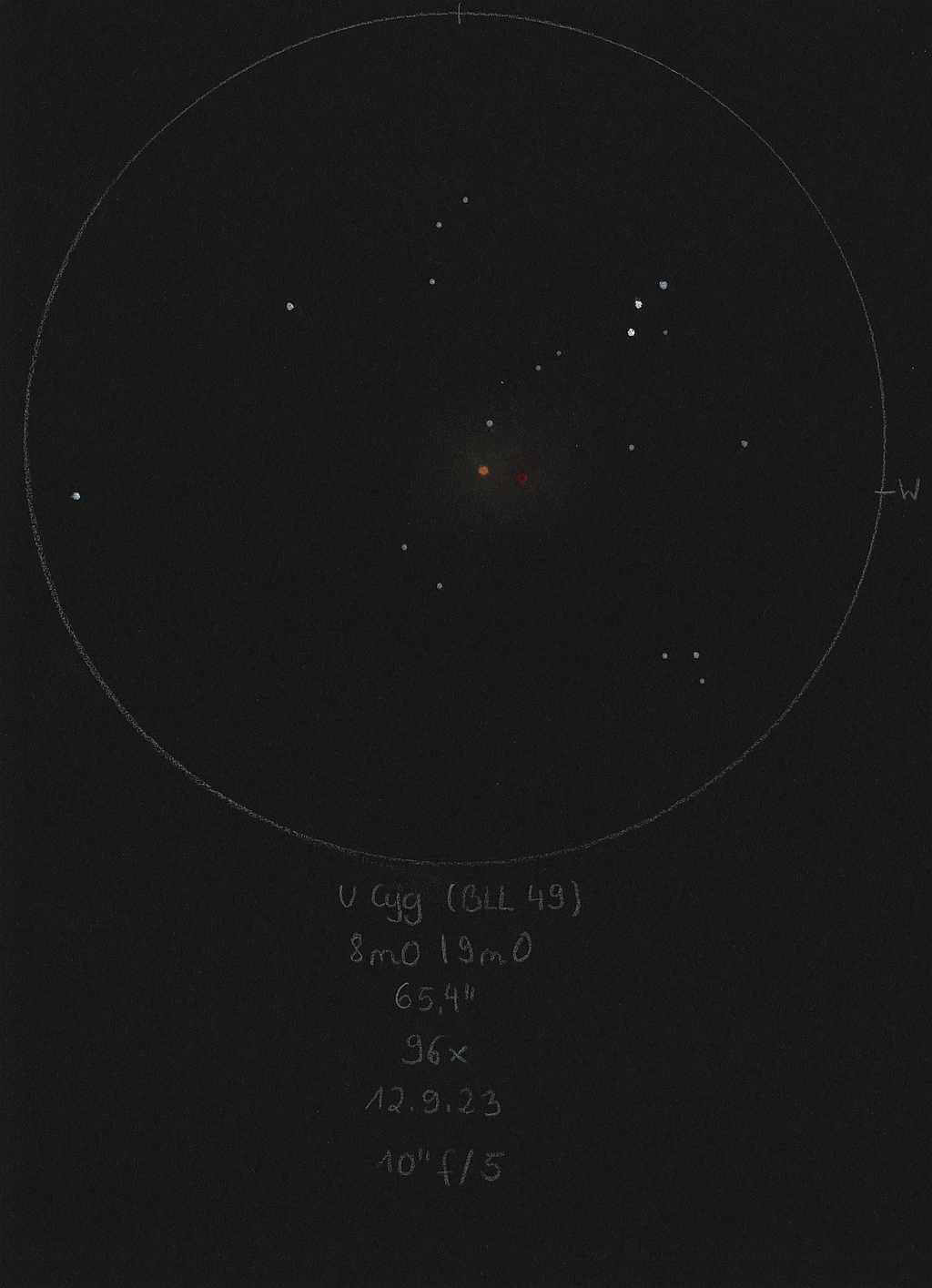
|
René Merting
Drachhausen (Germany) |
320mm (72x) |
|
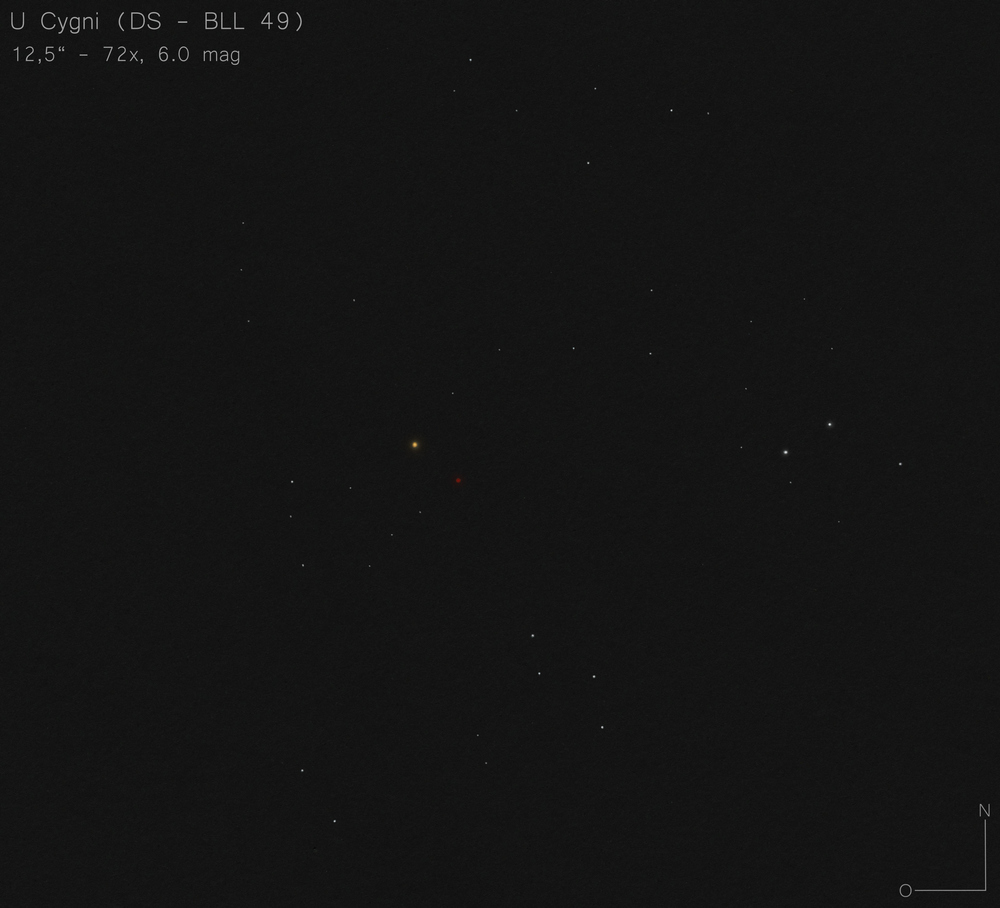
|
|
|
|
STFA52, beta Cap, beta 1/2 Cap, 9 Cap, Dabih |
|
AB |
3m.1 |
6m.1 |
205.2" |
266° |
2016 |
Cap |
20h21m00.67s / -14°46'53.00" |
|
|
|
|
AC |
3m.1 |
8m.8 |
226.1" |
133° |
2012 |
|
|
|
|
|
|
BC |
6m.1 |
8m.8 |
396.5" |
111° |
2015 |
|
|
René Merting
Drachhausen (Germany) |
12x50 |
AB: beide Sterne sind halb so weit getrennt, wie die Komponenten von Alpha Cap (STFA 51), Abstand aber immernoch riesig - B ist deutlich schwächer, schätzungsweise 2.5 Magnituden - B wirkt grau gegen die leicht gelb schimmernde A-Komponente |
|
René Merting
Drachhausen (Germany) |
15x56 |
AB: ein auffälliges Paar, wenn auch weit auseinanderstehend - A im Osten strahlt glänzend gelblich, B dagegen ist weißgrau und mindestens 2 Größenklassen schwächer |
|
Sarah Gebauer
Germany |
254mm (49x) |
AB: bei 49-fach ist bei der Hauptkomponente auf ein Anhieb ein sehr warmgelber bis kupfergoldener Farbton zu sehen – bei 96-fach mischt sich ein weißer Glanz dazu – der Begleiter steht weit abseits und zeigt bei 49-fach einen sehr kühlen Farbton |
|
René Merting
Drachhausen (Germany) |
320mm (45x) |
AB: ?1 und ?2 Capricorni - A strahlt bei 45x sehr schön gelb, etwas weniger imposant als Alpha Cap, die B-Komponente steht weit getrennt westlich und strahlt eher weiß-grau und 2-3 Größenklassen schwächer
A-DE: nordwestlich von A sind die beiden Komponenten DE bei 45x nochmals als eine ganz schwache Komponente in einem rechten Winkel zu A und B zu sehen, der Helligkeitsunterschied zu B beträgt nochmals etwa 2-3 Größenklassen |
|
|
|
★
|
STF2687 |
|
|
6m.4 |
8m.3 |
25.1" |
118° |
2019 |
Cyg |
20h26m23.47s / +56°38'19.30" |
Robert Zebahl
Leipzig (Germany) |
16x70 |
2020-08-19: Gorgeous sight, separated with distinct brightness difference. Primary component appeared rather white with a greyish companion. With two similarly bright stars to the east and southeast STF 2687 forms a prominent triangle surrounded by several star chains. About 12 arcminutes apart to the southeast of STF 2687 is another pair of stars, which is particularly striking because of its color (bluish & orange). |
|
René Merting
Drachhausen (Germany) |
76mm (29x) |
bei 29x ein ordentlich getrenntes Sternpaar - B im Osten von A ist gut 1.5 bis 2 Magnituden schwächer und wirkt noch ordentlich weiß gegenüber der helleren Komponente, muss sich also nicht verstecken |
|
|
|
|
S749 |
|
AB |
6m.8 |
7m.5 |
60.0" |
189° |
2022 |
Aql |
20h27m27.56s / -02°06'10.50" |
|
|
|
|
AC |
6m.8 |
11m.3 |
45.6" |
329° |
2022 |
|
|
|
|
|
|
AD |
6m.8 |
12m.4 |
89.9" |
269° |
2022 |
|
|
|
|
|
|
CD |
10m.8 |
11m.0 |
77.5" |
239° |
2022 |
|
|
|
|
|
|
CE |
10m.8 |
13m.7 |
18.8" |
197° |
2022 |
|
|
|
|
|
|
DF |
11m.0 |
13m.6 |
6.7" |
26° |
2022 |
|
|
René Merting
Drachhausen (Germany) |
12x50 |
AB: zwei relativ helle Sterne in Nordsüd-Ausrichtung, komfortabel getrennt - B im Süden ist eine halbe Größenklasse schwächer und blaugrau ggü. der weißen A-Komponente |
|
|
|
|
STF2691 |
|
|
8m.1 |
8m.4 |
16.3" |
32° |
2019 |
Cyg |
20h29m43.18s / +38°07'31.50" |
Robert Zebahl
Leipzig (Germany) |
16x70 |
2020-08-19: Nicely separated and in one field of view together with 40 Cygni and Messier 29. Moderate distance and brightness difference, relatively conspicuous even though the environment is rather rich in stars. |
|
René Merting
Drachhausen (Germany) |
18x70 |
das Paar ist genau richtig für 18-fache Vergrößerung - ein schön isoliert stehendes, knapp getrenntes Sterndoppel zweier gleichheller Protagonisten - Komponente B im NO ist nur unwesentlich schwächer |
|
Robert Zebahl
Leipzig (Germany) |
70mm (22x) |
2020-07-29: At 22x clearly separated with little difference in brightness. Colorwise the components appeared different: yellowish-orange & bluish. The color impression was a bit more intense at 44x: slightly orange & bluish. |
|
René Merting
Drachhausen (Germany) |
100mm (20x) |
bei 20x ein schönes knapp getrenntes Pärchen aus zwei schwächeren Sternen - Komponente A im Süden ist nur unwesentlich heller als B - bei 32x leichter Farbkontrast, weil A warm-weiß strahlt |
|
Uwe Pilz
Leipzig (Germany) |
105mm (53x) |
schon bei 22x auffallend |
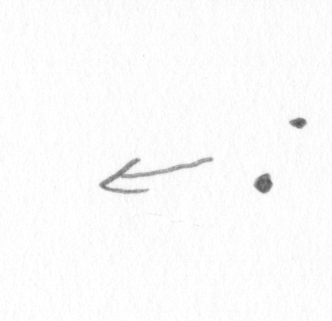
|
|
|
★
|
omicron Cap, 12 Cap, SHJ324 |
|
AB |
5m.9 |
6m.7 |
22.0" |
238° |
2019 |
Cap |
20h29m53.91s / -18°34'59.40" |
René Merting
Drachhausen (Germany) |
12x50 |
ein dicht zusammenstehendes, gut getrenntes Paar, beide Komponenten sind schön hell - die Komponente B im SW ist eine halbe Größenklasse schwächer |
|
René Merting
Drachhausen (Germany) |
15x56 |
ein wunderschöner Doppelstern, ein bisschen mehr als gut getrennt - ich habe den Eindruck von einem Farbkontrast, der hin und her zu springen scheint (lt. Stelledoppie sind beide Sterne reinweiß) |
|
René Merting
Drachhausen (Germany) |
320mm (45x) |
bei 45x ein ordentlich getrenntes Sternpaar, A im Osten strahlt minimalst warmweiß, B wirkt ähnlich, wenn auch eine viertel bis halbe Größenklasse schwächer, durch Seeingeffekte glitzern die Sterne wunderschön |
|
|
|
★
|
STF2690 & HJ269 & DA1 |
STF2690 |
A-BC |
7m.1 |
7m.4 |
17.8" |
255° |
2020 |
Del |
20h31m11.94s / +11°15'33.70" |
|
|
|
HJ269 |
AD |
7m.1 |
12m.1 |
23.0" |
108° |
2016 |
|
|
|
|
|
DA1 |
BC |
7m.9 |
8m.0 |
0.3" |
184° |
2016 |
|
|
|
|
René Merting
Drachhausen (Germany) |
10x50 |
STF2690 (A-BC): ein ganz enges Sternpaar mit zwei gleich hellen Sternen - ich würde beide als 8 mit tiefer Einschnürung bezeichnen, also kurz vor der Trennung |
|
Robert Zebahl
Leipzig (Germany) |
12x42 |
STF2690 (A-BC): 2021-10-09: Very nice. Clearly separated with almost equally bright components. |
|
René Merting
Drachhausen (Germany) |
12x42 |
STF2690 (A-BC): ein superenges, schönes Paar gleich heller Sterne - da passen maximal eineinhalb Blatt Papier zwischen - schön im Zusammenspiel mit den beiden hellen Sternen südöstlich und südwestlich |
|
Robert Zebahl
Leipzig (Germany) |
16x70 |
STF2690 (A-BC): 2020-08-19: Striking, moderately bright with nice separation of the similarly bright components in nice environment. The eastern component seemed slightly brighter and colorwise cooler. |
|
Uwe Pilz
Leipzig (Germany) |
16x70 |
STF2690 (A-BC) |
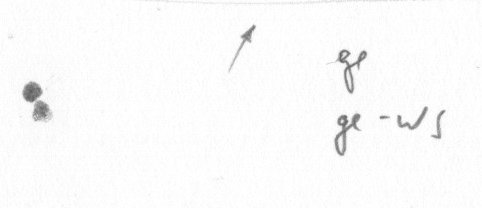
|
Uwe Pilz
Leipzig (Germany) |
16x70 |
STF2690 (A-BC): etwa gleichhell, sauber getrennt |
|
René Merting
Drachhausen (Germany) |
100mm (20x) |
STF2690 (A-BC): bei 32x ein schön getrenntes Sternpaar mit leichtem Farbkontrast - Komponente A im Osten ist weiß, BC im Westen ist leicht gelblich und dumpfer, aber kaum ein Helligkeitsunterschied zwischen beiden Sternen - zurück auf 20x ist das Paar noch schöner anzusehen, weil beide Sterne dichter zusammen stehen |
|
Sarah Gebauer
Germany |
100mm (49x) |
STF2690 (A-BC): weit getrennt, zwei simple Glupschäuglein im Leeren, mehr nicht |
|
Robert Zebahl
Leipzig (Germany) |
102mm (28x) |
STF2690 (A-BC): 2021-09-11: Very attractive, almost equally bright with subtle color contrast: pale yellow-orange & white-bluish. |
|
Robert Zebahl
Leipzig (Germany) |
152mm (30x) |
STF2690 (A-BC): 2021-09-08: Striking in nice star environment, easy to separate with little difference in brightness. Both components appeared slightly yellowish. |
|
Mark McCarthy
Fremont (California/USA) |
317mm (277x) |
STF2690 (A-BC): Widely separated near equal white stars. |
|
Mark McCarthy
Fremont (California/USA) |
508mm (533x) |
DA1 (BC): This is part of STF 2690 A-BC, which is a white, wide, near equal, pair (7.12/7.39 17.7") observed with 8-inch at 205x. I suspected BC at 8-inch 333x, & had overlapping disks with 8-inch 533x. With 20-inch 533x I see a hairline split, slight magnitude difference. Seeing is not supporting it well, but it's clear. Very nice. Dawes discovered in 1840 at 0.7" -- DA 1 was discovered when Dawes was working at "Mr Bishop's observatory" in London, from 1839 to 1844. It had a 7-inch refractor by Dollond (1836) who had made both mounting and telescope. So at current 0.369" it's not surprising I only had overlapping disks at 8-inch. It's a physical pair, with a 236.52 year period, and will widen another 0.1" in the next 15 years |
|
Karsten Kopp
Köln (Germany) |
600mm (180x) |
STF2690 (A-BC): STF 2690: Gut zu trennender Doppelstern mit leichtem Helligkeitsunterschied. Komponente A leuchtet weiß und die Komponente B geht ins gelbliche. |
|
|
|
|
STF2700 |
|
|
7m.0 |
8m.8 |
24.1" |
284° |
2019 |
Cyg |
20h34m44.60s / +32°30'21.10" |
René Merting
Drachhausen (Germany) |
18x70 |
das interessanteste Sternpaar innerhalb der Region um 48 Cyg und Ary 48 - ein getrenntes, aber schönes enges Double - Komponente B im Westen ist gut 2 Größenklassen schwächer |
|
René Merting
Drachhausen (Germany) |
76mm (29x) |
Mondscheinnacht - bei 29x ein schöner Anblick, Komponente B zeigt sich knapp abgesetzt von A ganz schwach - B ist dennoch gut erkennbar - ein schönes Pärchen |
|
René Merting
Drachhausen (Germany) |
100mm (20x) |
bei 32x steht B in ordentlichem Abstand zu A im Westen und ist gut 1.5 bis 2 Größenklassen schwächer - Komponente A gelblich, B dagegen wirkt weiß-grau - zurück auf 20x ist die Trennung weiterhin leicht, B ist gut erkennbar |
|
Sarah Gebauer
Germany |
100mm (80x) |
20.09.23: bei 80-fach ist der DS eher zurückhaltend, die Hauptkomponente zeigt sich ganz leicht gelblich, der Begleiter in weitem Abstand grau |
|
|
|
★★
|
STF2703 |
|
AB |
8m.3 |
8m.4 |
25.1" |
290° |
2019 |
Del |
20h36m49.41s / +14°43'42.40" |
|
|
|
|
AC |
8m.3 |
8m.8 |
77.8" |
234° |
2016 |
|
|
|
|
|
|
AD |
8m.3 |
12m.8 |
84.7" |
347° |
2016 |
|
|
|
|
|
|
BC |
8m.4 |
8m.8 |
67.0" |
215° |
2016 |
|
|
René Merting
Drachhausen (Germany) |
12x42 |
AB: flüchtig betrachtet erst übersehen (C im Südwesten hat etwas abgelenkt), aber bei genauem Hinschauen ist zu erkennen, dass die nordöstliche Komponente aus zwei gleich hellen Sternen besteht
AC: die südwestliche Komponente hat dreifachen Abstand wie AB |
|
Robert Zebahl
Leipzig (Germany) |
16x70 |
2020-08-19: Immediately eye-catching multiple star located between beta and zeta Delphini. Components A, B & C are very easily seen as a triple system forming a striking triangle. A very slight difference in brightness between A & B is perceptible, as well as a color difference, though I cannot name any colors. Very nice. |
|
Uwe Pilz
Leipzig (Germany) |
16x70 |
AB |
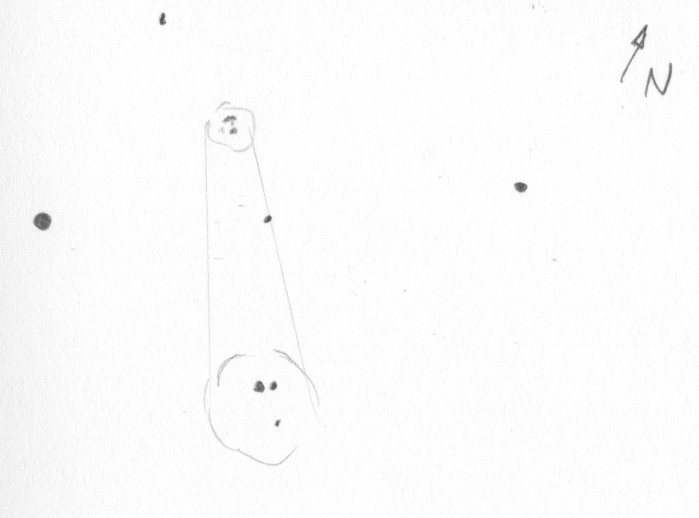
|
René Merting
Drachhausen (Germany) |
100mm (20x) |
AB: bei 20x einfach - Komponente B im Westen ist nur minimal schwächer
BC: bei 20x ist Komponente C südwestlich von B in mehr als dem doppeltem Abstand von A zu B erkennbar, Helligkeitsunterschied gut eine halbe Größenklasse |
|
Uwe Pilz
Leipzig (Germany) |
105mm (144x) |
AB |
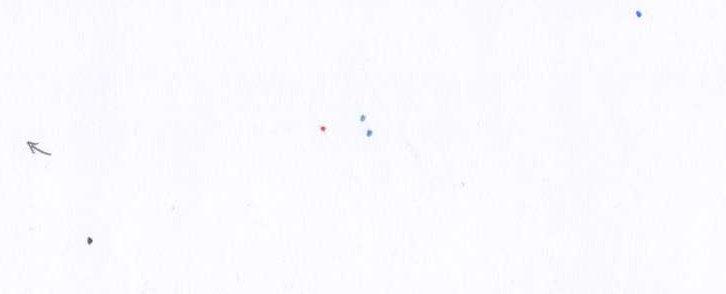
|
Karsten Kopp
Köln (Germany) |
600mm (180x) |
Sehr schönes Mehrfachsternsystem. AB mit fast identische Helligkeit, wobei Komponente C mit 0,5 mag etwas schwächer ist. Ansonsten sind AB,AC und BC als auffälliges Dreieck leicht zu trennen. AD: Hier ist die Komponente D eine sehr große Herausforderung, die ich nur mit indirektem aus der Stadt heraus sichten konnte. |
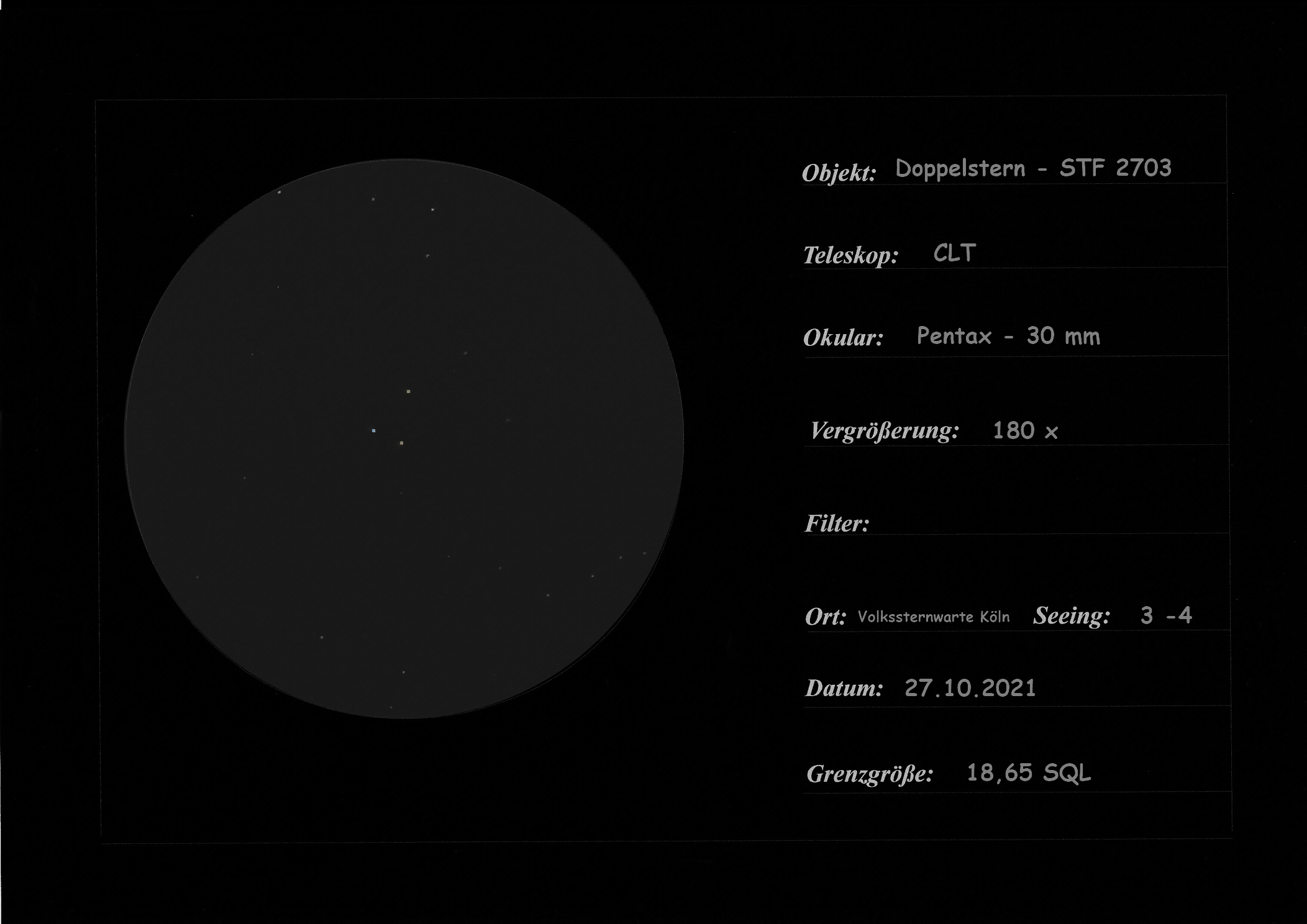

|
|
Karsten Kopp
Köln (Germany) |
140mm |
Image taken with TEC 140, Canon 700Da, 4 seconds exposure time |
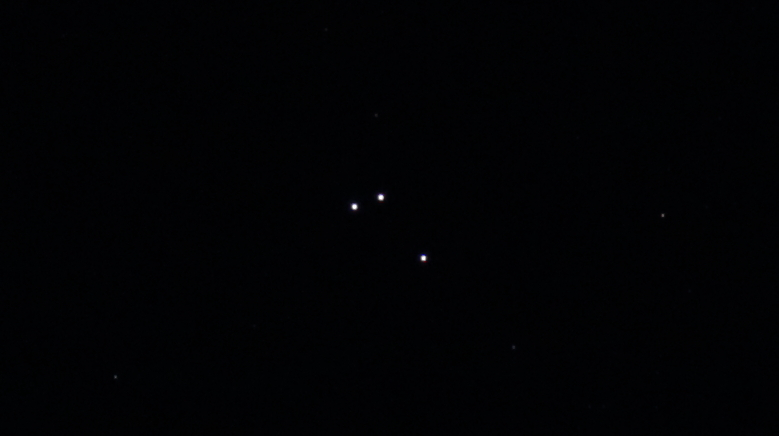
|
|
|
★★
|
ARY48 |
|
|
8m.2 |
8m.8 |
53.3" |
41° |
2016 |
Cyg |
20h37m45.00s / +32°23'42.90" |
René Merting
Drachhausen (Germany) |
18x70 |
das Paar ist sofort bequem getrennt als solches erkennbar - Komponente B im Osten ist maximal eine halbe Magnitude schwächer |
|
René Merting
Drachhausen (Germany) |
76mm (29x) |
Mondscheinnacht - bei 29x sehe ich ein Pärchen zweier gleich heller Sterne mit einem leichten Farbkontrast - Trennung komfortabel |
|
Mark McCarthy
Fremont (California/USA) |
80mm (13x) |
A beautiful split in finder, just equal pair, wide separation, white with red tint. |
|
René Merting
Drachhausen (Germany) |
100mm (20x) |
bei 32x zeigt sich B fast gleichhell weit getrennt nordöstlich von A - bei 20x ein kleines schwaches ordentlich getrenntes Pärchen |
|
|
|
★★
|
STF2727, 12 Del, gamma Del |
|
AB |
4m.4 |
5m.0 |
8.8" |
266° |
2020 |
Del |
20h46m39.50s / +16°07'27.40" |
|
|
Christopher Hay
Seeheim (Germany) |
8x42 |
On tripod. Definite elongation, and eastern end of elongation (i.e. component A) is definitely brighter than the other end. PA estimated at 240° without prior knowledge. |
|
Christopher Hay
Seeheim (Germany) |
15x45 |
Stabilised binoculars, handheld. A very elongated figure-8 very close to popping apart. According to Stelledoppie a physical double with a period of 3249 years. Observed in June 2019 when separation was 8,89“. Will be 8.67“ in 2030 according to Stelledoppie. |
|
Robert Zebahl
Leipzig (Germany) |
16x70 |
2021-09-02: Beautiful sight in very nice surrounding. Easy to split, but quite small separation. A rather small difference in brightness is clearly visible. The primary component appears golden in color. |
|
Christopher Hay
Seeheim (Germany) |
18x80 |
Very tight pair but clearly split with black in-between. Observed in July 2019 when separation was 8,89“. An excellent object to test the resolution of large binoculars. Struve 2725 a few arcminutes to the southwest is a further good test object for magnifications >20x. |
|
Christopher Hay
Seeheim (Germany) |
40x80 |
Widely split, visually strong, dominating the field of view. Component A appears yellowish compared to component B. Struve 2725 in same FOV finely split. |
|
René Merting
Drachhausen (Germany) |
100mm (32x) |
bei 32x knapp getrennt - Komponente A ist schön gelb, B im Westen ist gut 1.5 Magnituden schwächer (lt. Stelle Doppie Helligkeitsunterschied nur 0.67 mag) - zusammen mit dem wesentlich schwächeren STF2725 gut 15' südlich sehenswert |
|
Sarah Gebauer
Germany |
100mm (45x) |
bei 45x sauber getrennt und zusammen mit dem DS STF 2725 in einem Gesichtsfeld, dadurch wirken sie wie ein optisches Doppel-Doppel, sehr schön! Beide DS bilden auch einen auffälligen Lichthof |
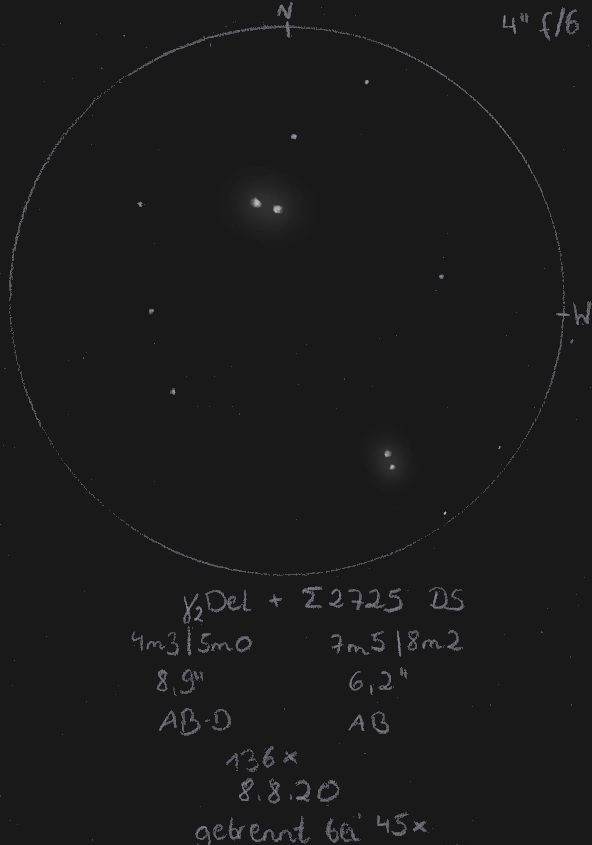
|
Sarah Gebauer
Germany |
100mm (80x) |
01.10.23: bei 80-fach zeigt sich der DS sehr hell, gut getrennt und strahlend maisgelb - schön zusammen mit dem südwestlich stehenden Doppelstern STF 2725, der ebenfalls leicht Farbe zeigt |
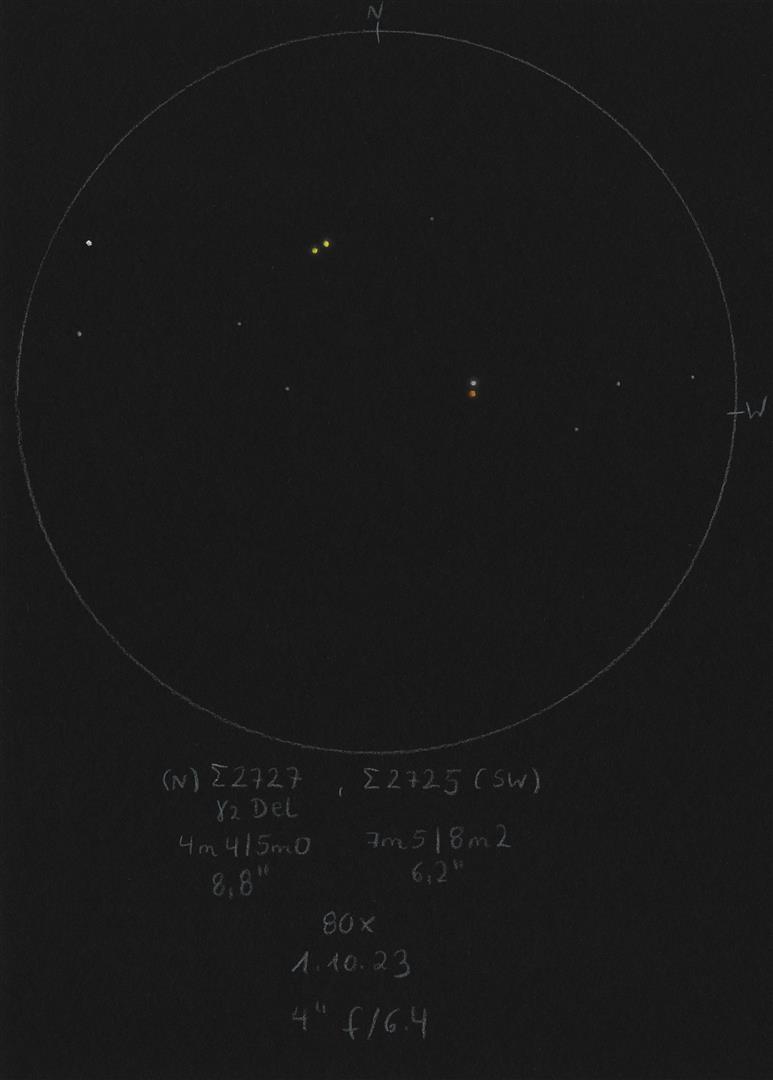
|
Uwe Pilz
Leipzig (Germany) |
105mm (66x) |
im selben Feld mit STF2725 |
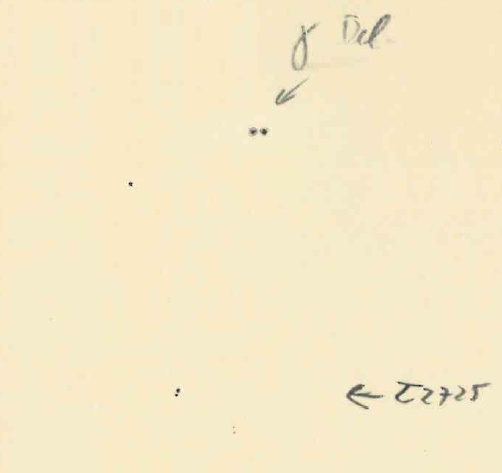
|
Uwe Pilz
Leipzig (Germany) |
105mm (144x) |
schon trennbar bei 26x. In einem Feld mit STF2725 |
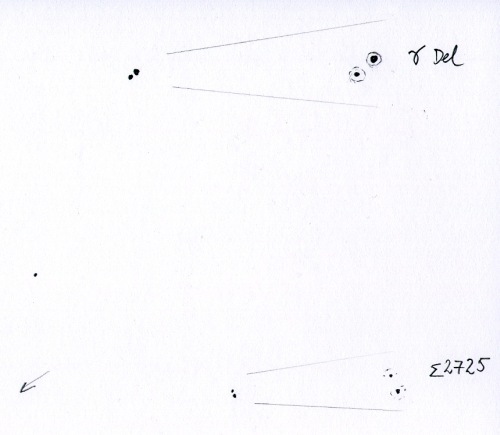
|
Robert Zebahl
Leipzig (Germany) |
152mm (30x) |
2021-09-11: Difference in brightness well visible. Light yellow/golden & lemon yellow. |
|
Mark McCarthy
Fremont (California/USA) |
152mm (175x) |
Gam2 Del. Gorgeous, light yellow-orange A and blue-green B, I like this better than Albireo. Physical with 3249-year period, it will slowly tighten the next couple of hundred years |
|
Mark McCarthy
Fremont (California/USA) |
152mm (285x) |
Gam 2 Del. ! Most beautiful light orange-yellow A and ~1 delta mag blue-green B |
|
Mark McCarthy
Fremont (California/USA) |
317mm (277x) |
Gamma Delphinus. Rich gold-yellow A, blue-white B, ~6" separation estimated by eye. Very pretty pair. |
|
Karsten Kopp
Köln (Germany) |
600mm (180x) |
Recht heller und auch leicht zu trennender Doppelstern mit ca. 0,5 mag Helligkeitsunterschied. Komponente A leuchtet schön gelblich und Komponente B weiß. |
|
|
|
|
S763 |
|
AB |
7m.2 |
7m.8 |
15.8" |
293° |
2019 |
Cap |
20h48m25.96s / -18°12'06.10" |
|
|
|
|
AC |
7m.2 |
11m.7 |
542.3" |
177° |
2015 |
|
|
|
|
|
|
CD |
11m.7 |
12m.0 |
9.1" |
333° |
2018 |
|
|
René Merting
Drachhausen (Germany) |
12x50 |
AB: ein ganz enges Paar zweier gleich heller Sterne - meist sehe ich eine 8 mit tiefen Einbuchtungen, die Sterne berühren sich gerade so |
|
René Merting
Drachhausen (Germany) |
15x56 |
AB: ein sehr enges Paar, aber die Trennung ist eindeutig erkennbar - beide Sterne sind gleich hell und ohne Farbunterschied |
|
|
|
|
STF2738 |
|
AB |
7m.5 |
8m.6 |
15.0" |
254° |
2016 |
Del |
20h58m32.23s / +16°26'12.20" |
|
|
|
|
AC |
7m.5 |
8m.1 |
209.4" |
104° |
2016 |
|
|
|
|
|
|
BC |
8m.6 |
8m.1 |
222.7" |
102° |
2016 |
|
|
Robert Zebahl
Leipzig (Germany) |
16x70 |
AB: 2021-09-02: Worth seeing in beautiful surroundings. Finely split, clearly uneven pair. |
|
René Merting
Drachhausen (Germany) |
76mm (29x) |
AB: bei 29x gut getrennt und doch schön eng stehend zu erkennen, die B-Komponente im Westen wirkt halb so hell wie A und wirkt dadurch graubraun
AC: in siebenfachem Abstand AB steht C im Osten von A, ohne dass man den Eindruck gewinnen könnte, der Stern muss dort dazu gehören |
|
René Merting
Drachhausen (Germany) |
100mm (20x) |
AB: bei 32x ordentlich getrennt - Komponente A im Osten ist deutlich heller (geschätzt 1.5 Größenklassen), B im Westen strahlt dumpfer - Farbkontrast weiß/grau - zurück auf 20x ist der Doppelstern weiterhin nicht zu knapp getrennt sichtbar |
|
Mark McCarthy
Fremont (California/USA) |
317mm (277x) |
AB: ~1 magnitude difference, widely separated white pair. |
|
Karsten Kopp
Köln (Germany) |
600mm (180x) |
AB: Doppelstern ist sehr leicht zu trennen und auch der Helligkeitsunterschied mit ca. 1,0 mag ist schon auffällig. |
|
|
|
★★★
|
STF2758, 61 Cyg |
|
AB |
5m.2 |
6m.0 |
31.9" |
154° |
2021 |
Cyg |
21h06m53.95s / +38°44'57.90" |
|
|
Christopher Hay
Seeheim (Germany) |
8x42 |
On tripod. Clearly split, northern component A substantially brighter than B. Both orange, whereby A is distinctly more yellowish than B (sky quality similar to that of earlier 15x45 and 10x42 observations). Also seems to be split using the 8x42 handheld, but hand tremor makes this uncertain. |
|
Christopher Hay
Seeheim (Germany) |
15x45 |
Clear to wide separation. Both components of orange hue. Brighter northern component seemed to go slightly into yellow. In 10x42 also clearly split, northern component of orange hue, southern component of indeterminate colour (sky not quite dark enough at the time to see 61 Cyg naked-eye). Piazzi’s Flying Star, flying more than 5” per year to the northeast, and a true physical double with a period of 678 years. |
|
Robert Zebahl
Leipzig (Germany) |
16x70 |
2021-06-14: Beautiful sight. Bright orange & orange. |
|
Sarah Gebauer
Germany |
100mm (21x) |
20.09.23: der DS hebt sich bei 20-fach sehr stark vom Umfeld ab, das typisch für das Sternbild Schwan fein und üppig funkelnd wirkt - absolut mittig, wie auf dem Präsentierteller, zeigt sich der DS kupferbraun leuchtend mit einem geringen Helligkeitsunterschied, ein fantastischer Anblick - bei 49-fach ist der Farbeindruck leicht abgeschwächt, auch der Gesamteindruck leidet aufgrund geringeren Gesichtsfeldes |
|
René Merting
Drachhausen (Germany) |
100mm (32x) |
bei 32x sind beide Sterne gut getrennt, Komponente A strahlt in einem schmutzig dunklem gelb, schwächere Komponente B leicht orange |
|
Uwe Pilz
Leipzig (Germany) |
105mm (200x) |
gelb und orange. Der weitere Stern im Bild ist TYC 3168-6781 |
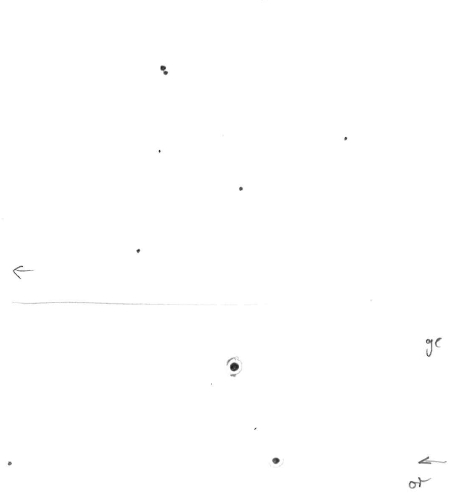
|
Uwe Pilz
Leipzig (Germany) |
105mm (200x) |
TYC 3168-5901 kann dazu dienen, den sich ändernden Positionswinkel abzuschätzen. |
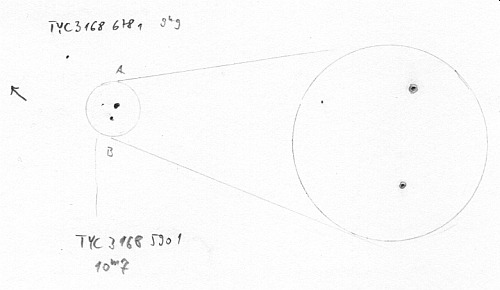
|
Jörg S. Schlimmer
Germany |
127mm (203x) |
Intensive Farbe |
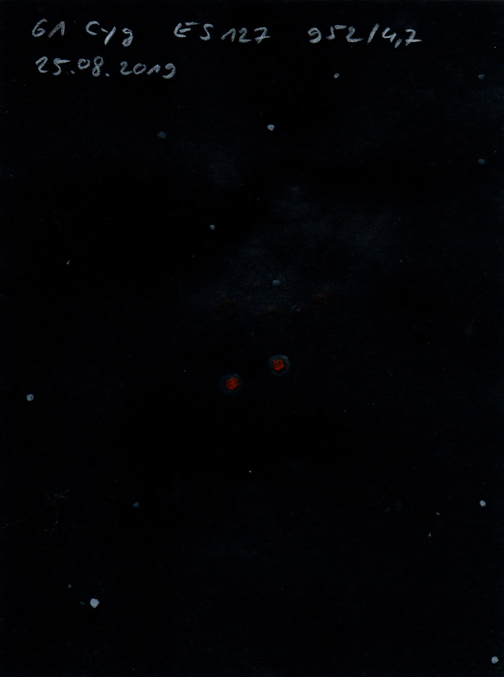
|
Robert Zebahl
Leipzig (Germany) |
152mm (22x) |
2020-06-24: Beautifully separated, bright, striking, especially the colors: bright orange and orange. |
|
Mark McCarthy
Fremont (California/USA) |
152mm (175x) |
61 Cyg. Stunning pair, yellow A and orange B, half delta mag, wide. Spectral class K5V+K7V (yellow-orange/yellow-orange). Only 11.38 light years away! Physical with a 618.6911-year period, it is now at apastron. There are 18 stars in the system but none of the visible ones are, and those only detected in K-band are uncertain |
|
Mark McCarthy
Fremont (California/USA) |
203mm (121x) |
61 Cyg. Nice near equal wide orange pair, bright [18 stars in system -- if so should be an OC] |
|
René Merting
Drachhausen (Germany) |
320mm (45x) |
bei 32x sind beide Sterne gut getrennt, Komponente A strahlt in einem schmutzig dunklem gelb, schwächere Komponente B leicht orange |
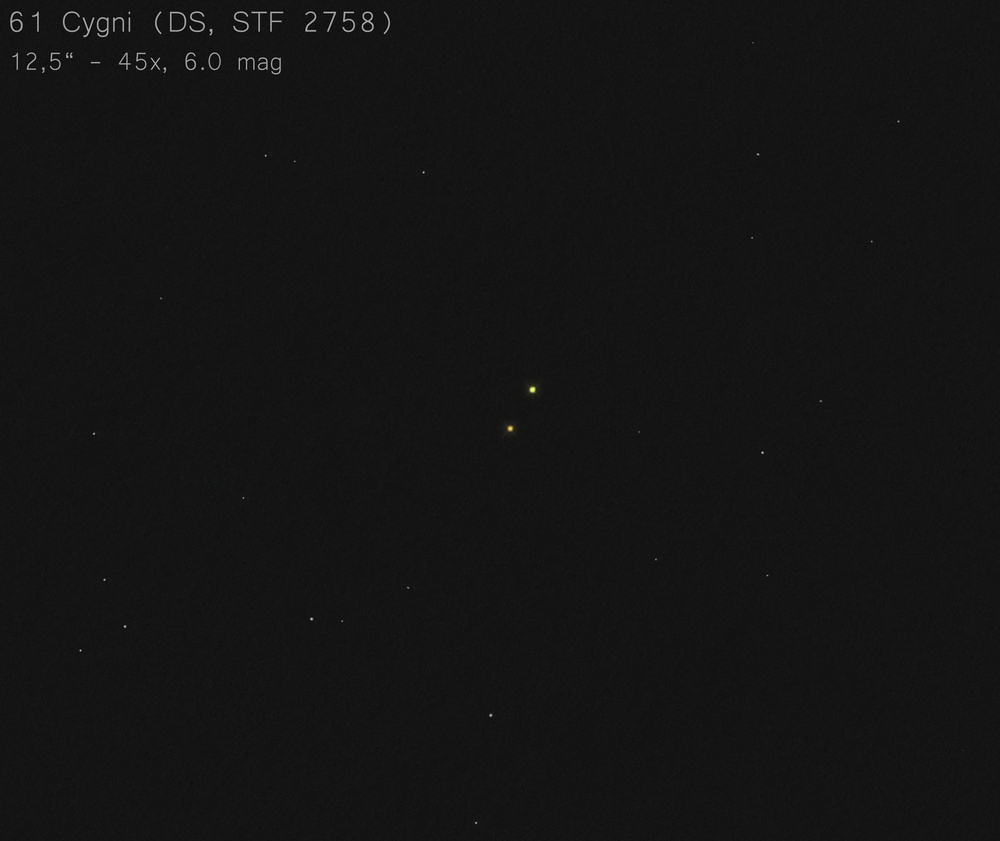
|
Uwe Pilz
Leipzig (Germany) |
320mm (121x) |
Der Doppelstern bildet 2021 mit dem 11-mag-Stern ein fast gleichschenkliges Dreieck |
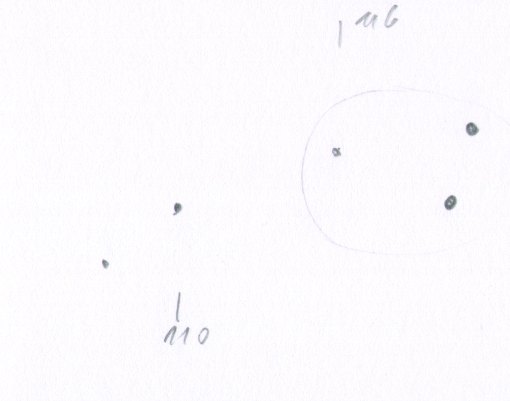
|
|
Berthold Fuchs
Wiesbaden (Germany) |
130mm |
easy DS |
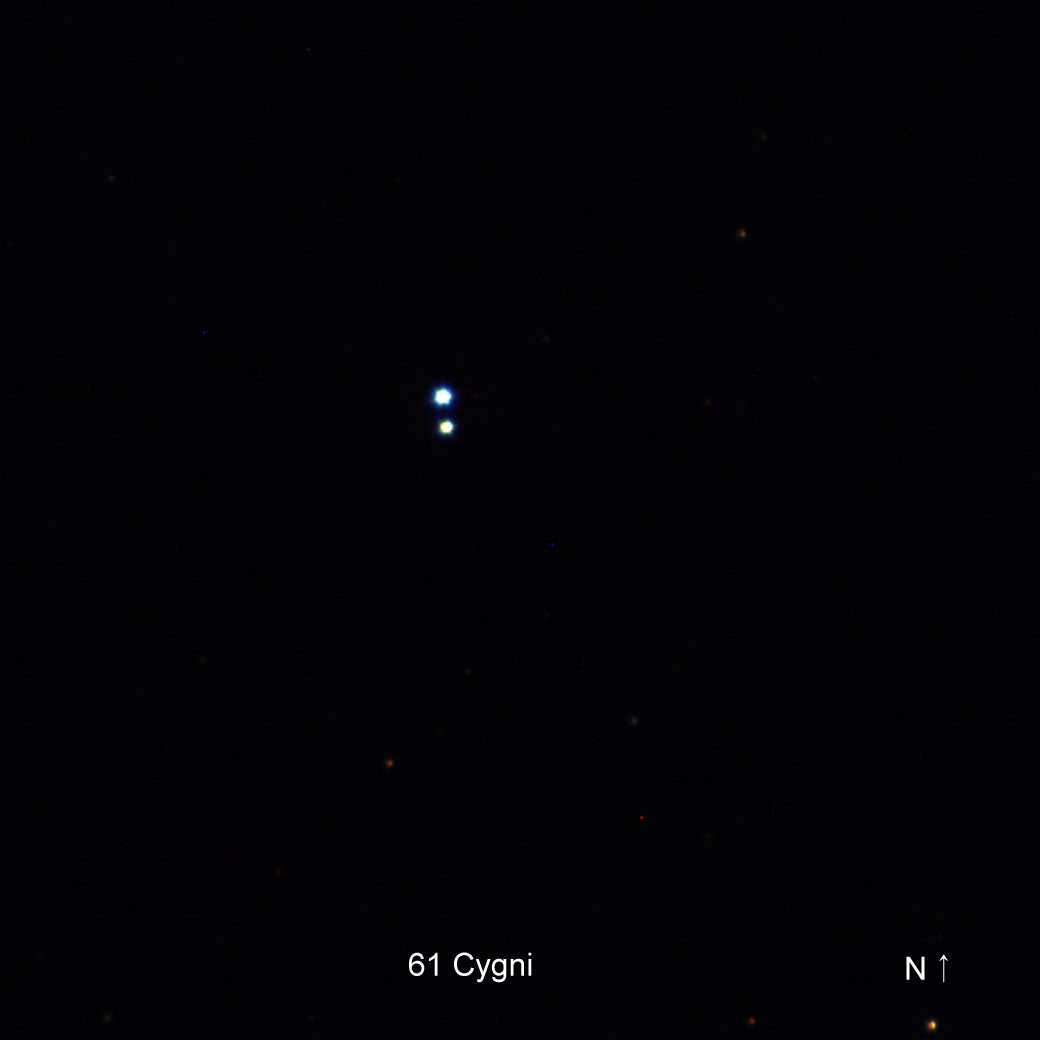
|
|
|
|
STF2769 |
|
AB |
6m.7 |
7m.4 |
18.1" |
301° |
2020 |
Vul |
21h10m32.07s / +22°27'16.70" |
Robert Zebahl
Leipzig (Germany) |
16x70 |
2020-08-19: The double star is located in a rather poor environment and is therefore very conspicuous. Clearly visible brightness difference with rather small separation. The primary component appeared white-bluish and thus quite cool, while the companion showed a warm hue (yellowish/orange?). |
|
René Merting
Drachhausen (Germany) |
18x70 |
beide Sterne stehen schön dicht, die knappe Trennung ist einfach erkennbar - B steht nordwestlich von A - Helligkeitsunterschied weniger als eine Größenklasse |
|
René Merting
Drachhausen (Germany) |
76mm (29x) |
bei 29x ein schön eng stehendes, etwas mehr als knapp getrenntes Sternpaar - B im NW ist eine halbe Magnitude schwächer als A - ein schön isoliertes Sternpaar, ansehnlich |
|
René Merting
Drachhausen (Germany) |
320mm (45x) |
bei 45x ein schönes, helles Sternpaar, relativ dicht beisammen stehend und ordentlich getrennt - B ist etwa eine viertel Größenklasse schwächer und funkelt ebenso wie A wie ein klarer Diamant, vielleicht ein kleines bisschen warmweißer - das Umfeld stellt keine Konkurrenz für das Sternpaar dar |
|
|
|
|
STF2832 |
|
AB |
7m.8 |
8m.3 |
13.2" |
213° |
2019 |
Cyg |
21h49m14.48s / +50°30'54.20" |
|
|
|
|
AC |
7m.8 |
11m.0 |
45.8" |
321° |
2018 |
|
|
|
|
|
|
BC |
8m.3 |
11m.0 |
51.5" |
335° |
2018 |
|
|
Robert Zebahl
Leipzig (Germany) |
16x70 |
AB: 2020-08-19: Very nicely separated, slight difference in brightness. No color was visible. Towards northwest is pi 1 Cygni, which is surrounded by several medium bright and fainter stars and together with STF 2832 presents a very attractive view. The region southeast of STF 2832 looks rather poor. |
|
René Merting
Drachhausen (Germany) |
18x70 |
AB: ein auffälliges, schickes Sternpaar im FG, ganz knapp getrennt (da passen keine zwei Blatt Papier zwischen) - Komponente B im Süden ist nur knapp schwächer |
|
Mark McCarthy
Fremont (California/USA) |
203mm (205x) |
AB: White, wide, slight magnitude difference. Physical |
|
|
|
★★
|
delta Cep, 27 Cep |
BU702 |
AB |
4m.2 |
13m.0 |
21.5" |
282° |
2015 |
Cep |
22h29m10.25s / +58°24'54.70" |
|
|
|
STFA58 |
AC |
4m.2 |
6m.1 |
41.0" |
191° |
2018 |
|
|
|
|
|
DAL45 |
AD |
4m.2 |
13m.9 |
109.0" |
39° |
2015 |
|
|
|
|
|
DAL45 |
DE |
13m.9 |
14m.0 |
1.4" |
23° |
2008 |
|
|
Christopher Hay
Seeheim (Germany) |
7x45 |
AC: Hand tremor hampers splitting A and C at this low magnification, as the apparent separation is small. Nonetheless, a grey-blue C dances next to the luminous-orange A.
Component A is the prototype of the Cepheid class of variable stars, with a brightness variation of a full magnitude over 5 days. To assess a somewhat difficult handheld binocular split like this it would really be necessary to know the momentary brightness of A, but I didn’t have a telescope at hand. |
|
René Merting
Drachhausen (Germany) |
15x56 |
AC: ein wunderschönes Paar - A strahlt satt gelb, C zeigt sich gut getrennt und tendiert mehr ins weißgraue - dadurch ein schöner Farbkontrast |
|
Robert Zebahl
Leipzig (Germany) |
16x70 |
AC: 2020-09-20: Nice separation with noticeable difference in brightness. Slightly yellowish & white-bluish. |
|
Robert Zebahl
Leipzig (Germany) |
55mm (27x) |
AC: At 27x easy to separate, rather wide apart with clear difference in brightness. At 38x the colors are slightly better visible: A shines in bright orange, C appears rather grey-bluish. |
|
Robert Zebahl
Leipzig (Germany) |
80mm (25x) |
AC: Obvious difference in brightness and color. Brighter component slightly orange, weaker bluish. Could be Albireo's little brother ;) |
|
René Merting
Drachhausen (Germany) |
107mm (30x) |
AC: bei 30x ein sehr auffälliges Sternpaar mit einem auffälligen Farbkontrast - auch wenn C deutlich schwächer ist, so strahlen doch beide Sterne um die Wette - Komponente A zeigt sich Siennagelb, C wirkt Blauweiß - ordentliche Trennung - bei 6x ändert C ein wenig seine Farbe, ich habe mitunter den Eindruck, Grünblau zu sehen |
|
Sarah Gebauer
Germany |
150mm (85x) |
AC: die hellere Komponente ist sehr intensiv und richtig schön goldgelb und die zweite, deutlich schwächere Komponente hat einen sichtbar bläulichen Farbstich, insgesamt schon ab 21x sehr schön anzuschauen |
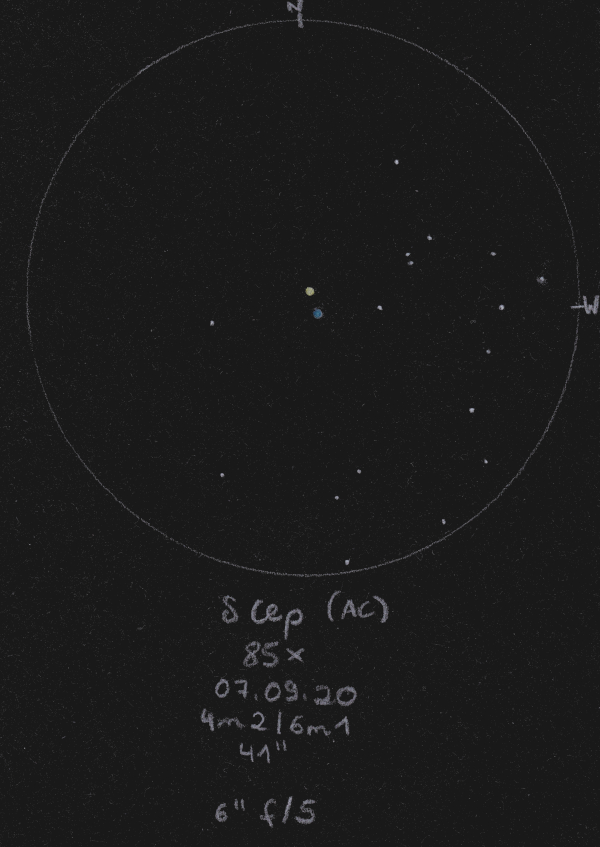
|
Mark McCarthy
Fremont (California/USA) |
508mm (667x) |
DE: Slight brightening in the diffraction ring |
|
|
Frederik Wanink
Itterbeck (Germany) |
254mm |
AC |
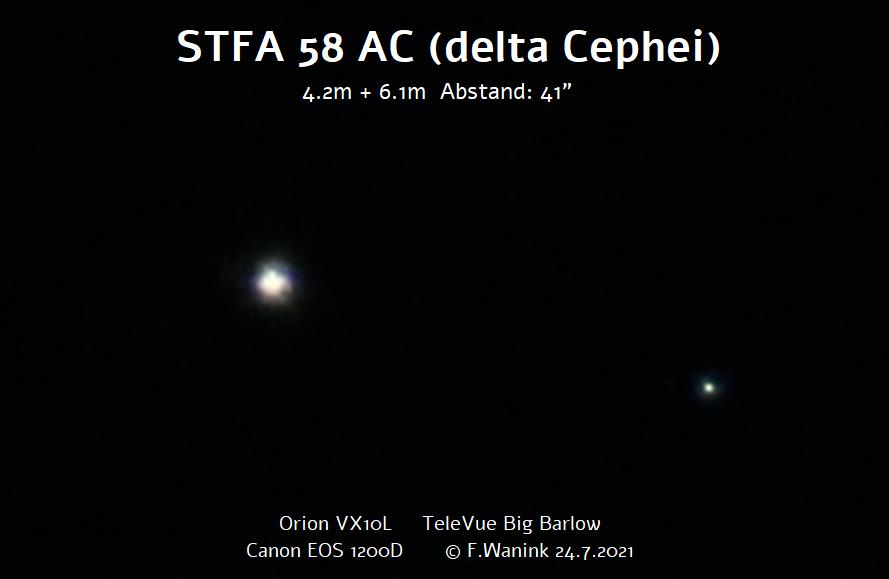
|
|
|
|
STTA252 |
|
|
6m.8 |
8m.4 |
111.1" |
145° |
2015 |
Peg |
23h54m56.40s / +29°28'32.20" |
René Merting
Drachhausen (Germany) |
12x50 |
Komponente B ist weit abgesetzt im SO von A erkennbar und mindestens 1.5 Magnitude schwächer - A strahlt weißgelb, B wirkt wie so oft als schwächerer Begleiter eher grau |
|
René Merting
Drachhausen (Germany) |
18x70 |
ein megafett getrenntes Sternpaar - B im Südosten von A wirkt bräunlich bis grau, A dagegen stahlt weißgelb - Helligkeitsunterschied 2 Größenklassen |
|
René Merting
Drachhausen (Germany) |
76mm (29x) |
bei 29x ist das Sternpaar sehr auffällig und weit auseinanderstehend - schöner Farbkontrast, A ist glänzend weiß und B ist 1.5 Größenklassen schwächer und wirkt kupferbraun, ohne wirklich Farbe zu zeigen |
|
René Merting
Drachhausen (Germany) |
320mm (45x) |
bei 45x ein weit auseinander stehendes Sternpaar mit einem schönen Farbkontrast - A im Norden ist reinweiß, B strahlt orangebraun |
|
|








